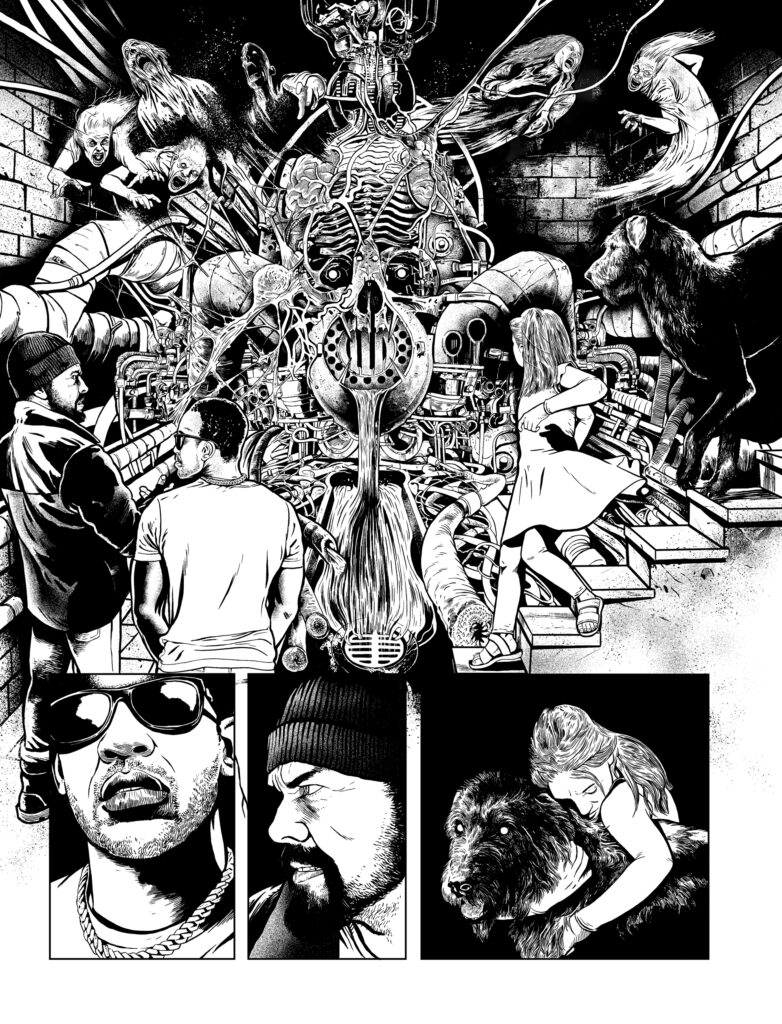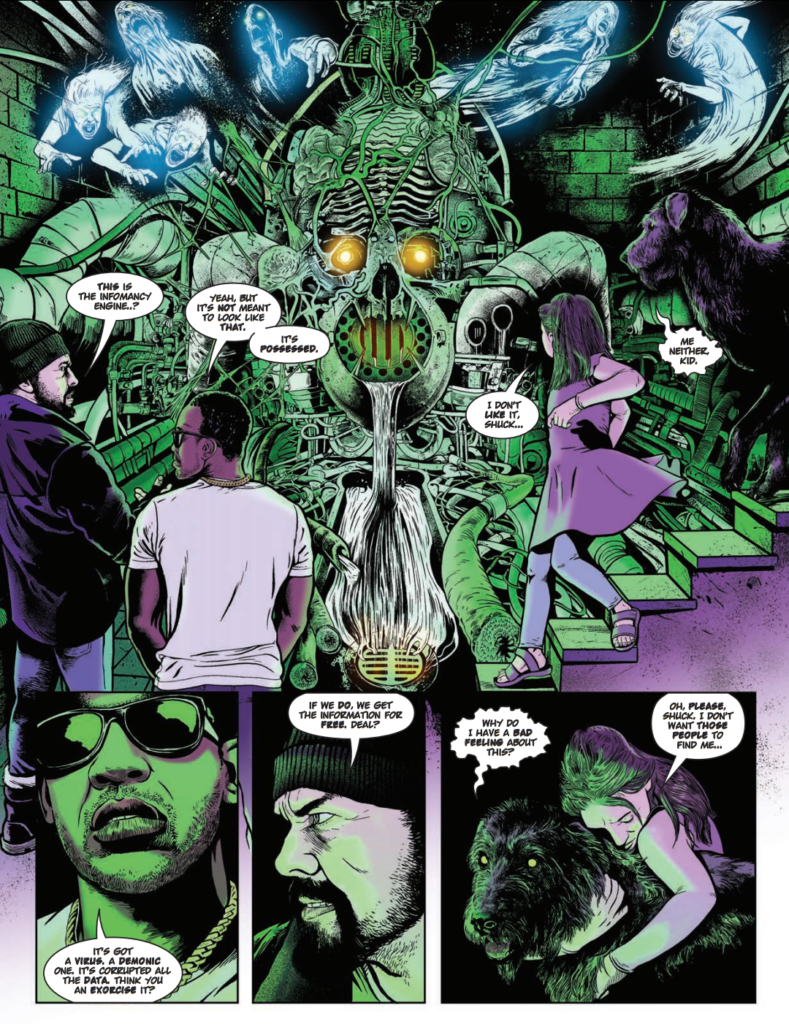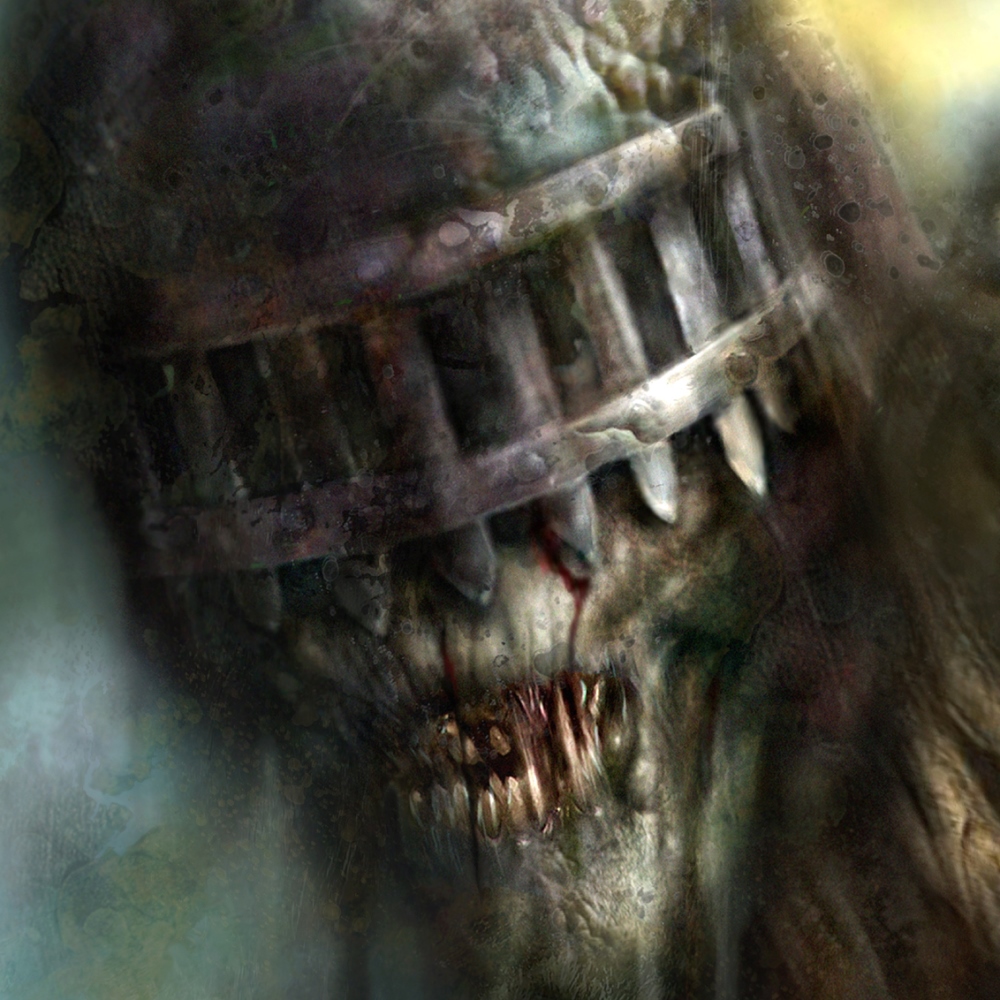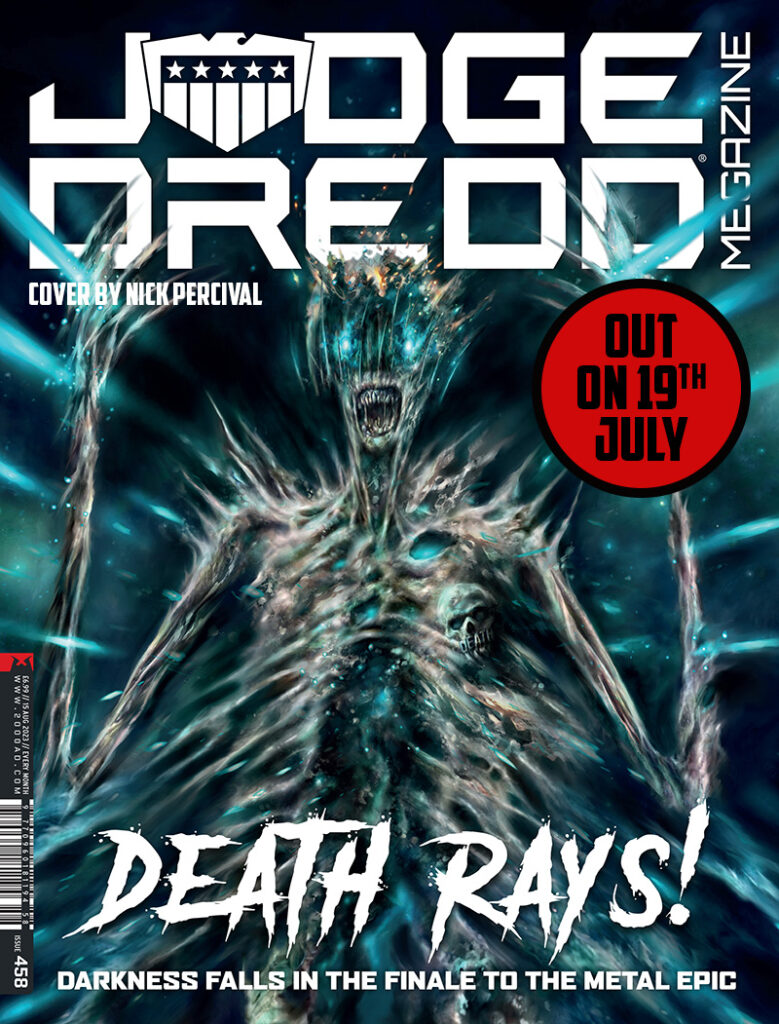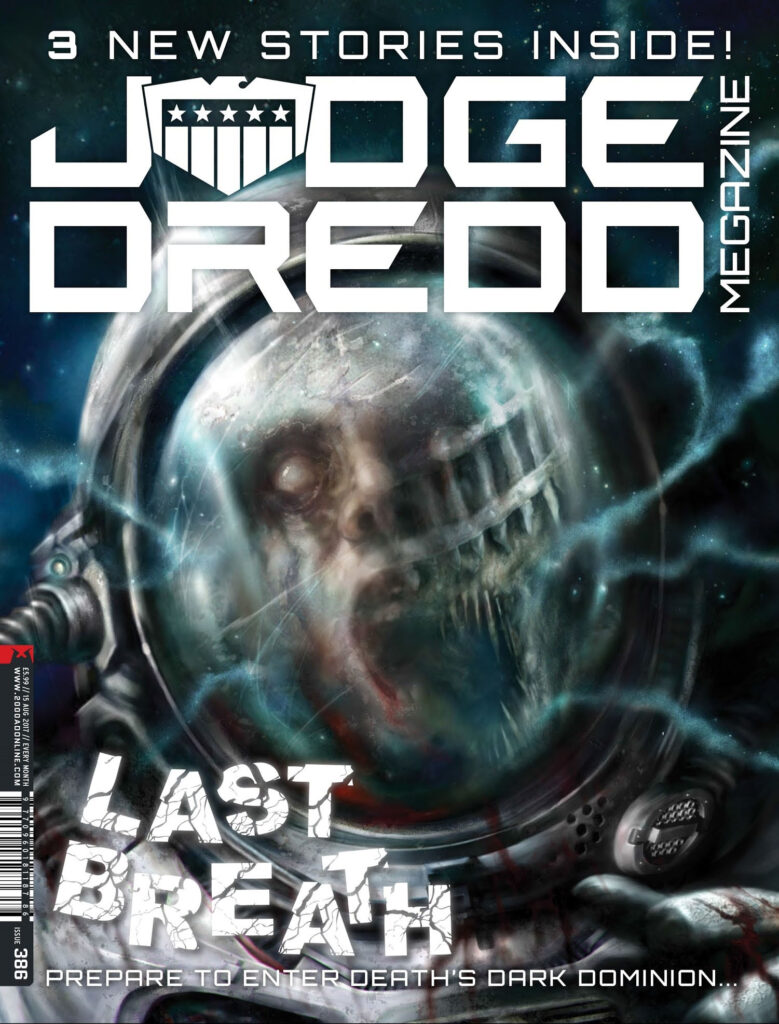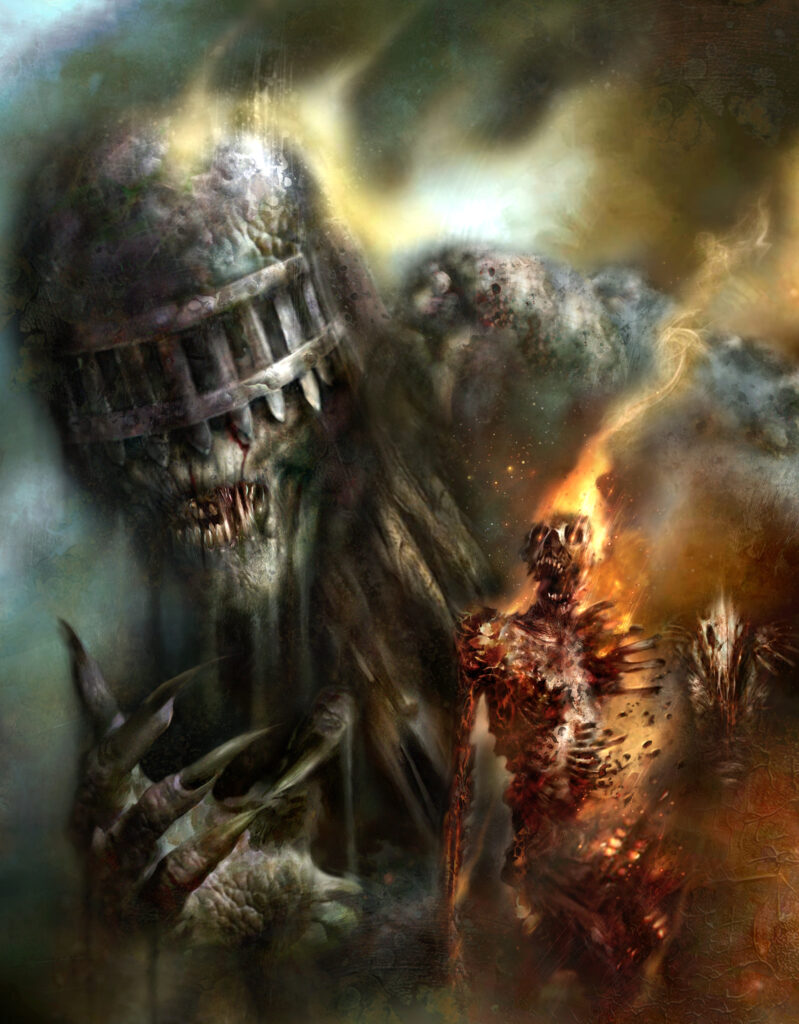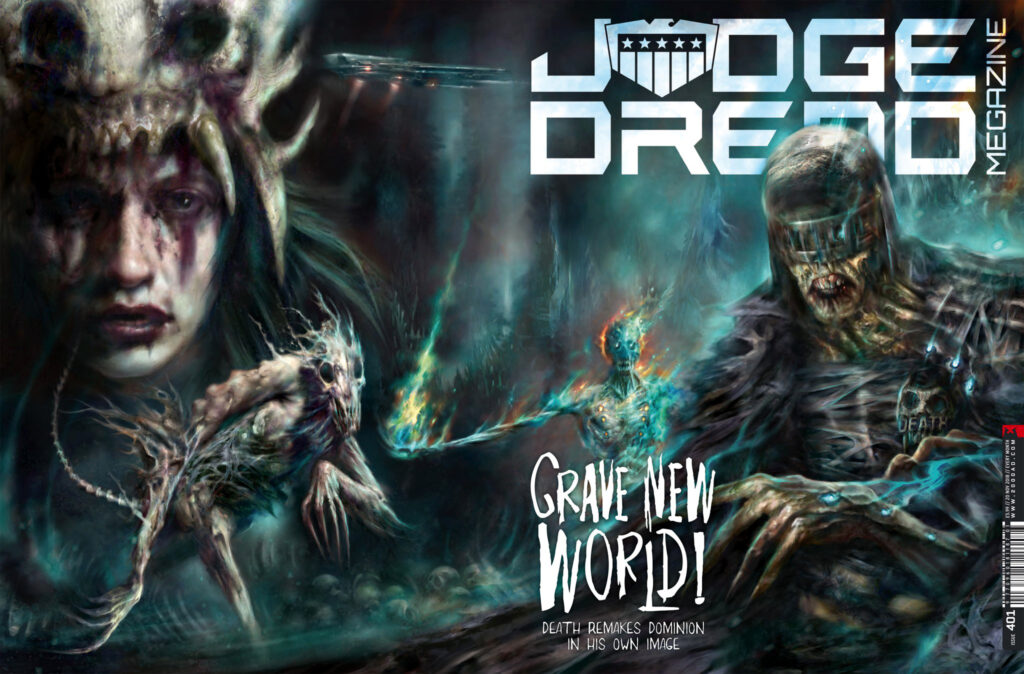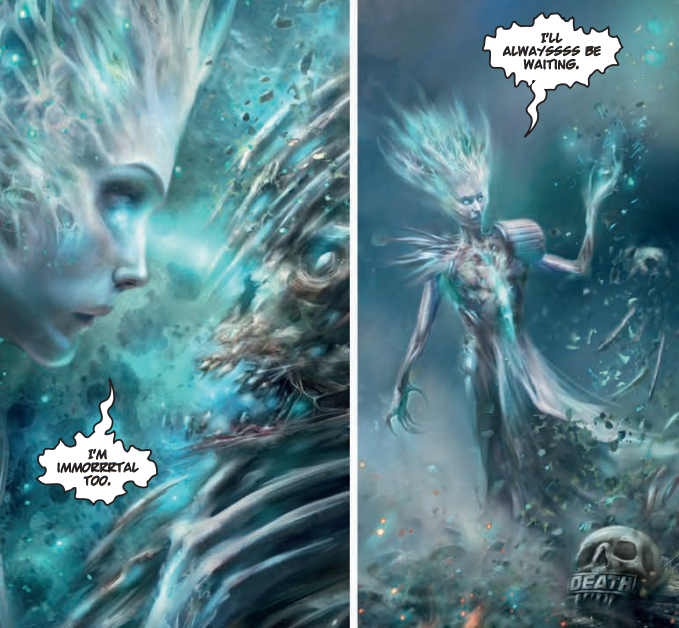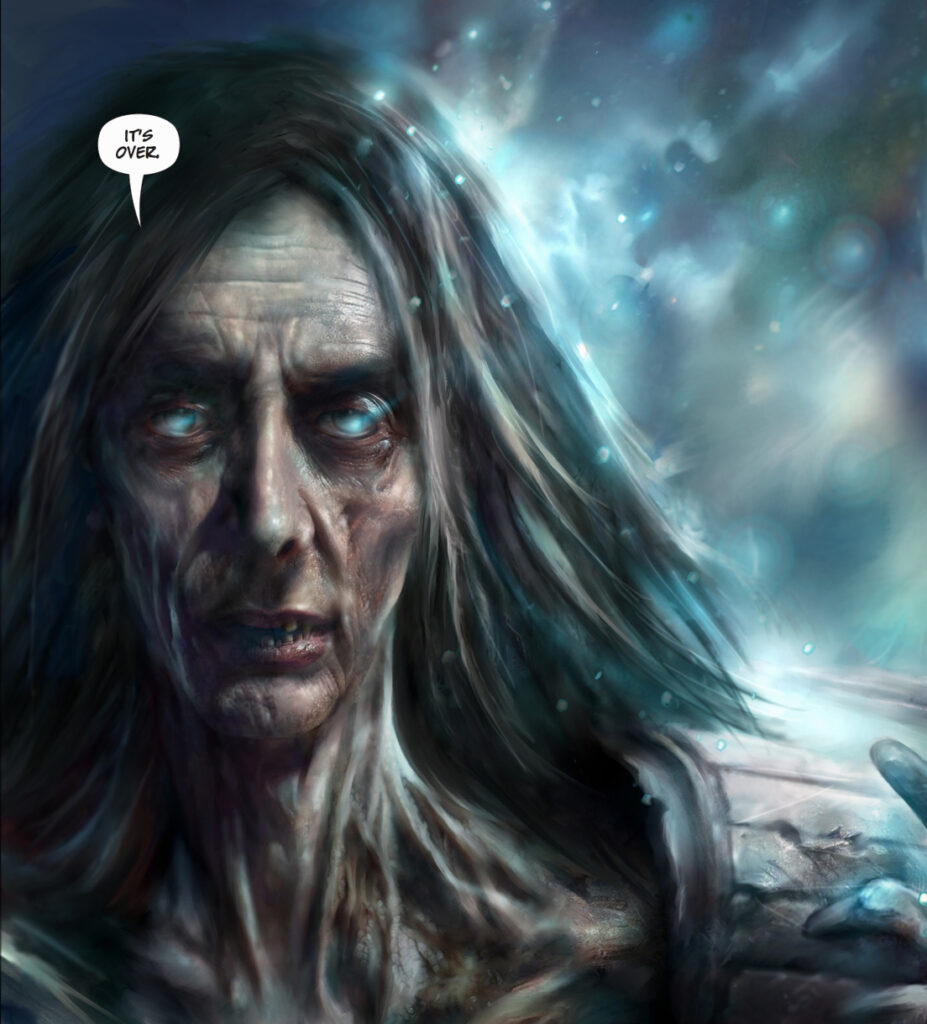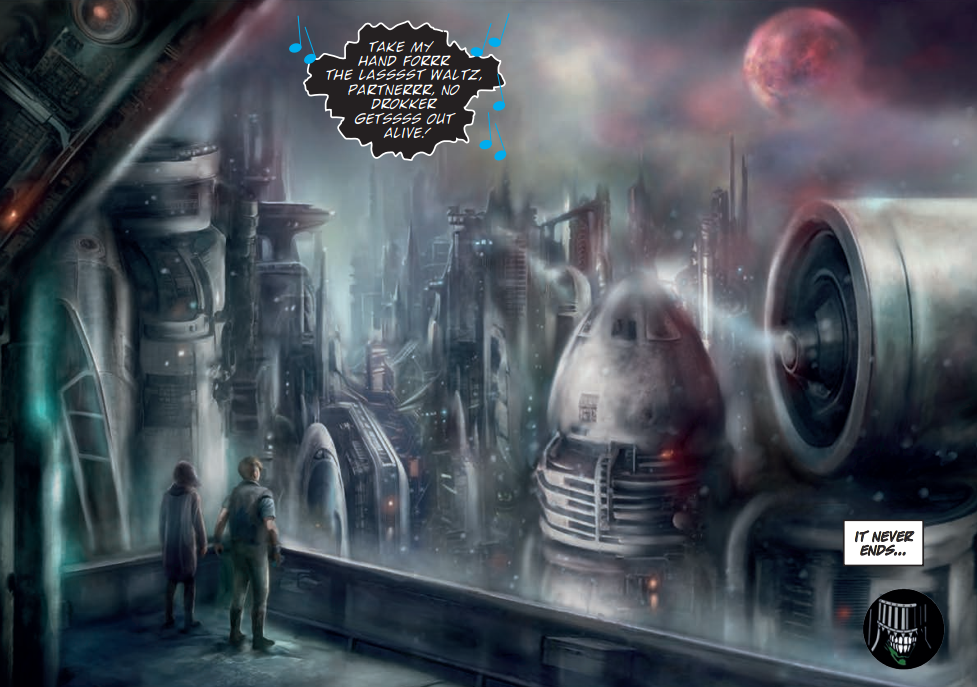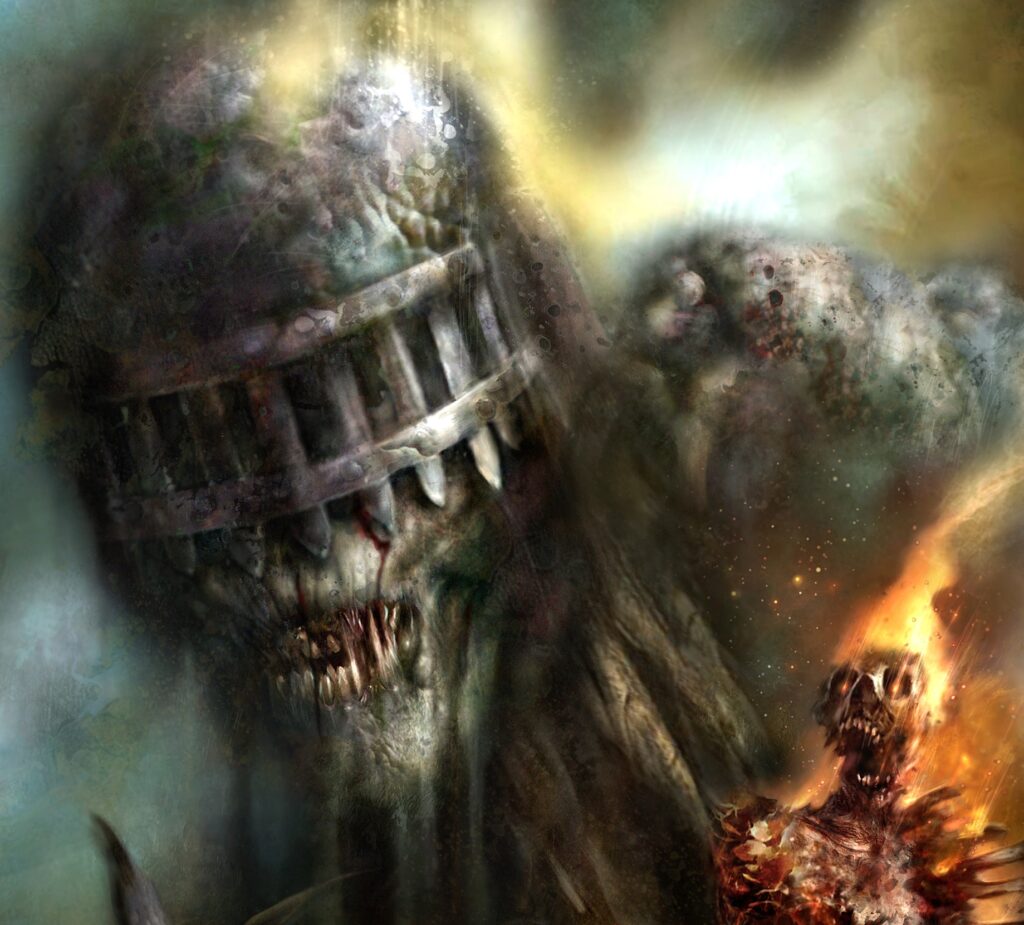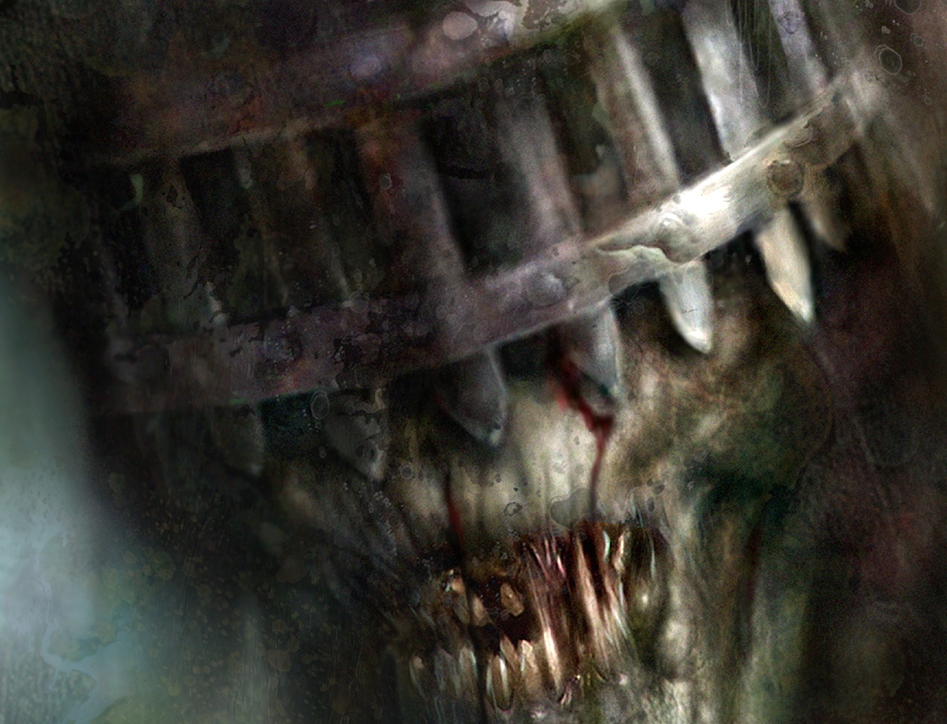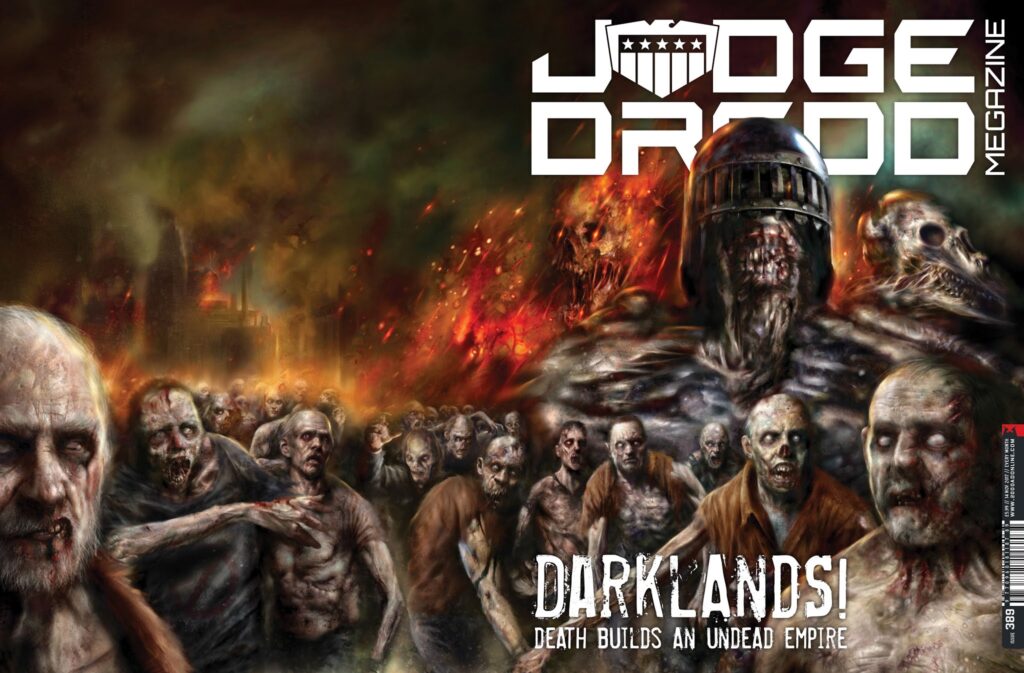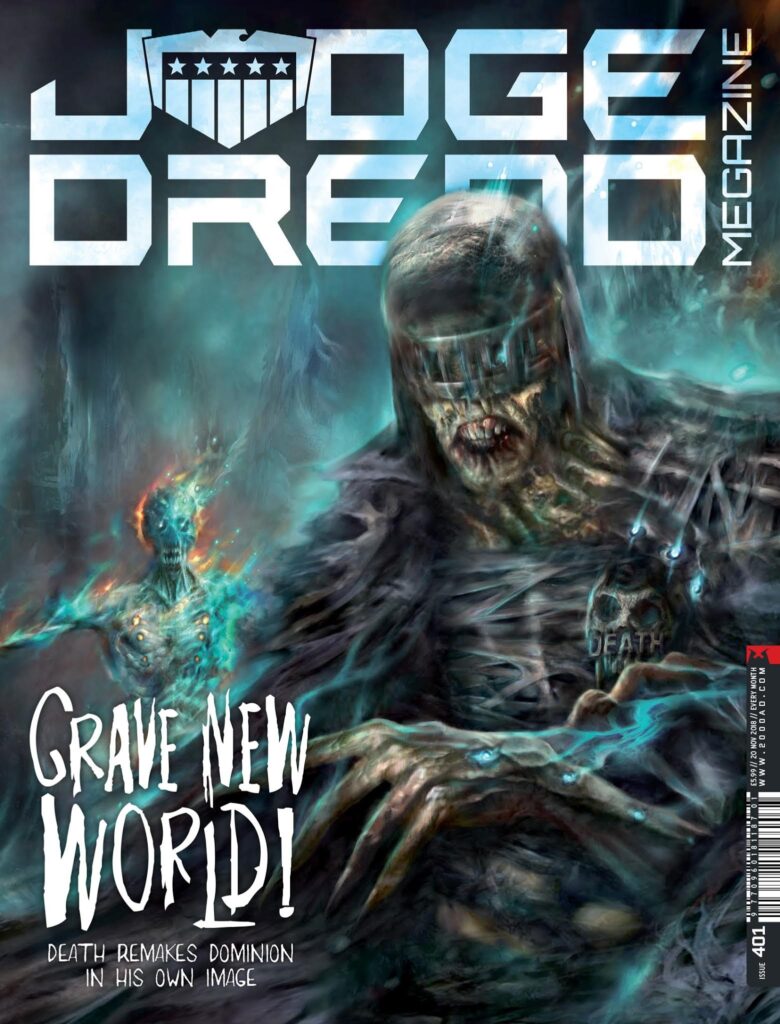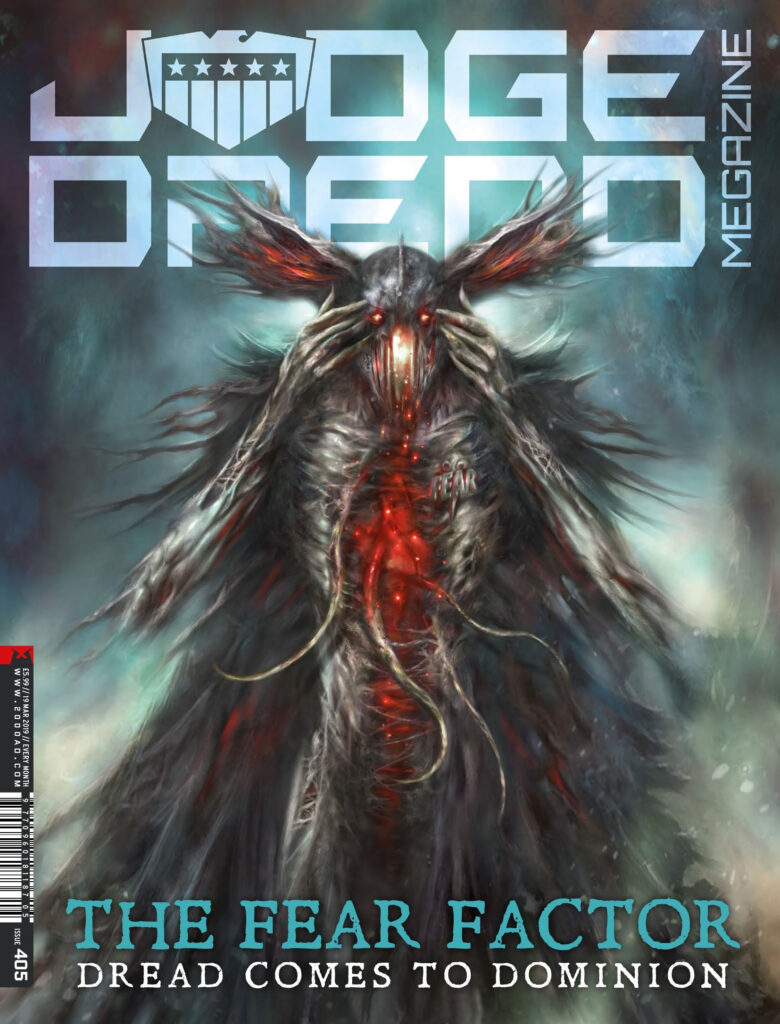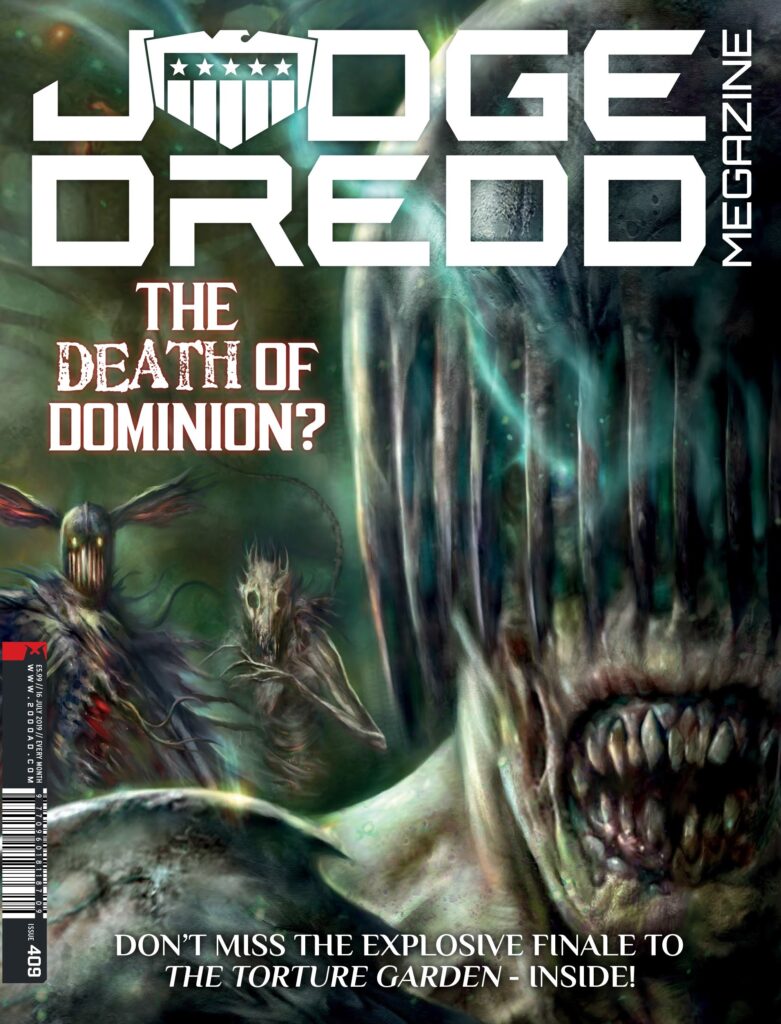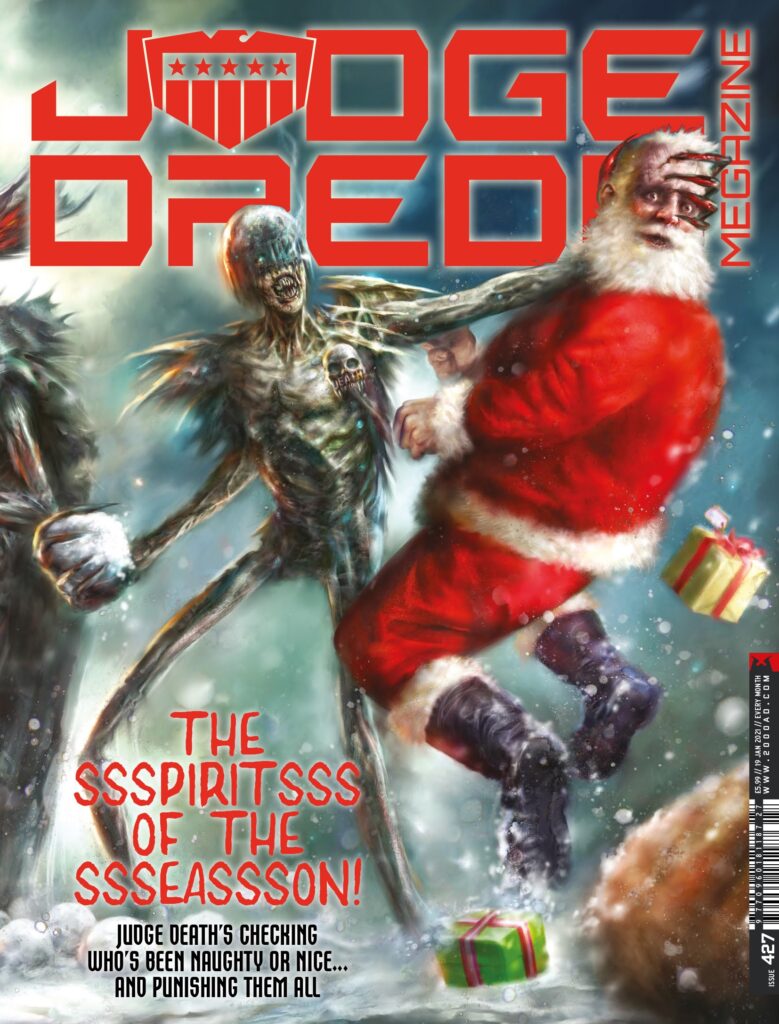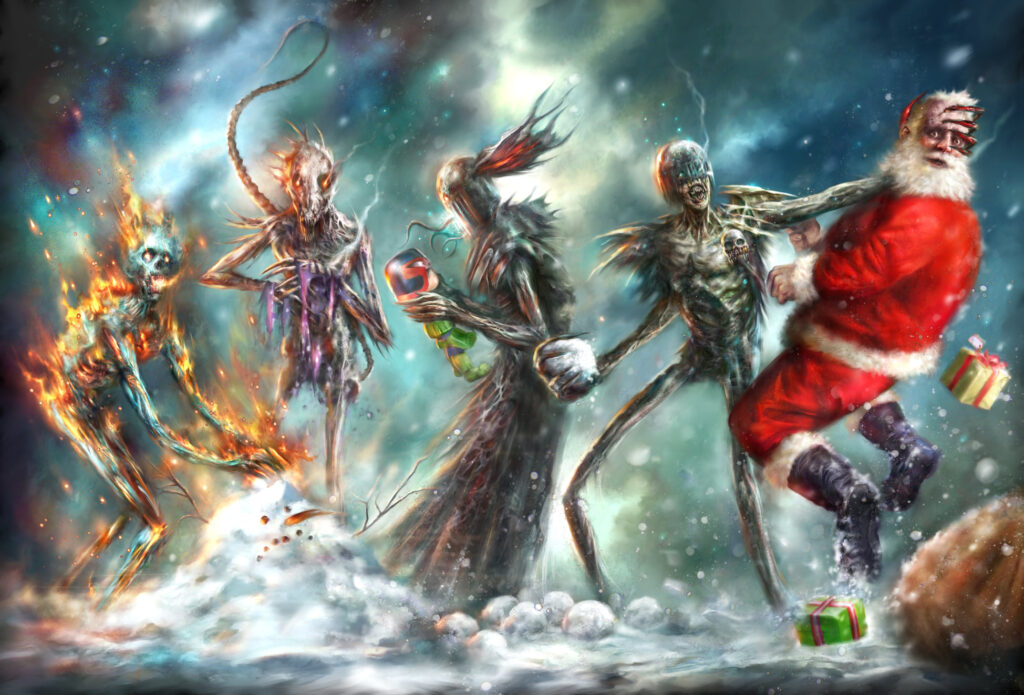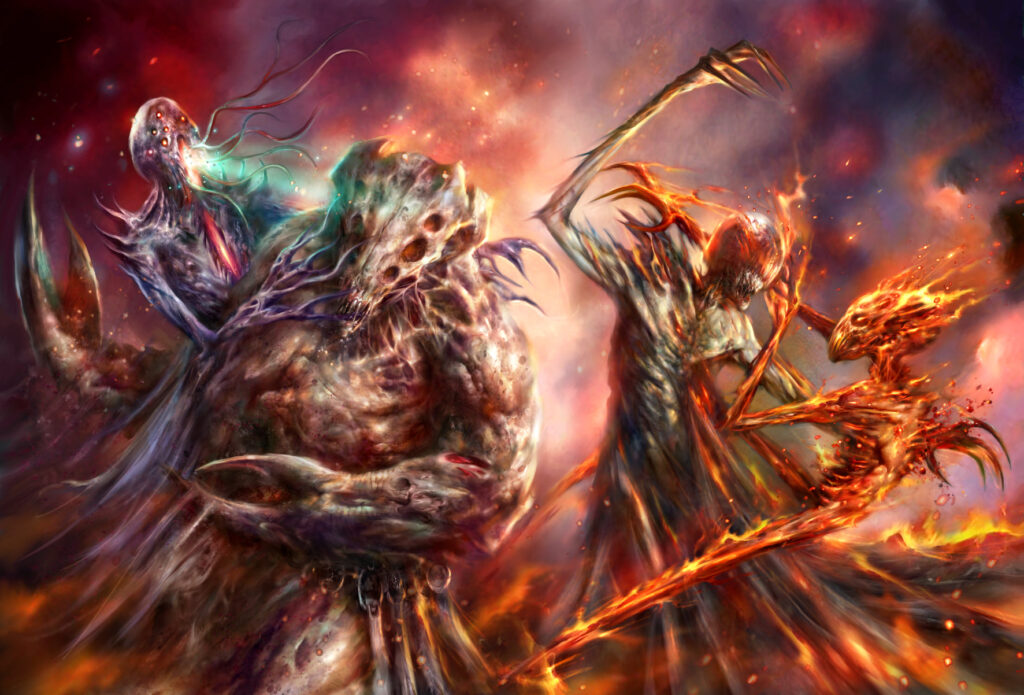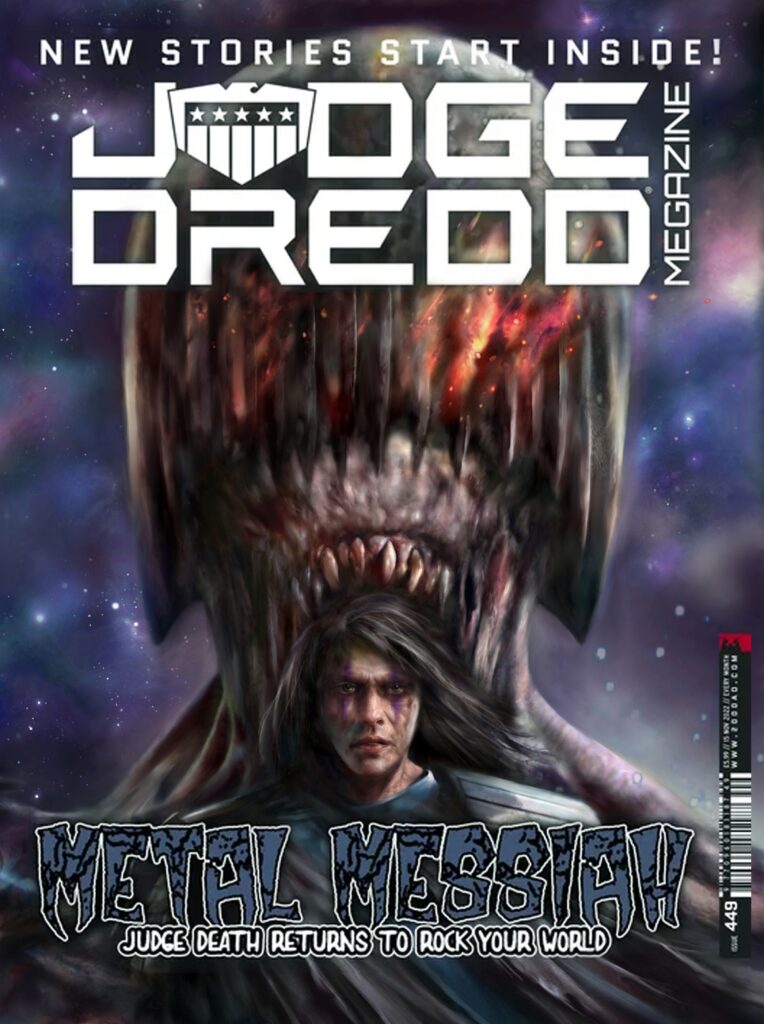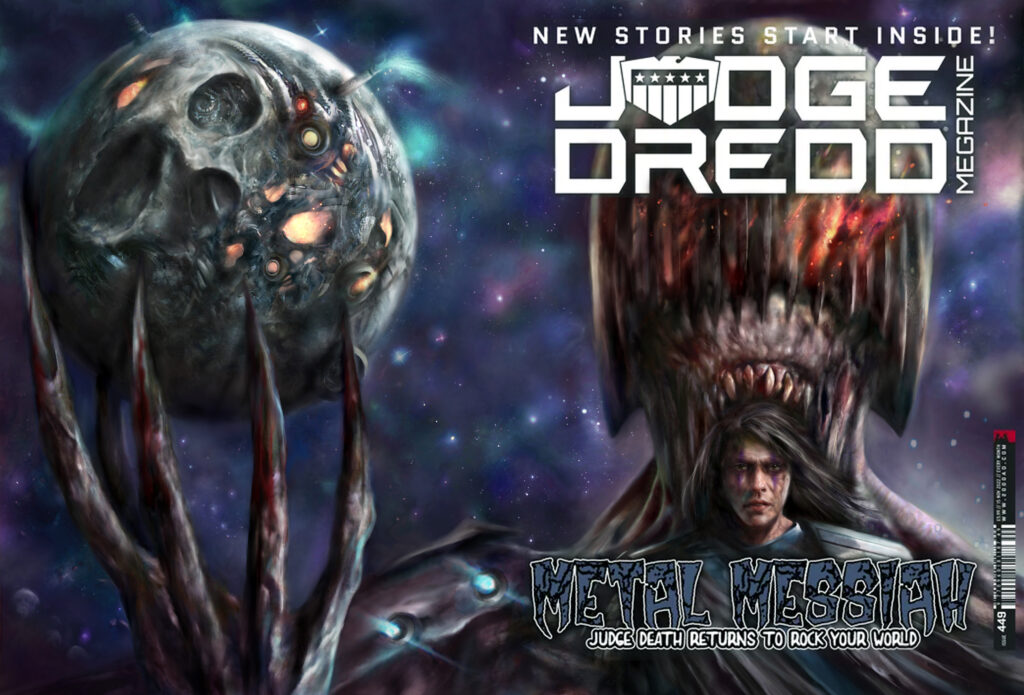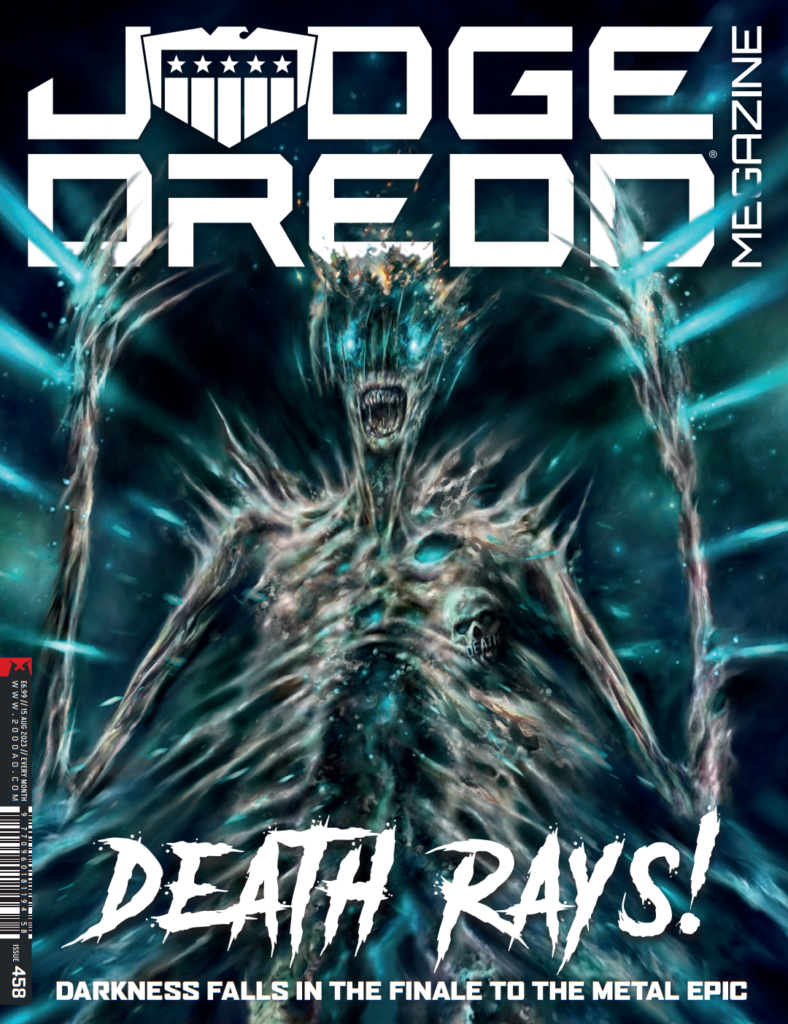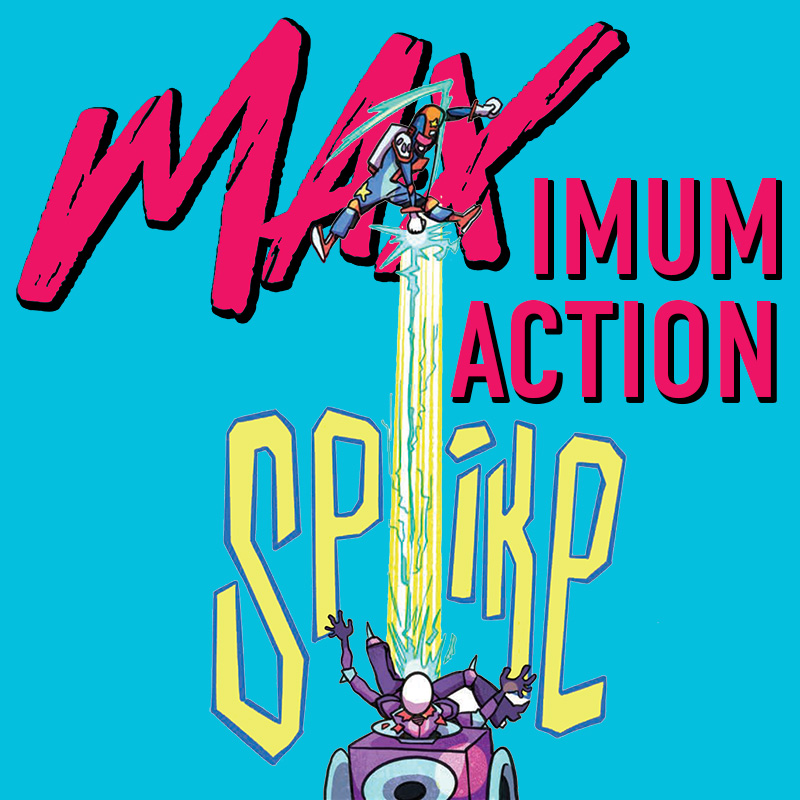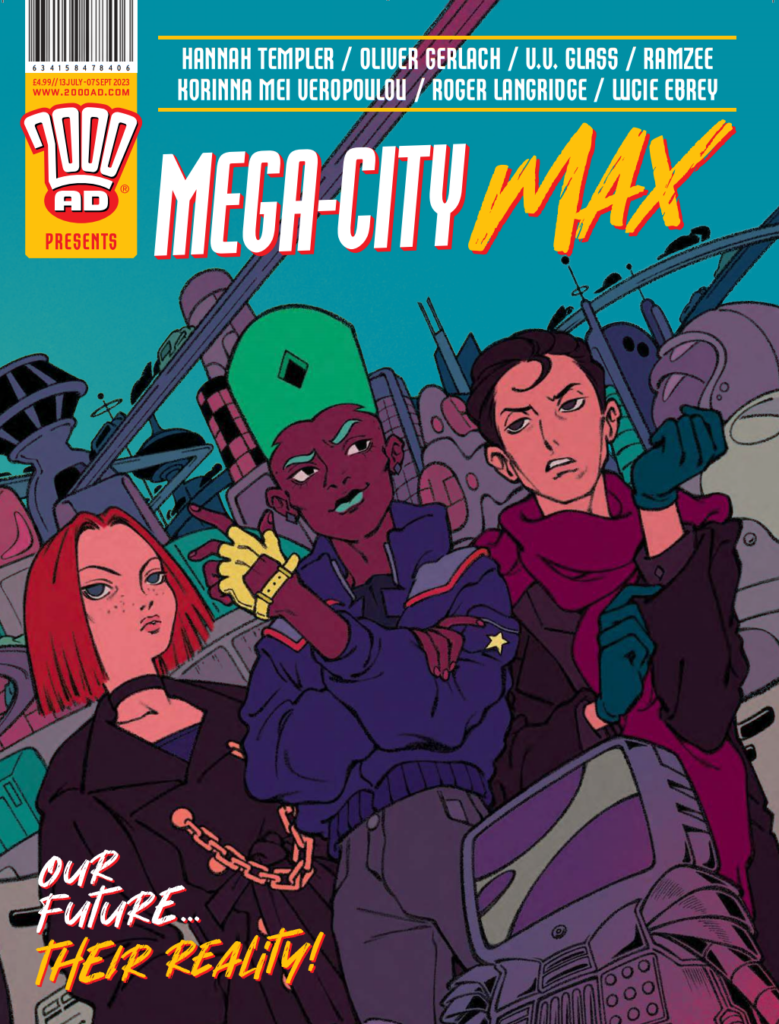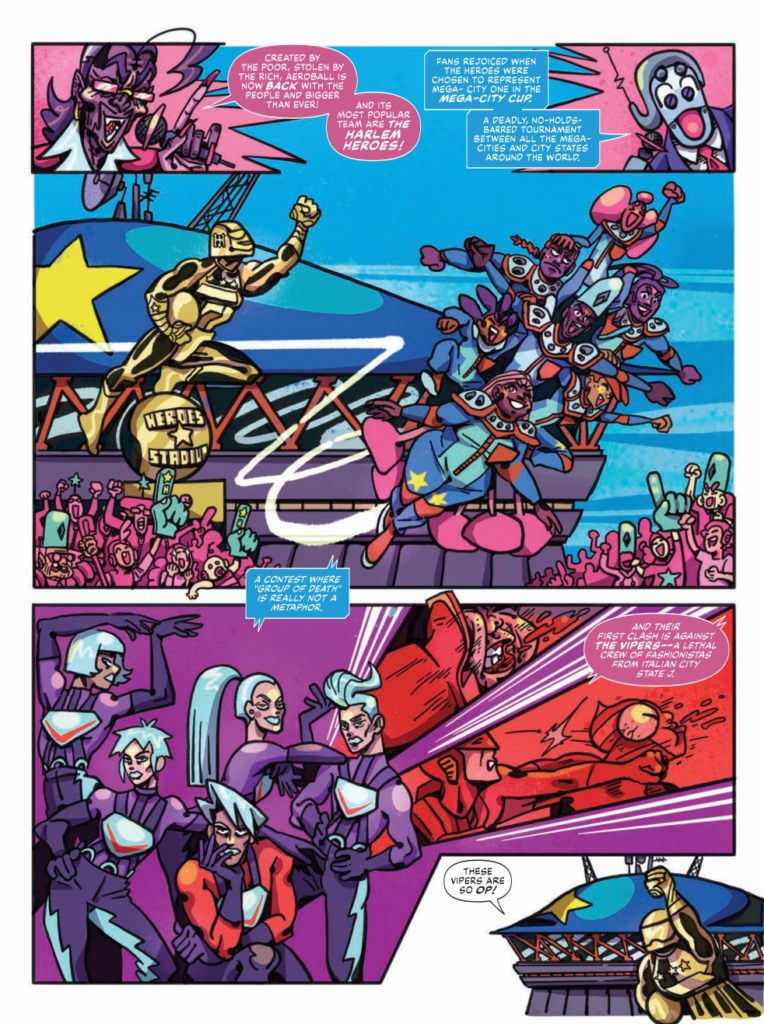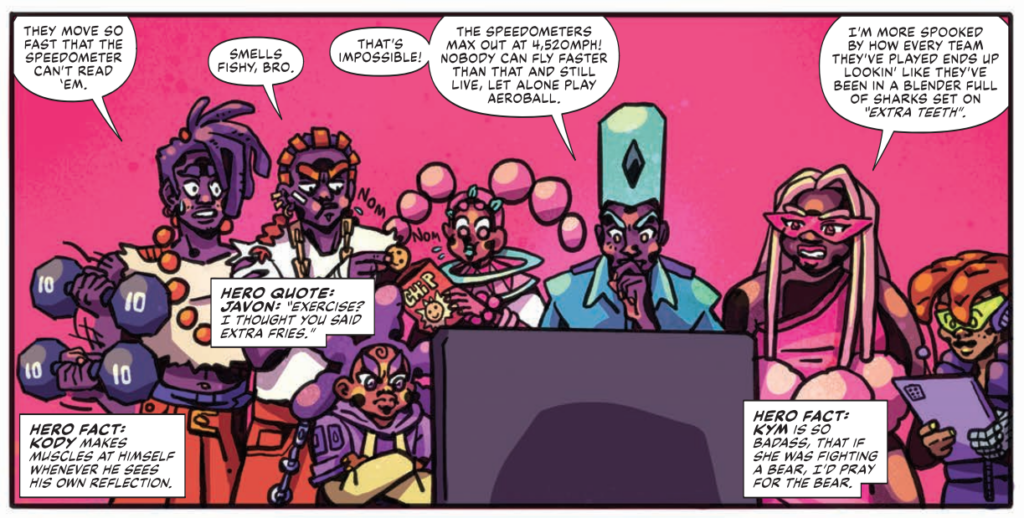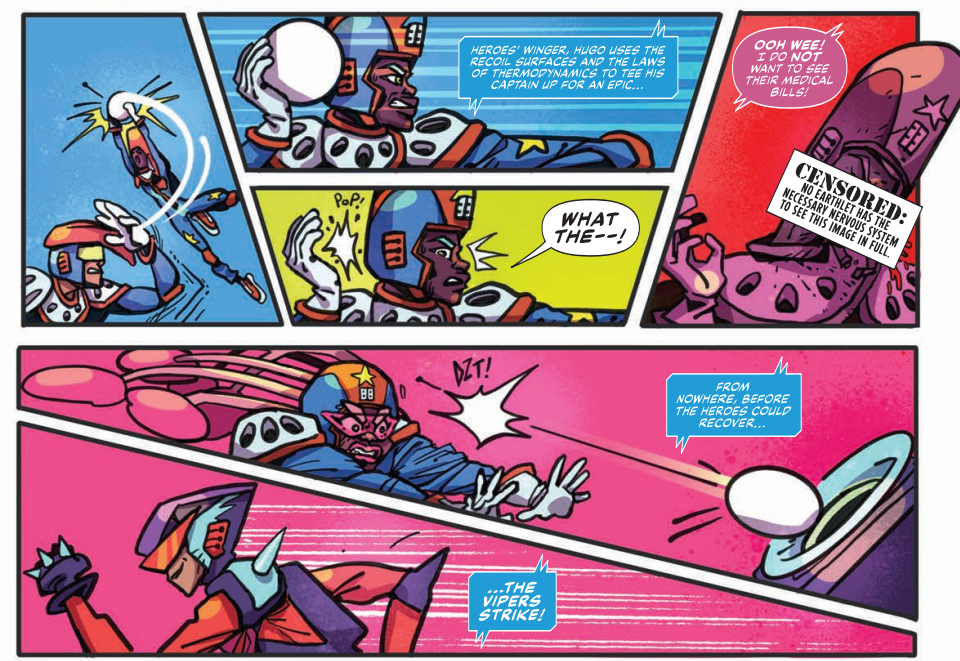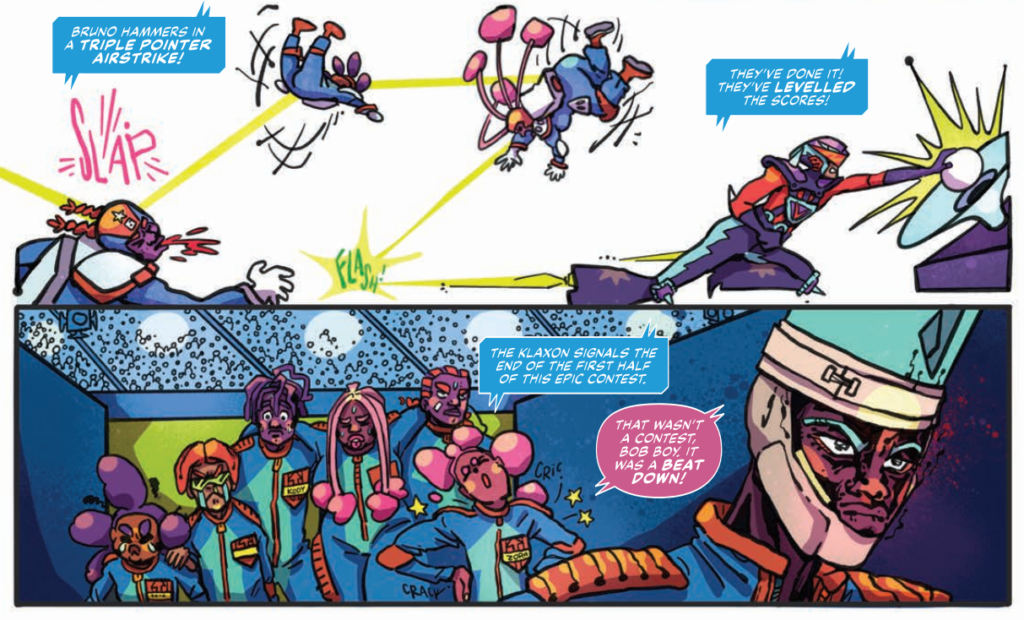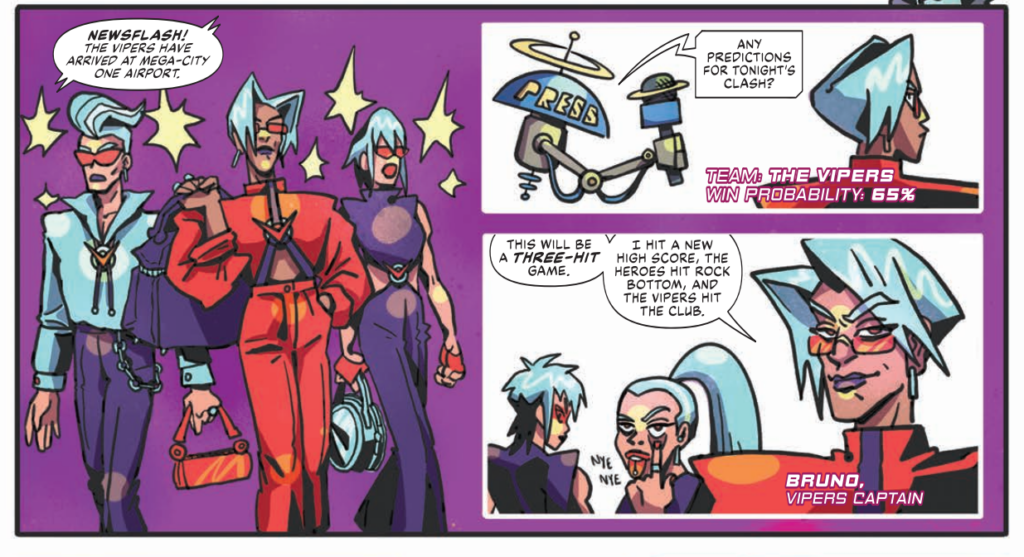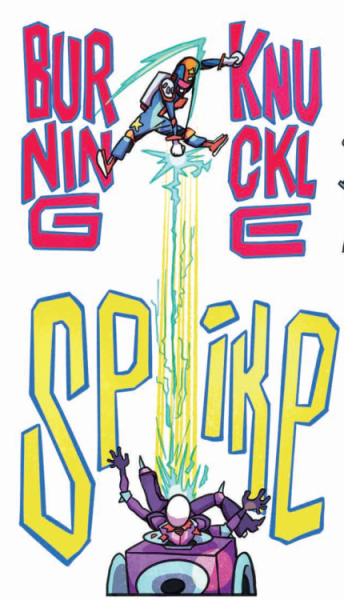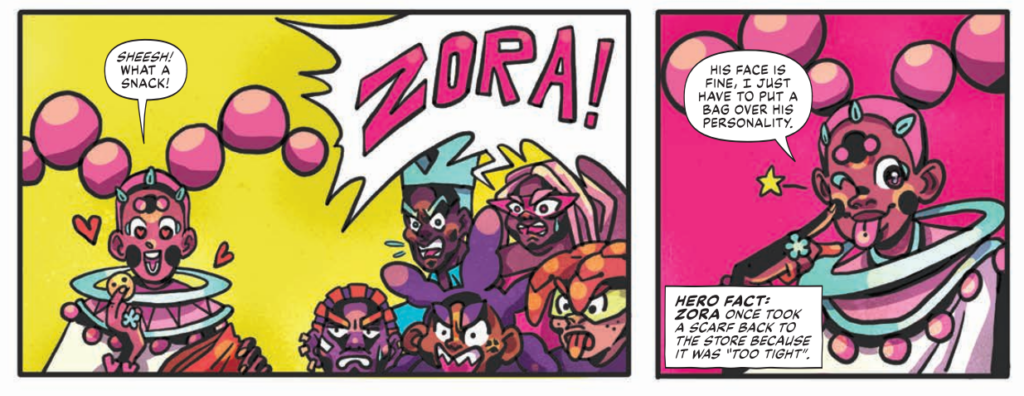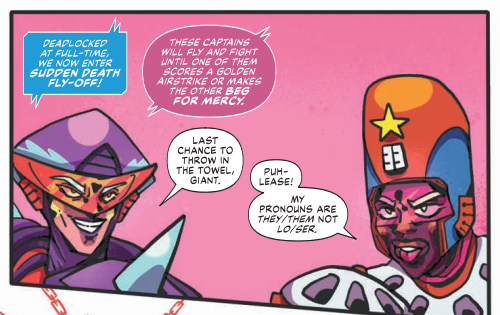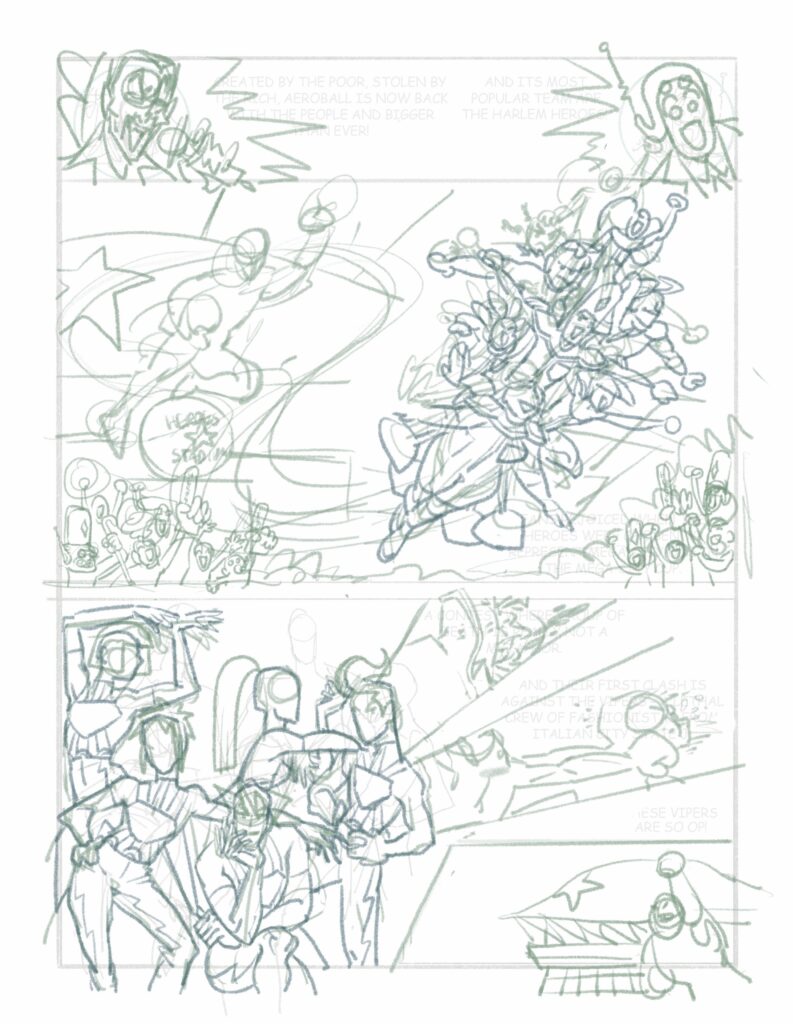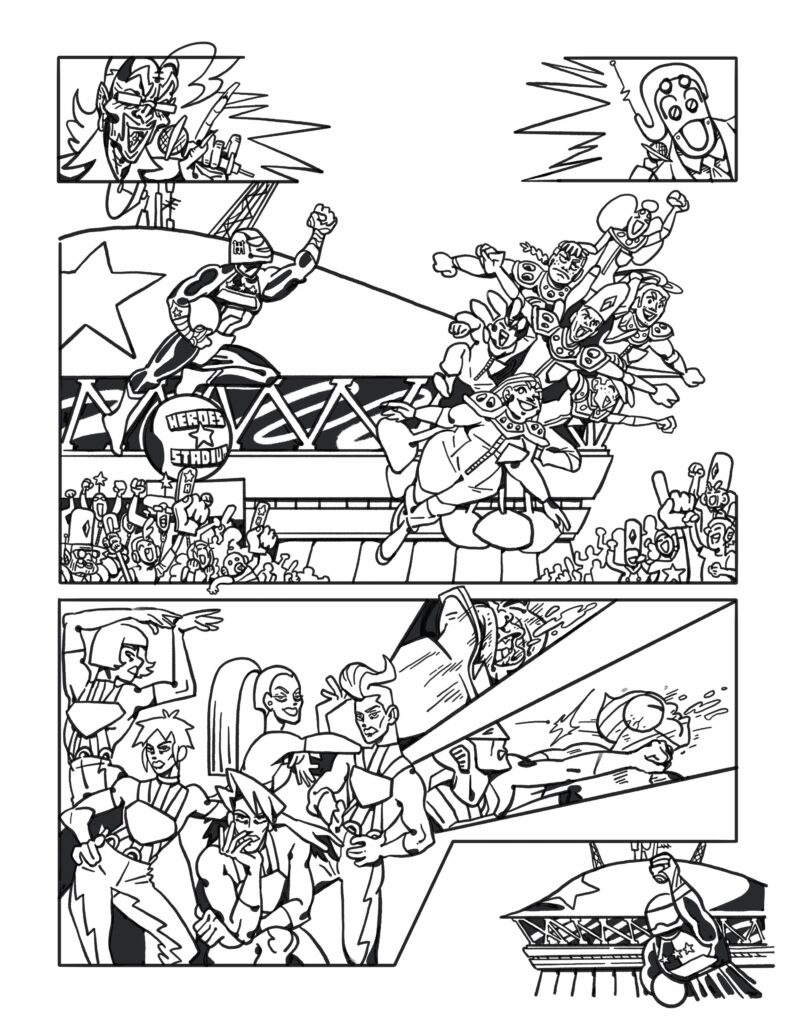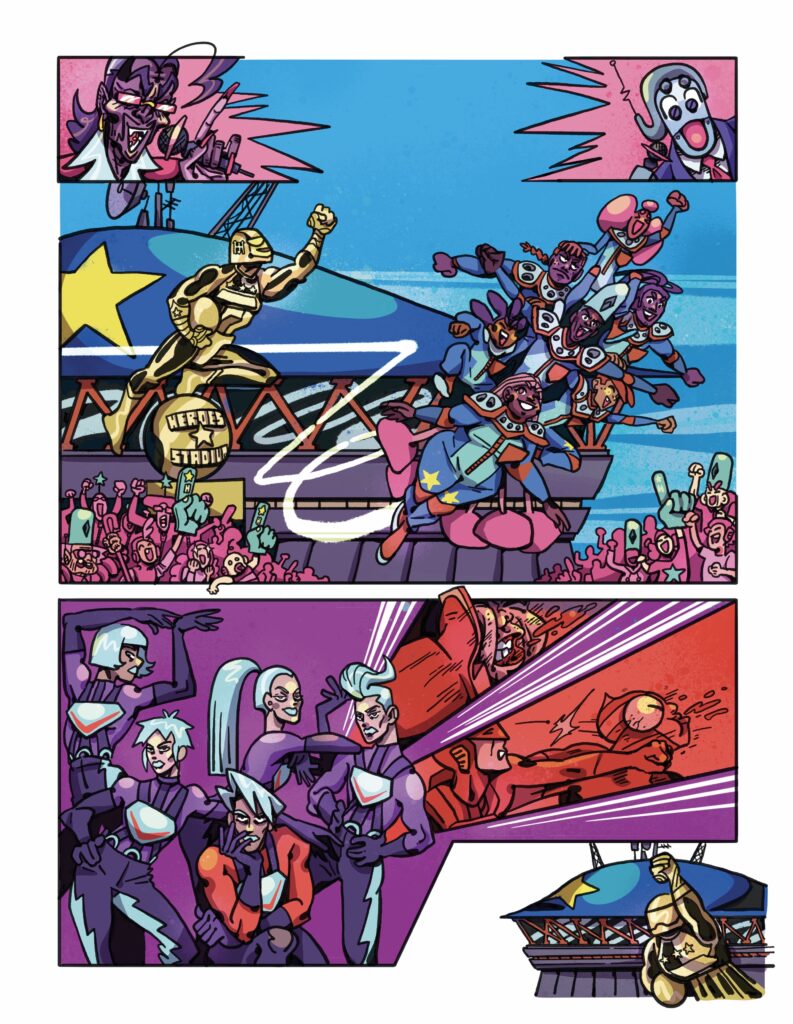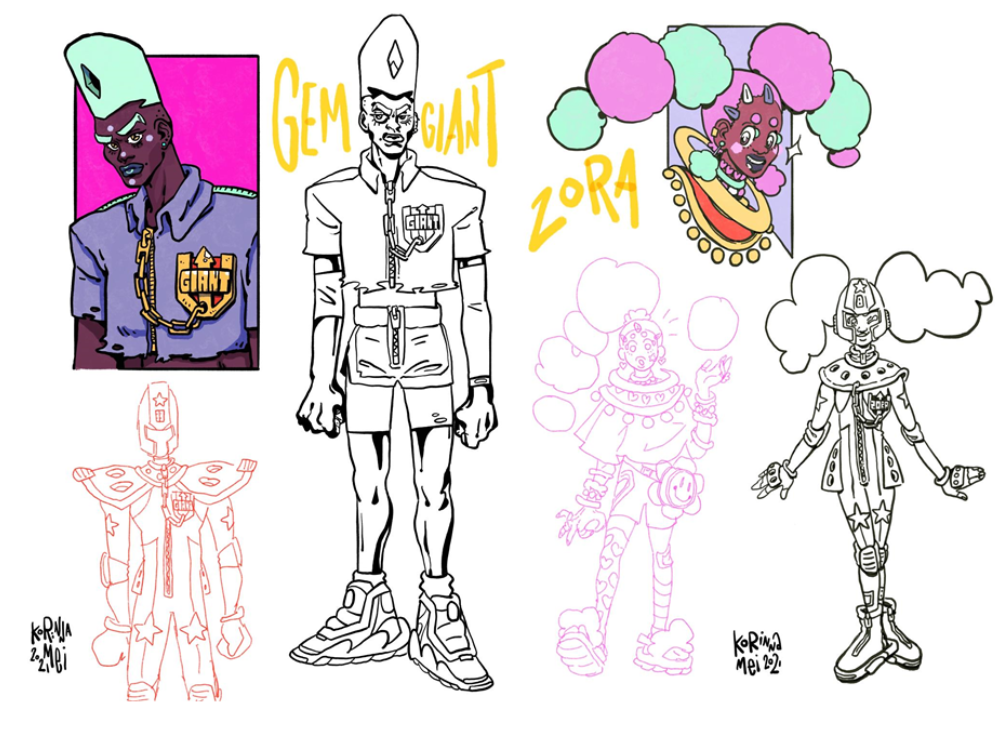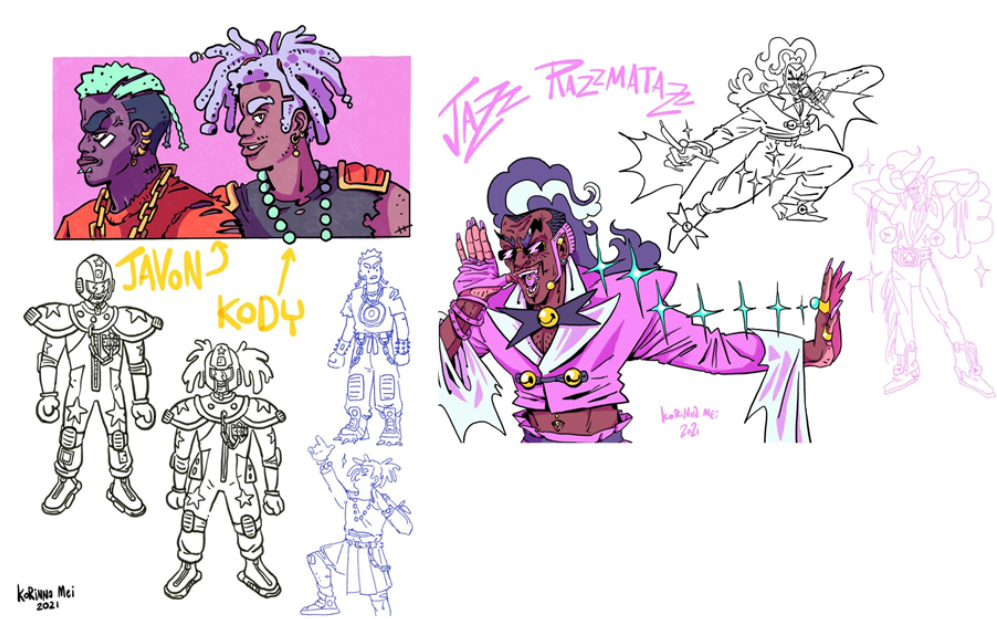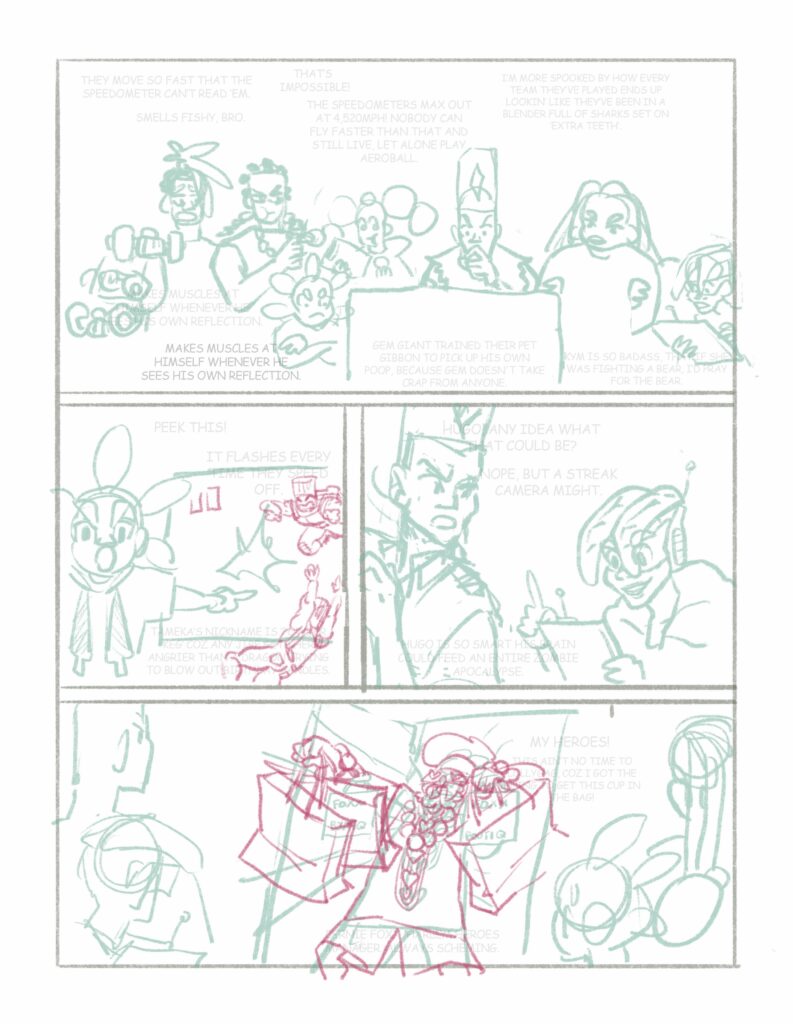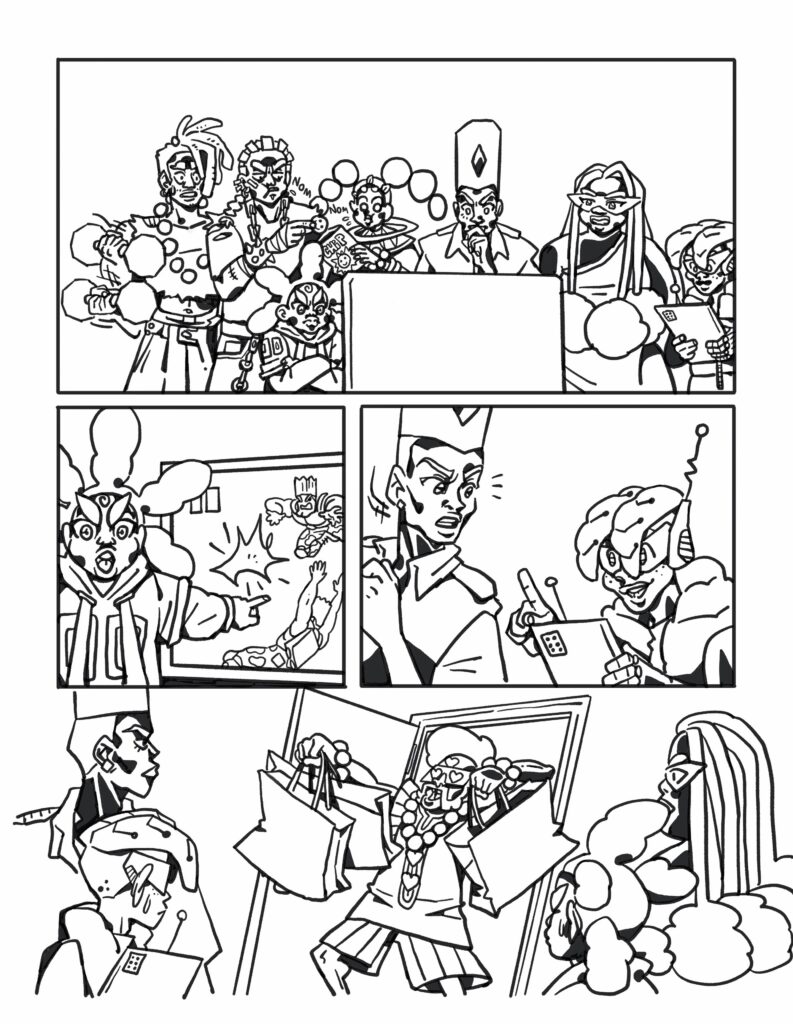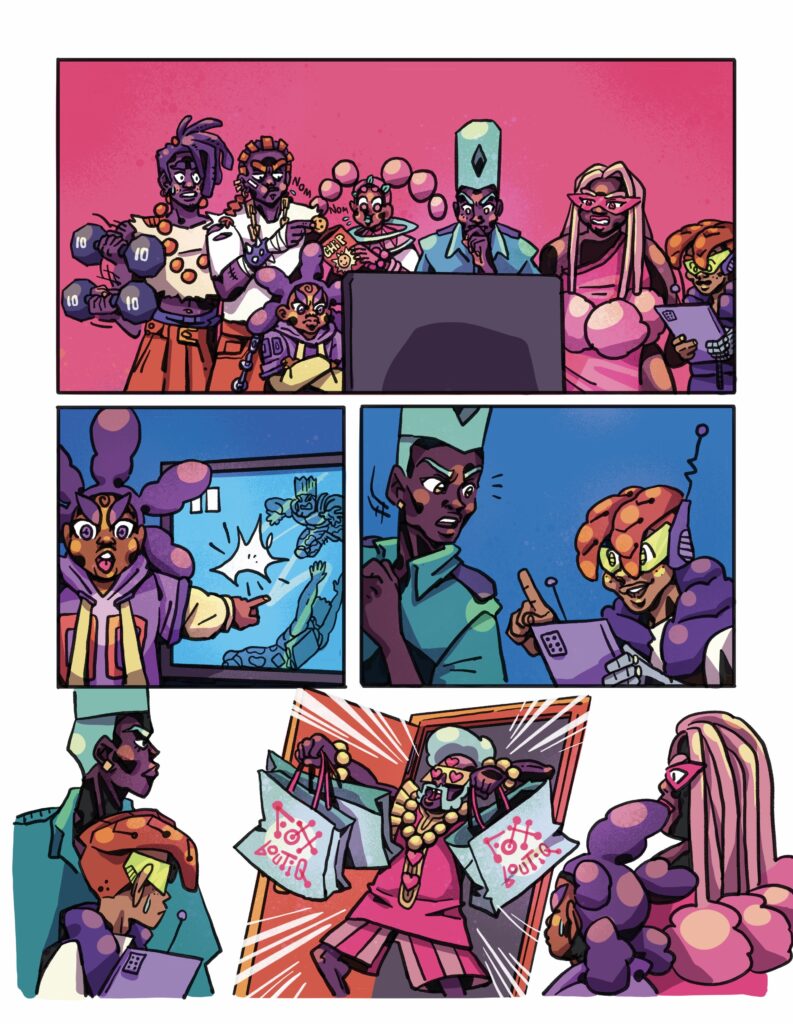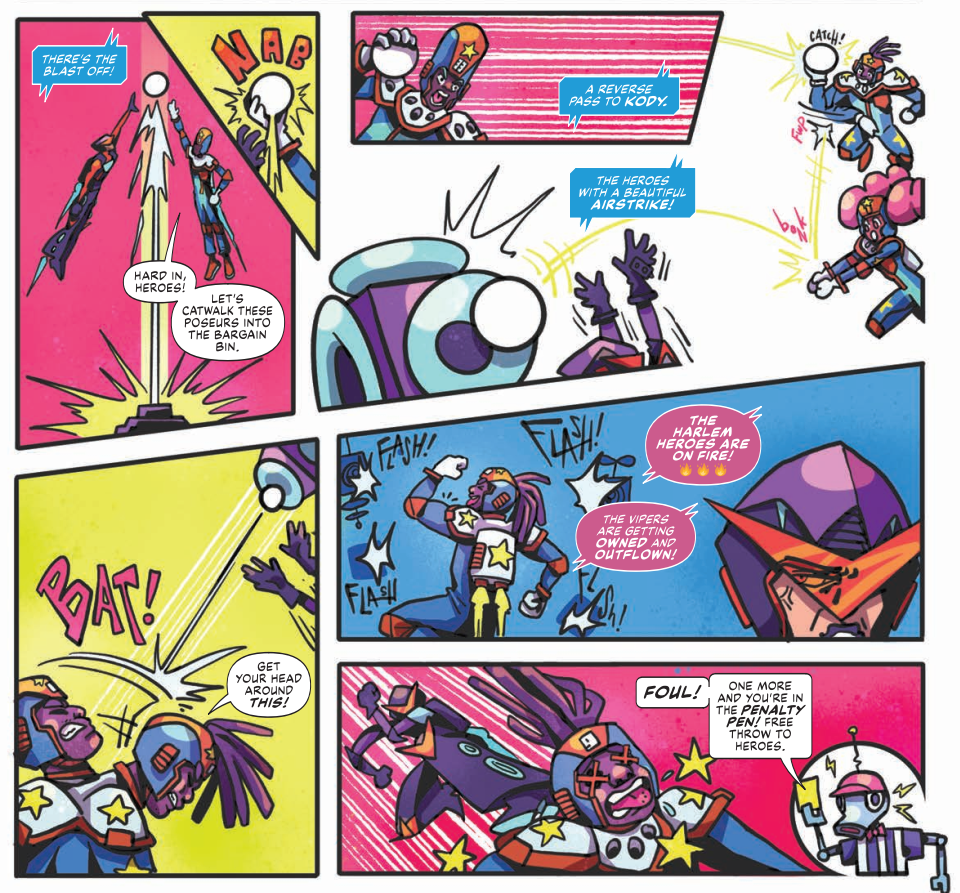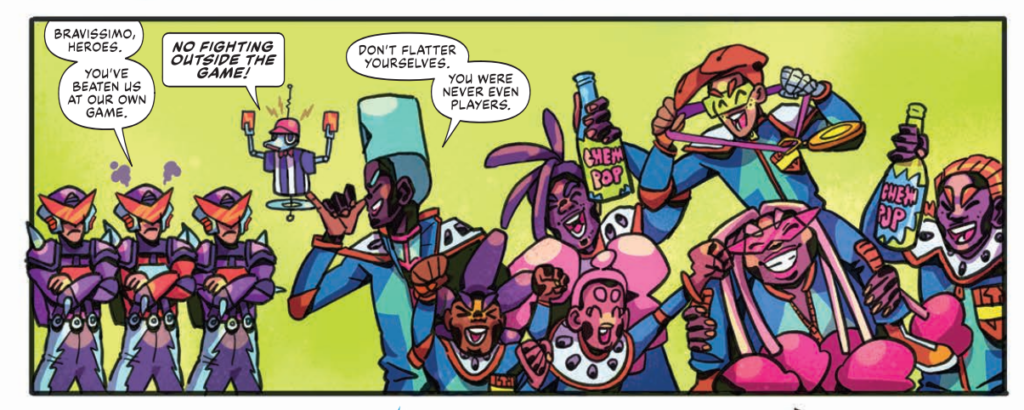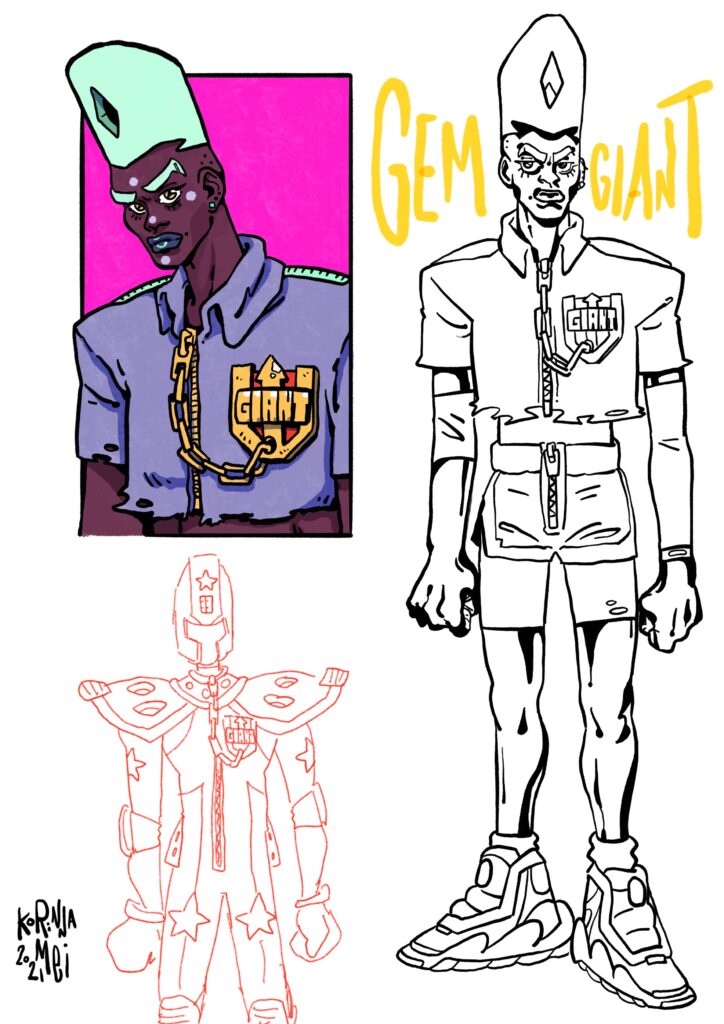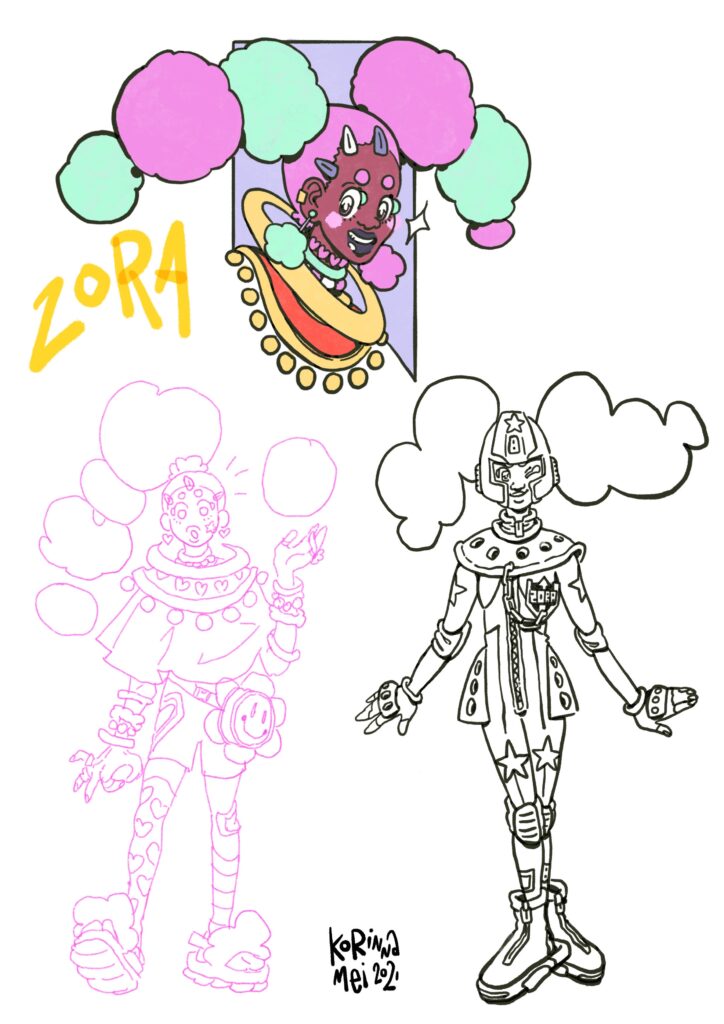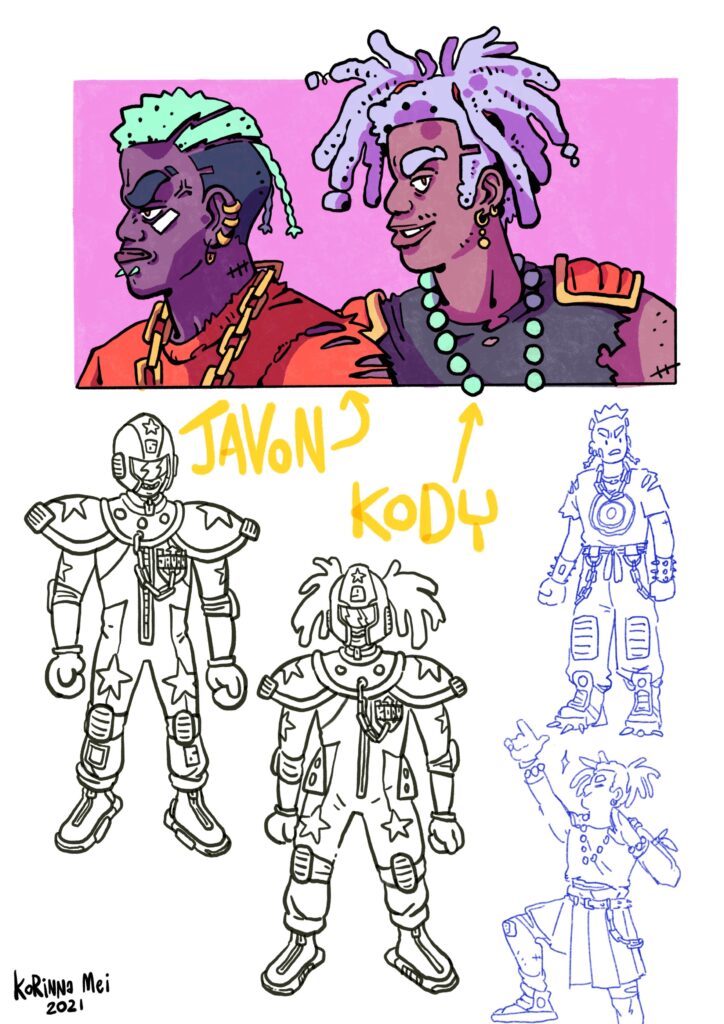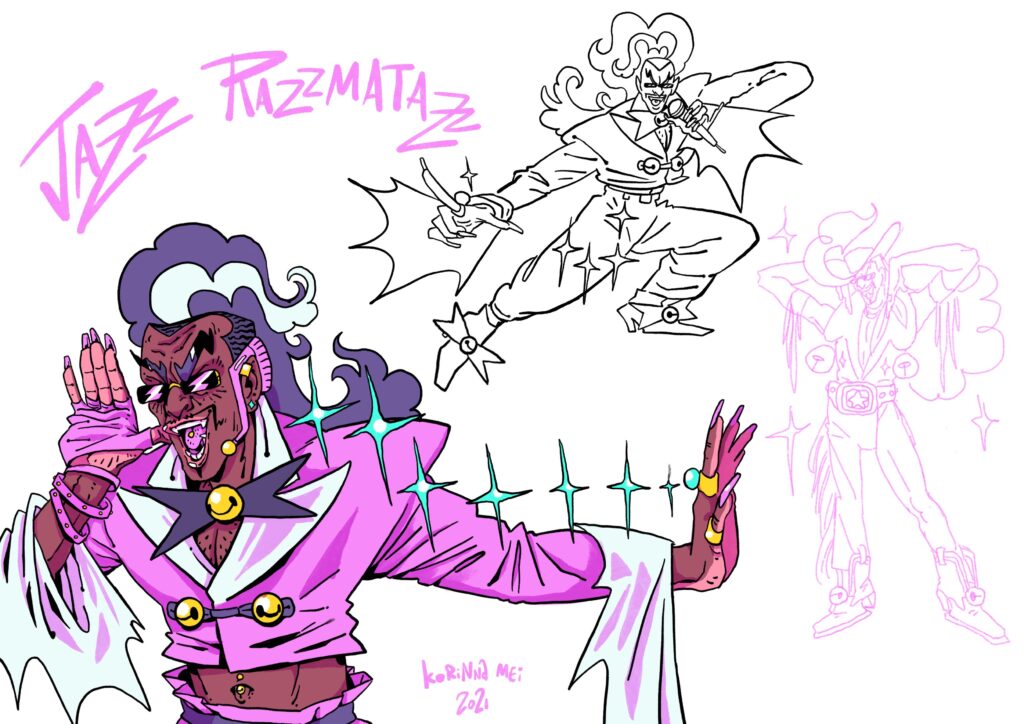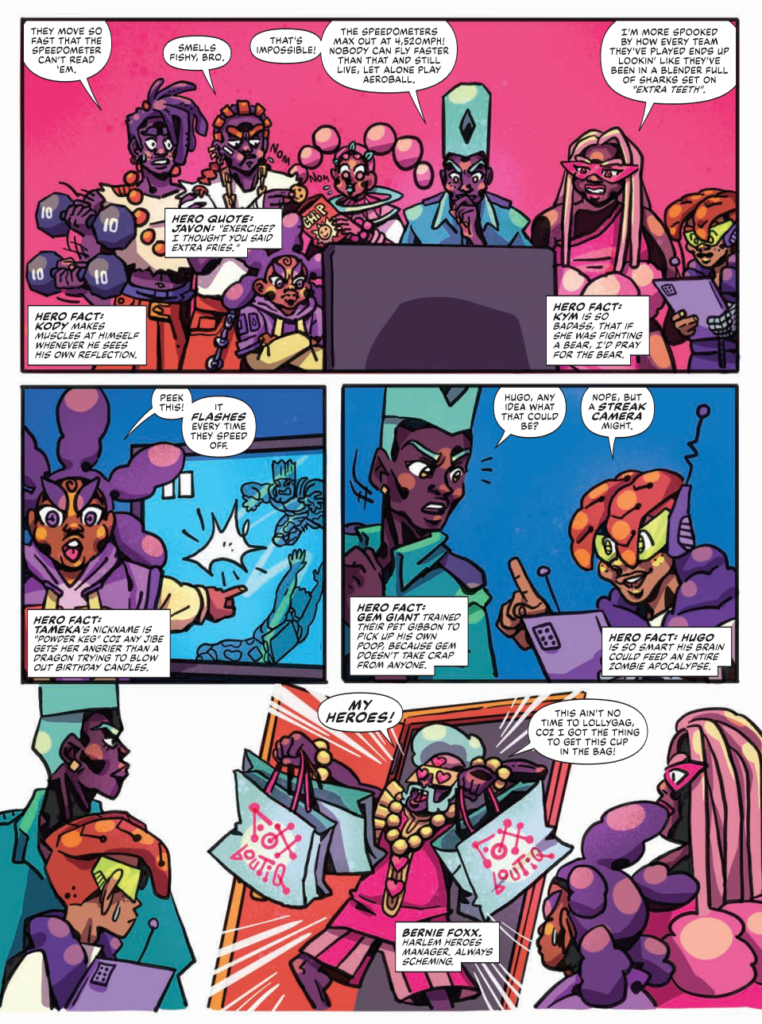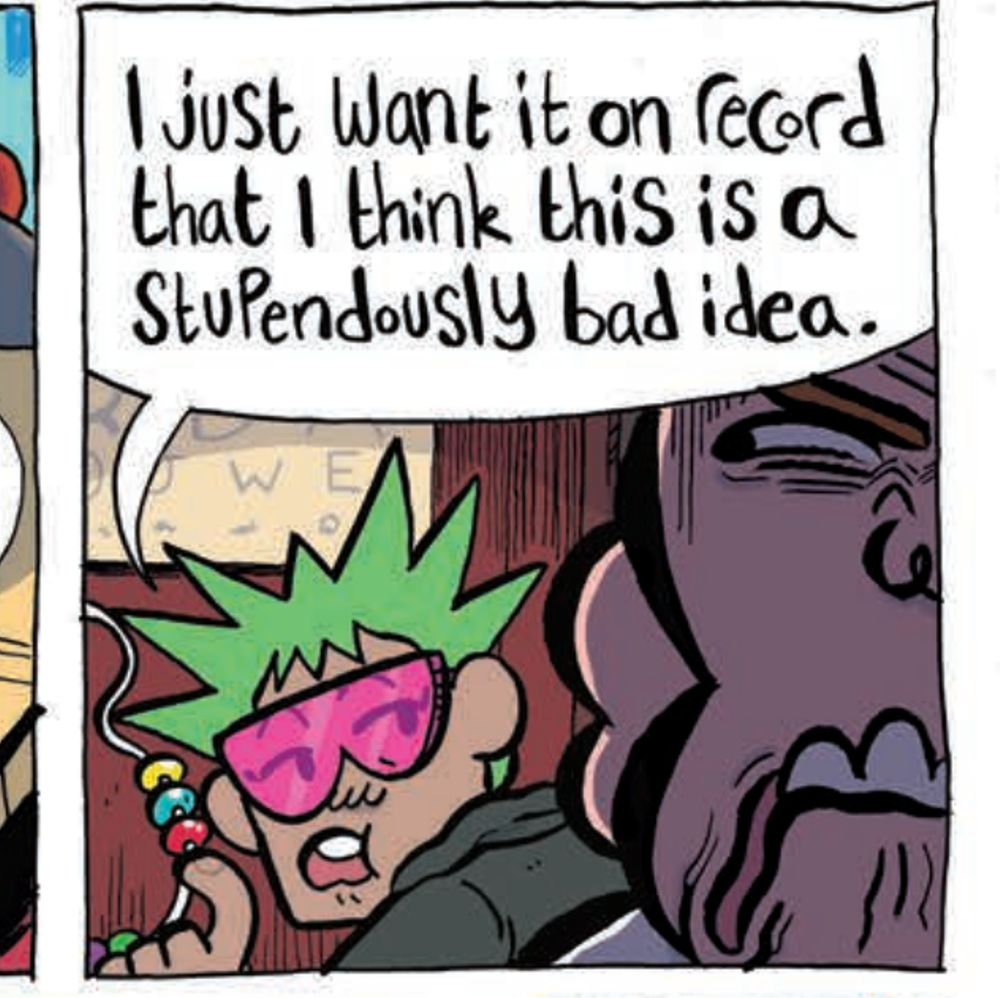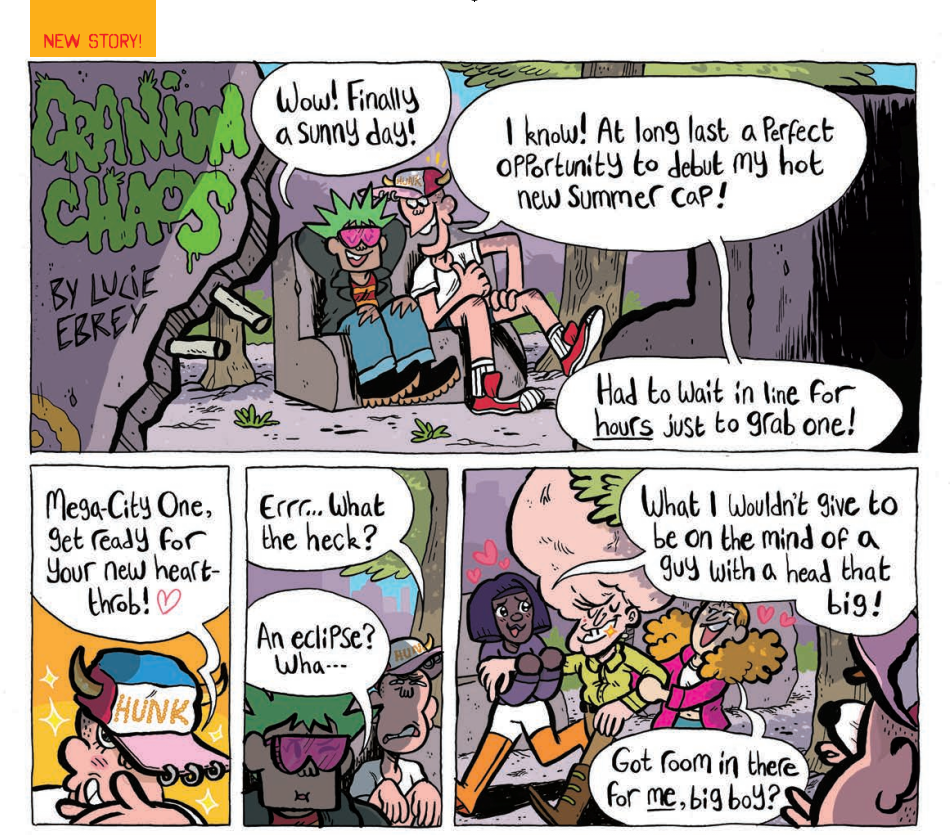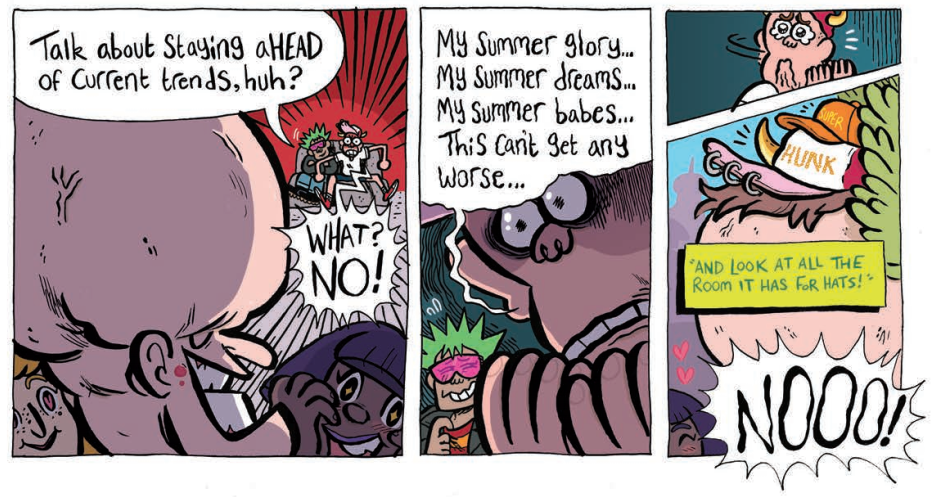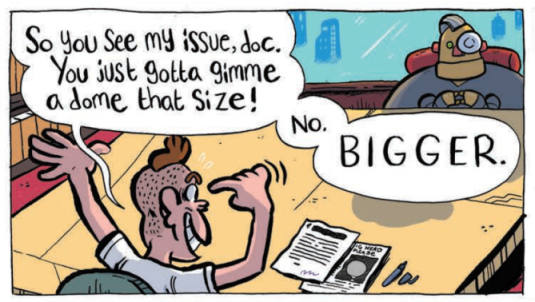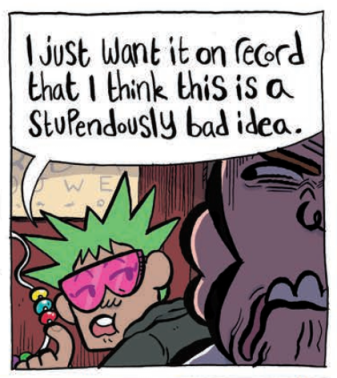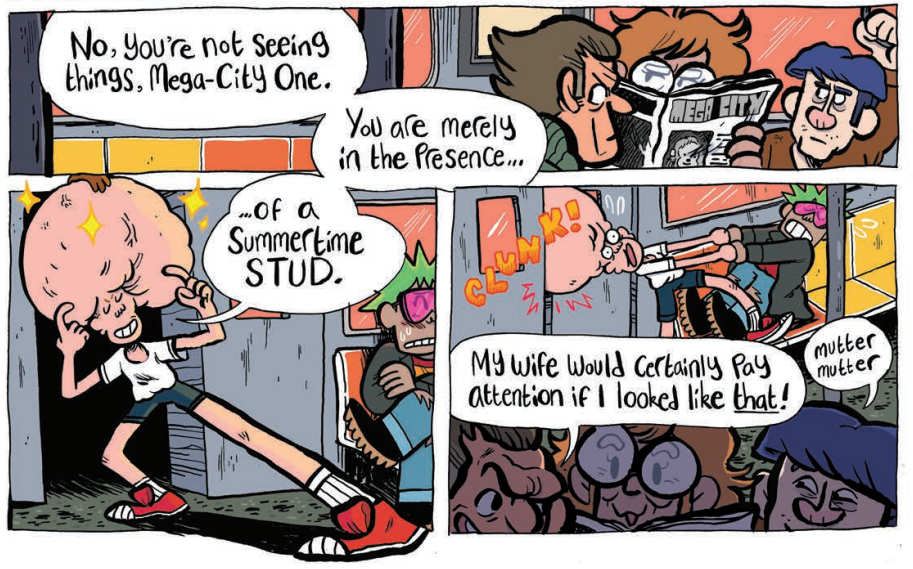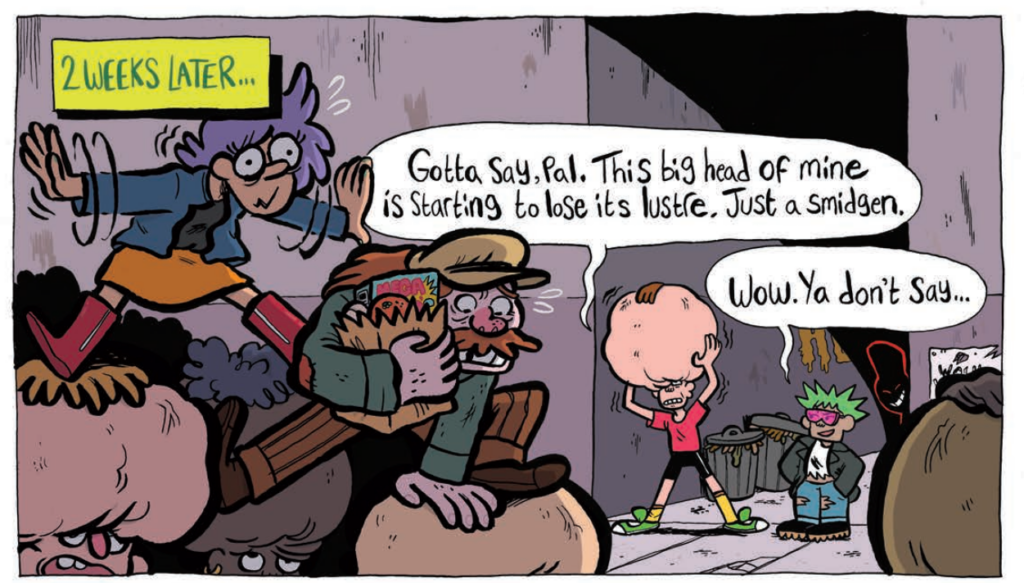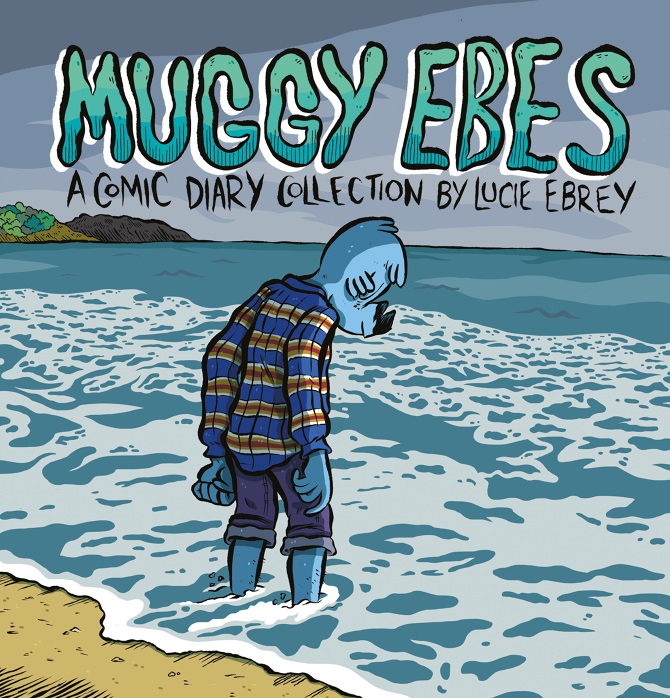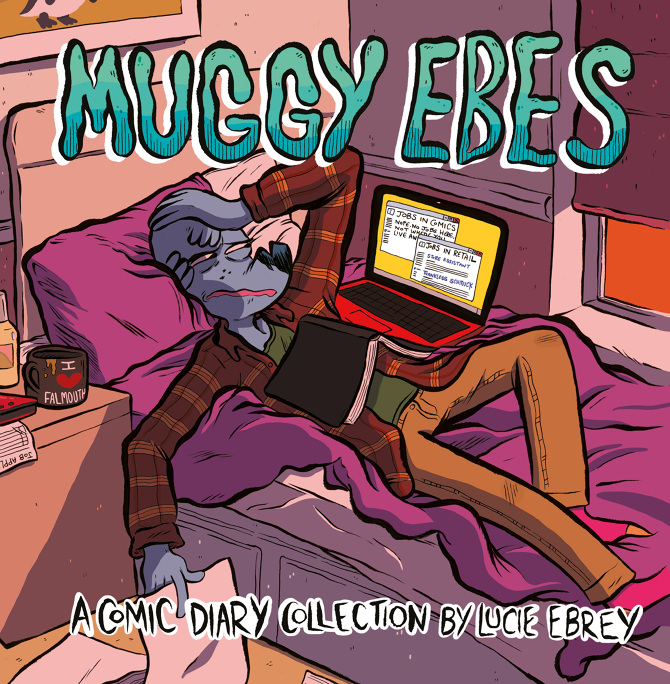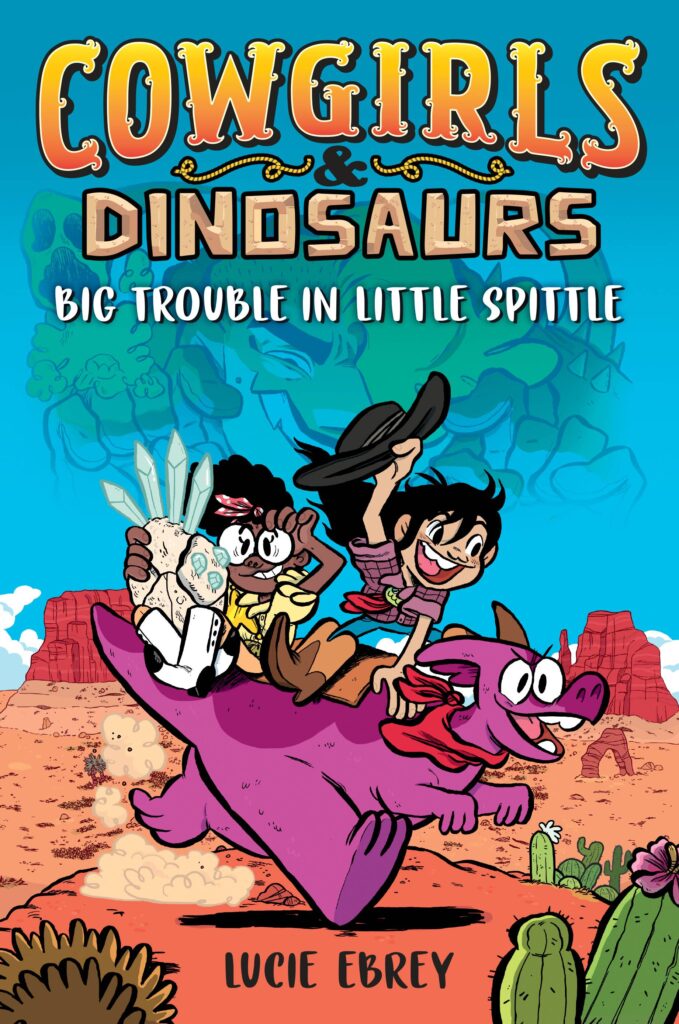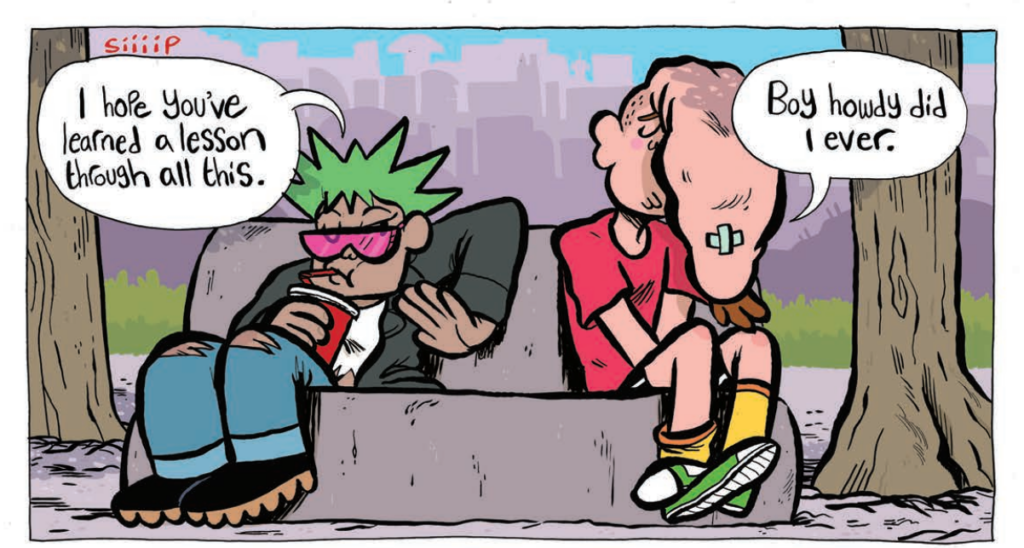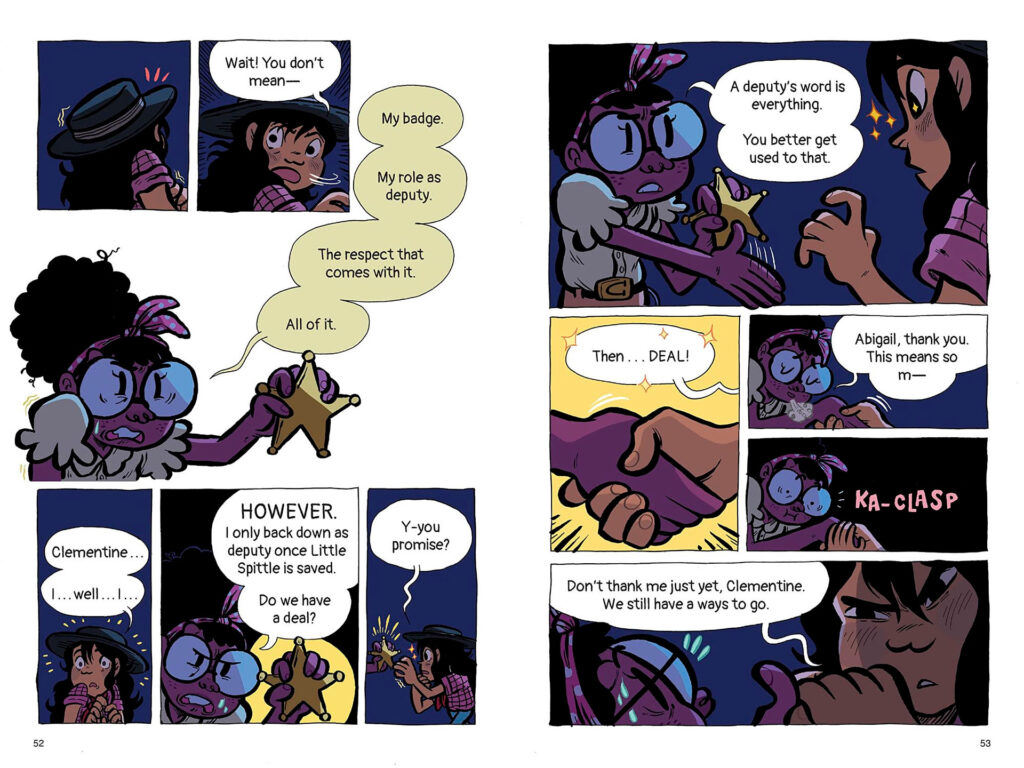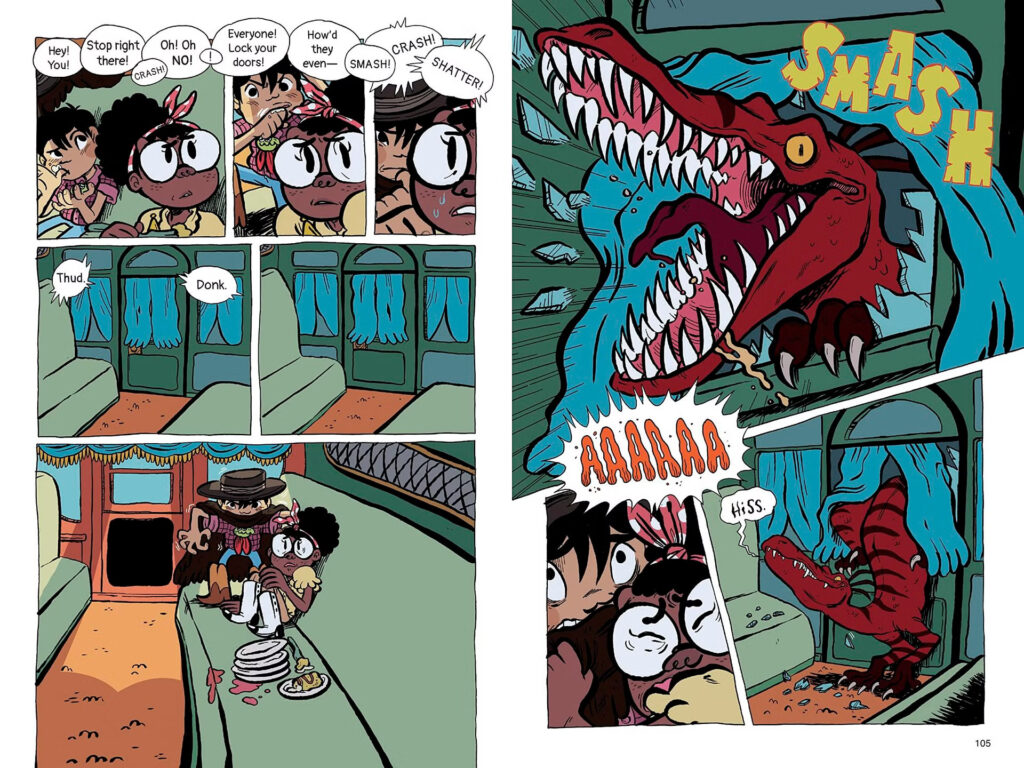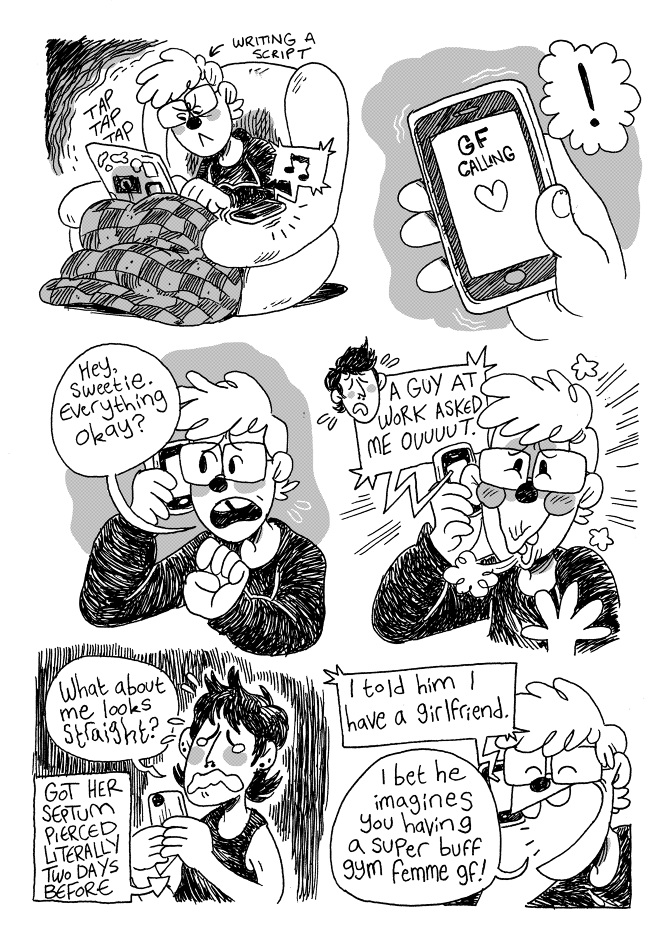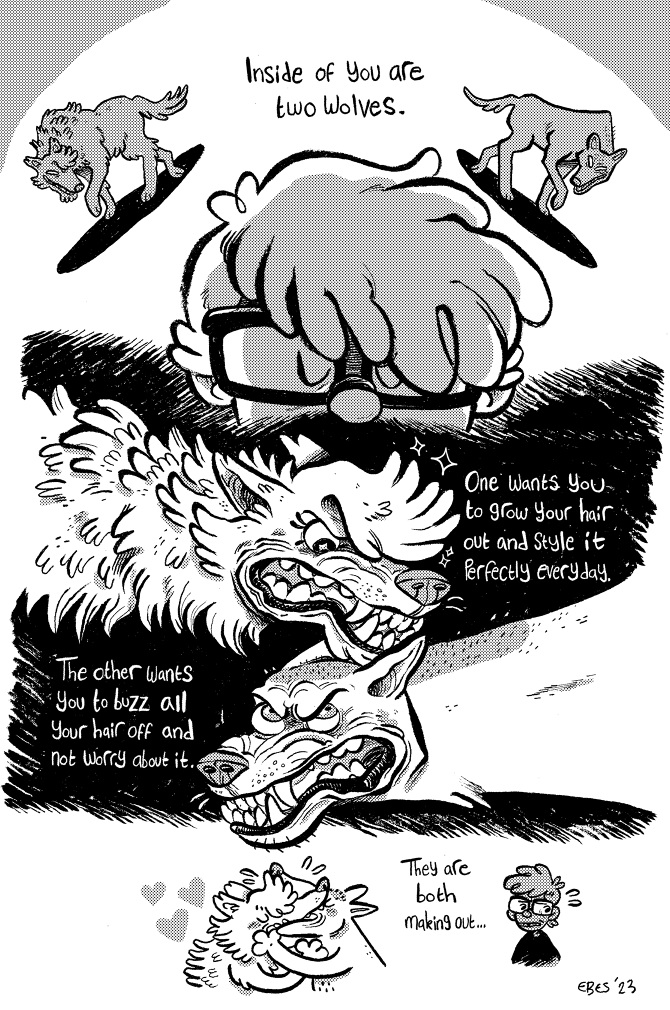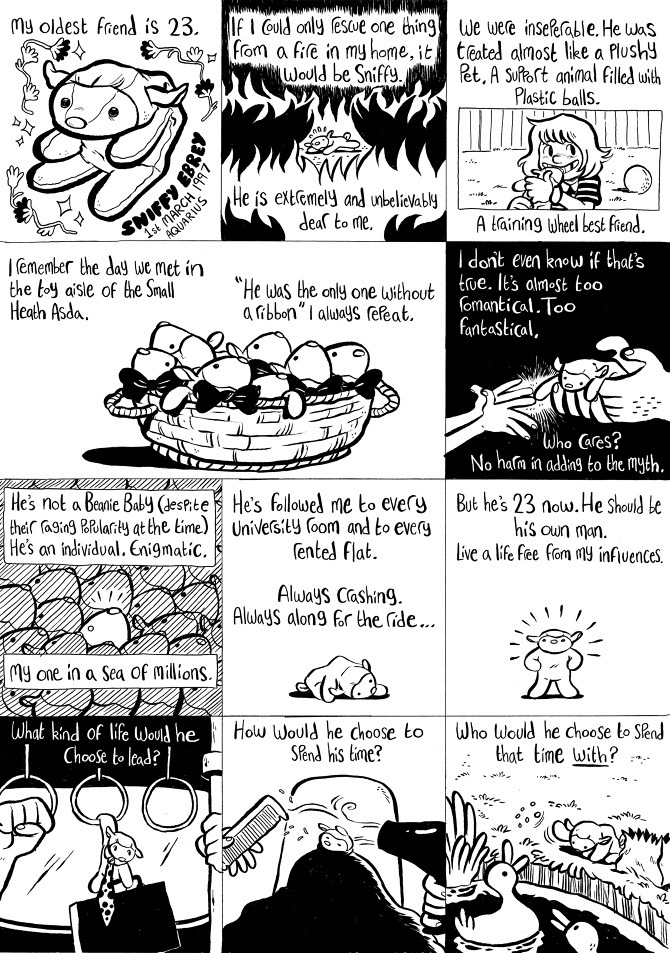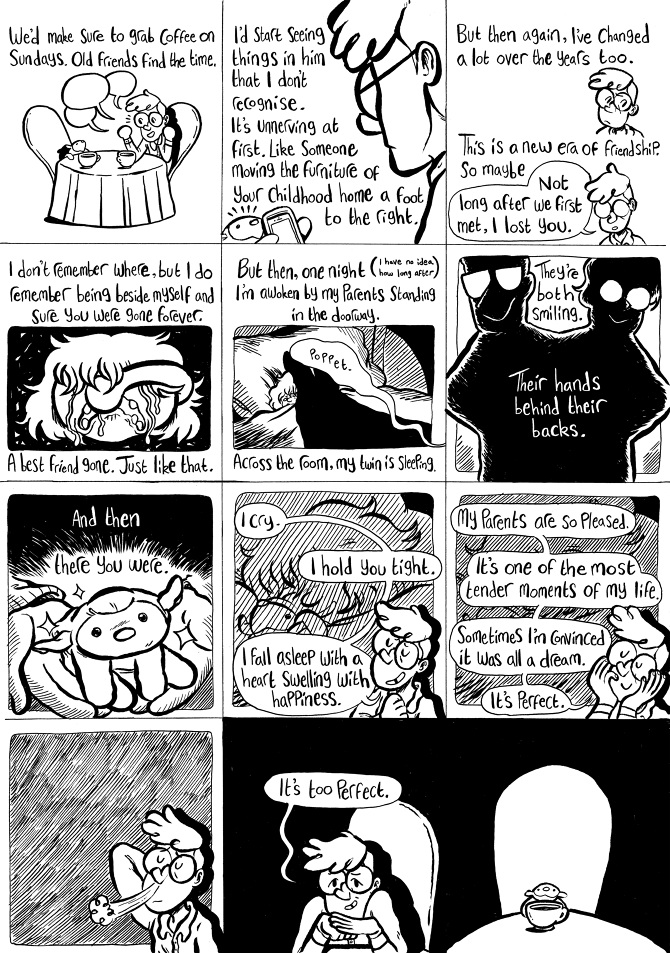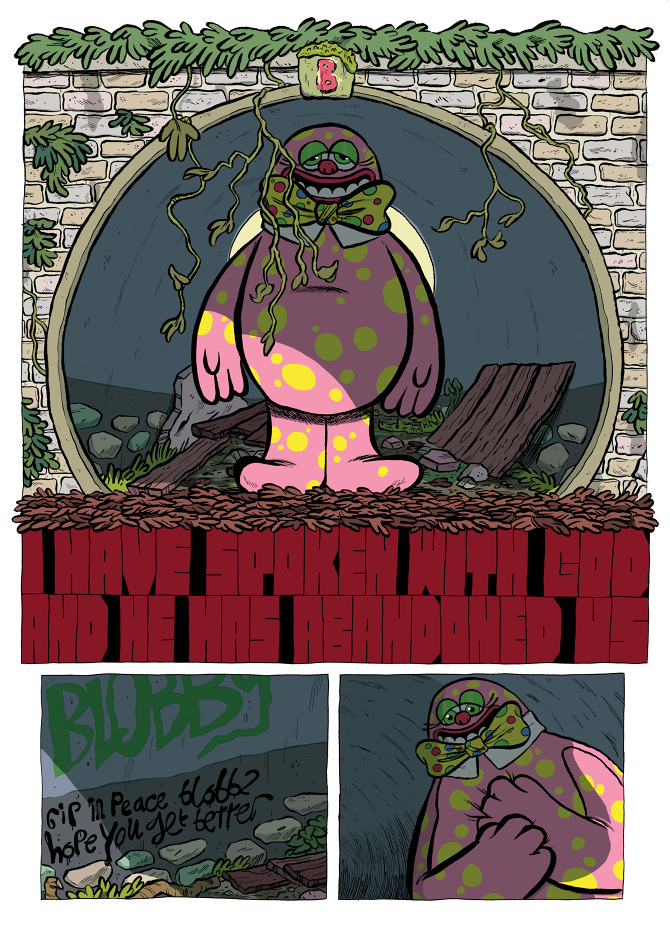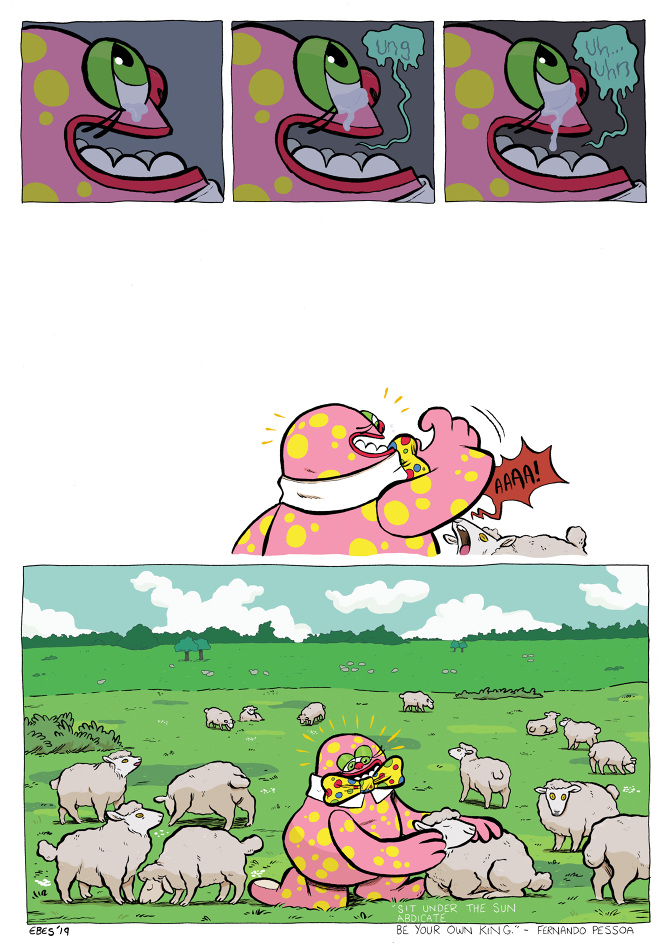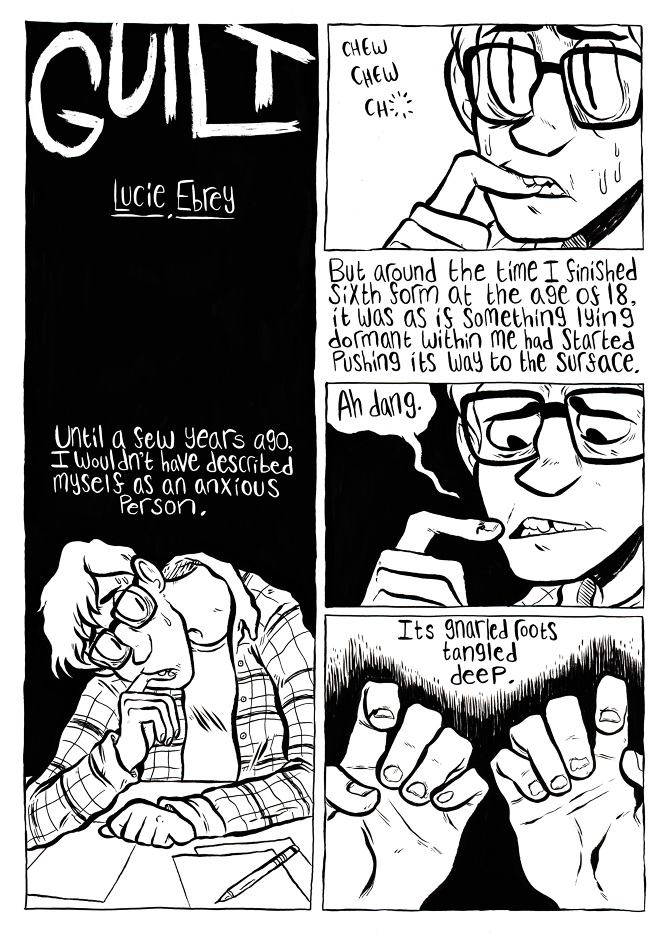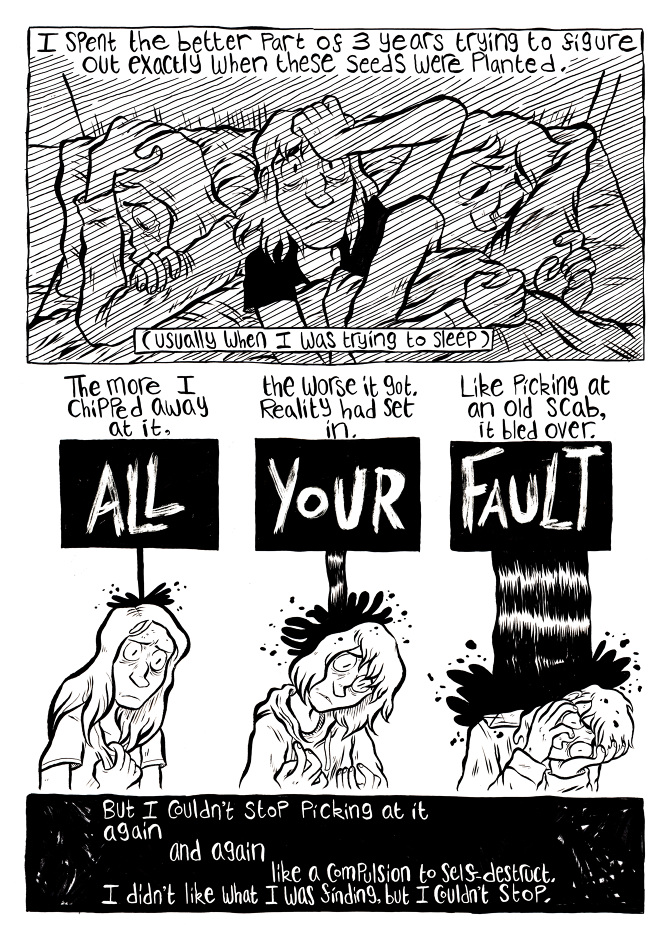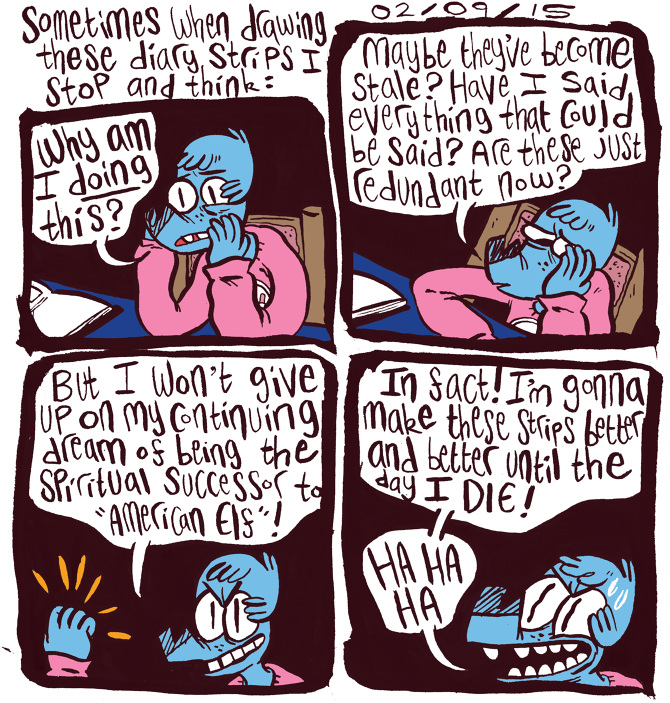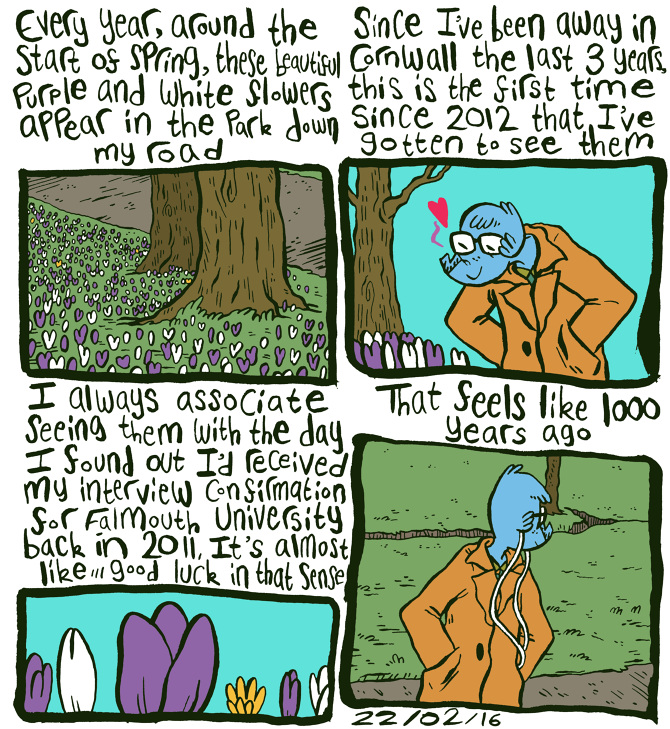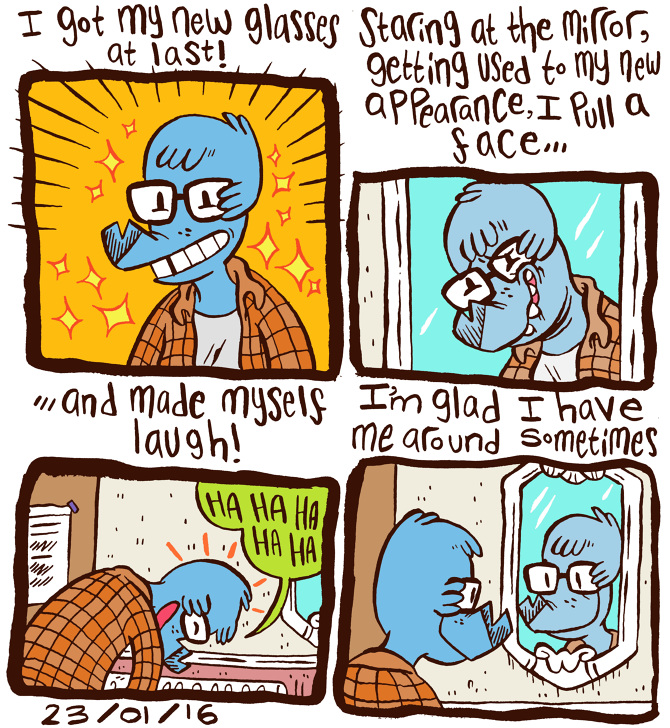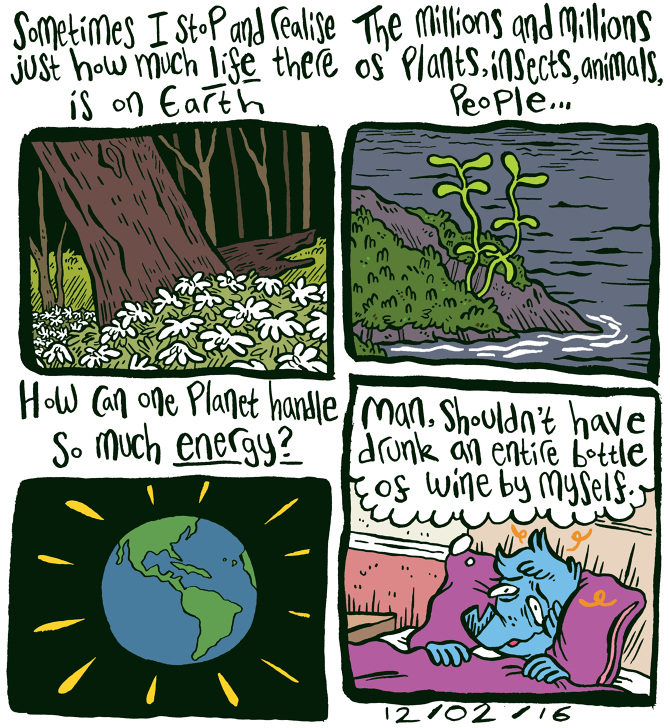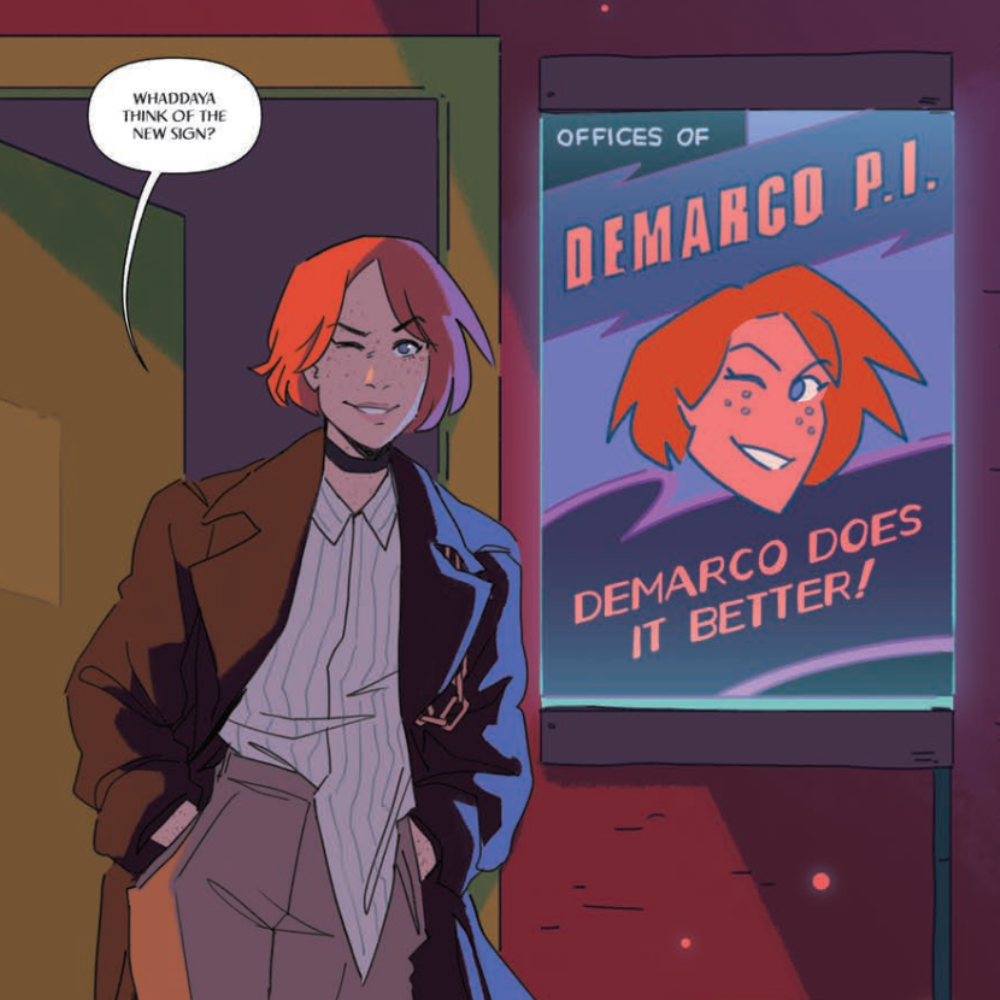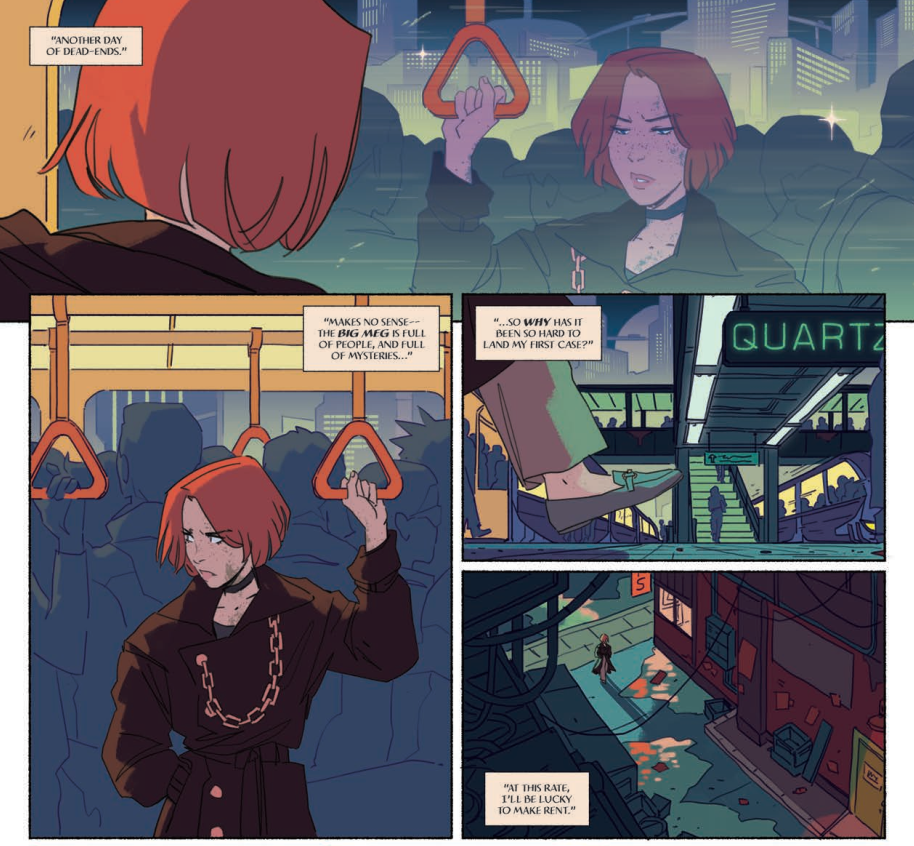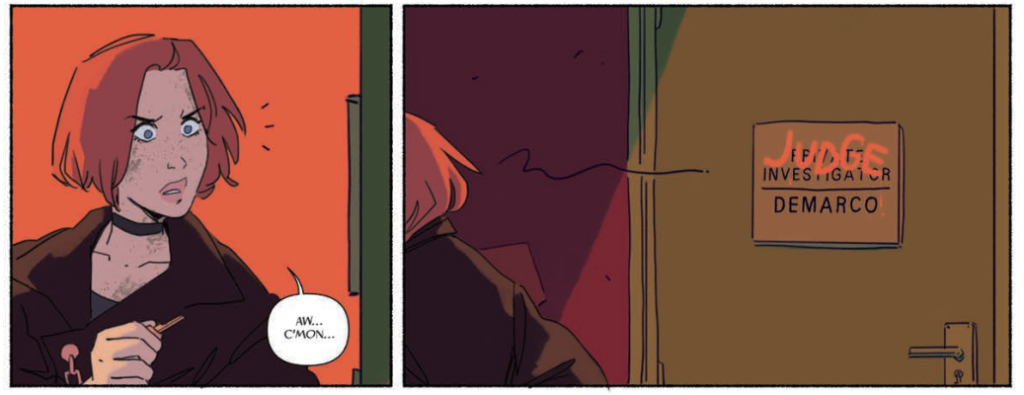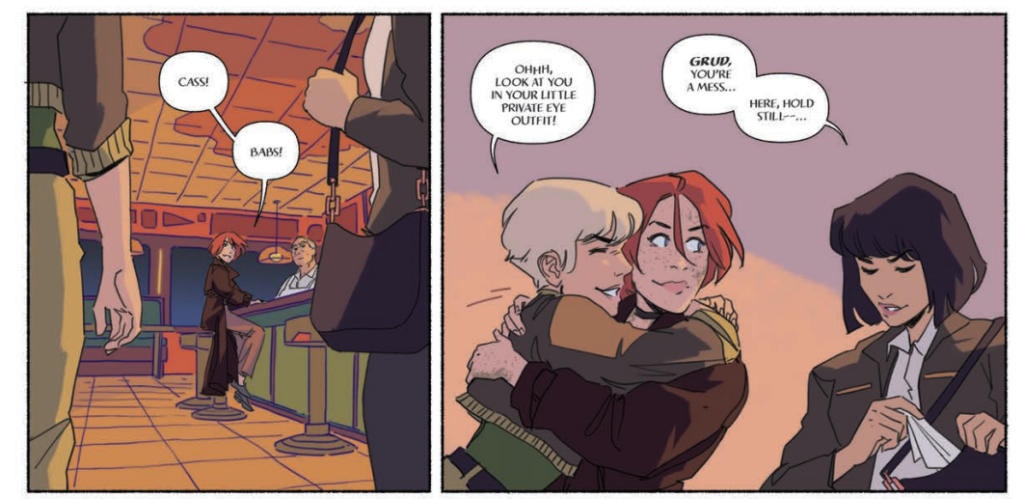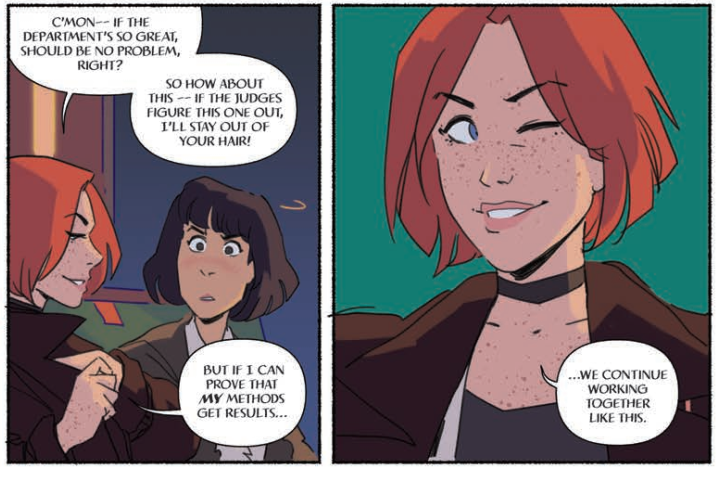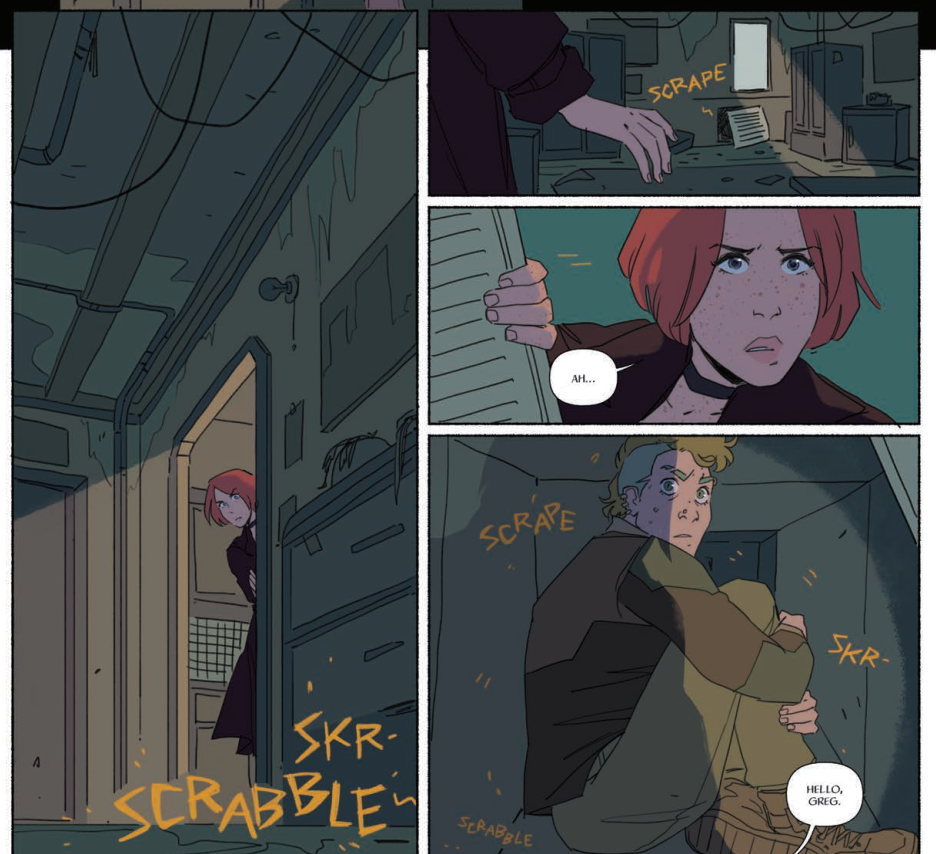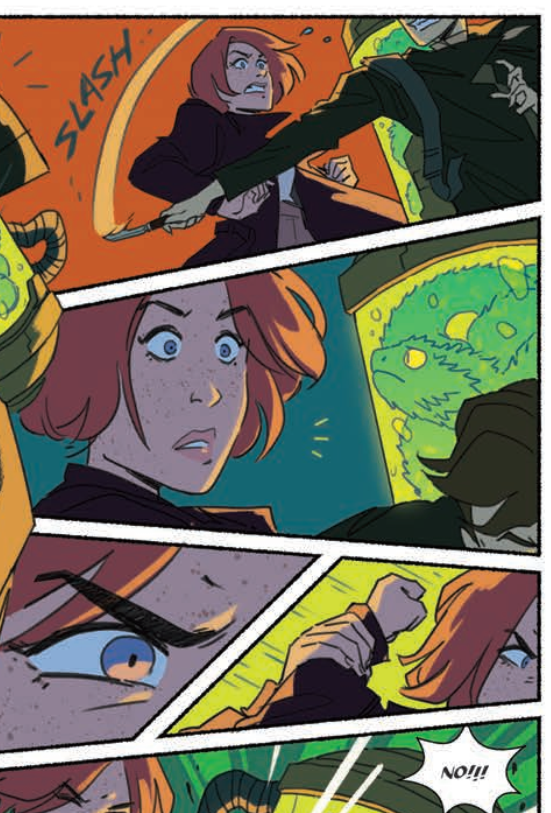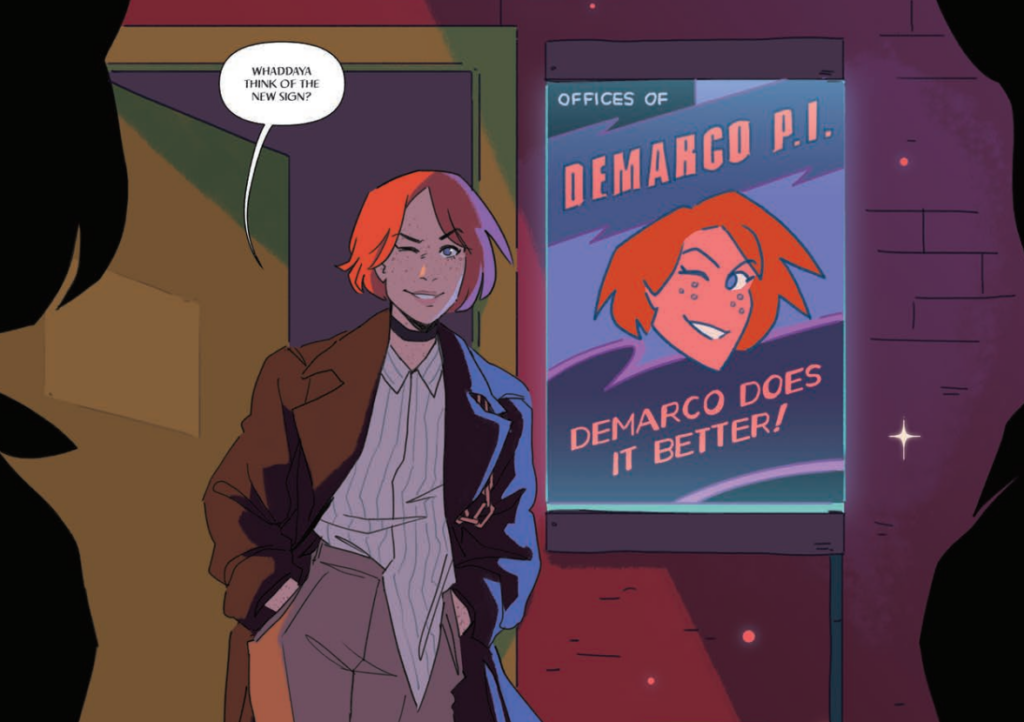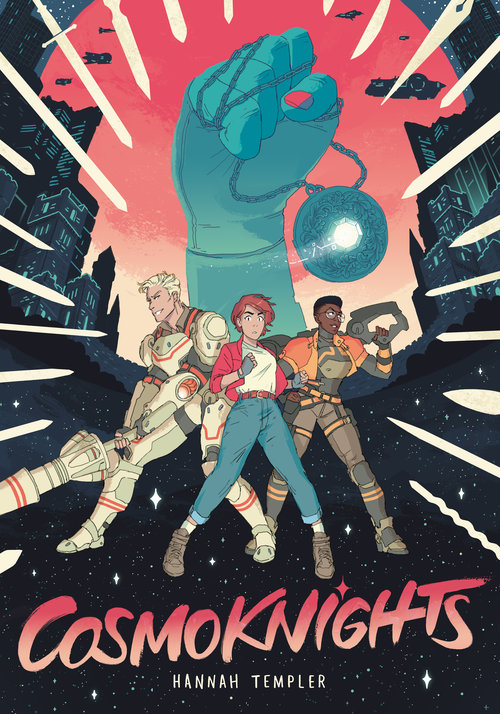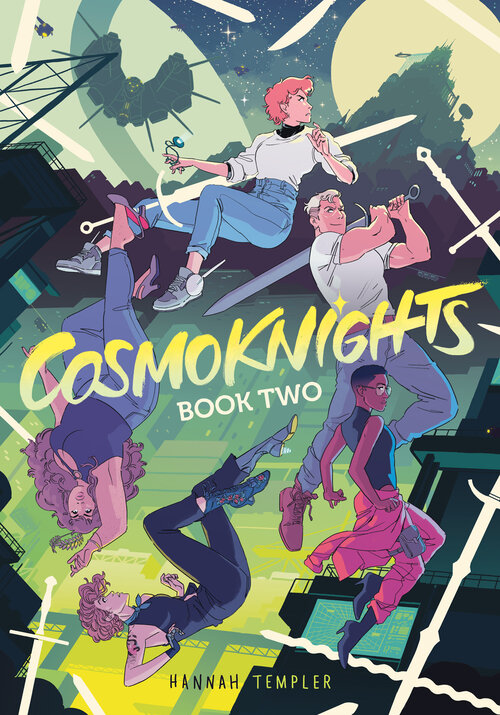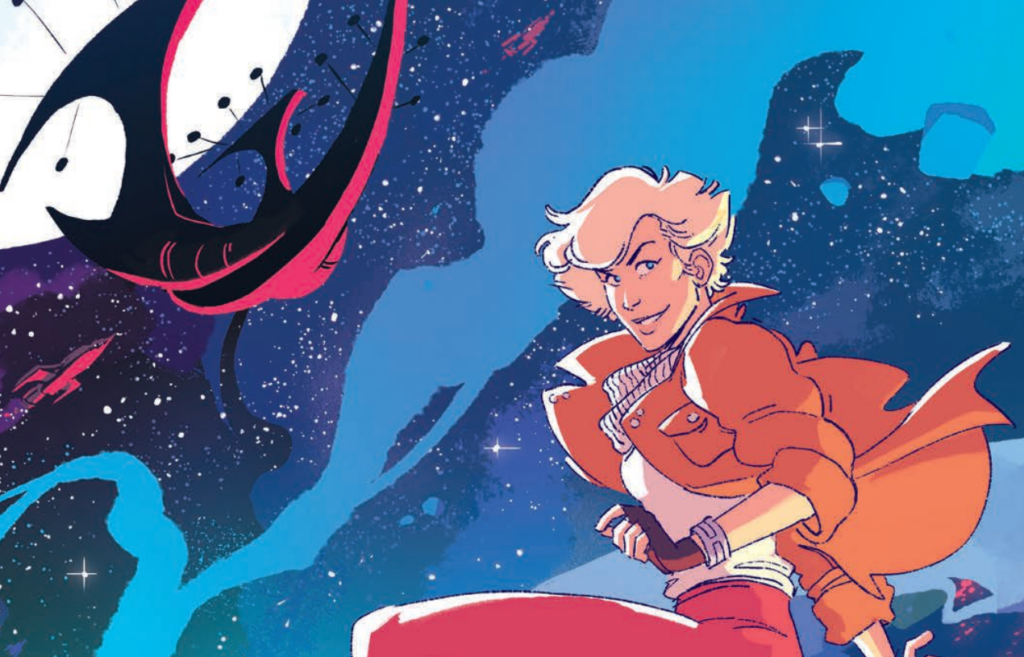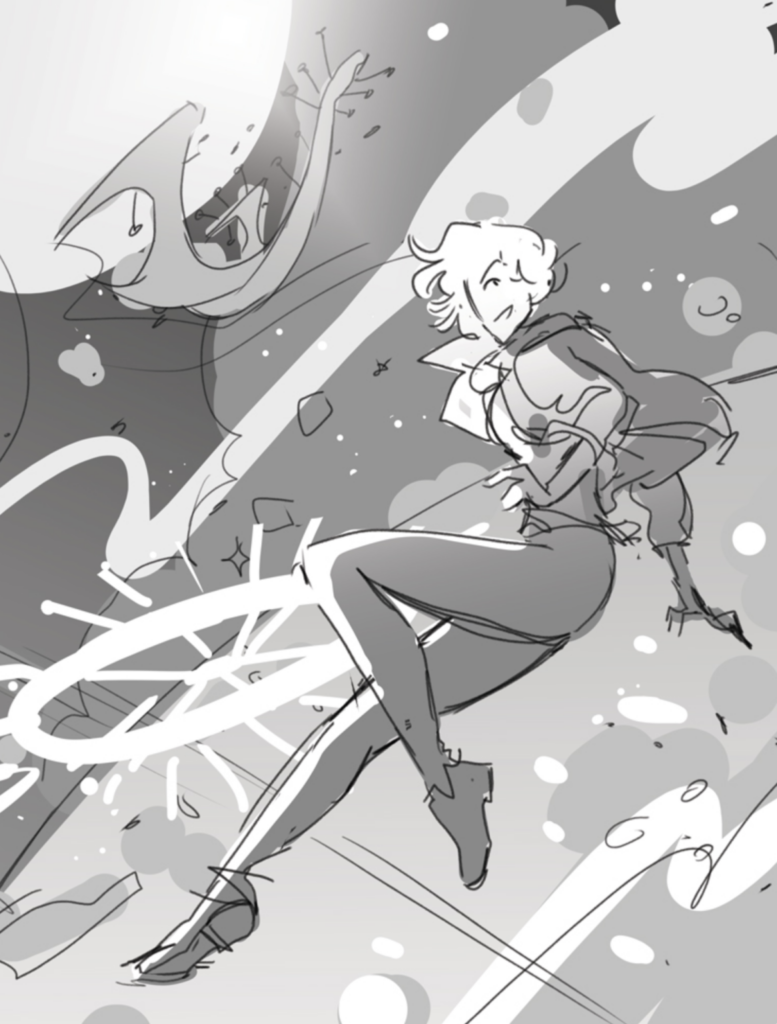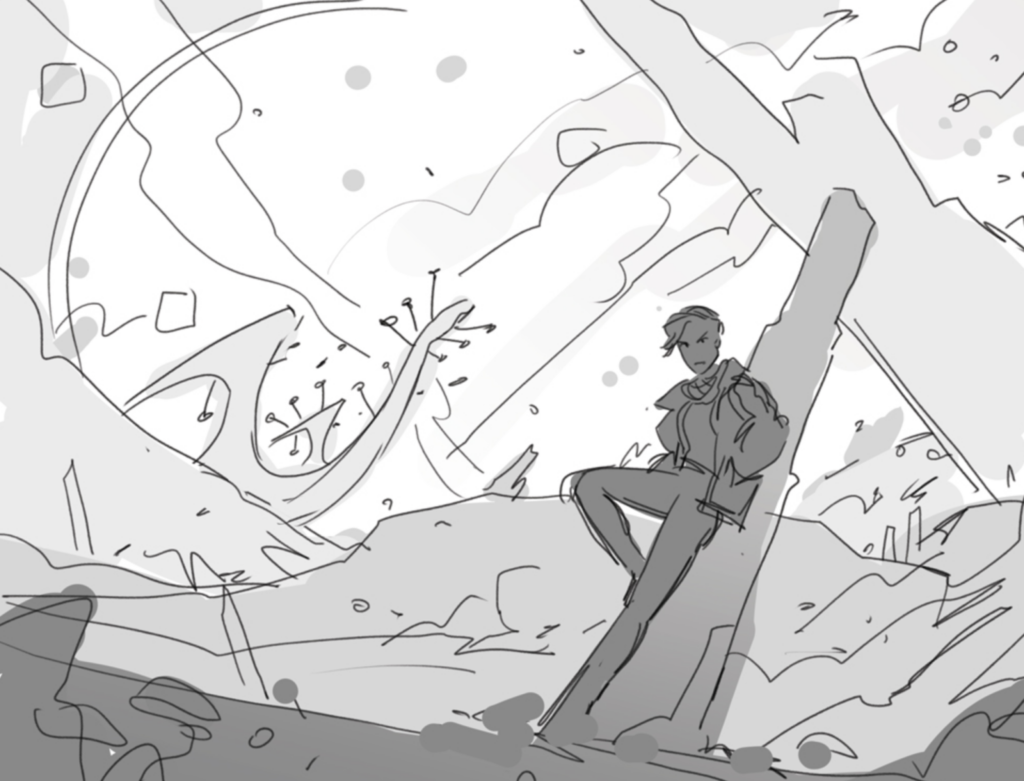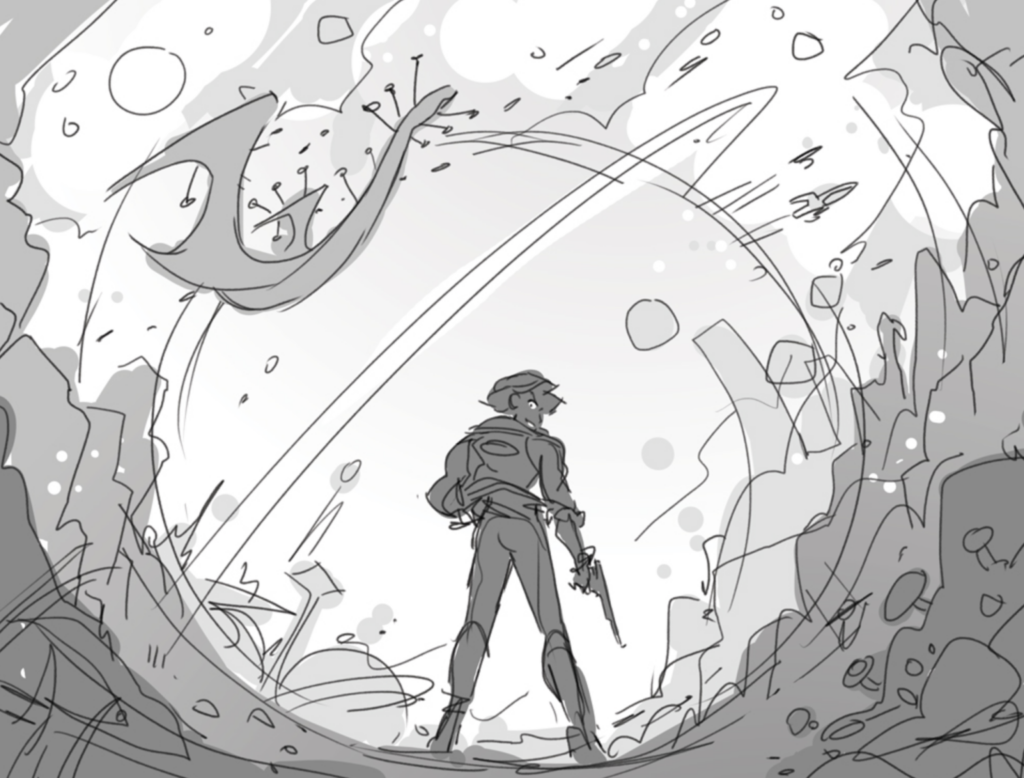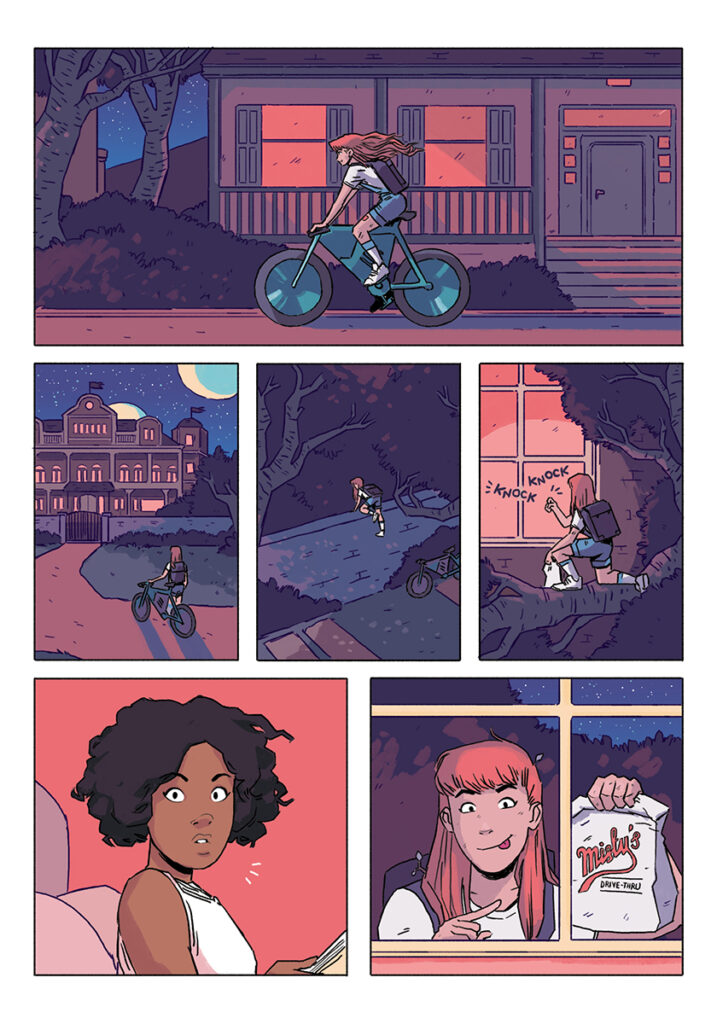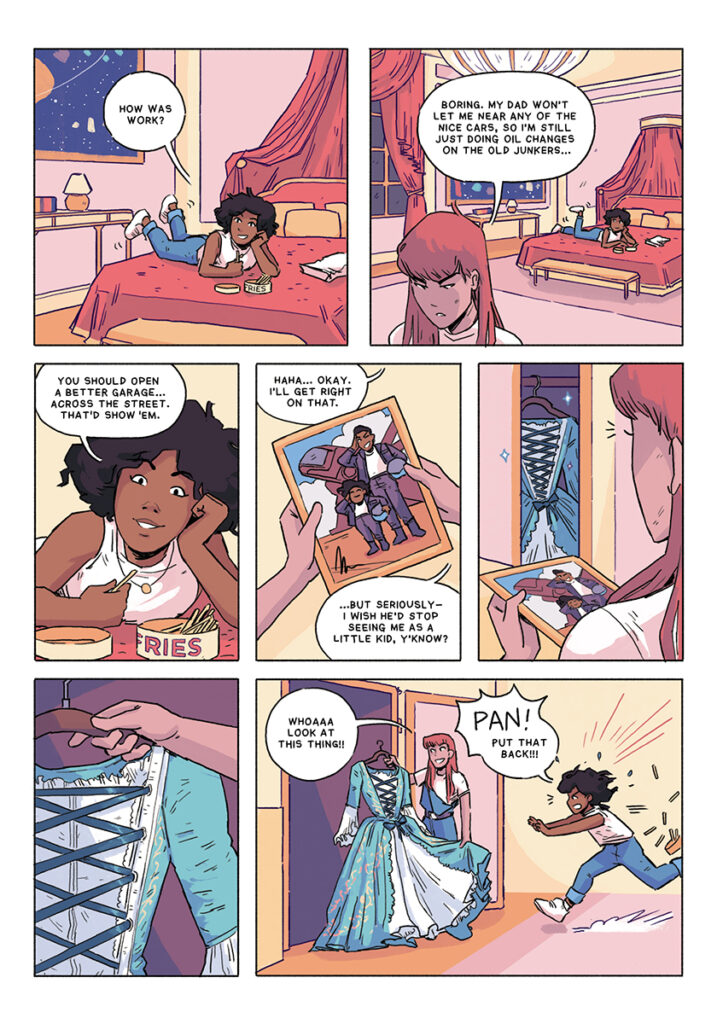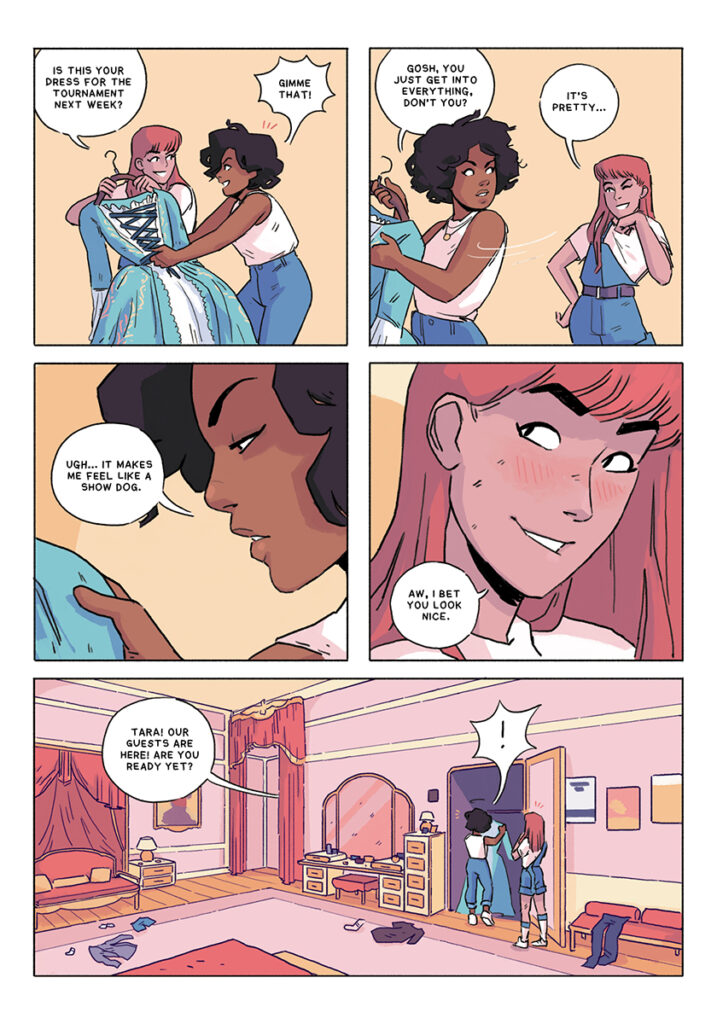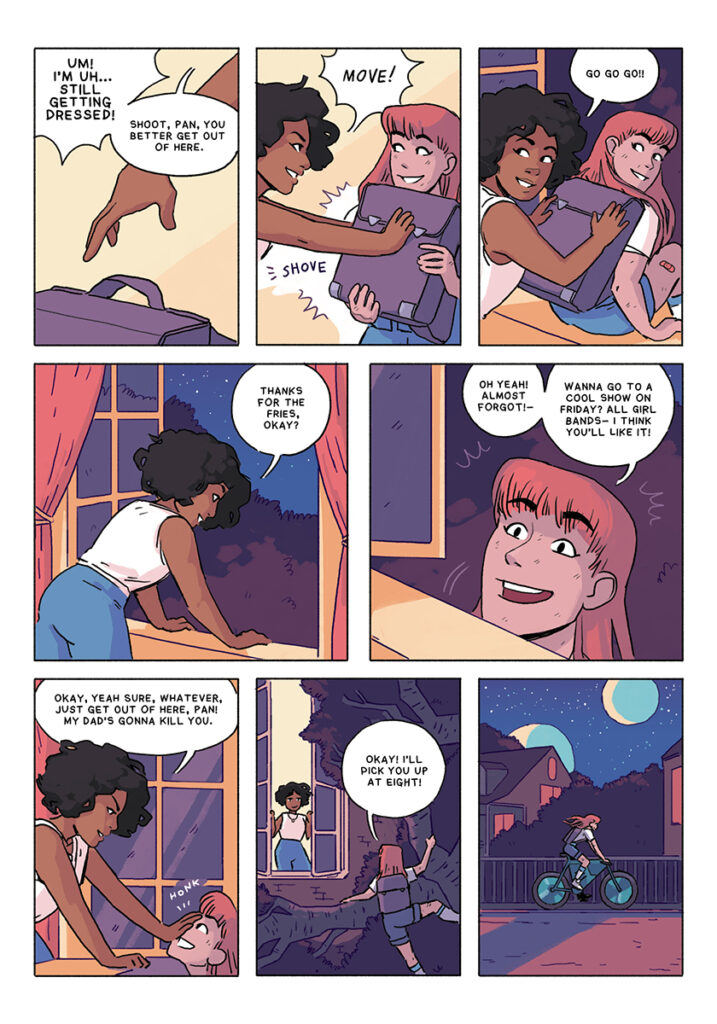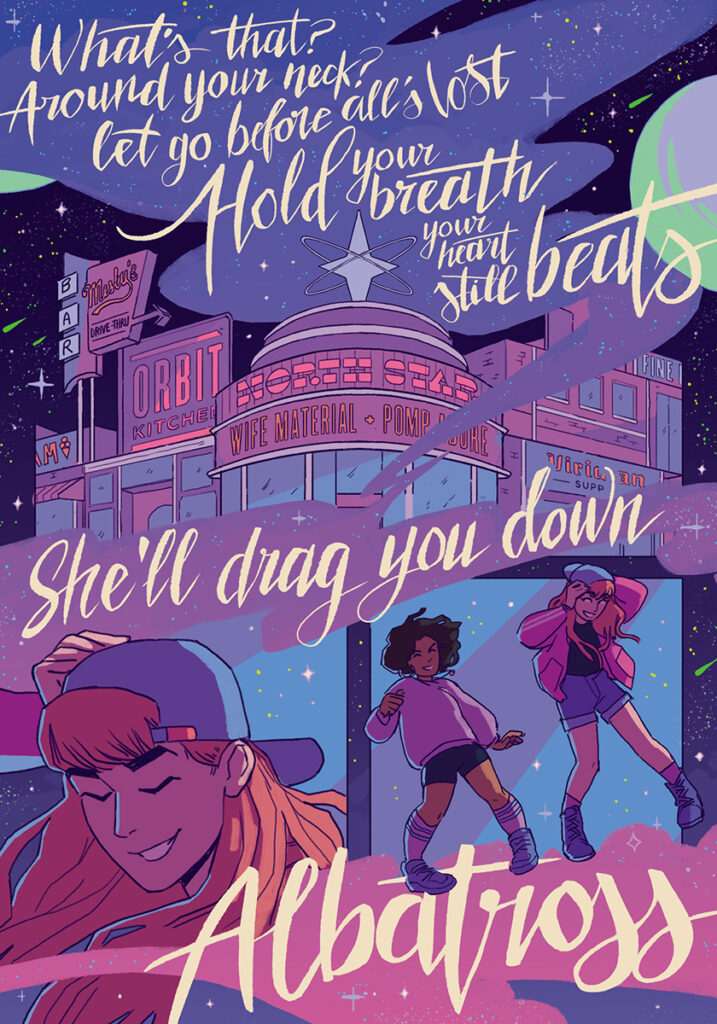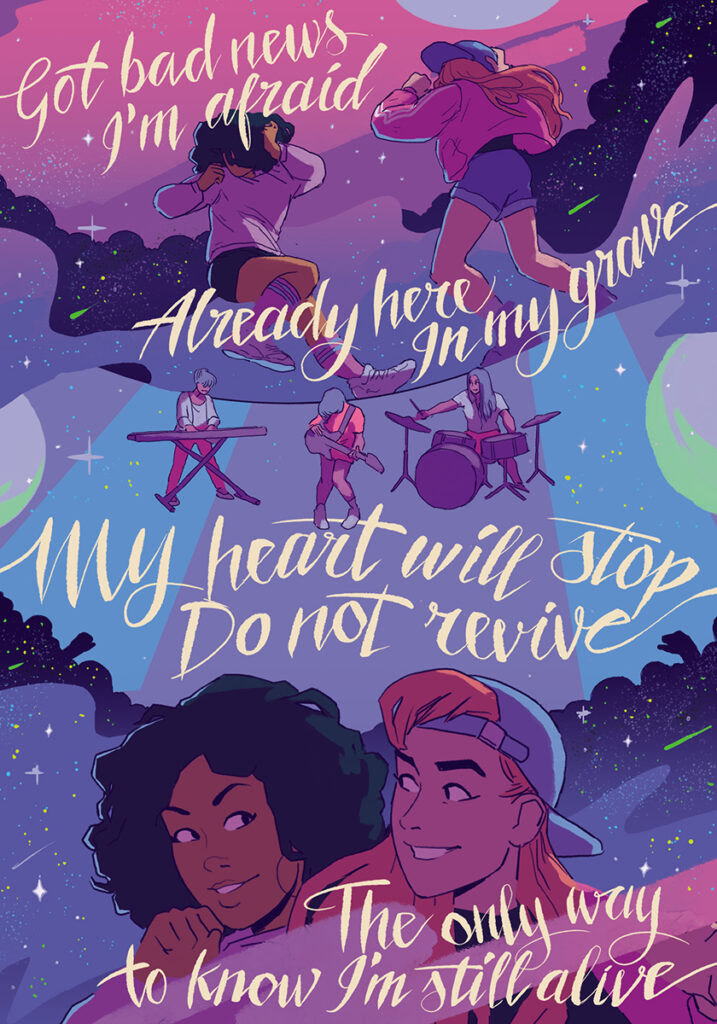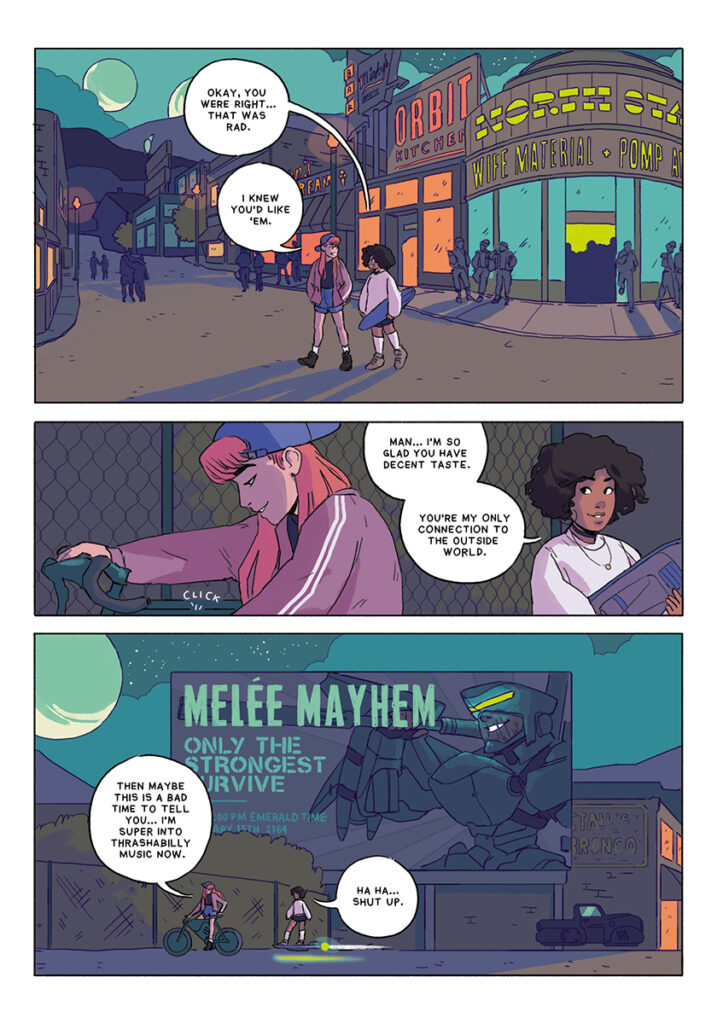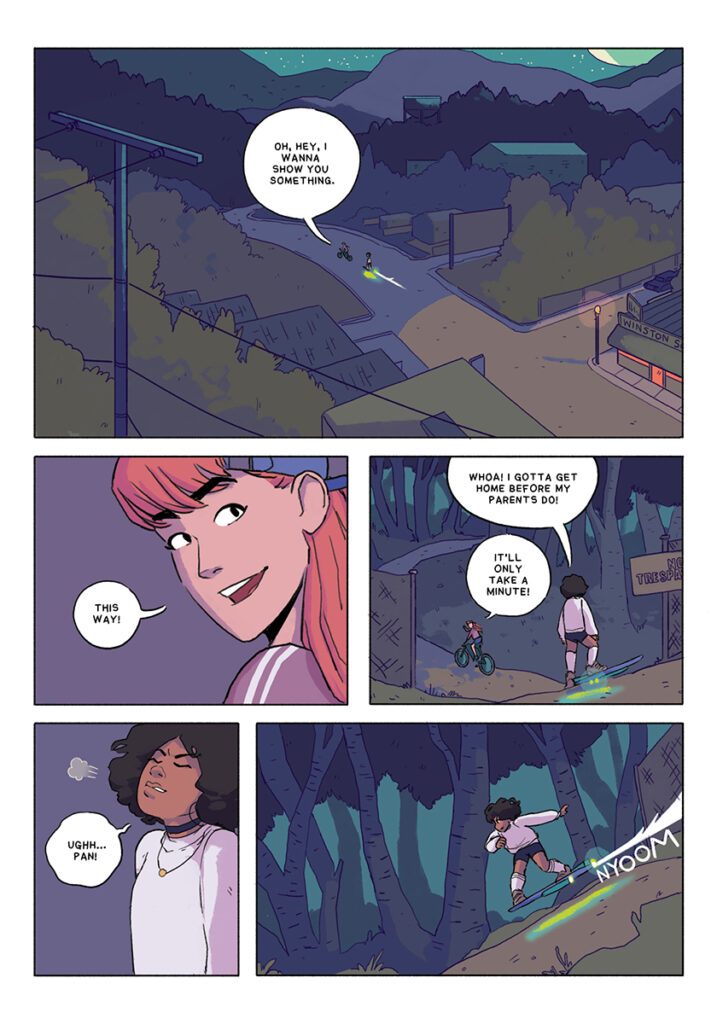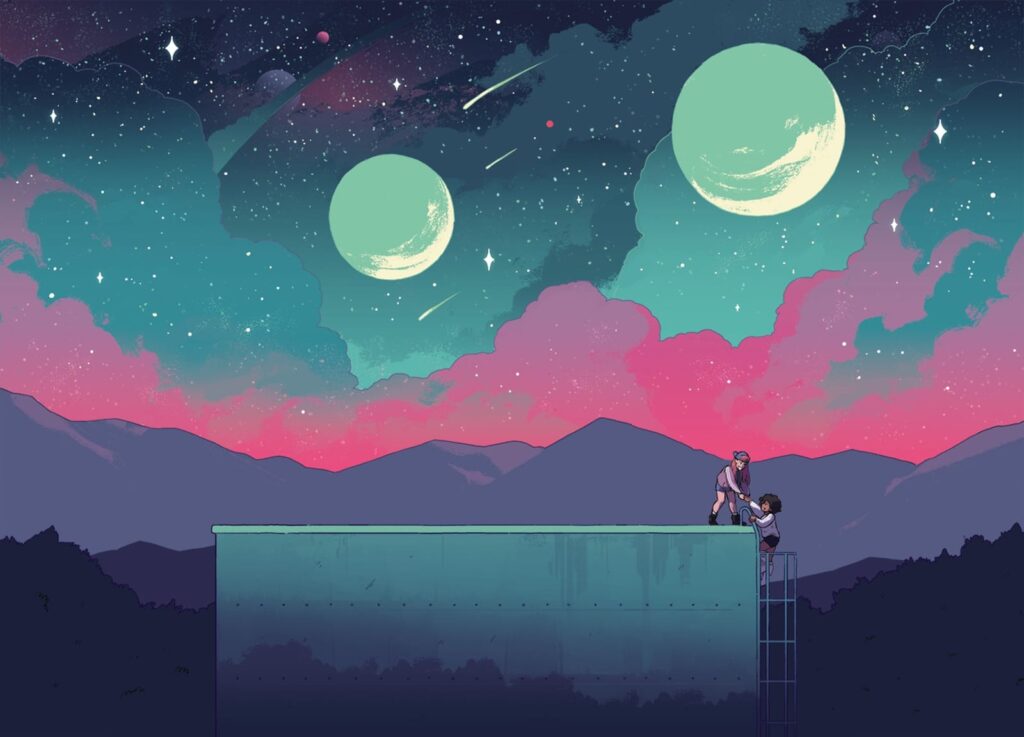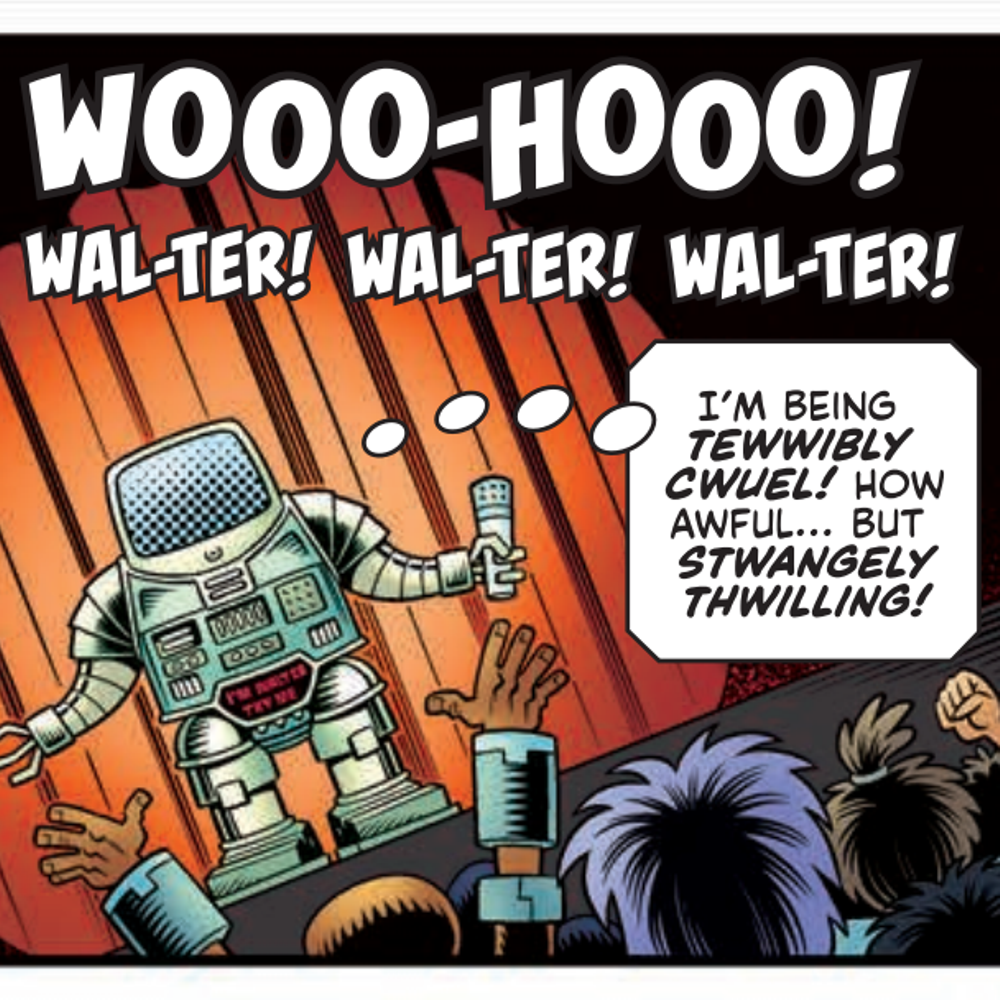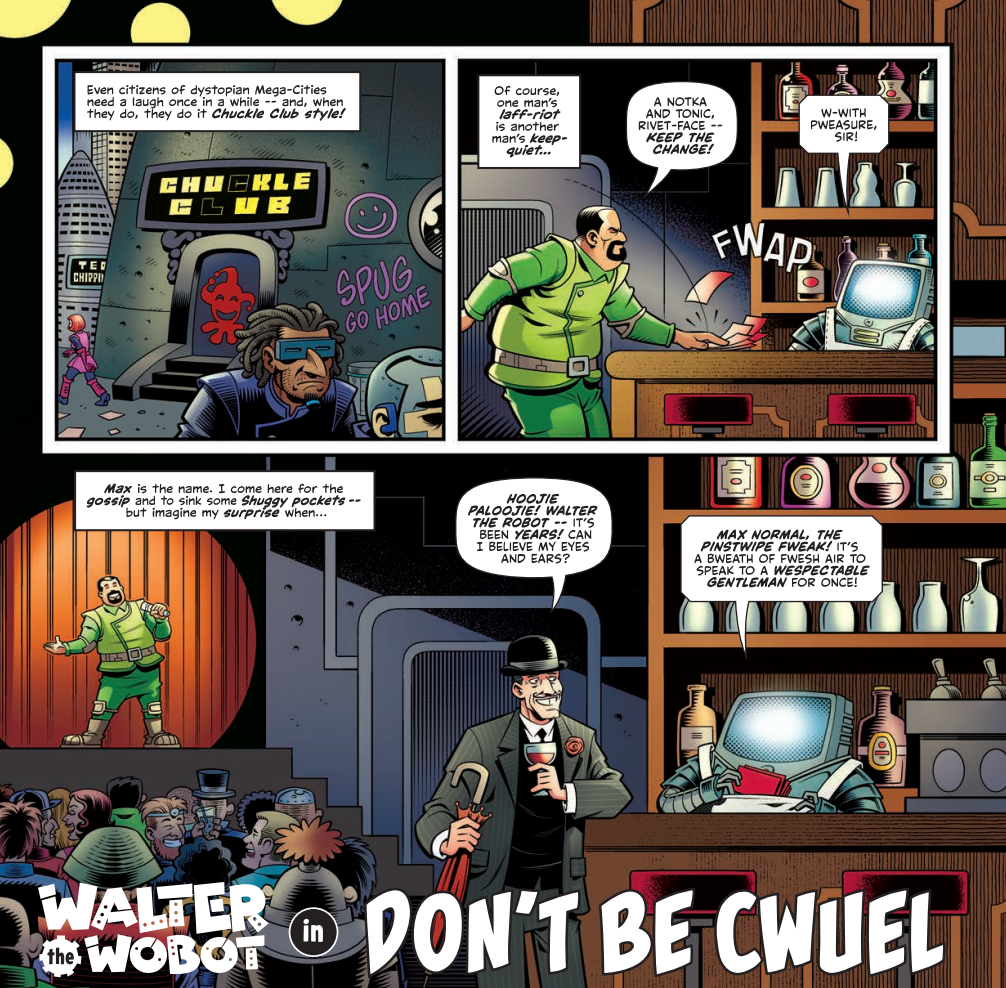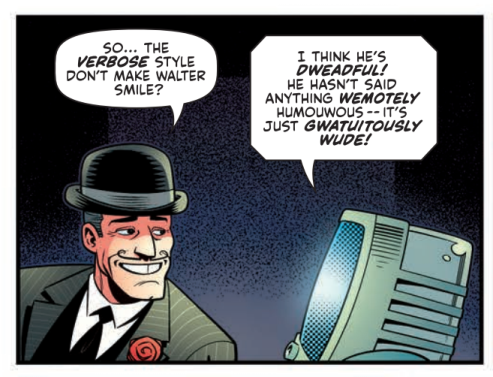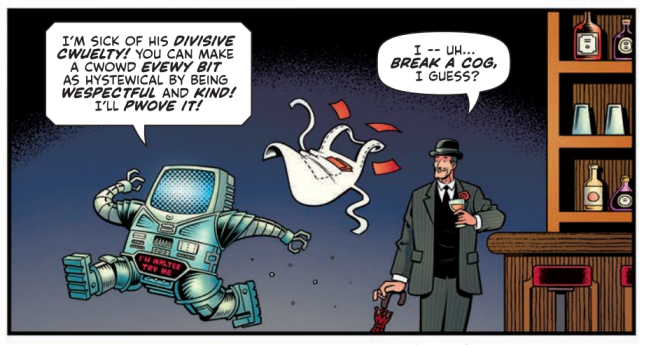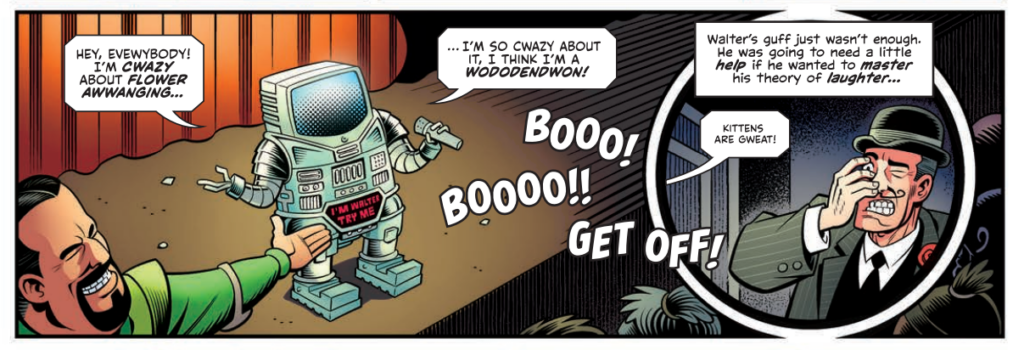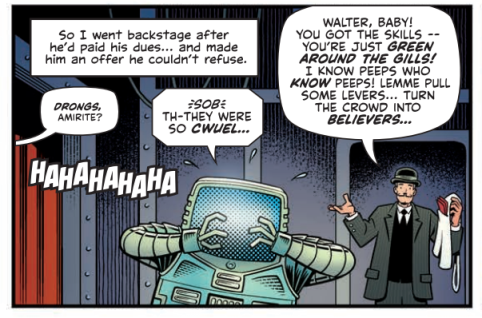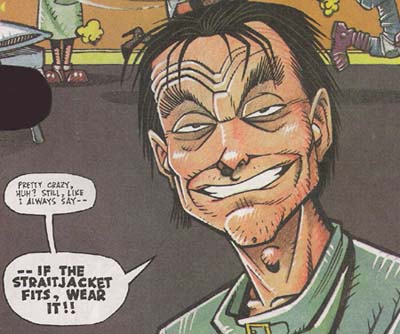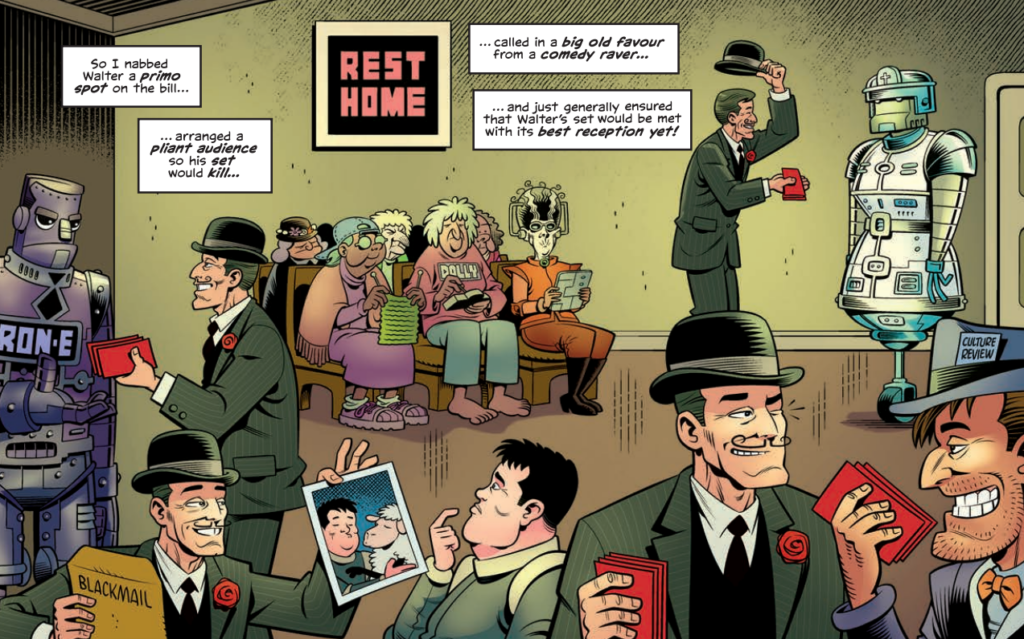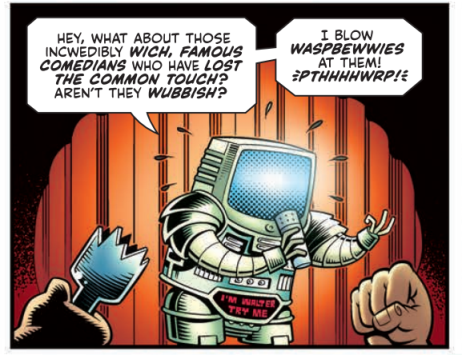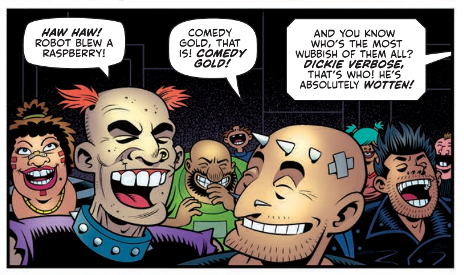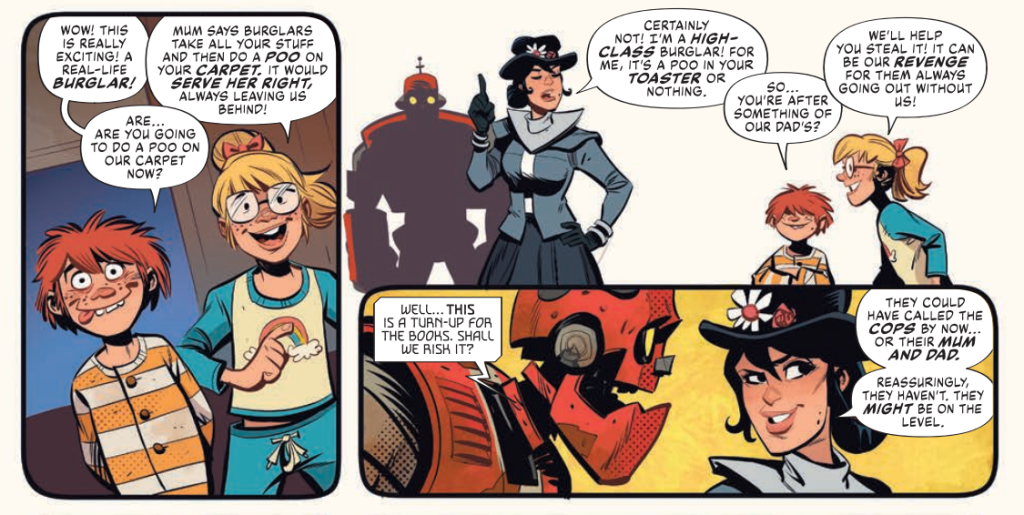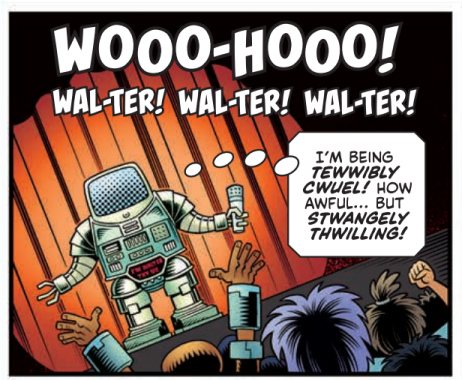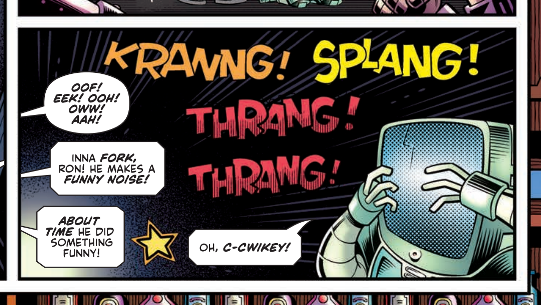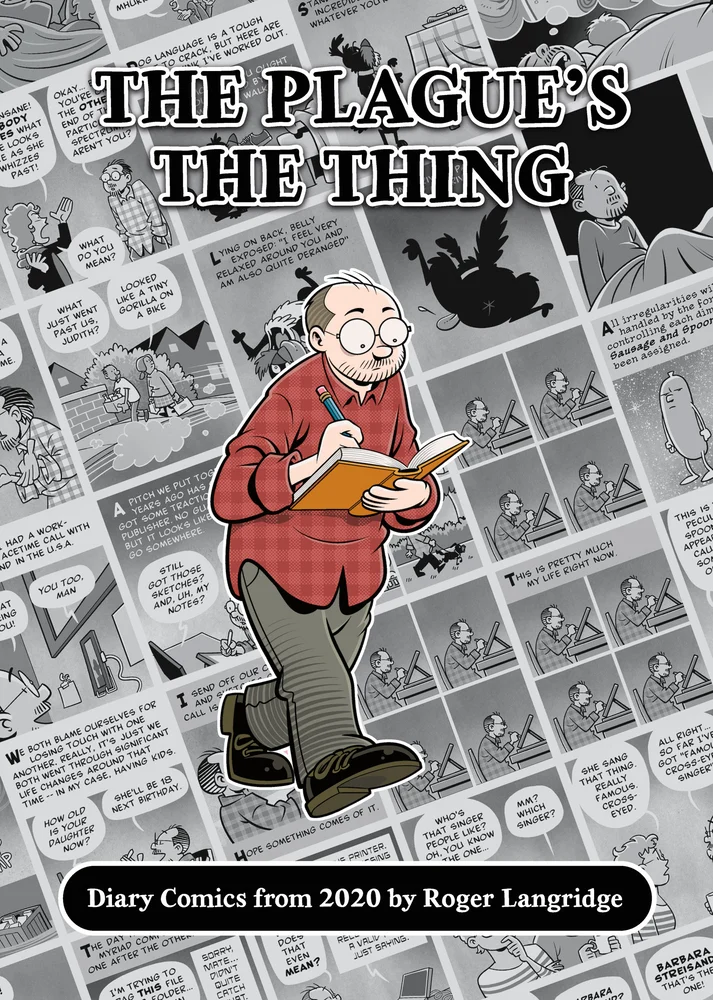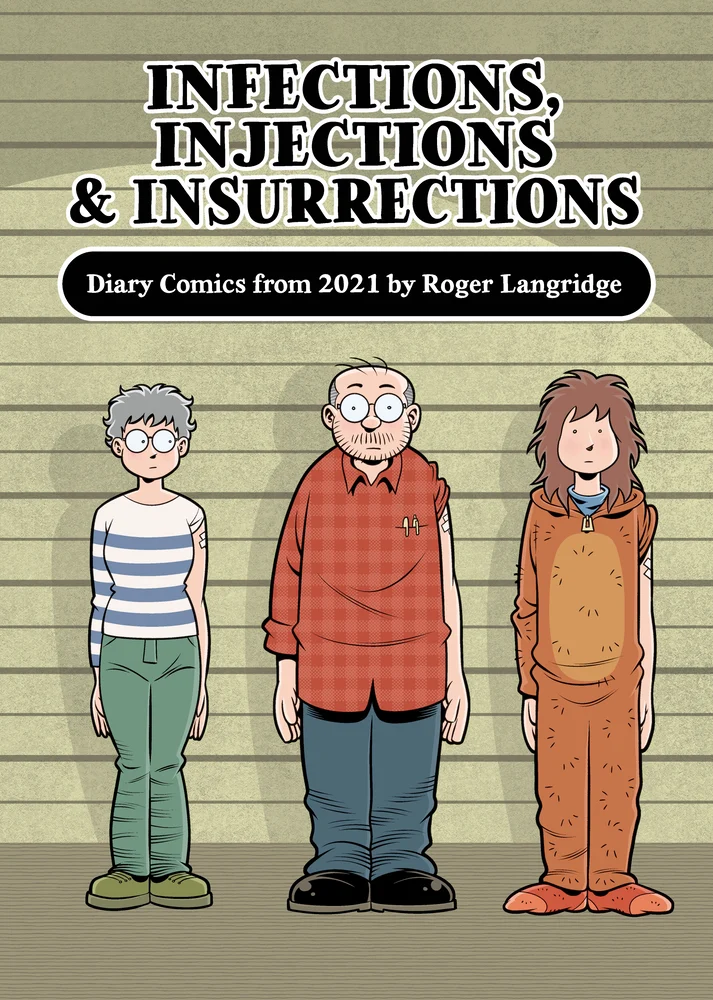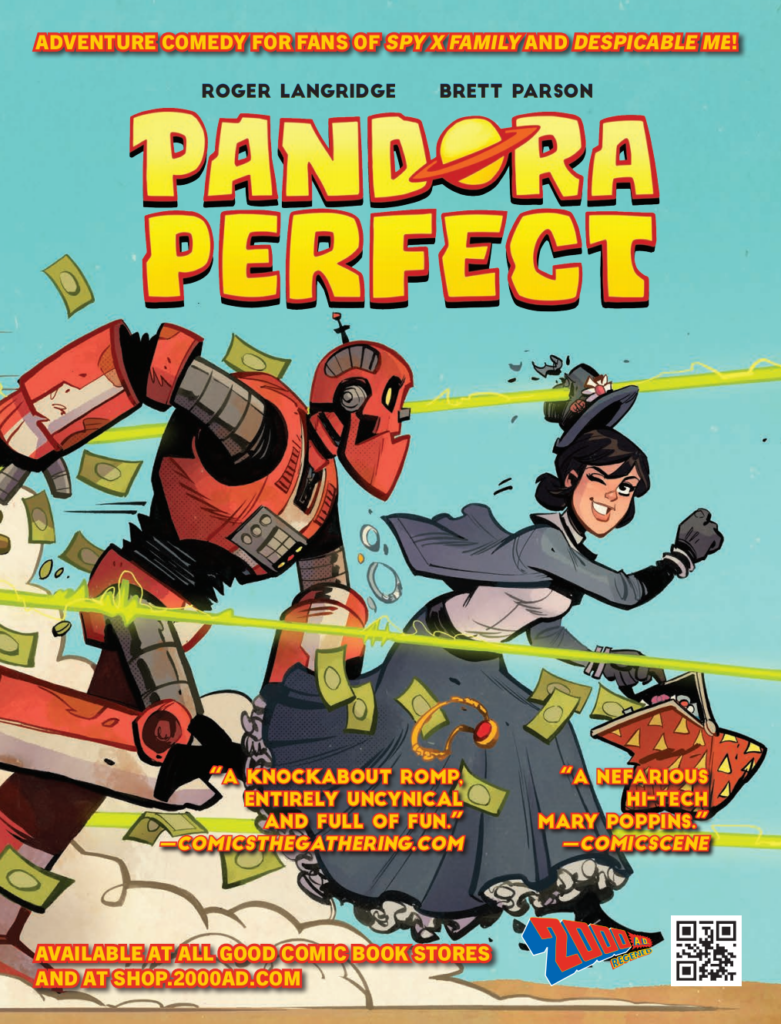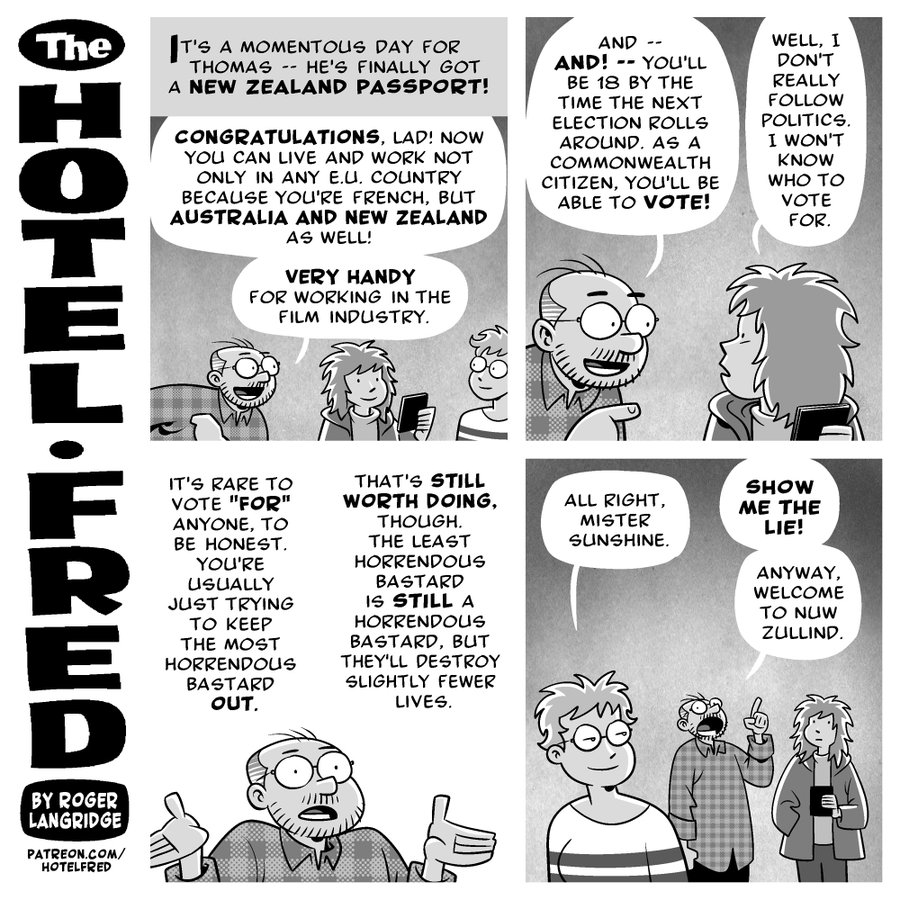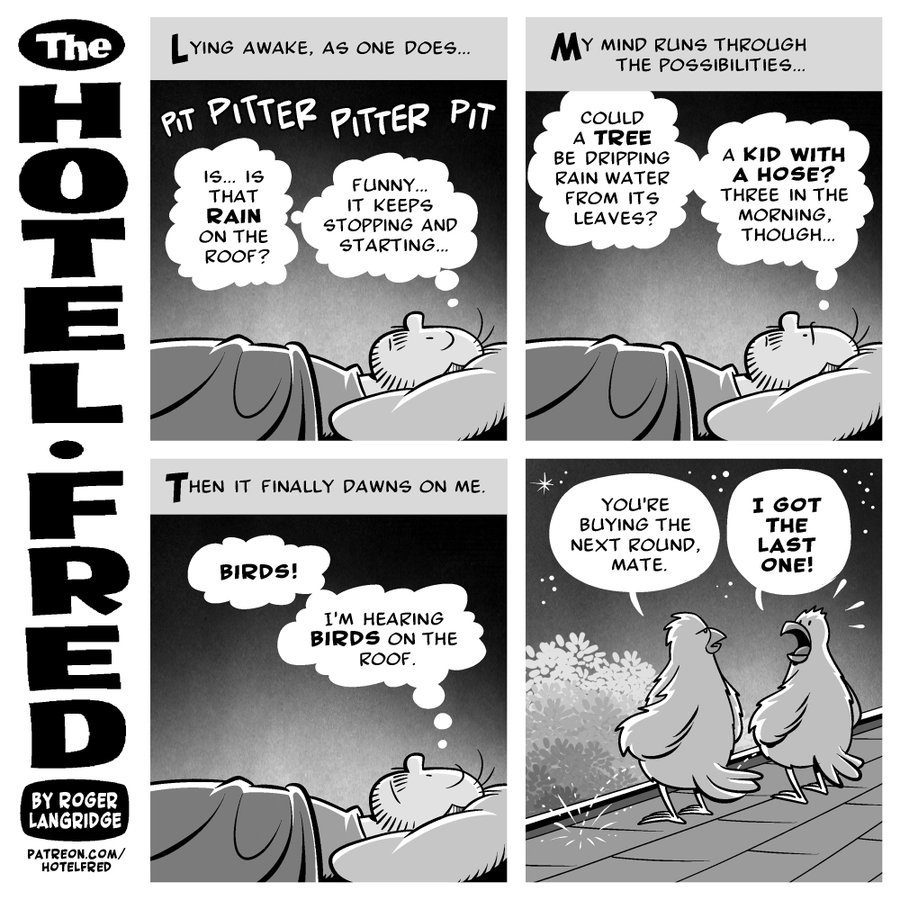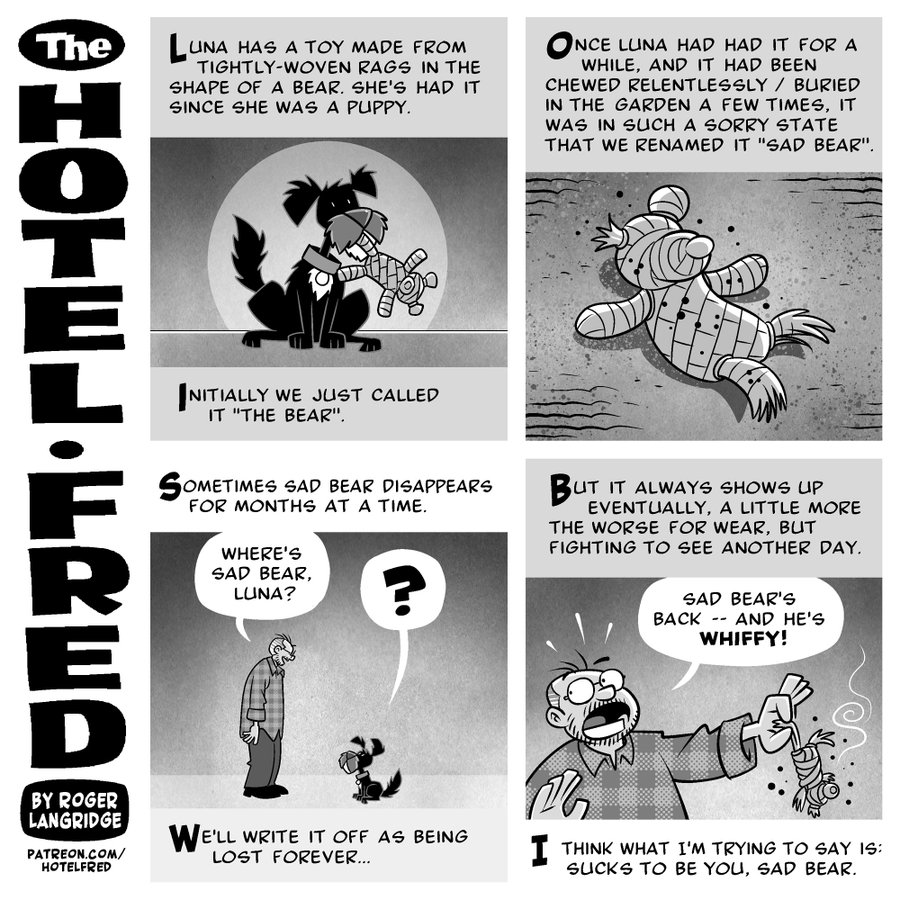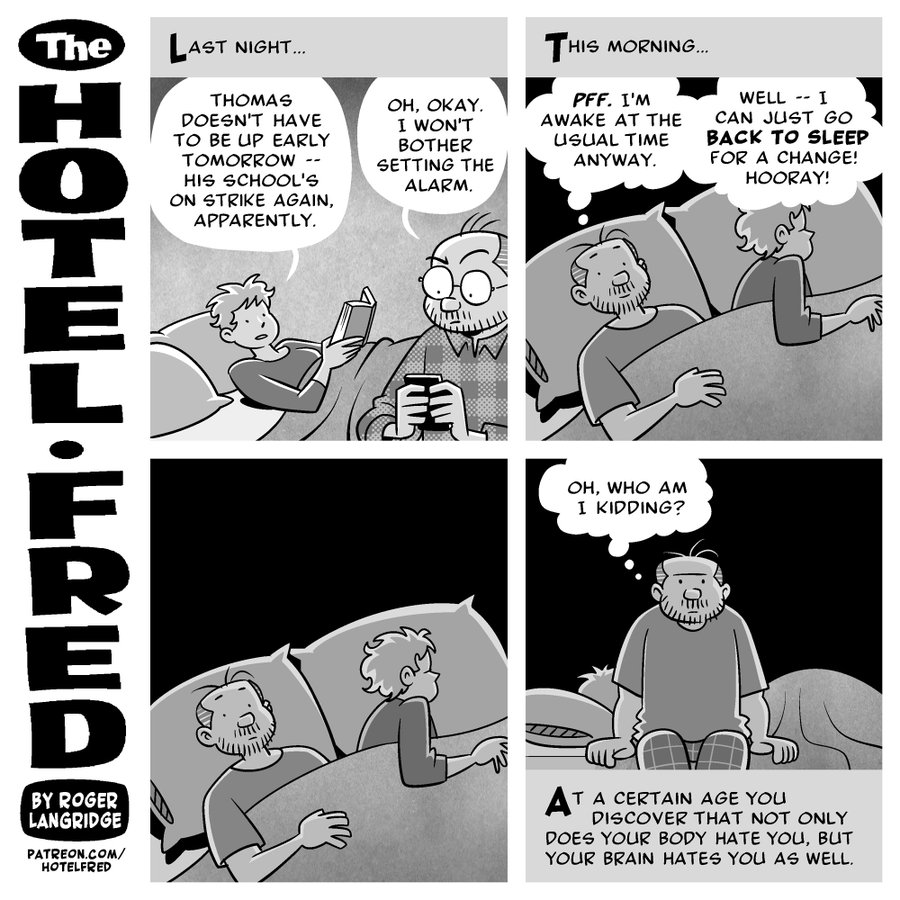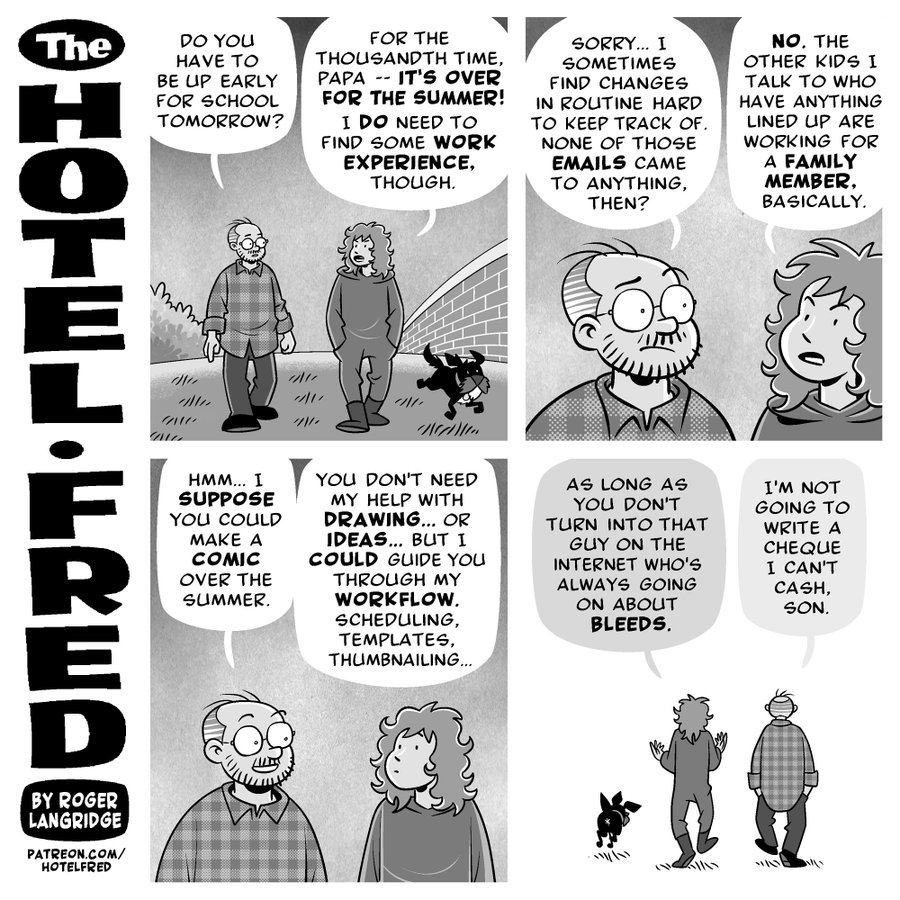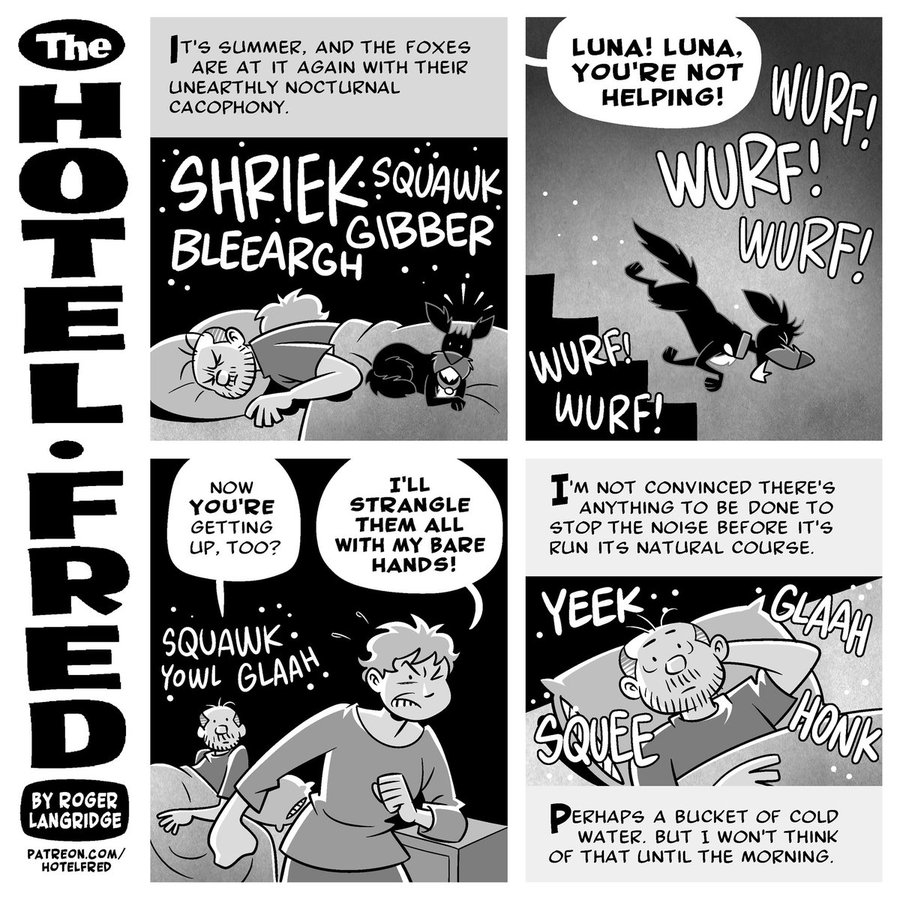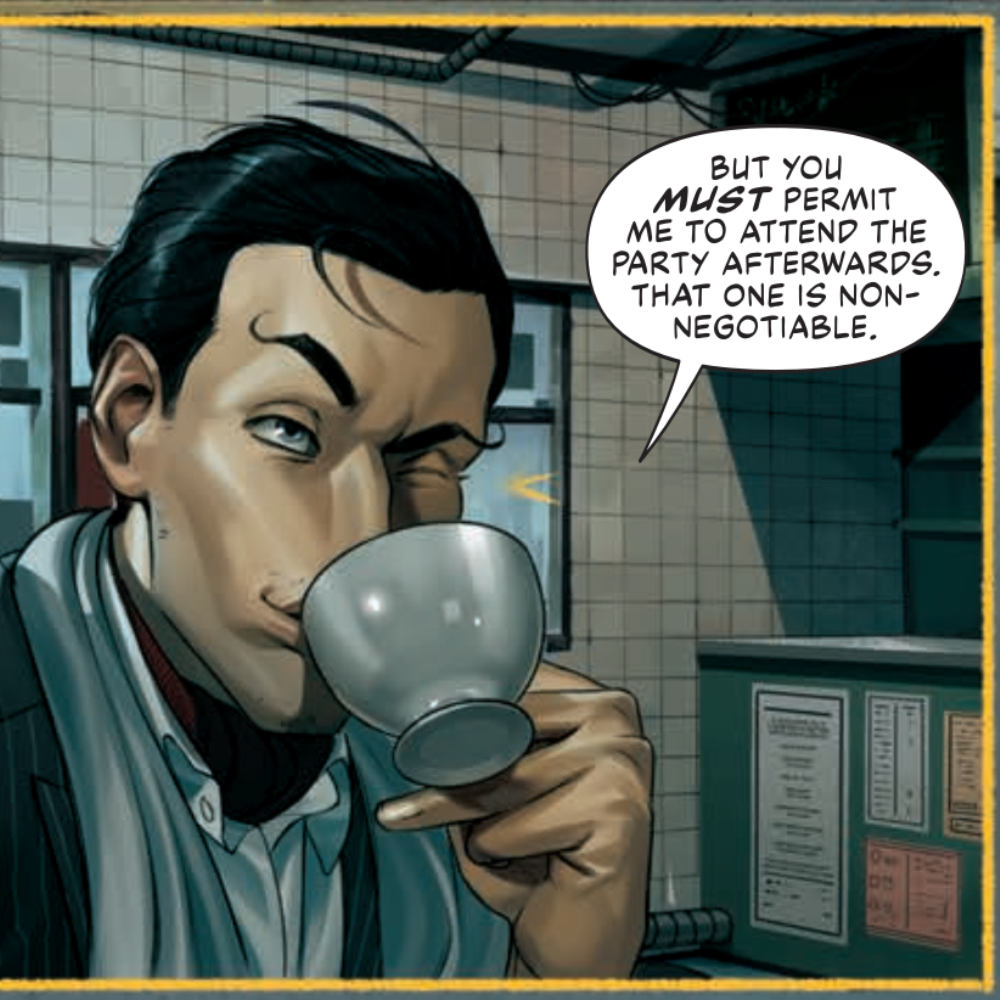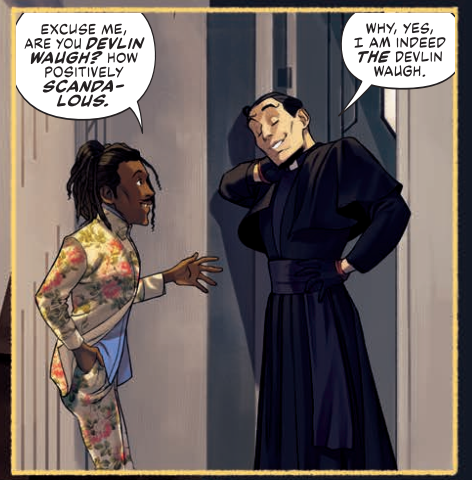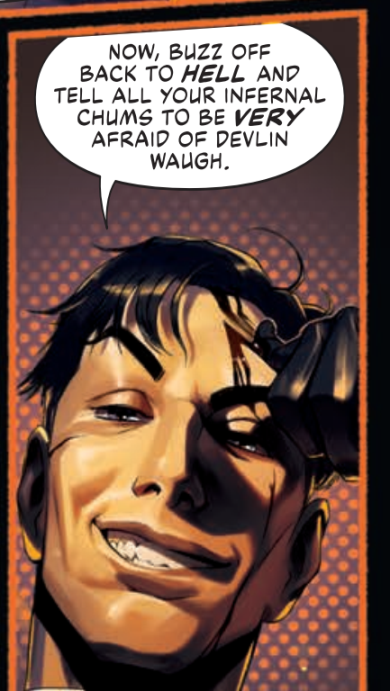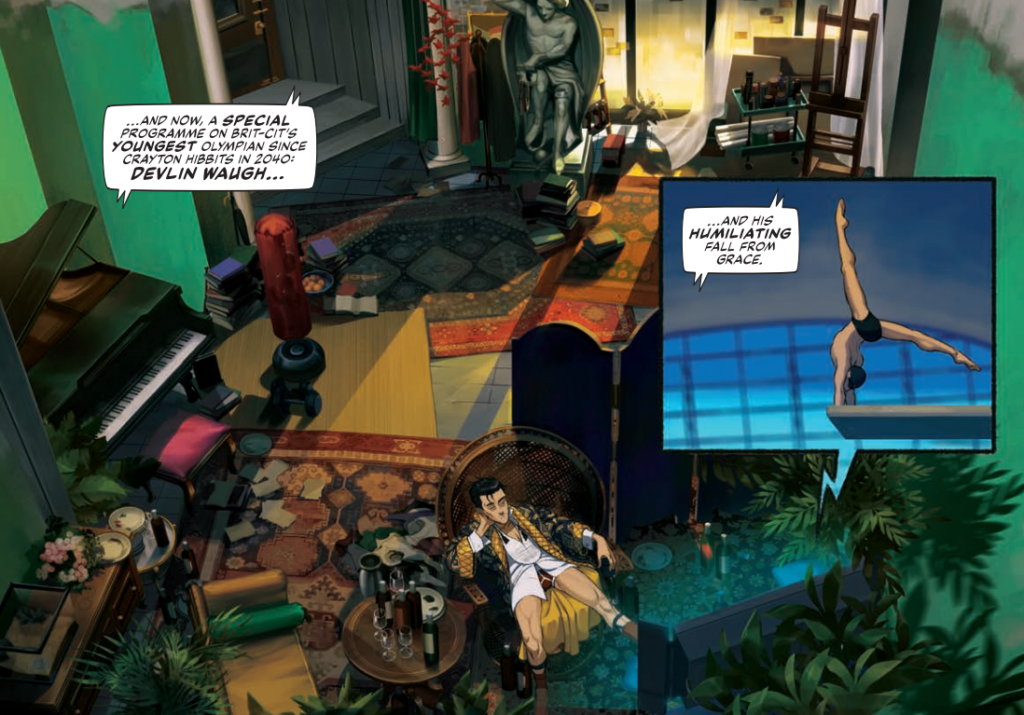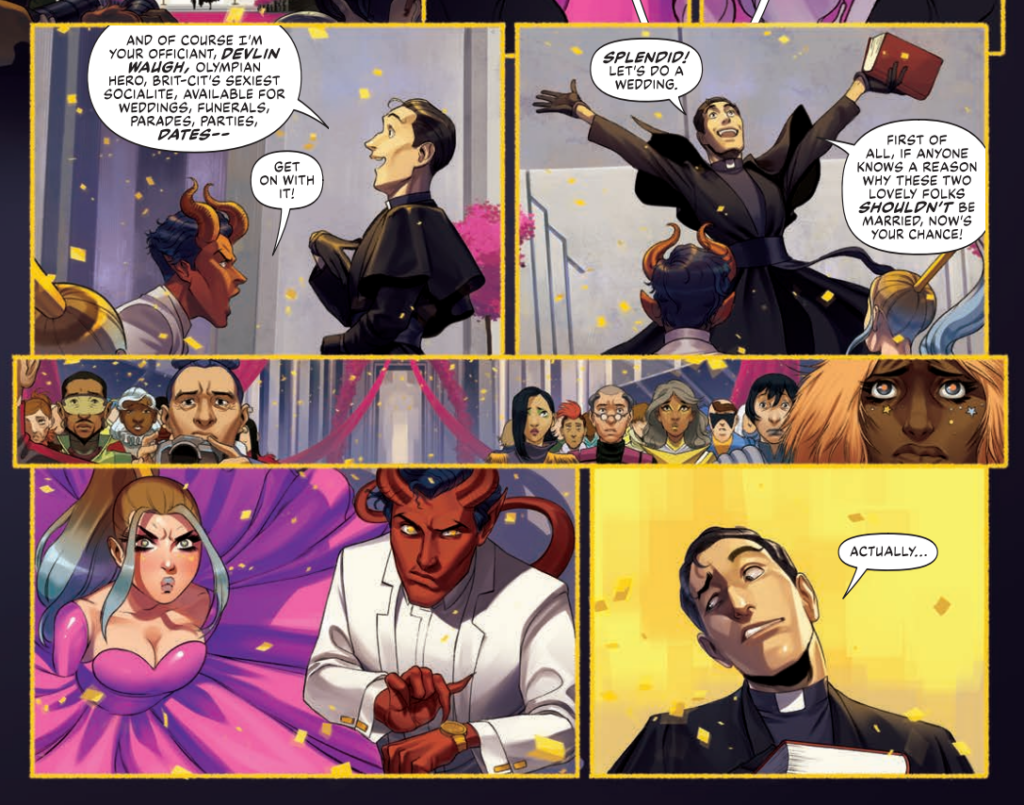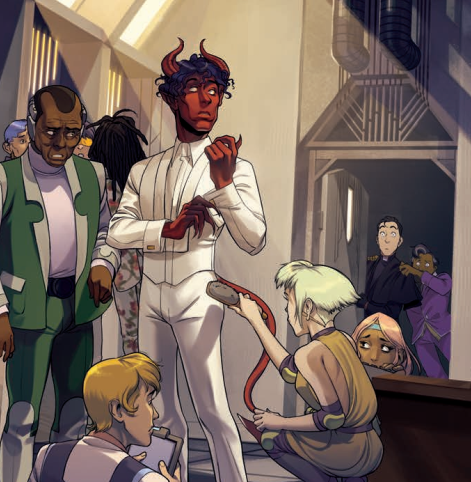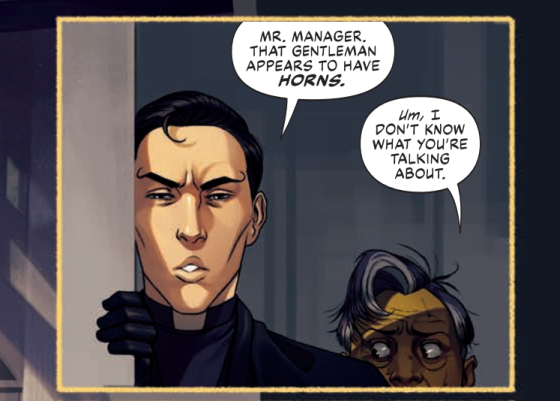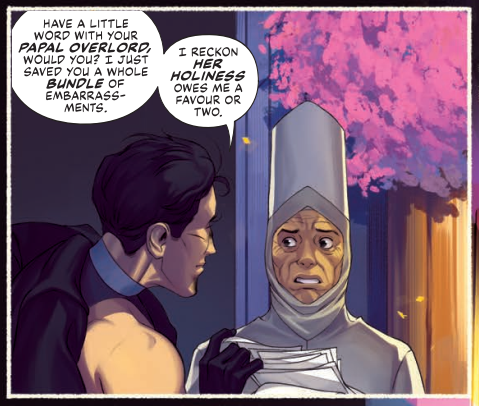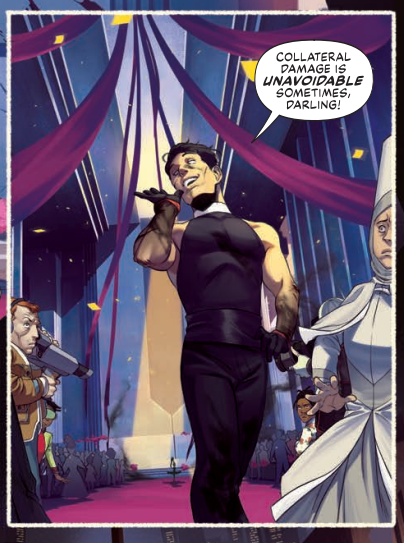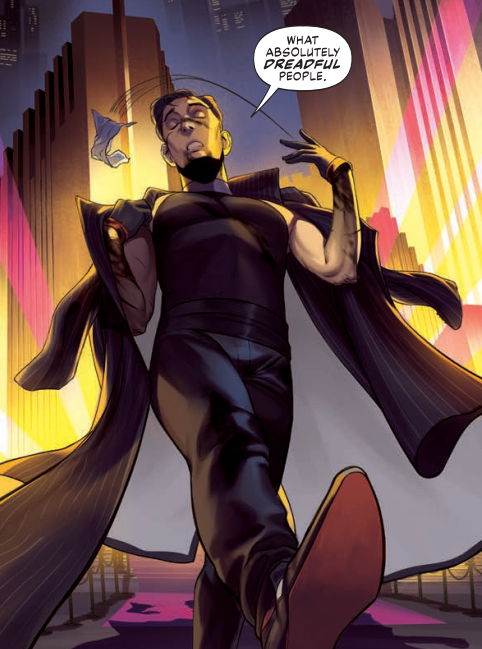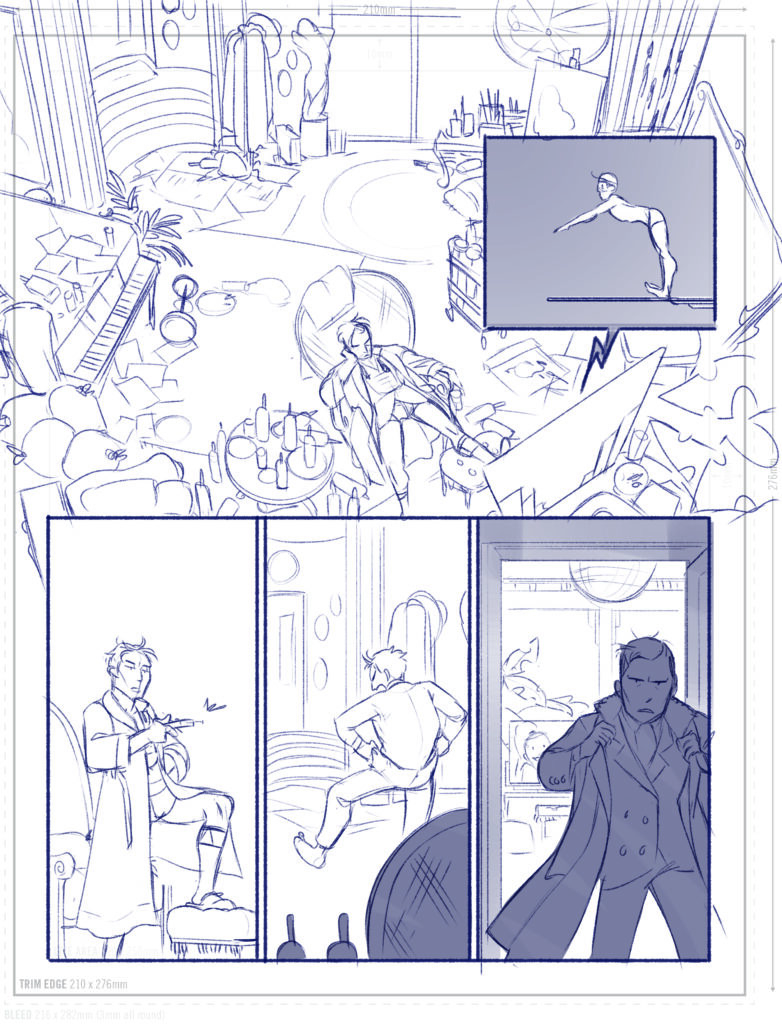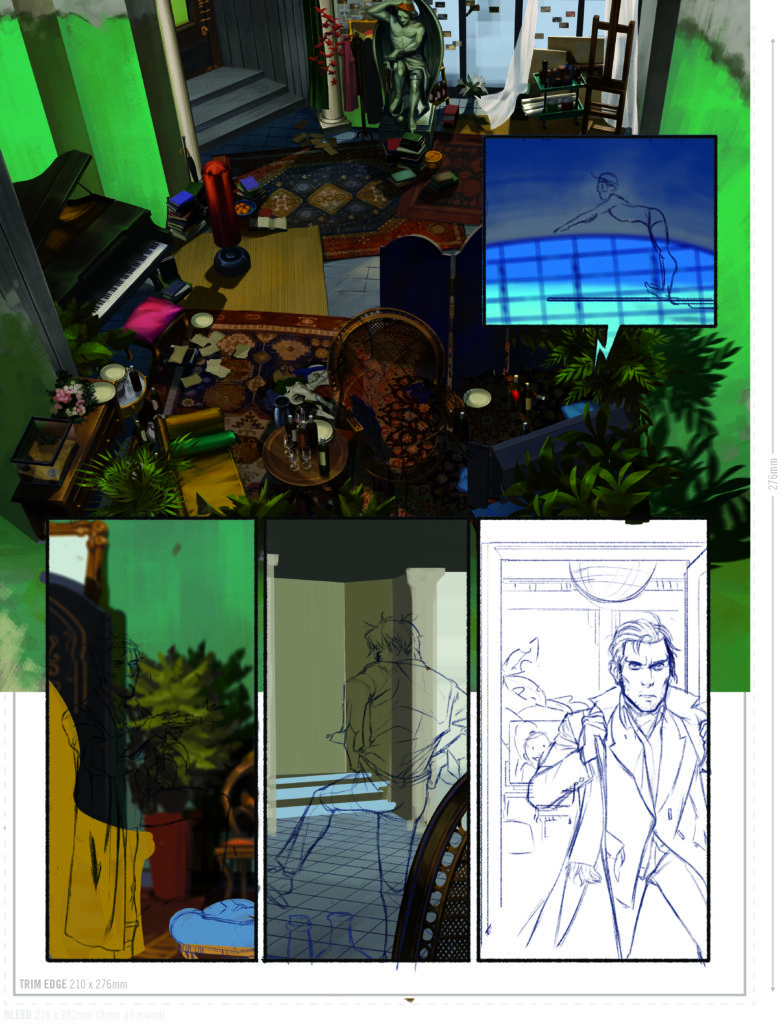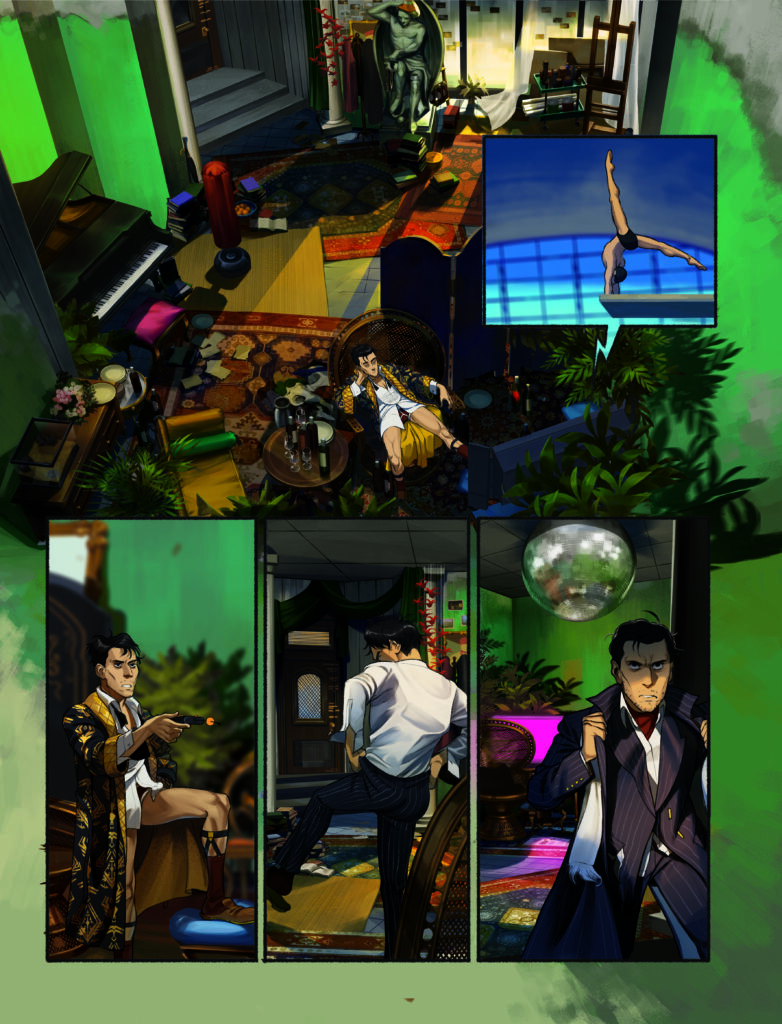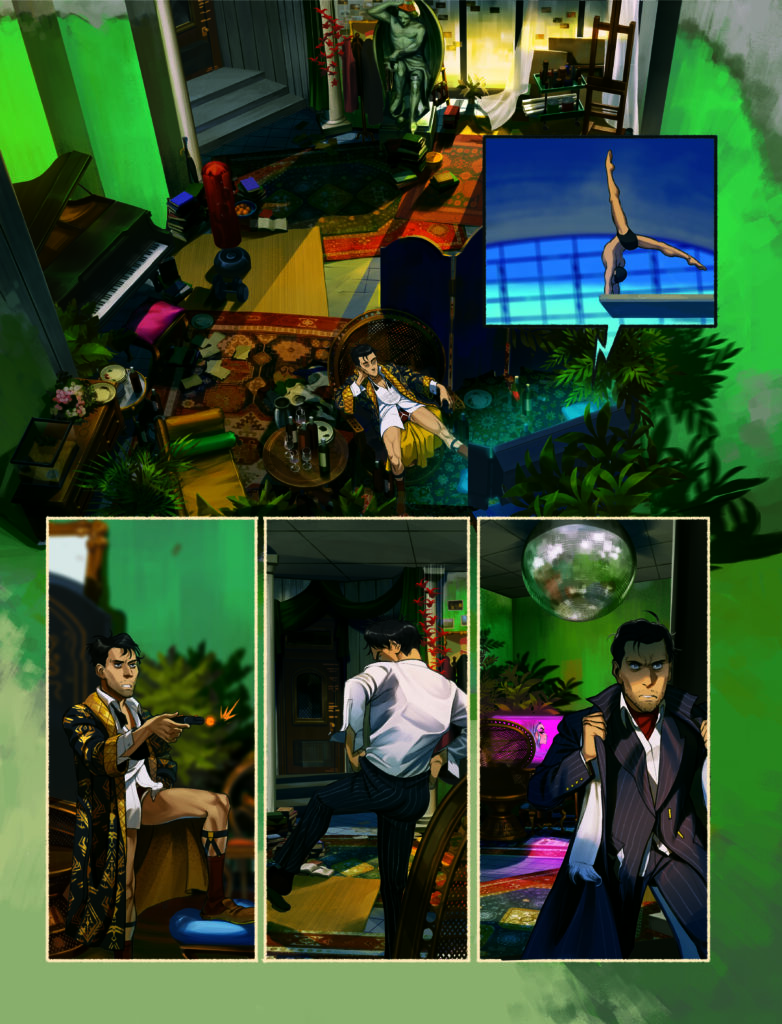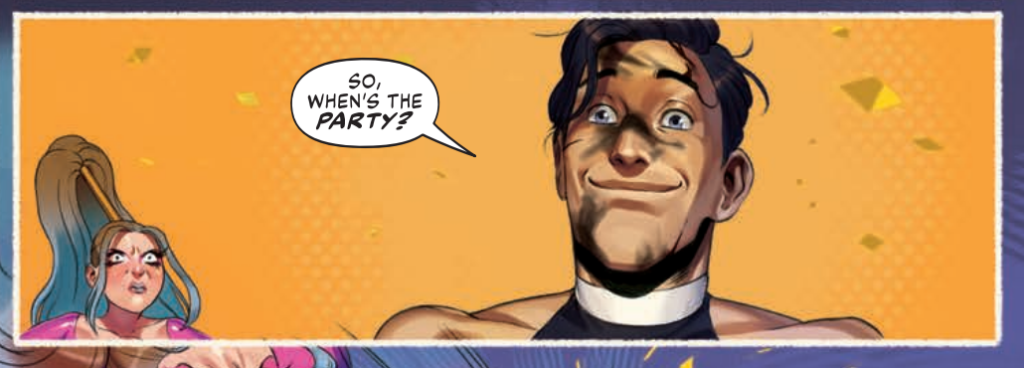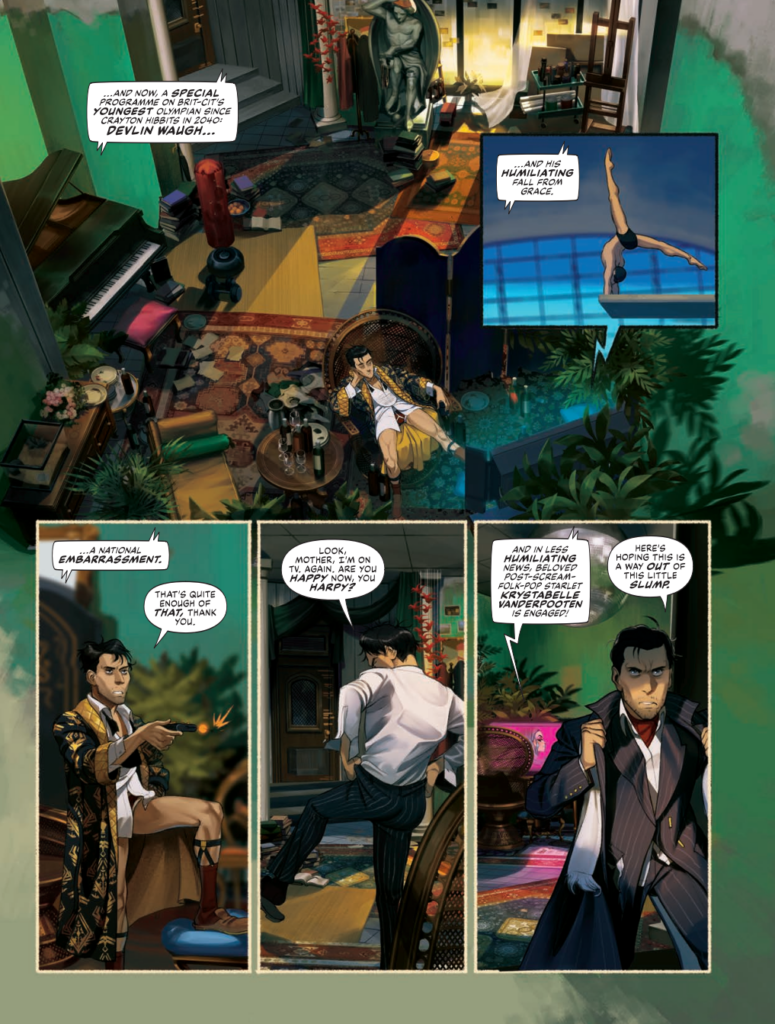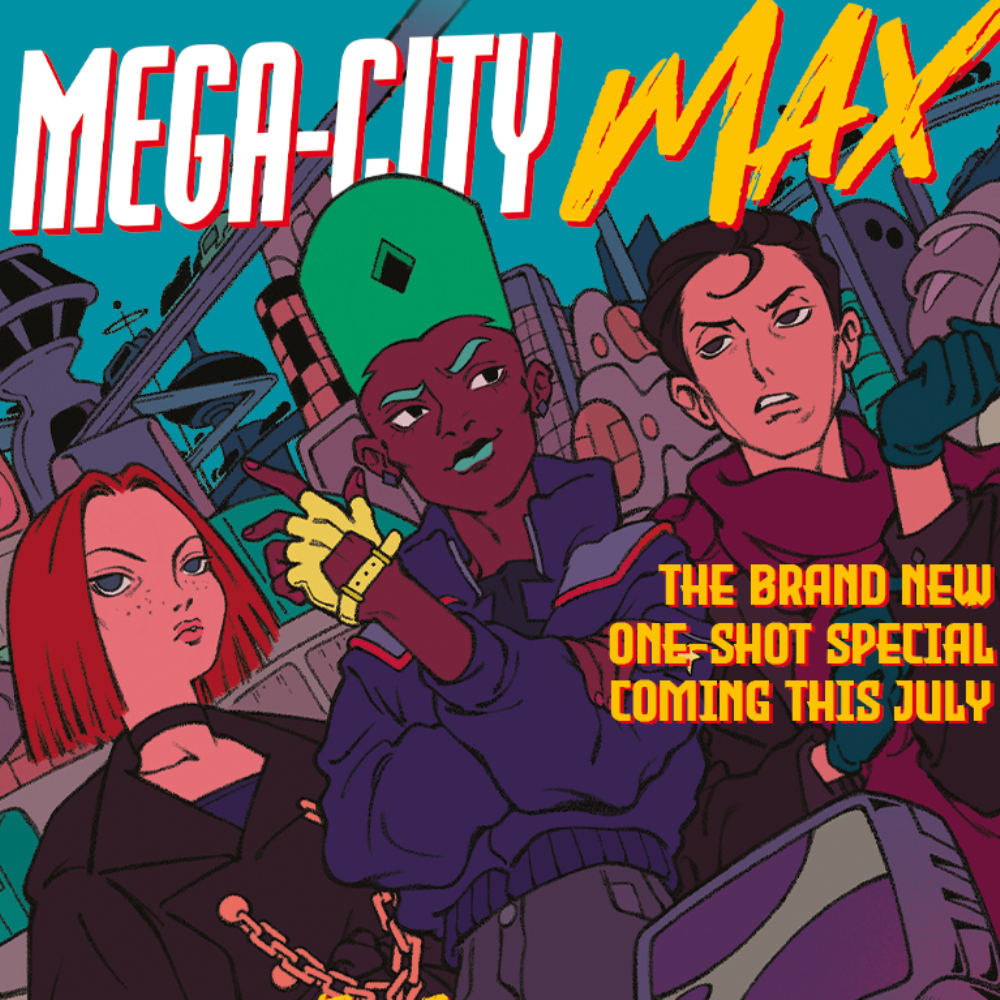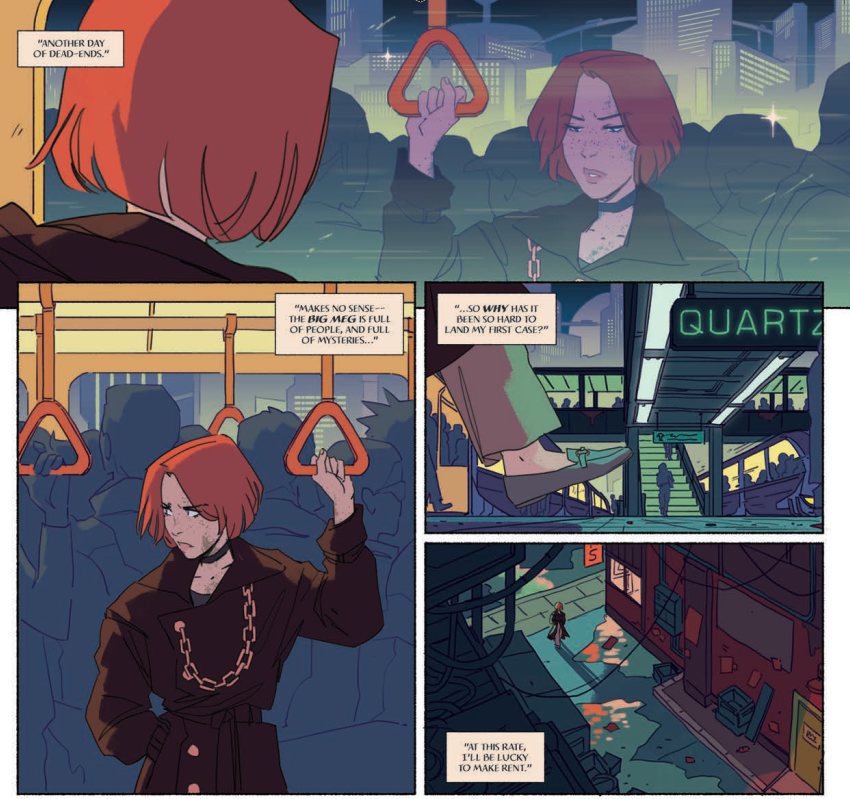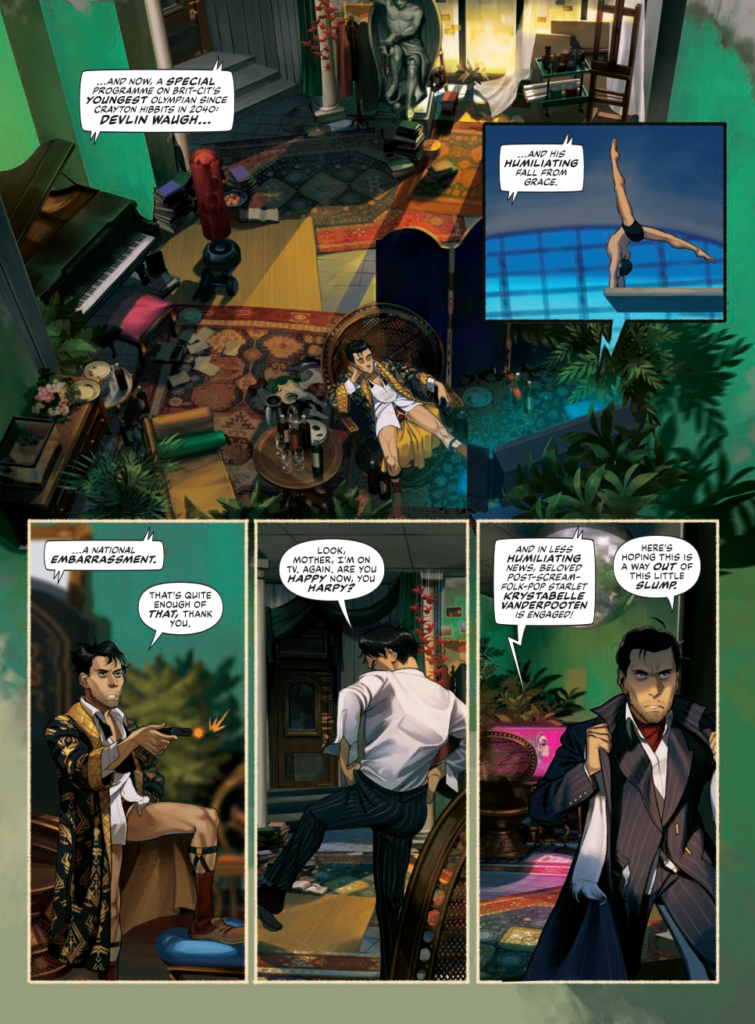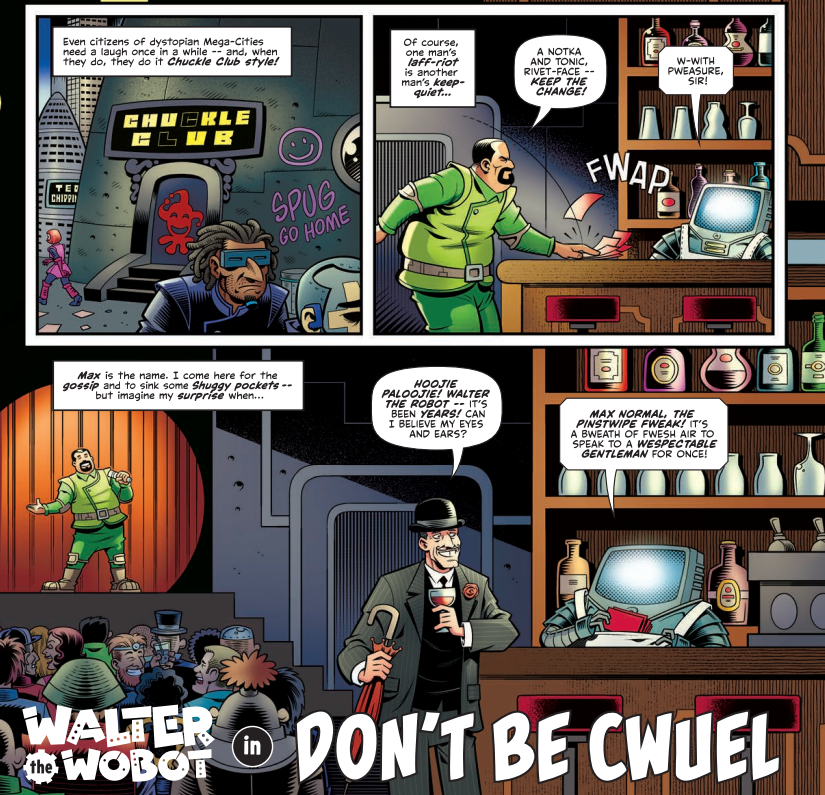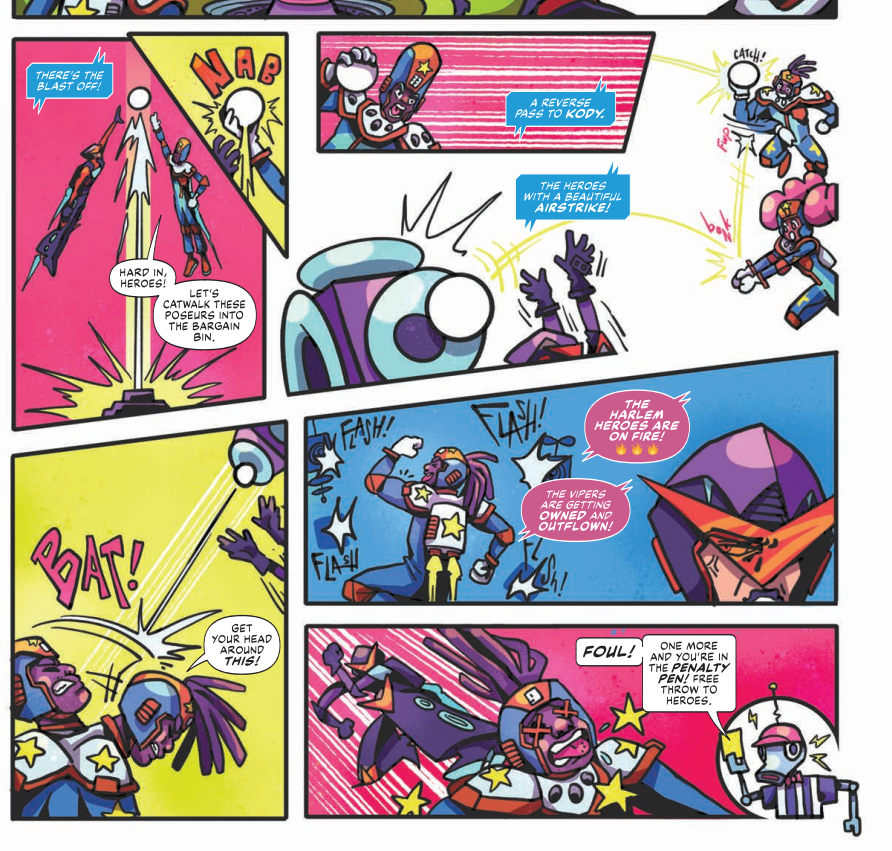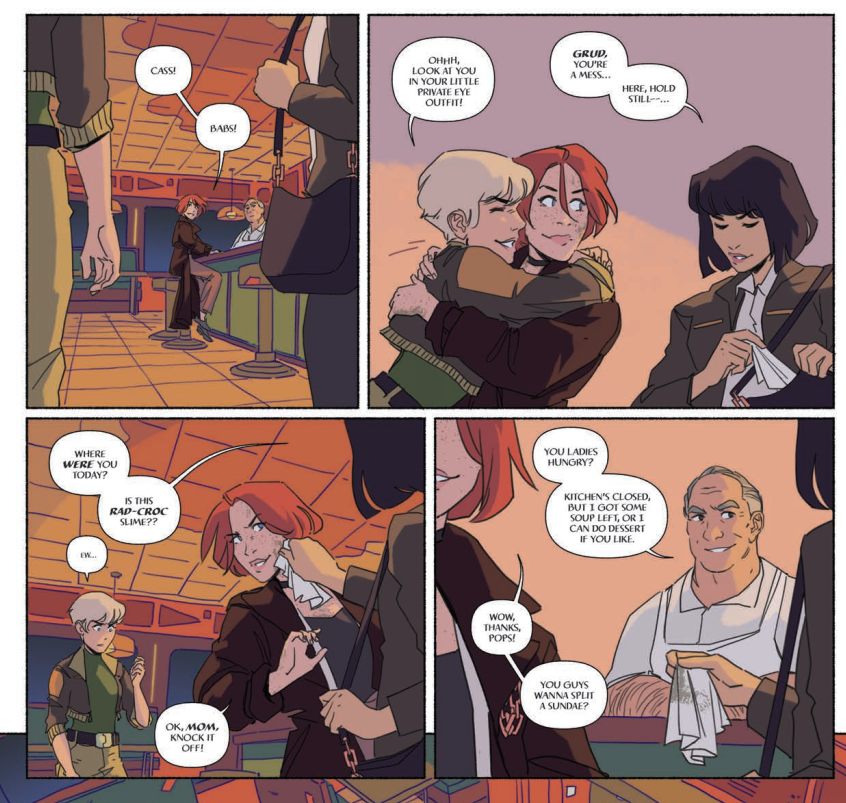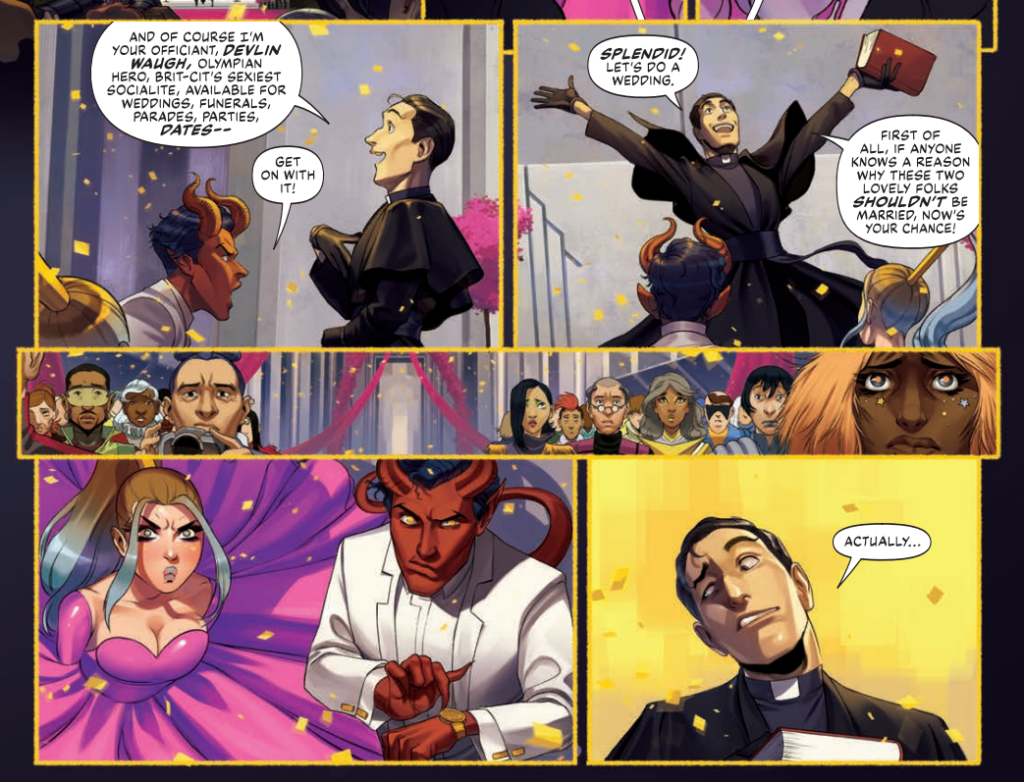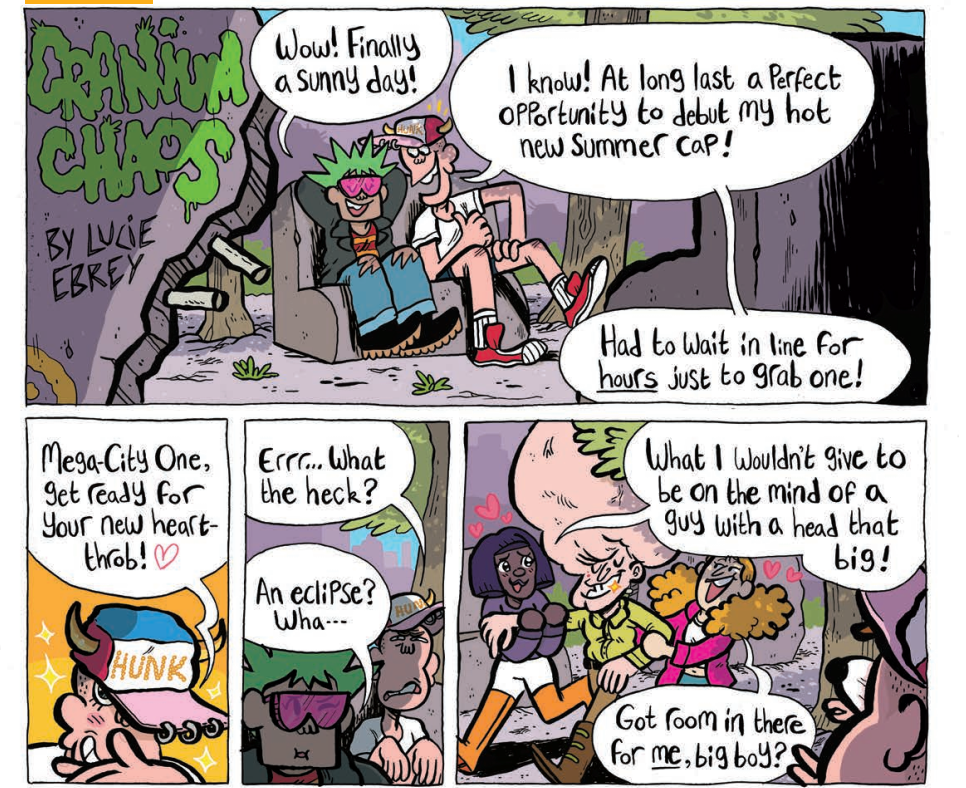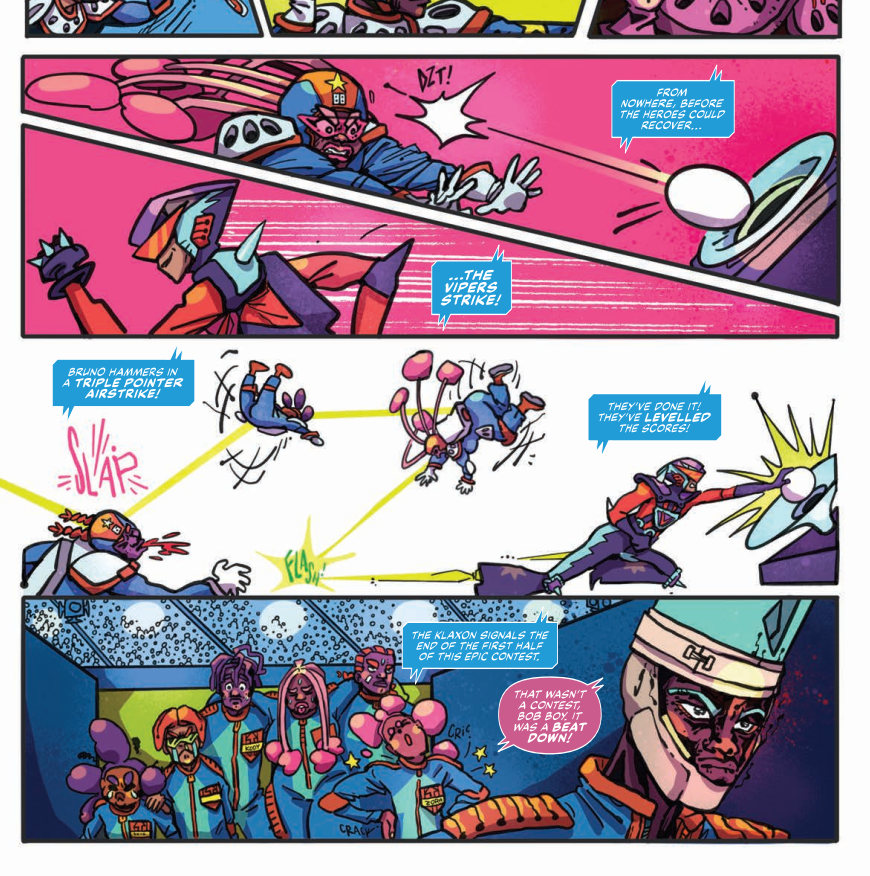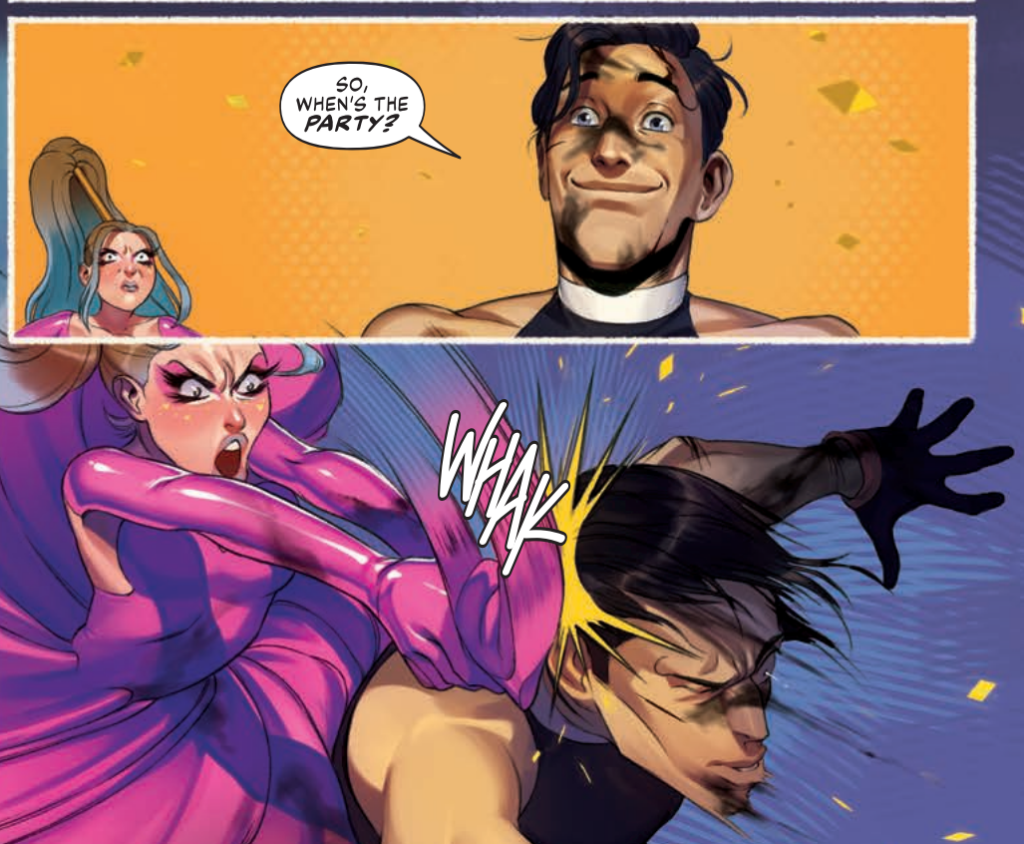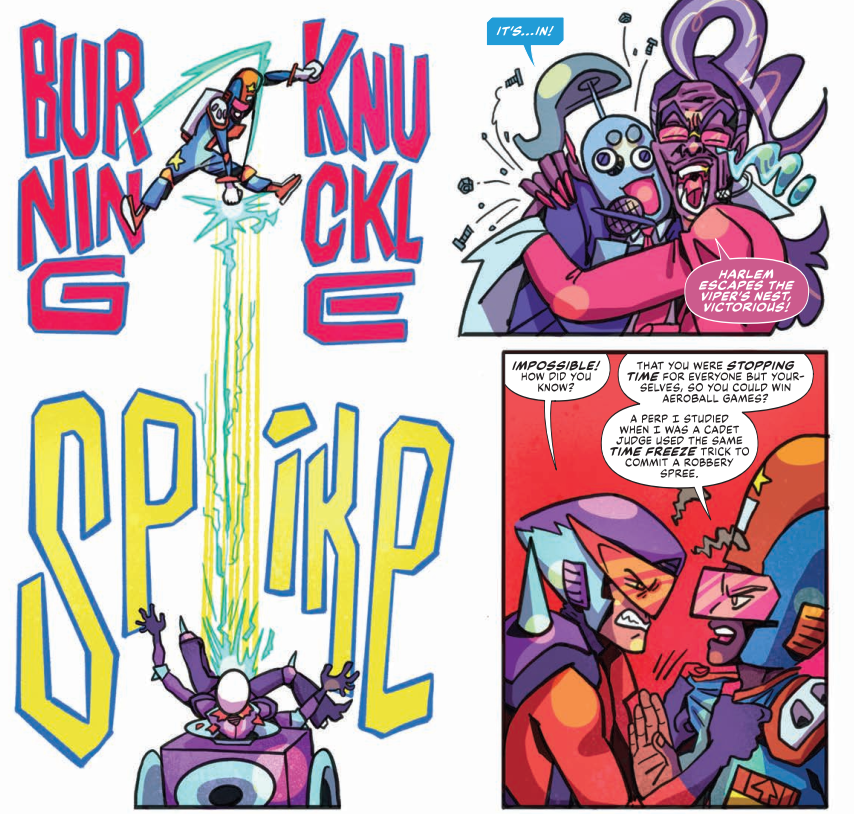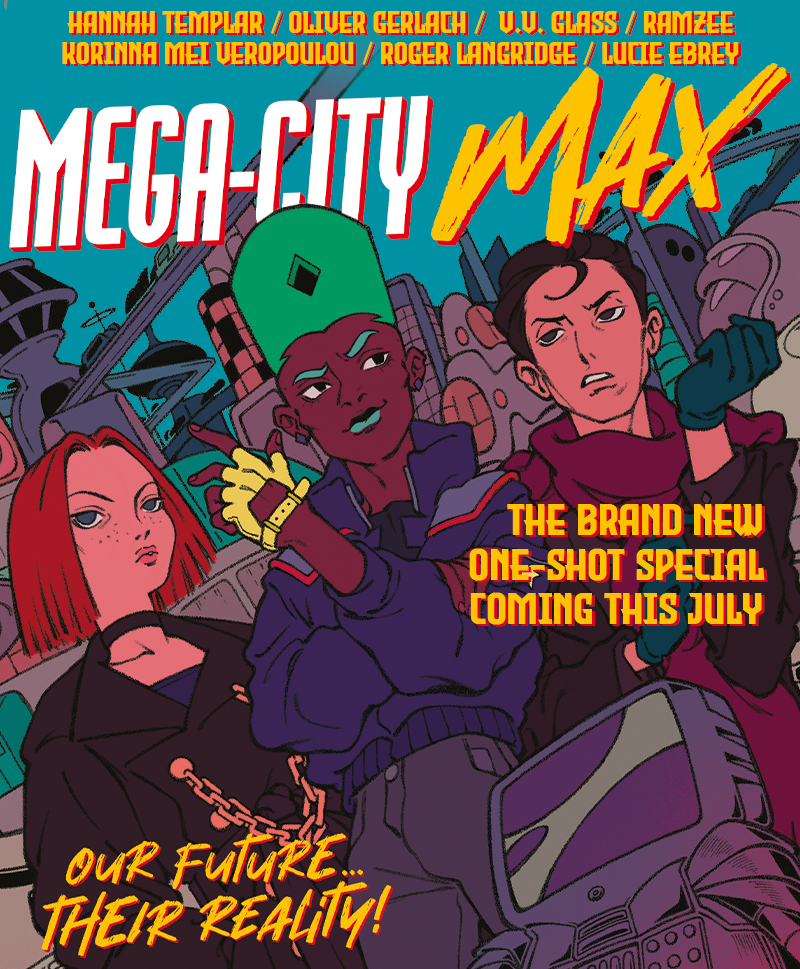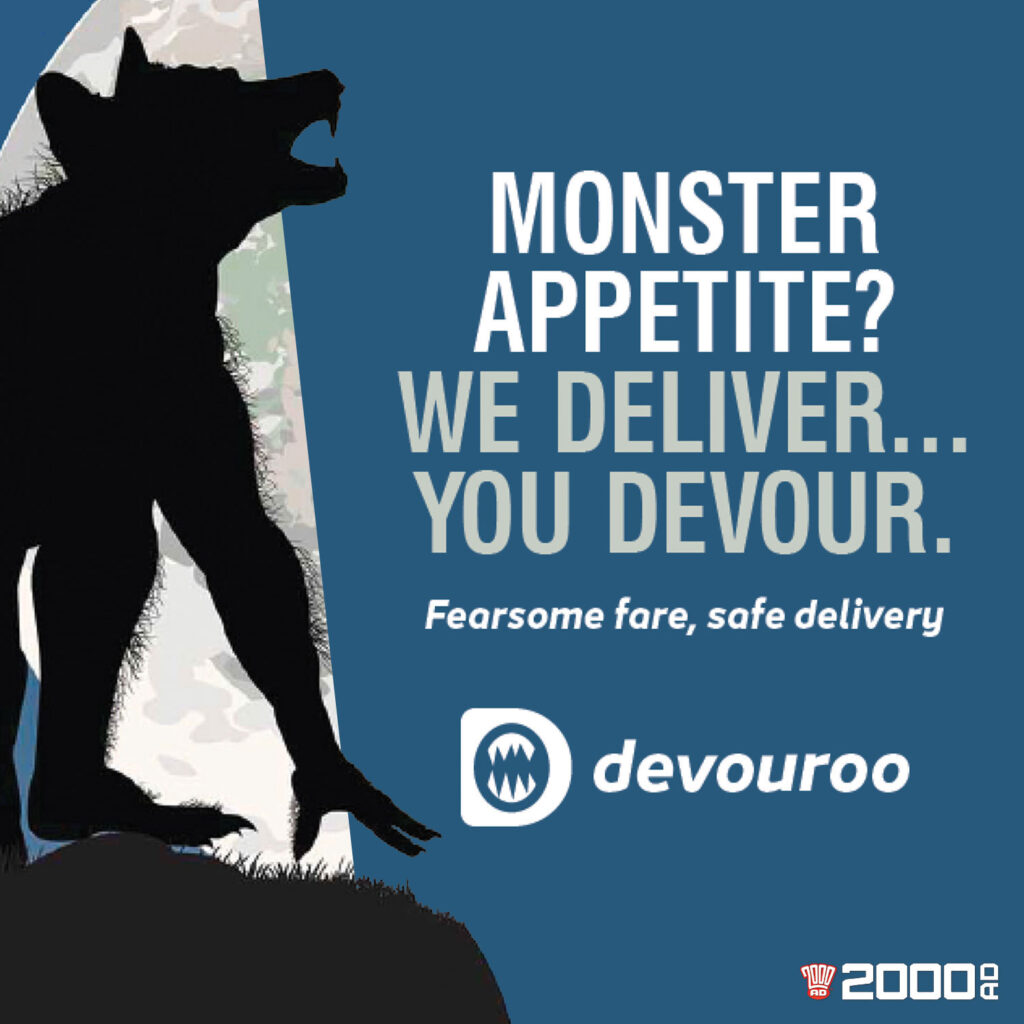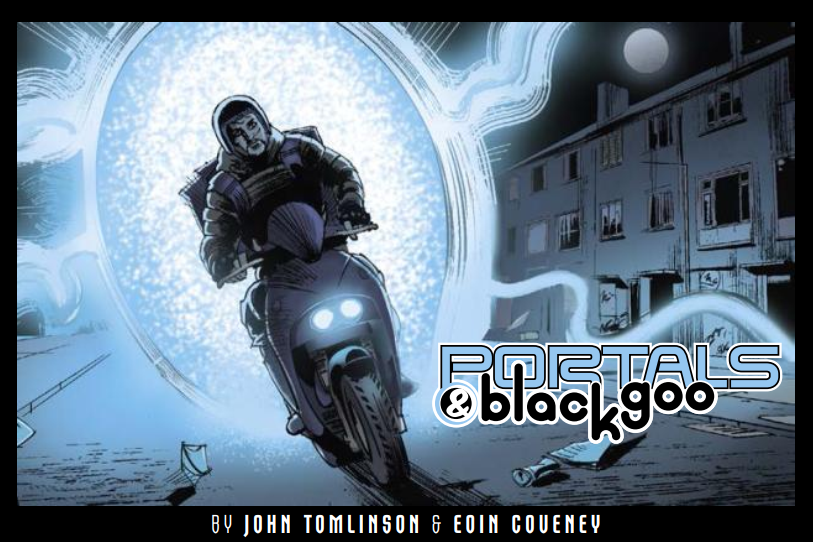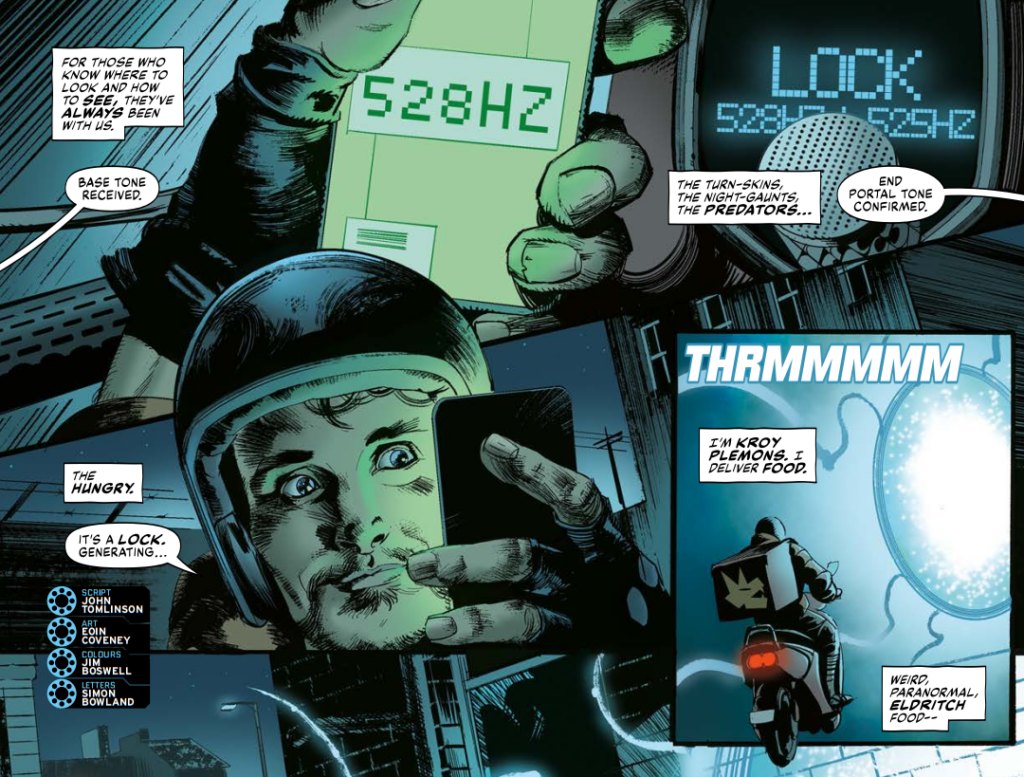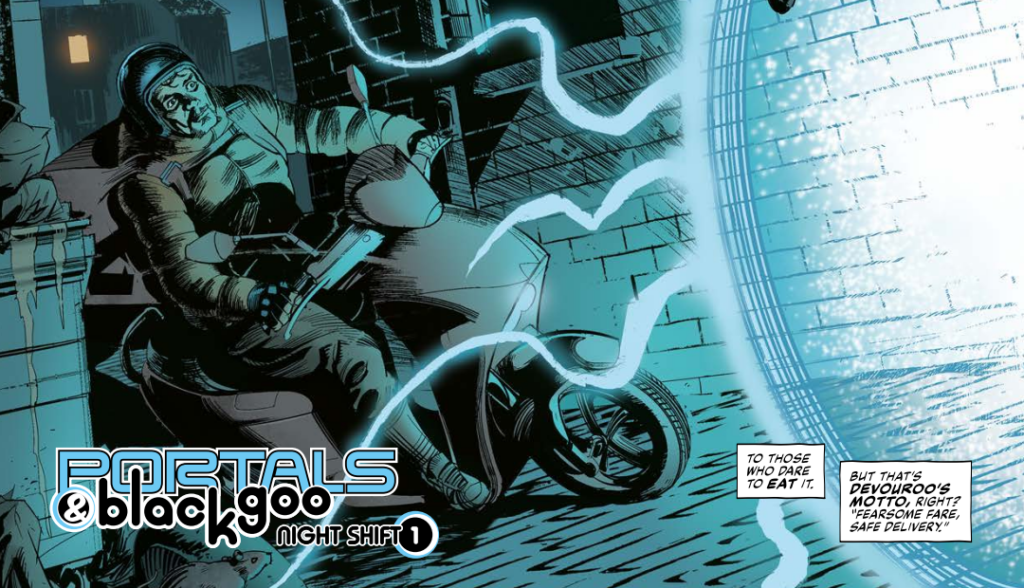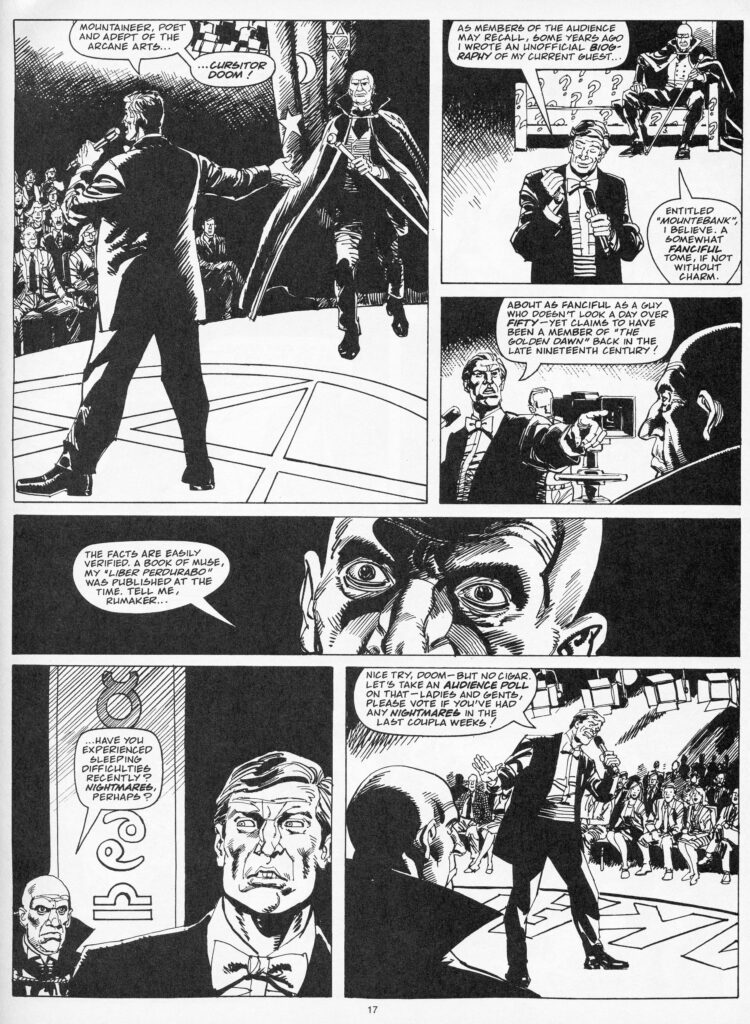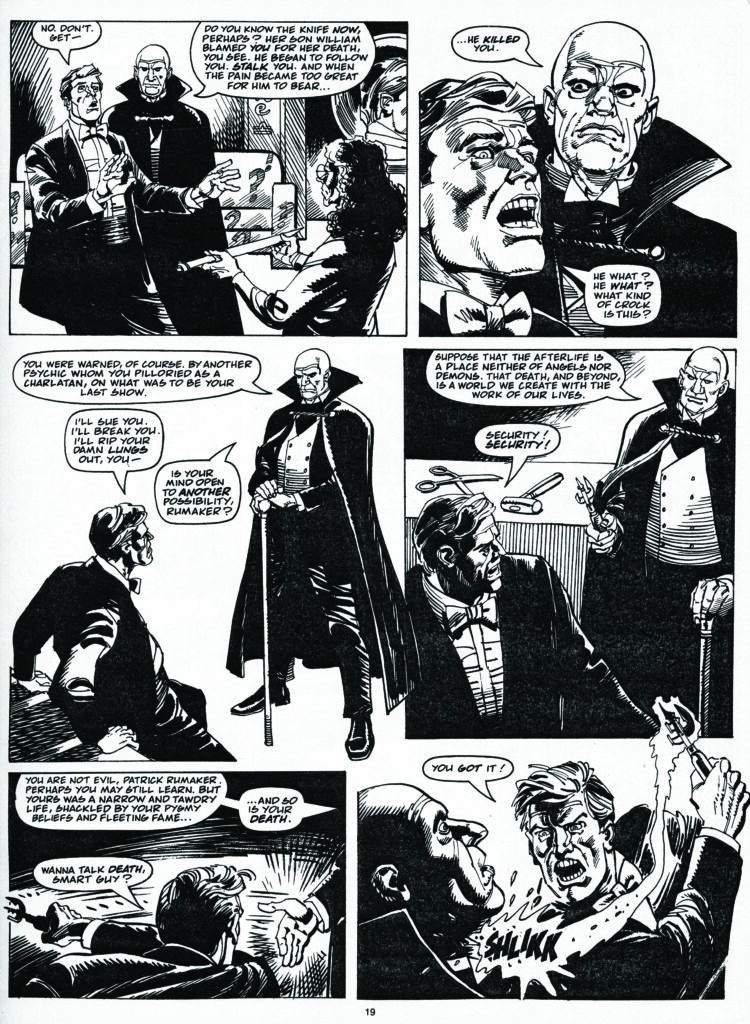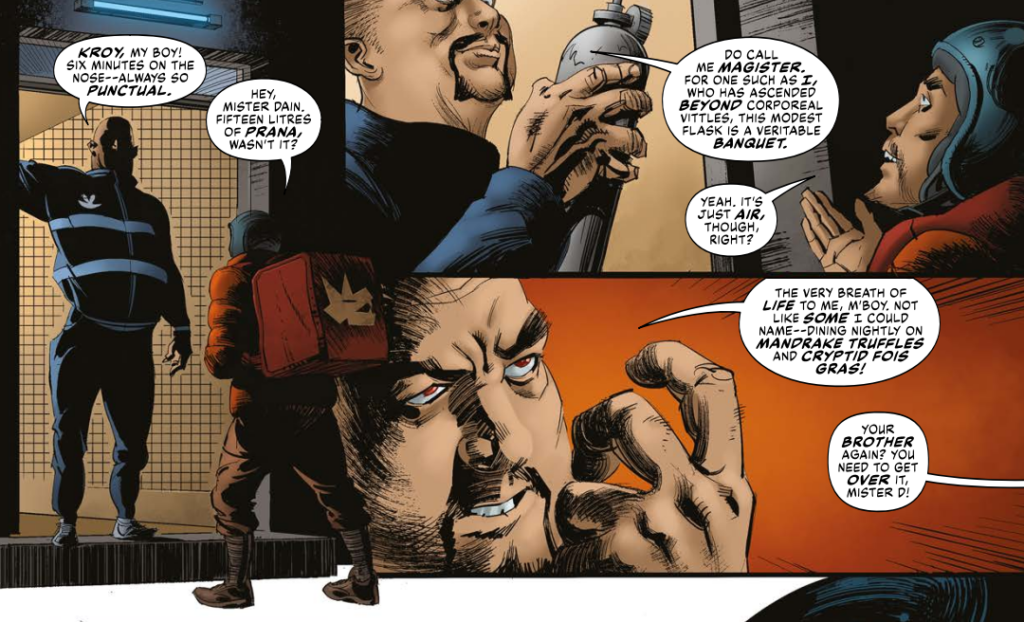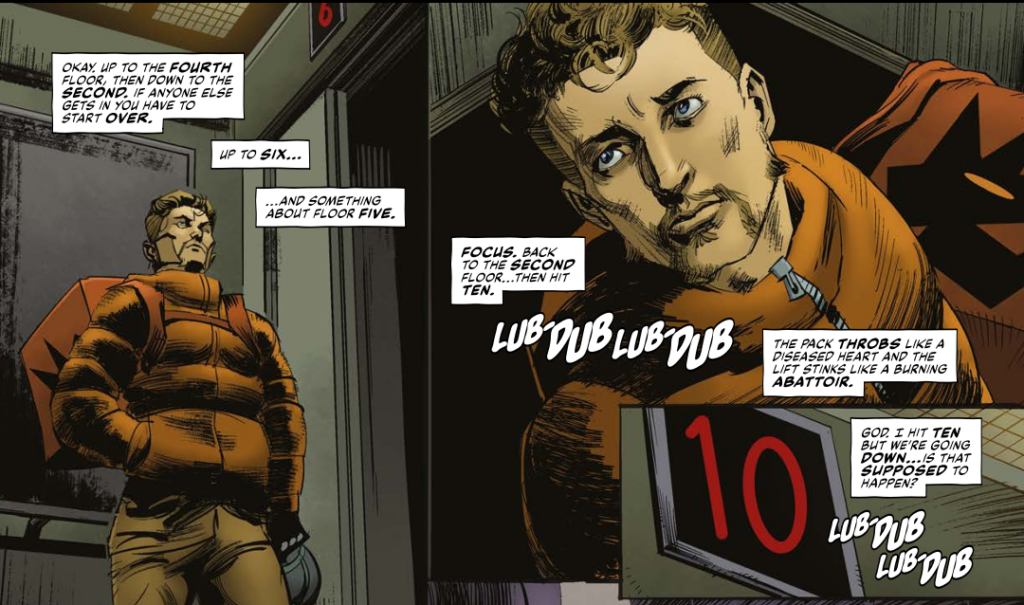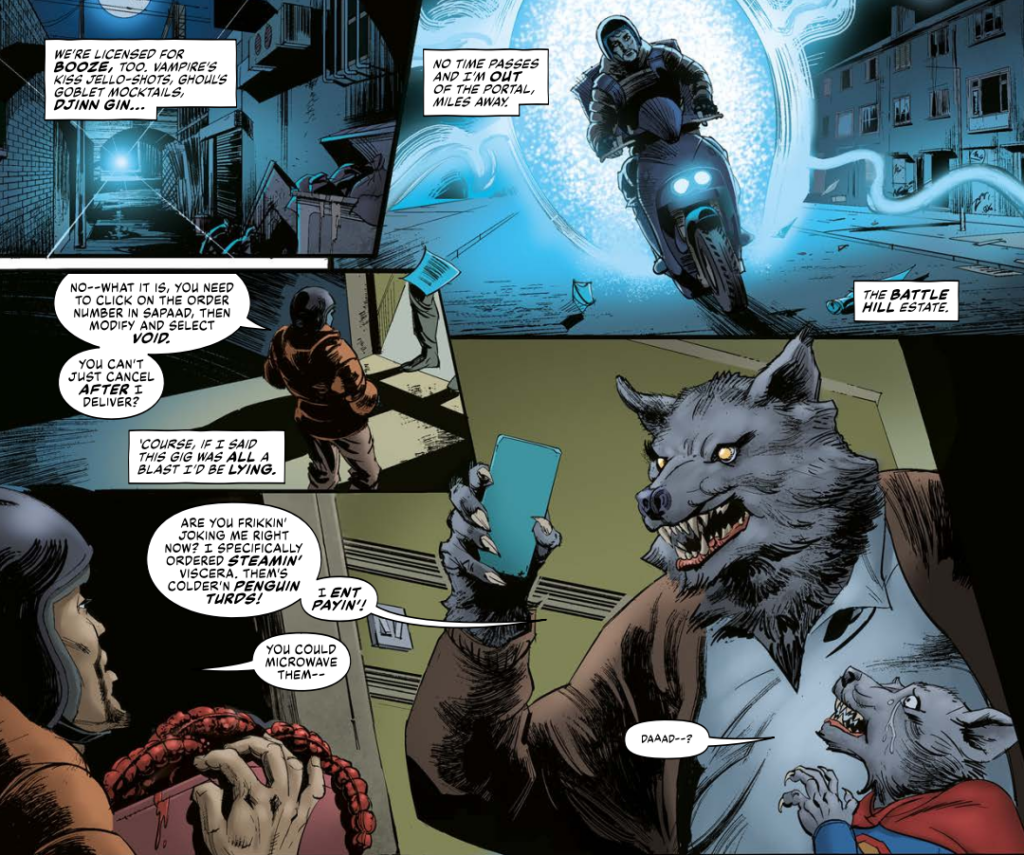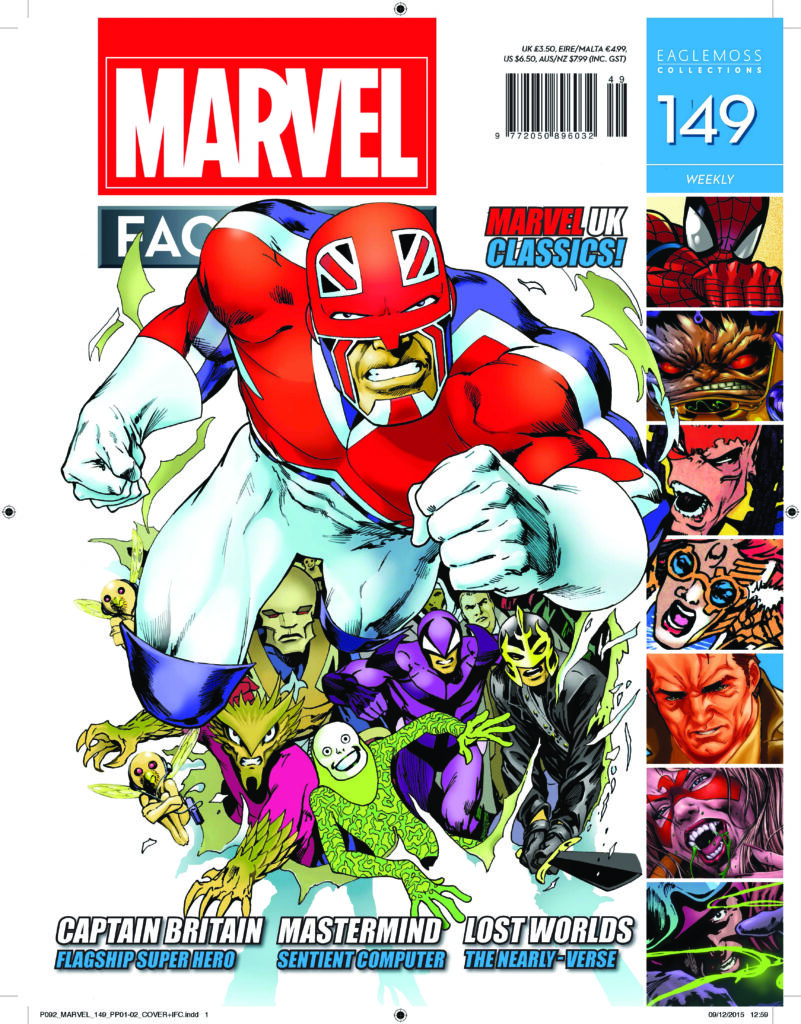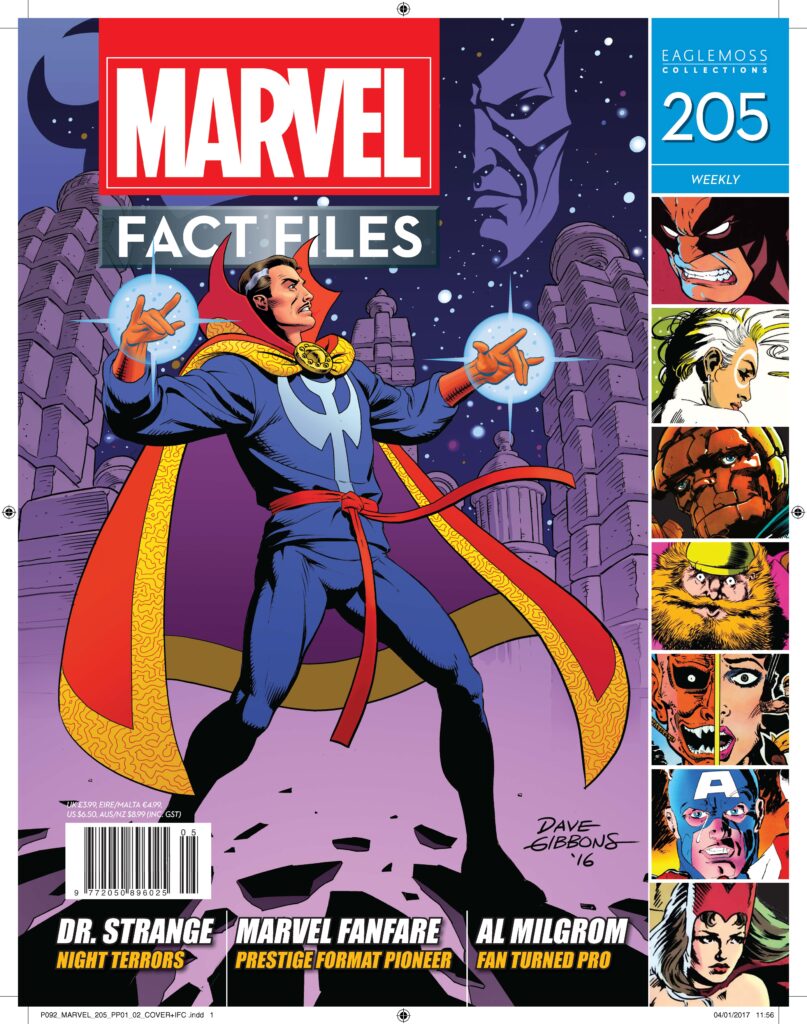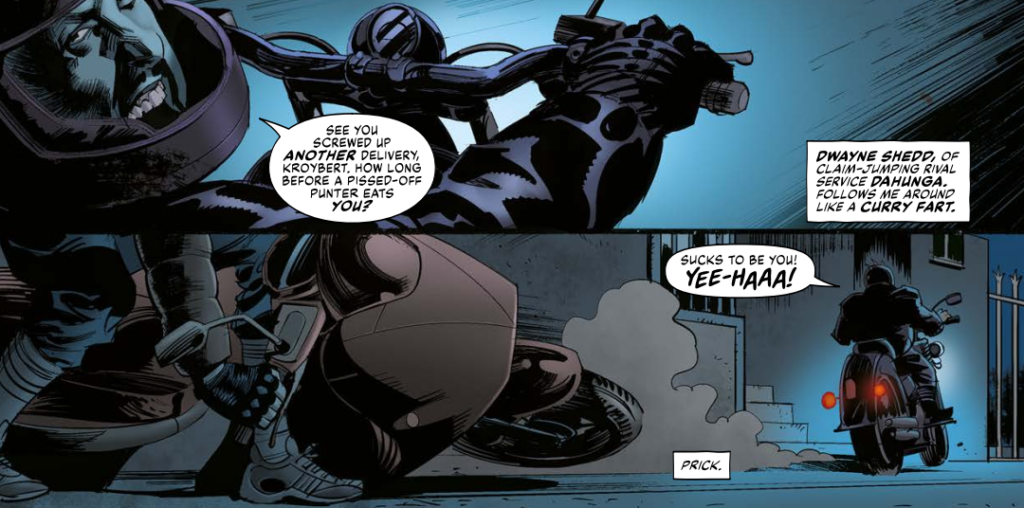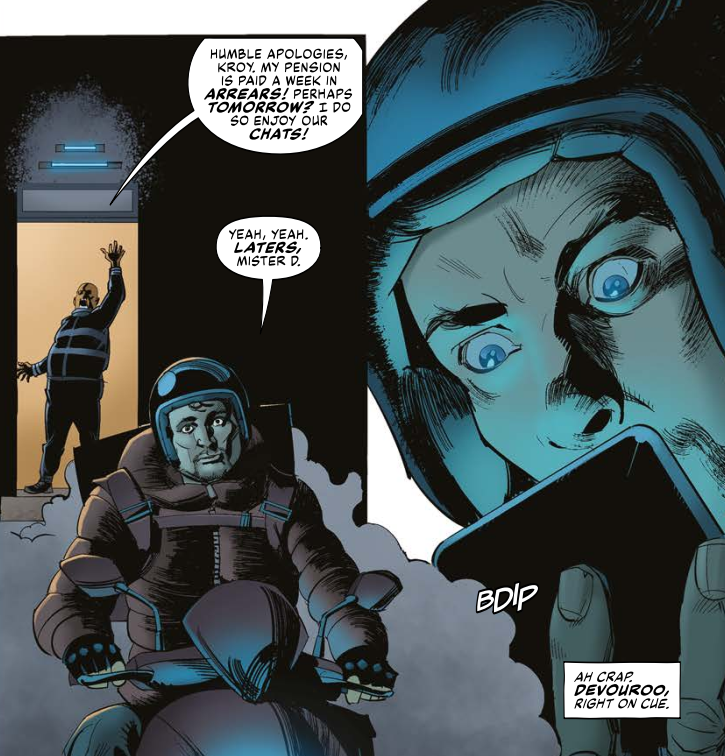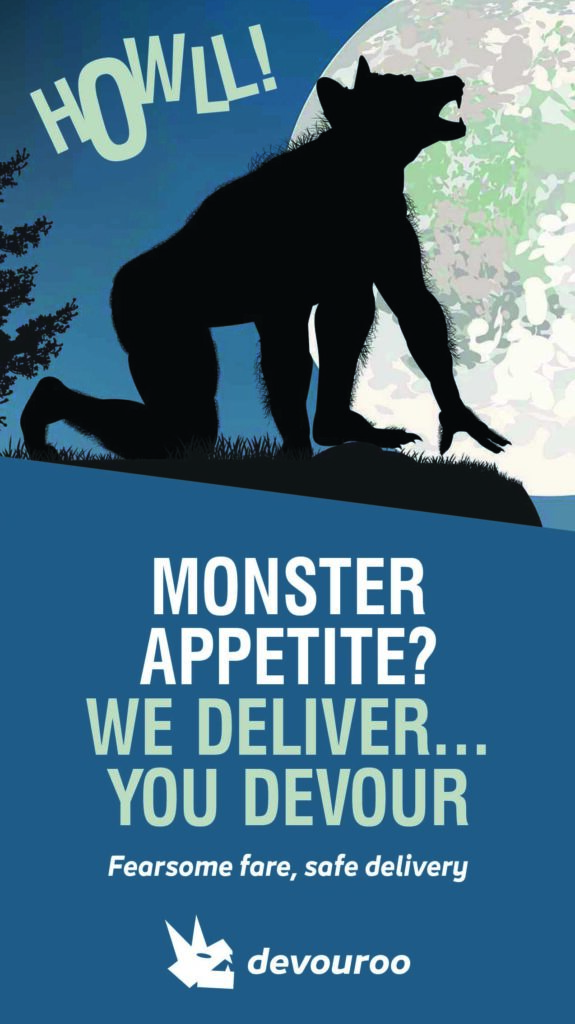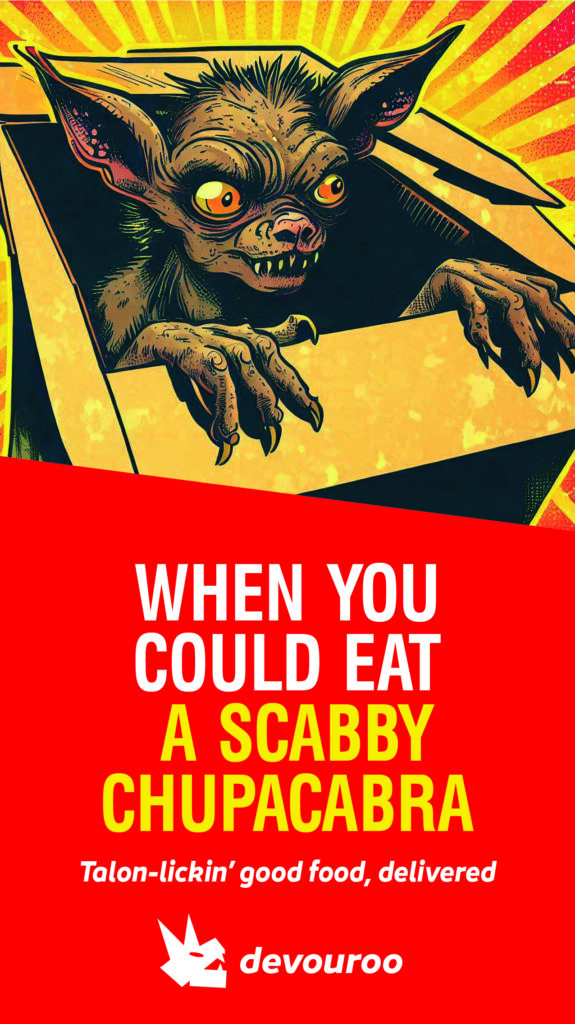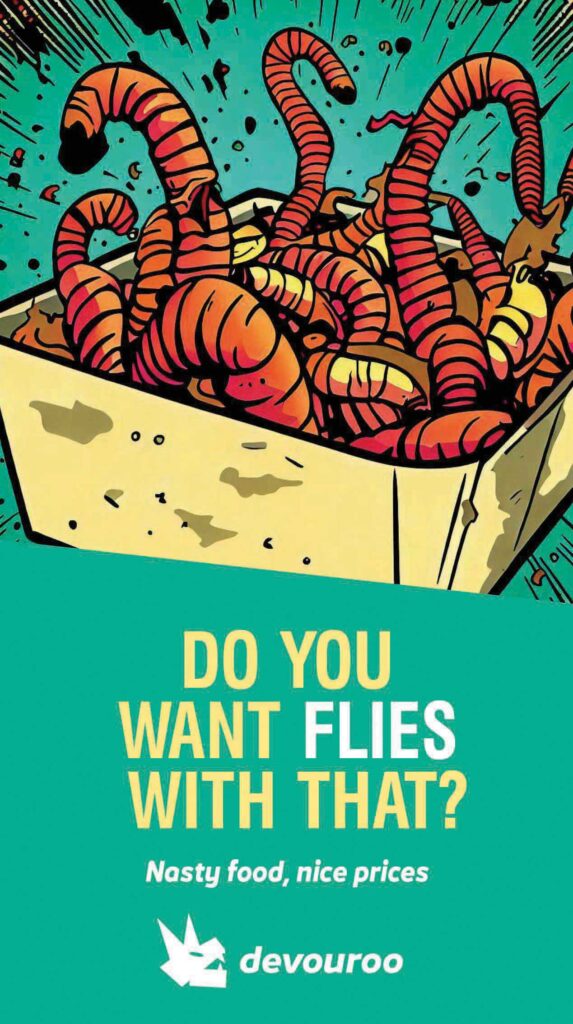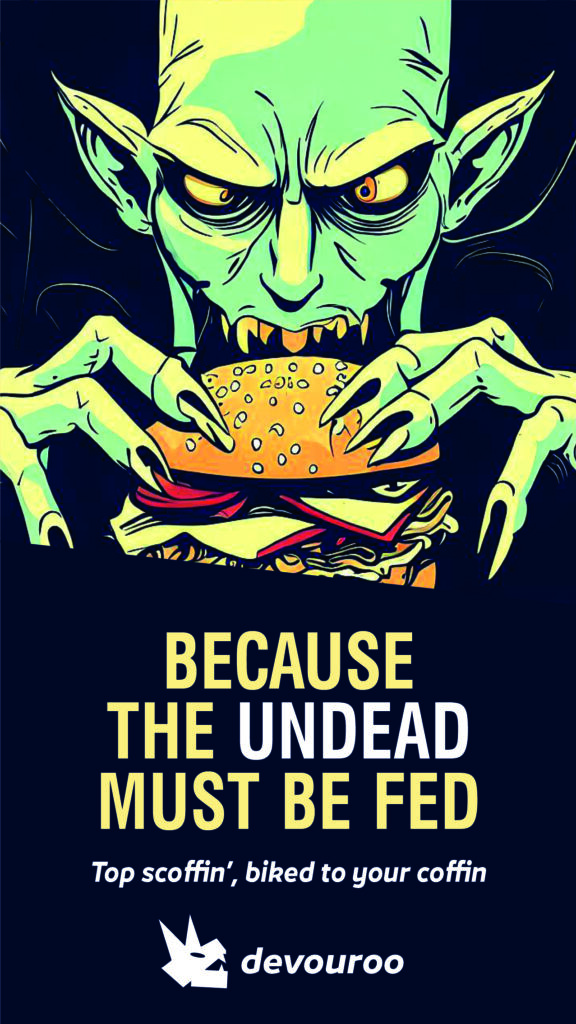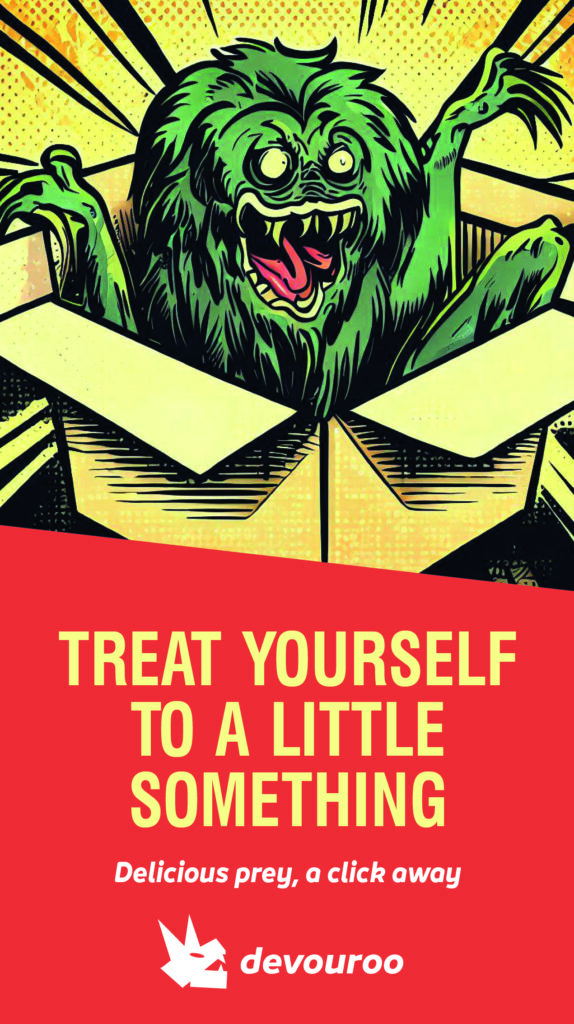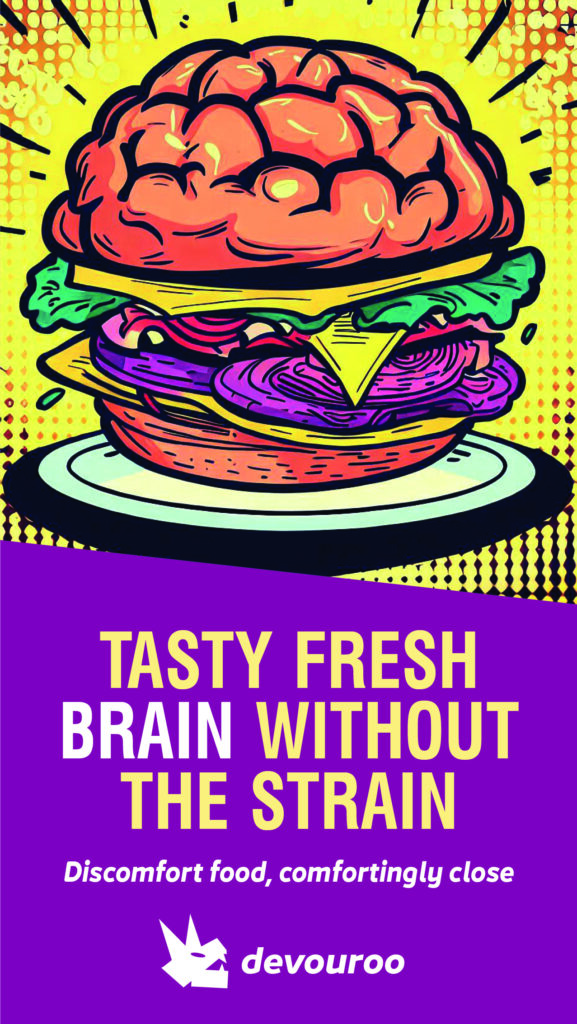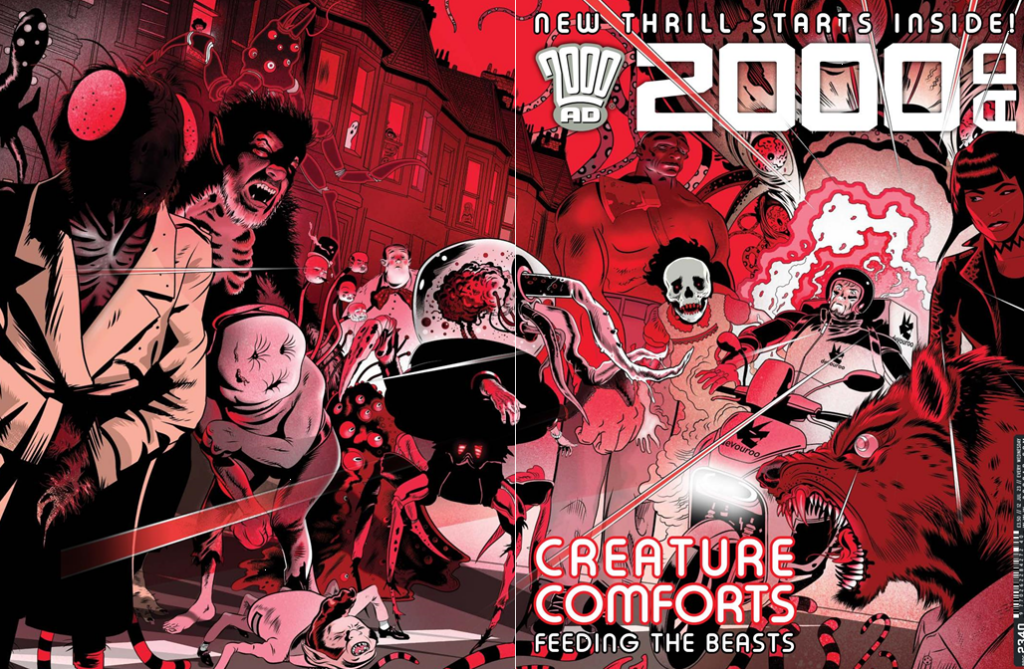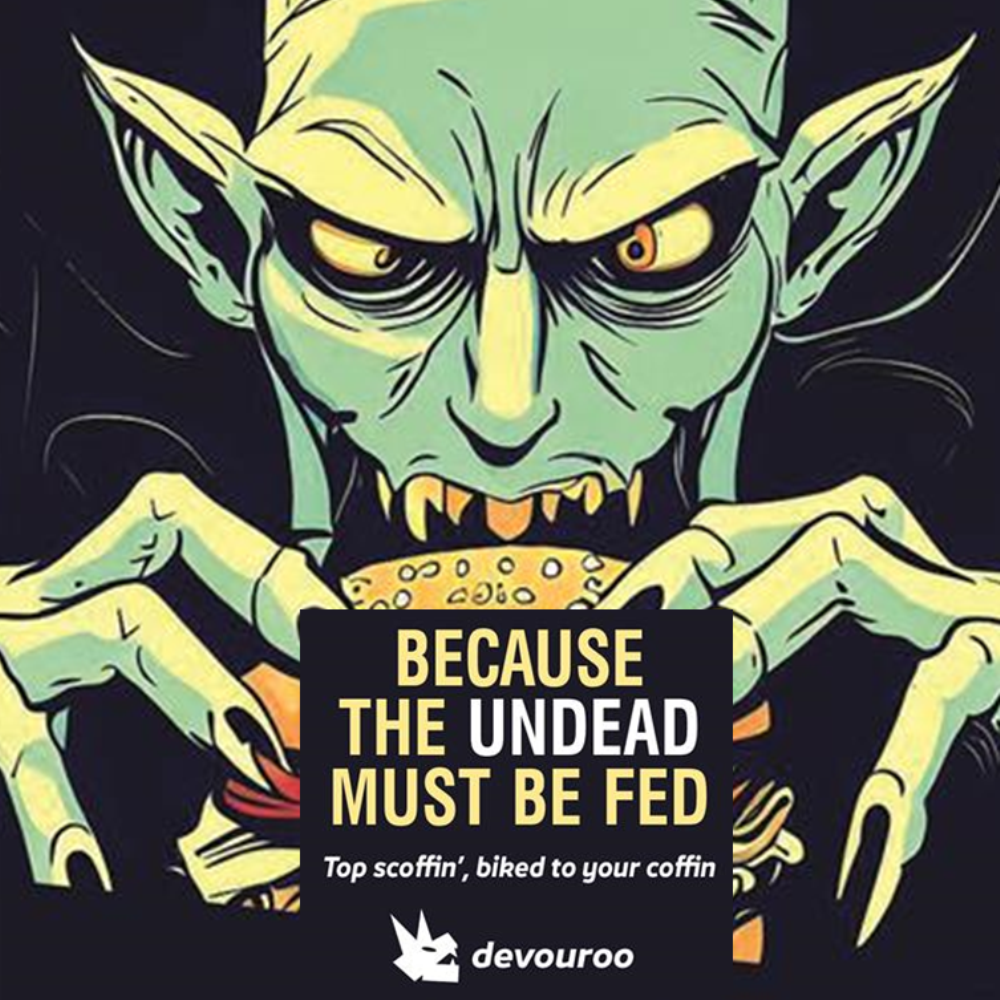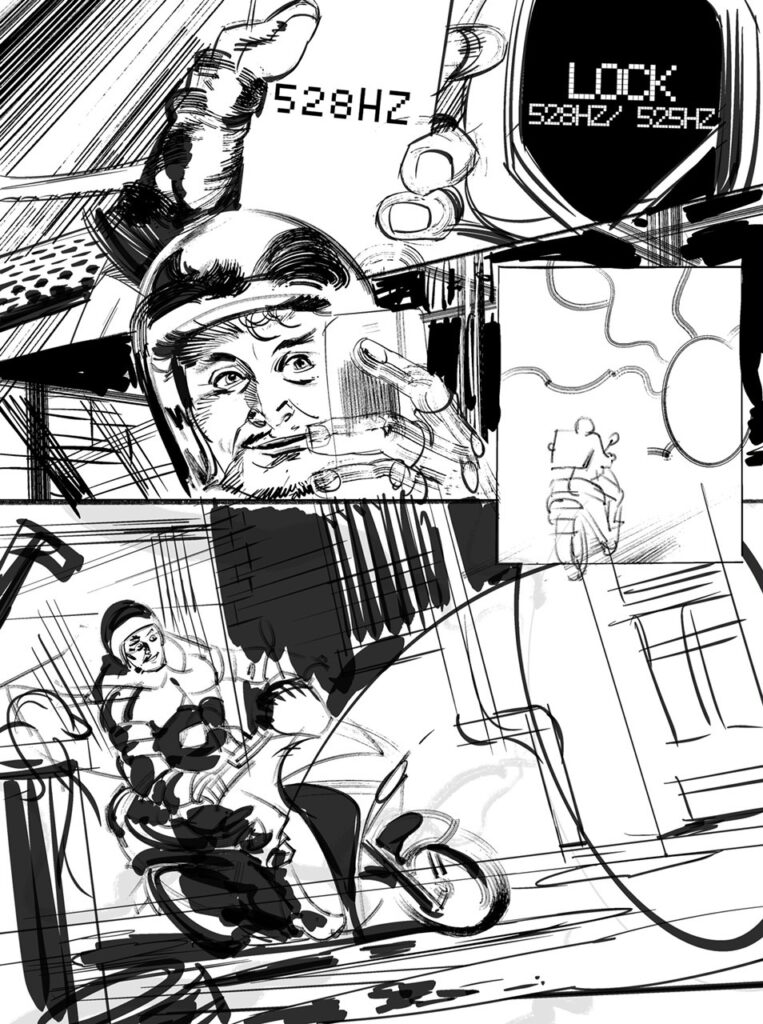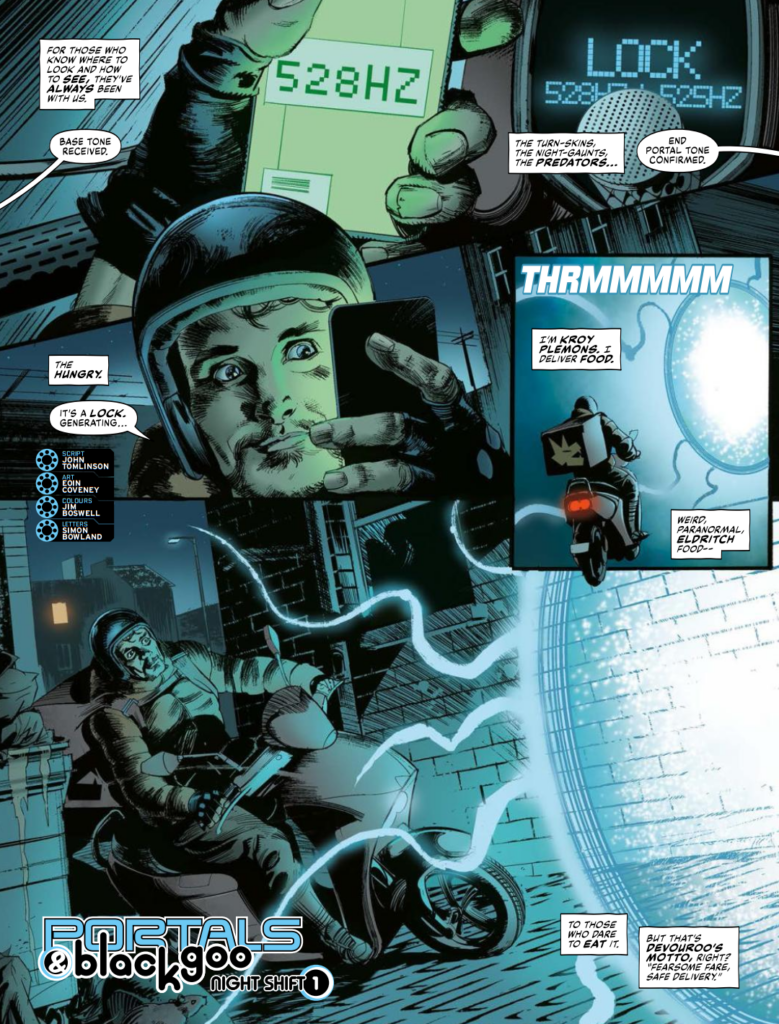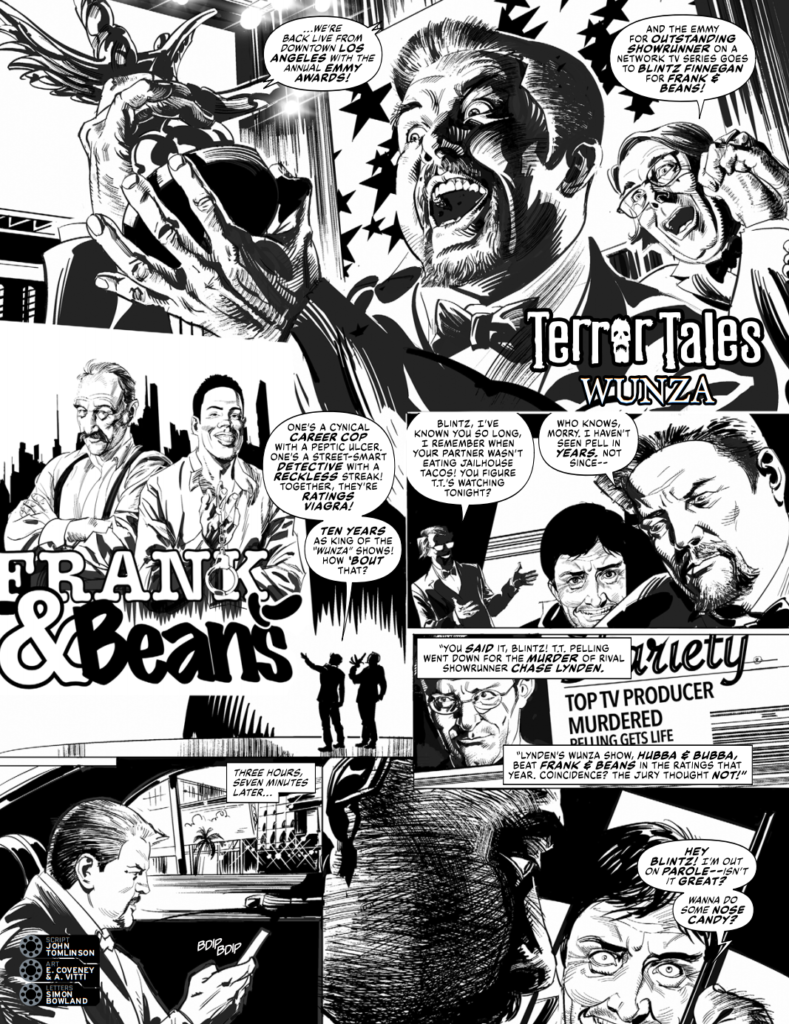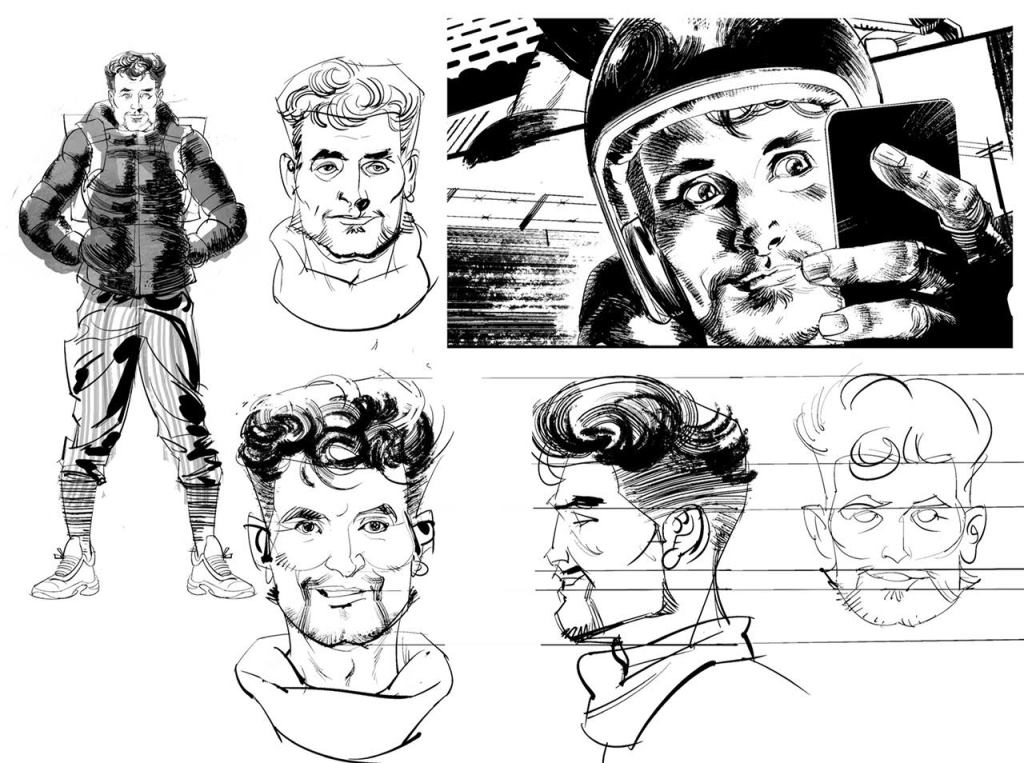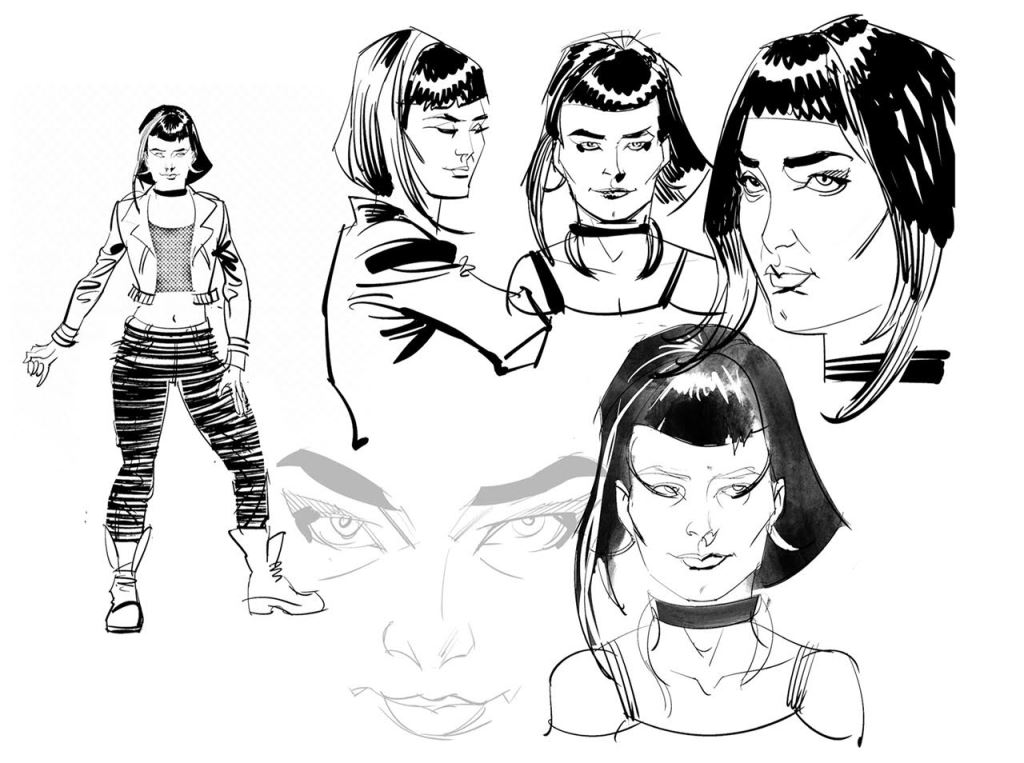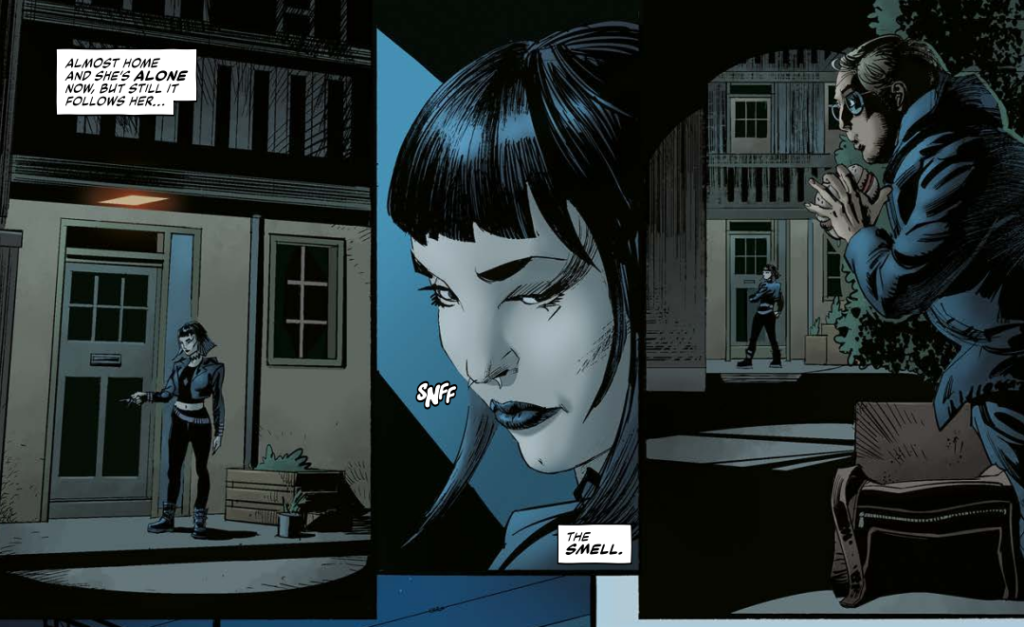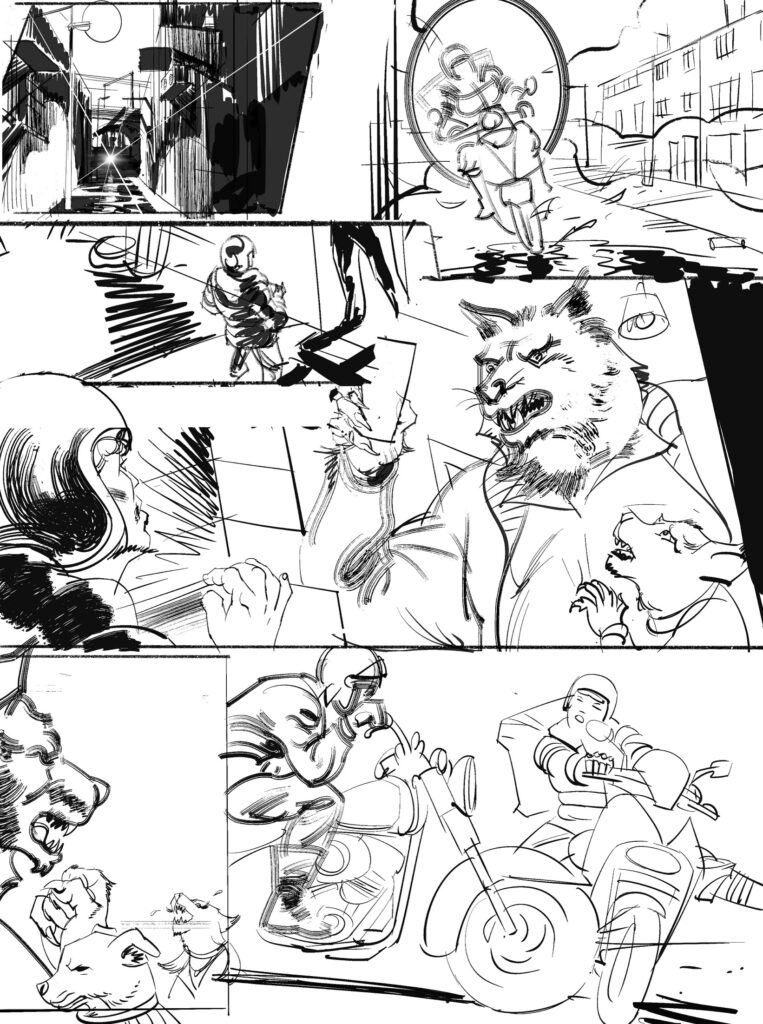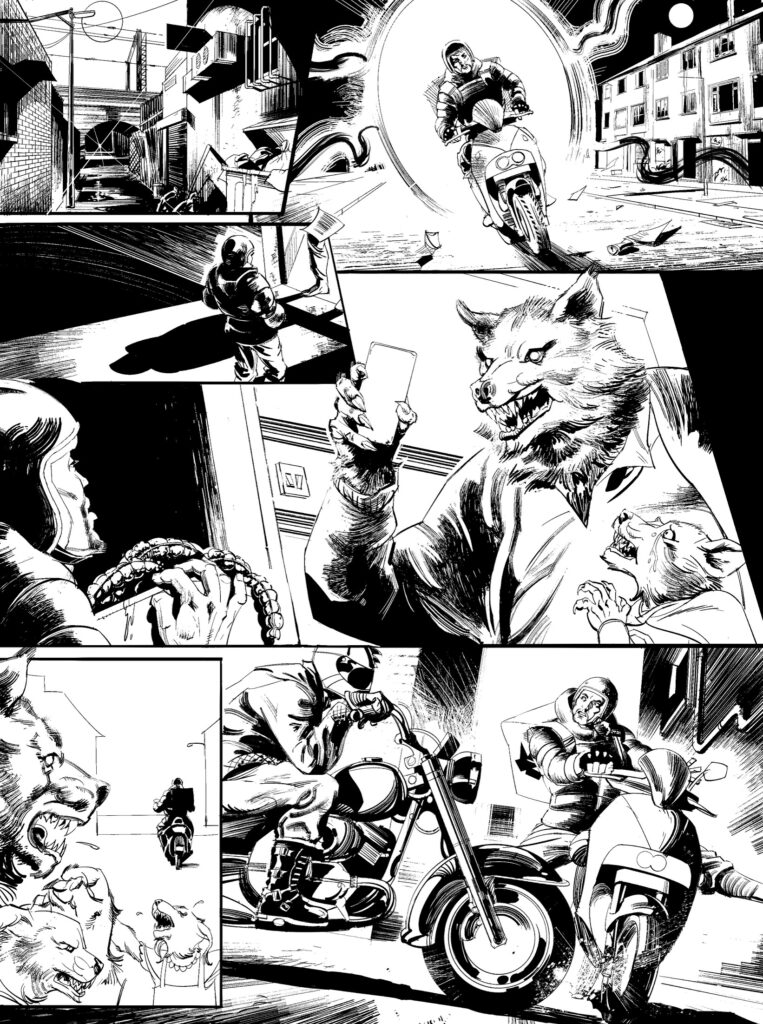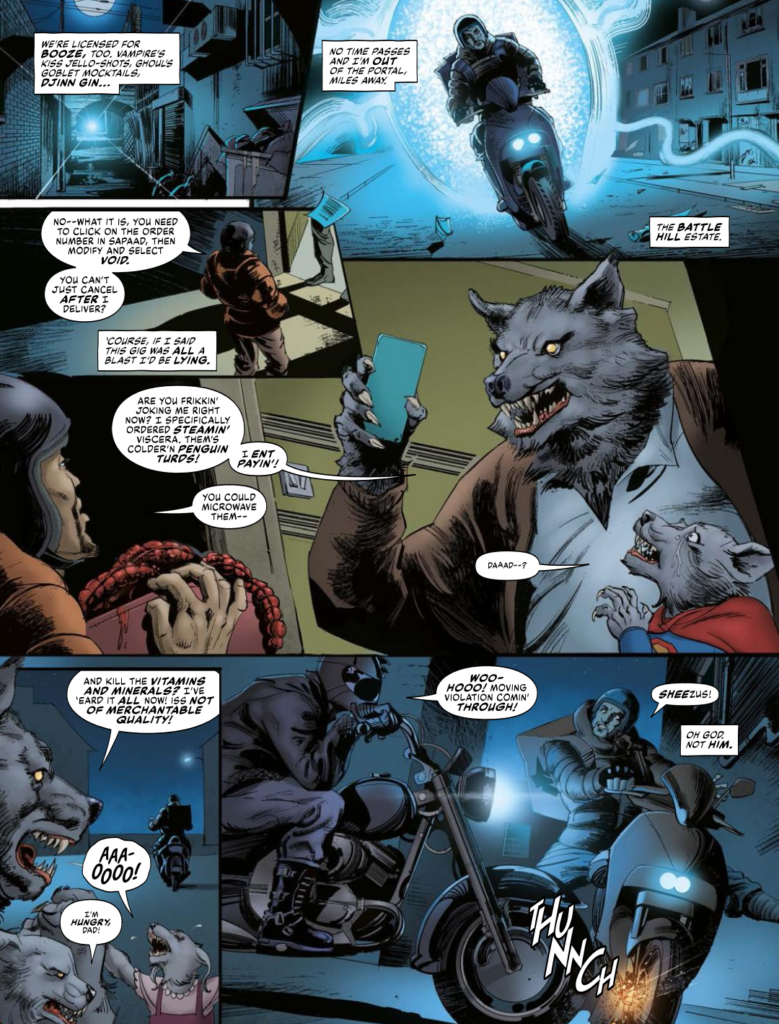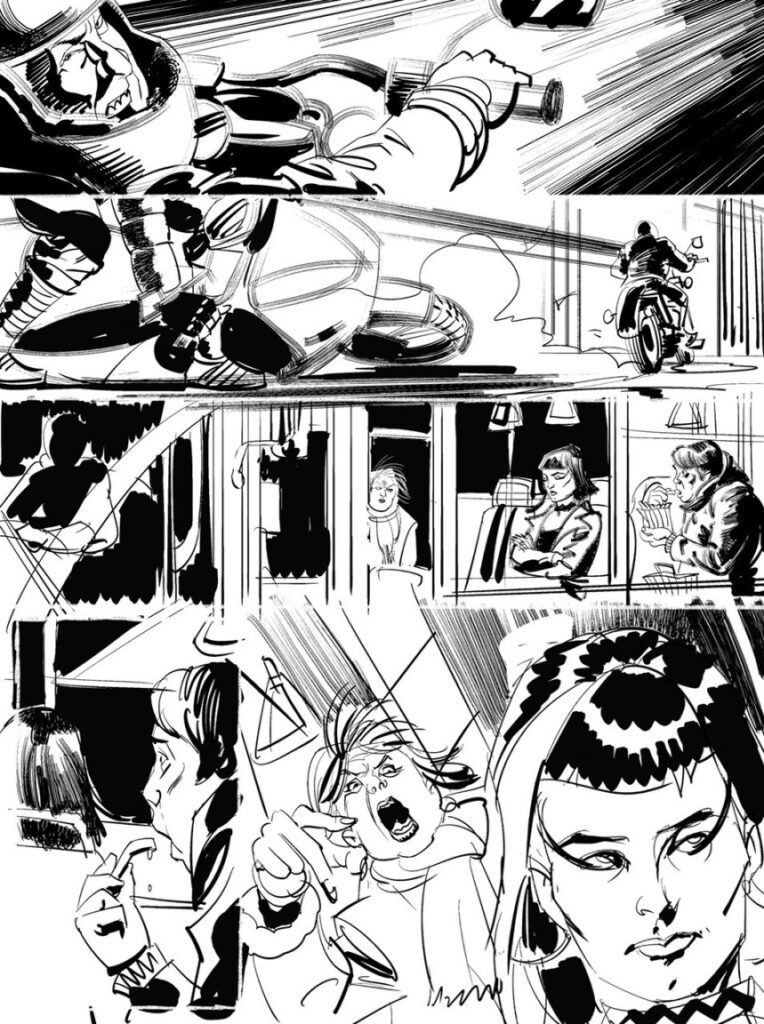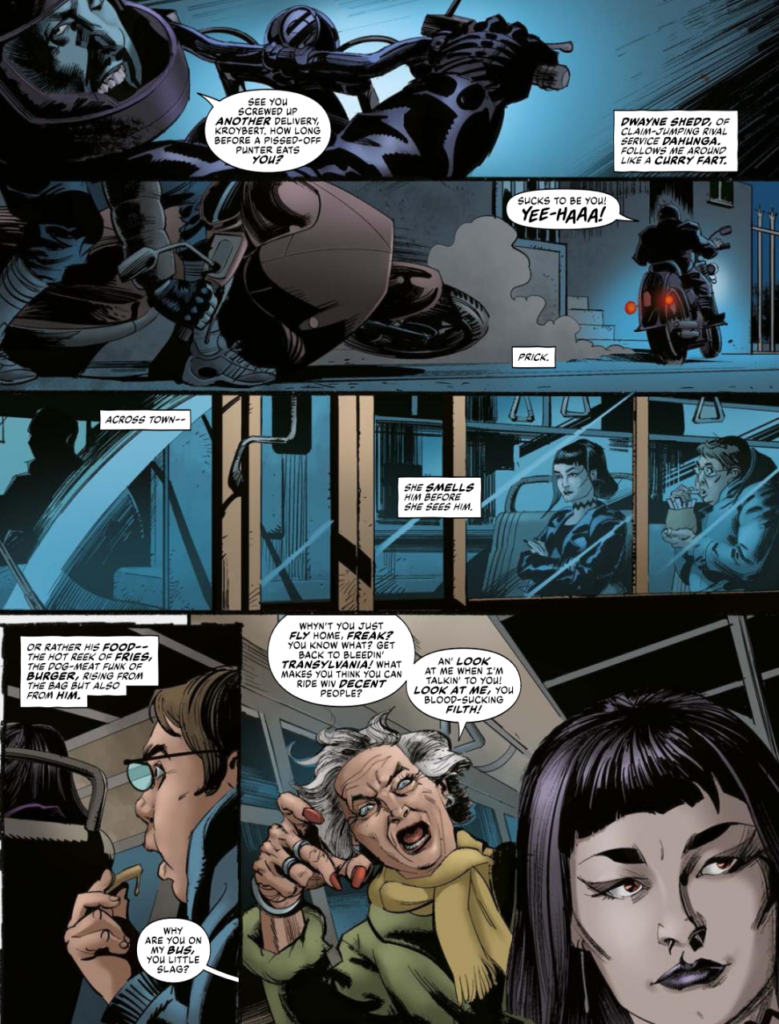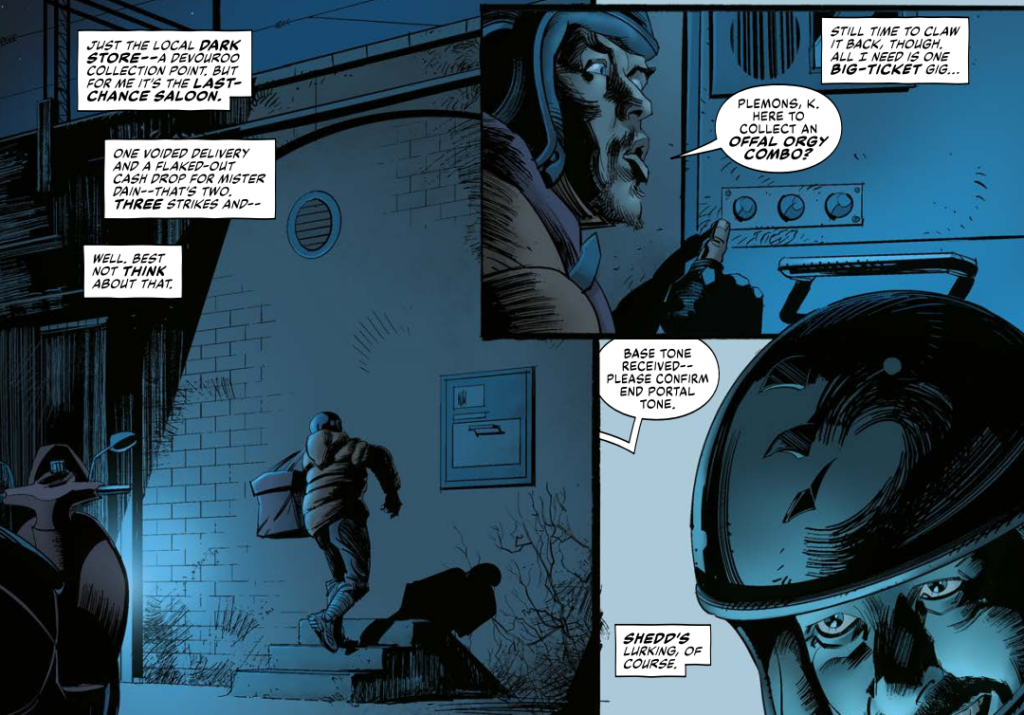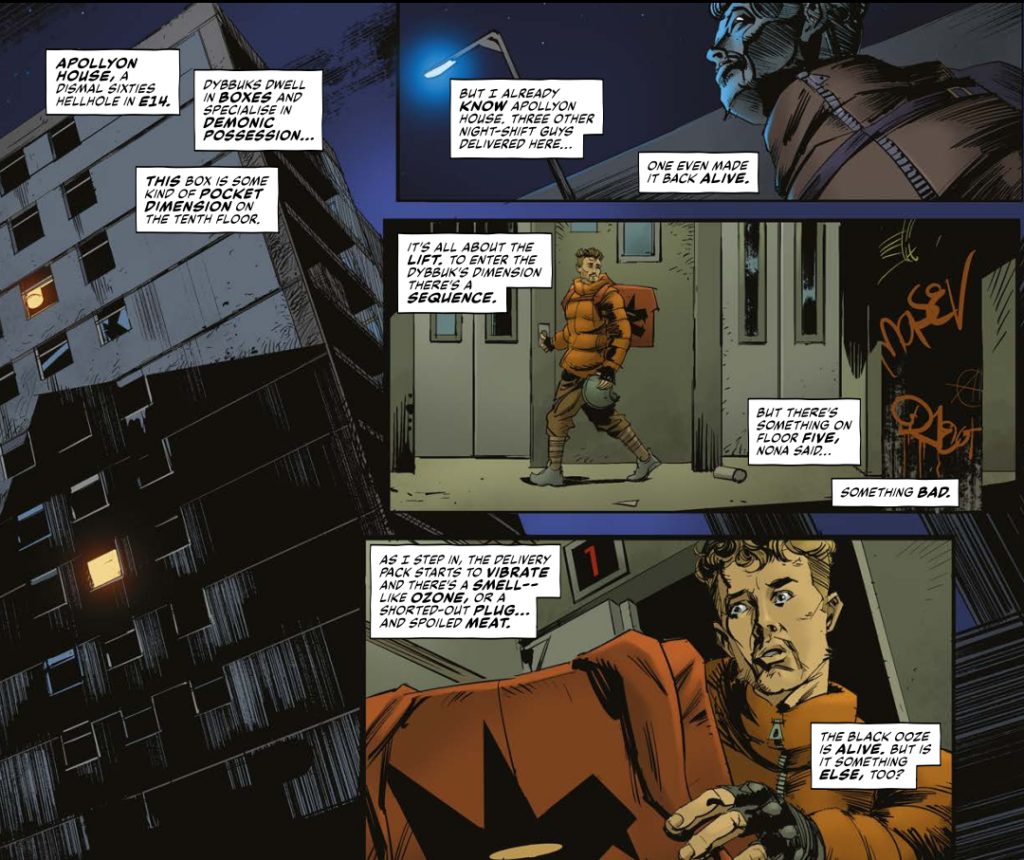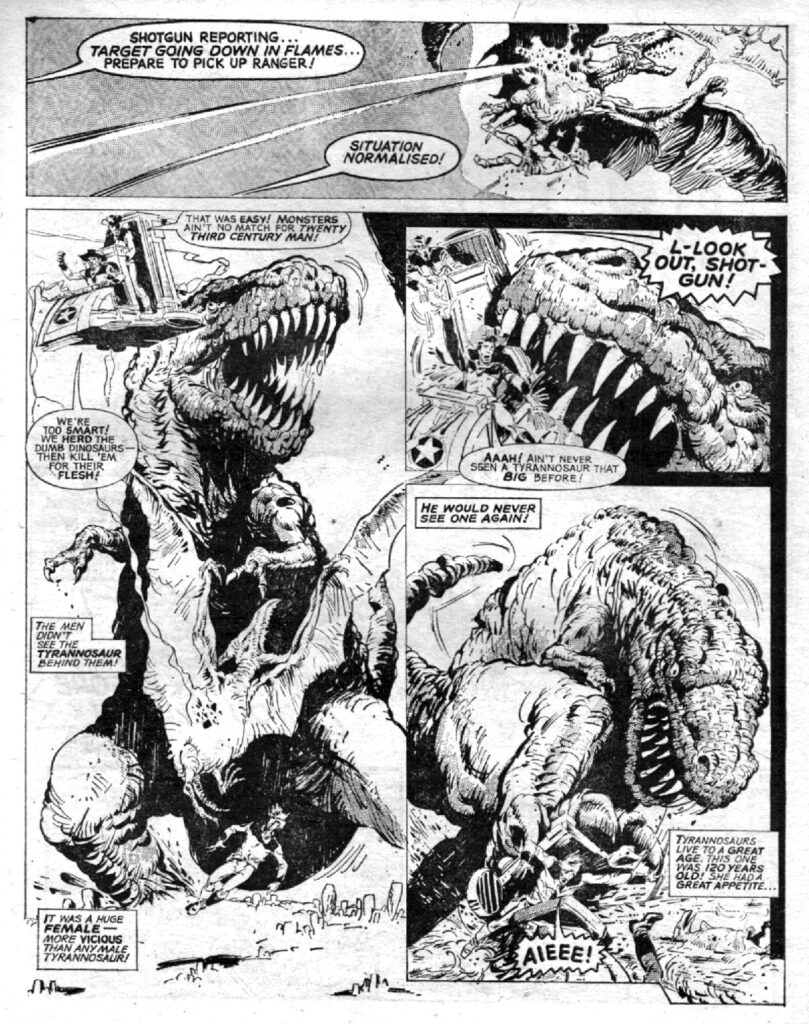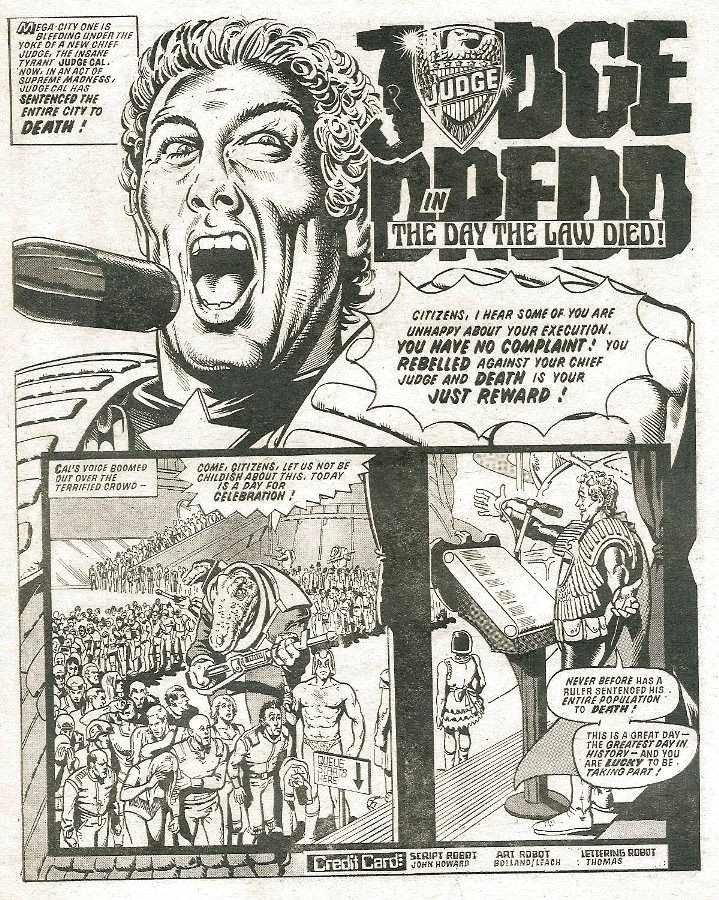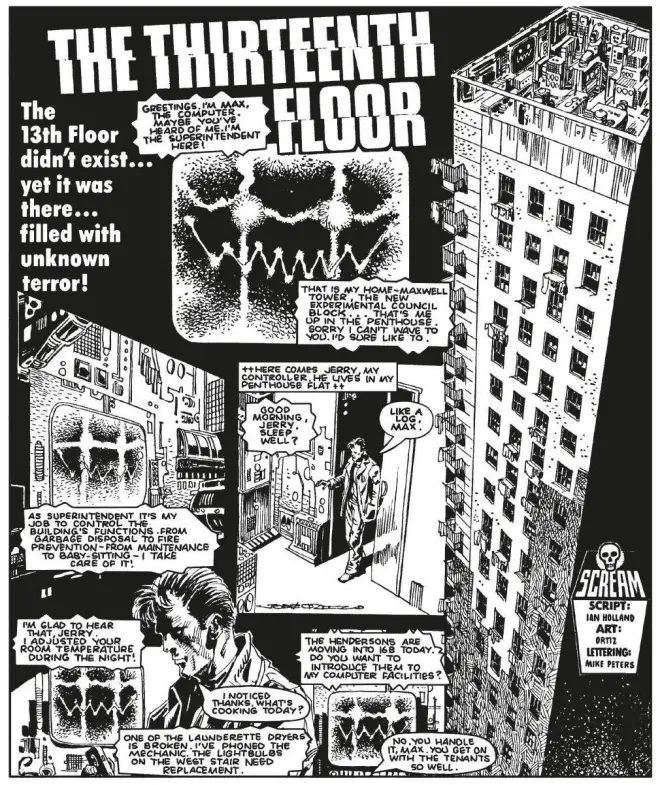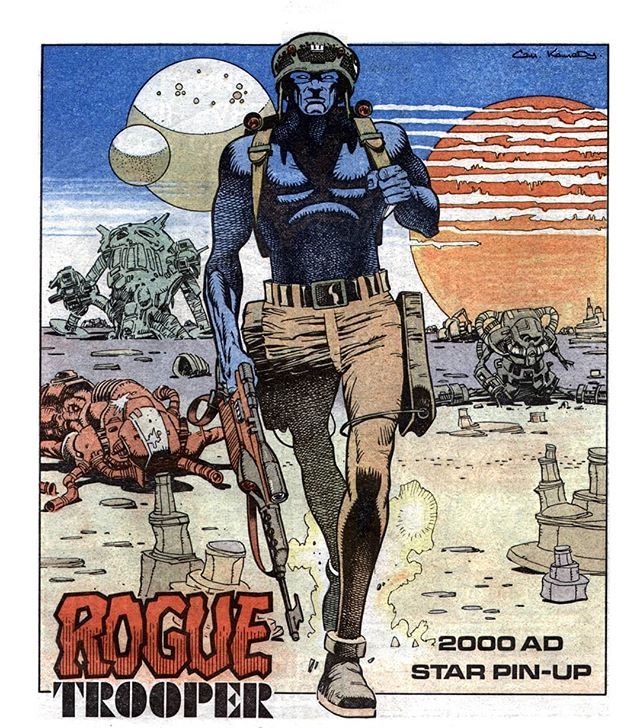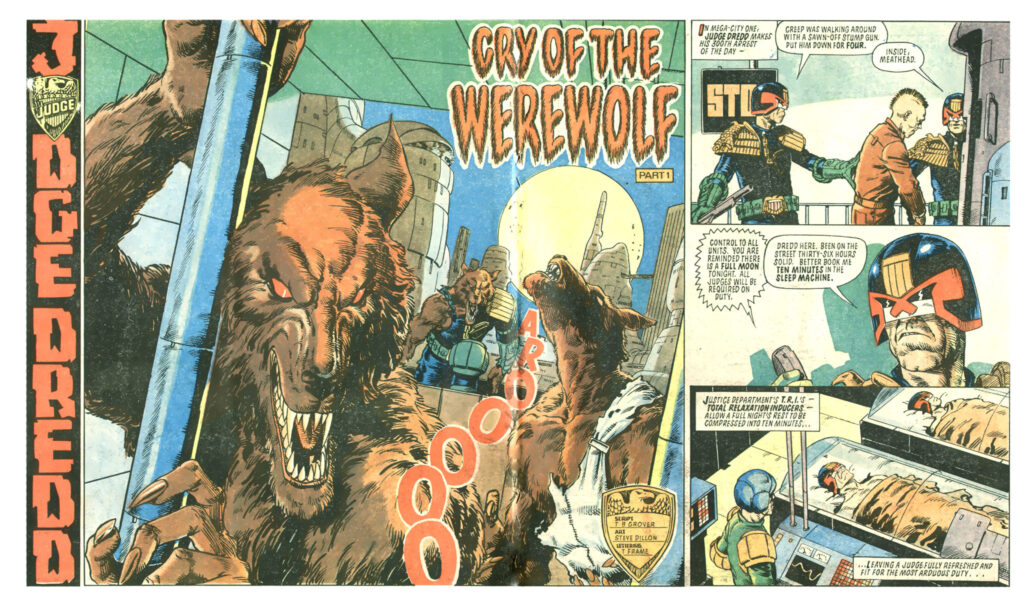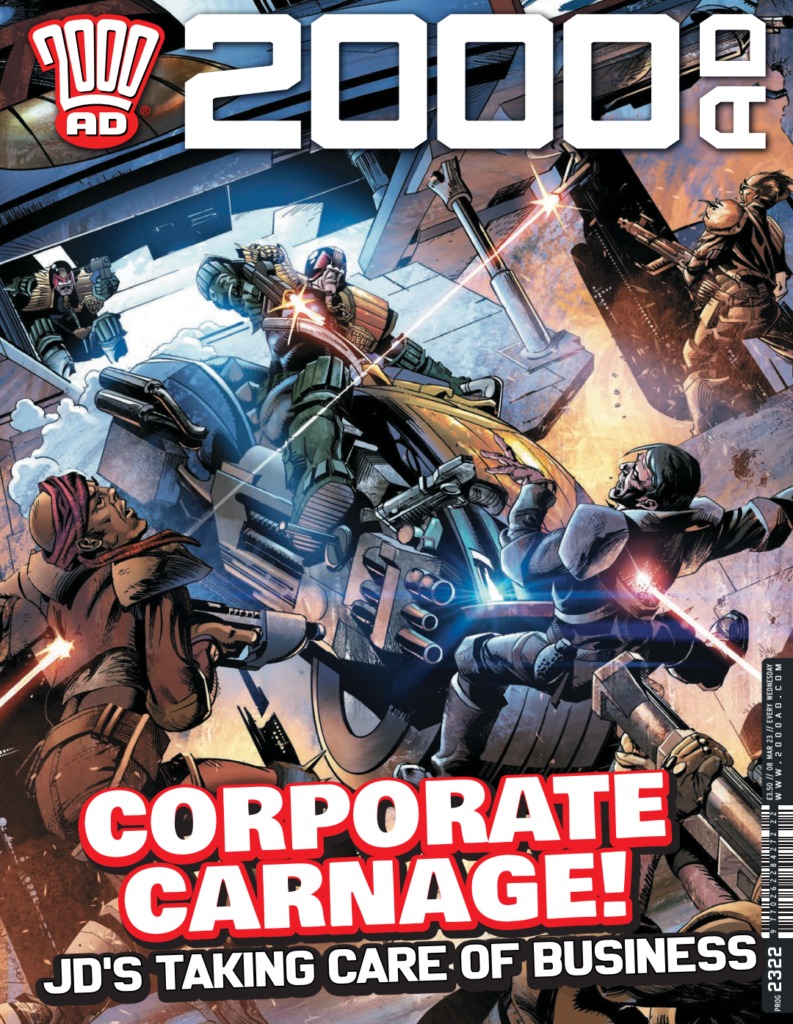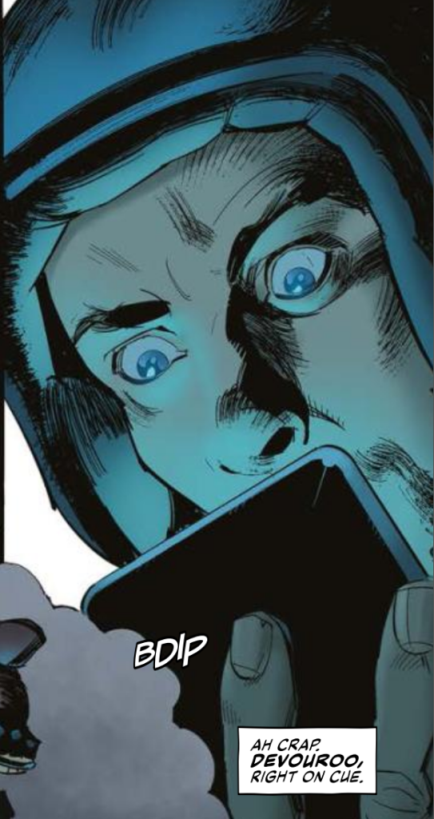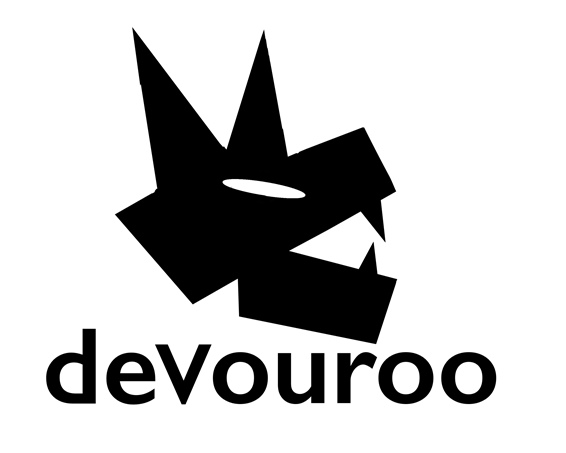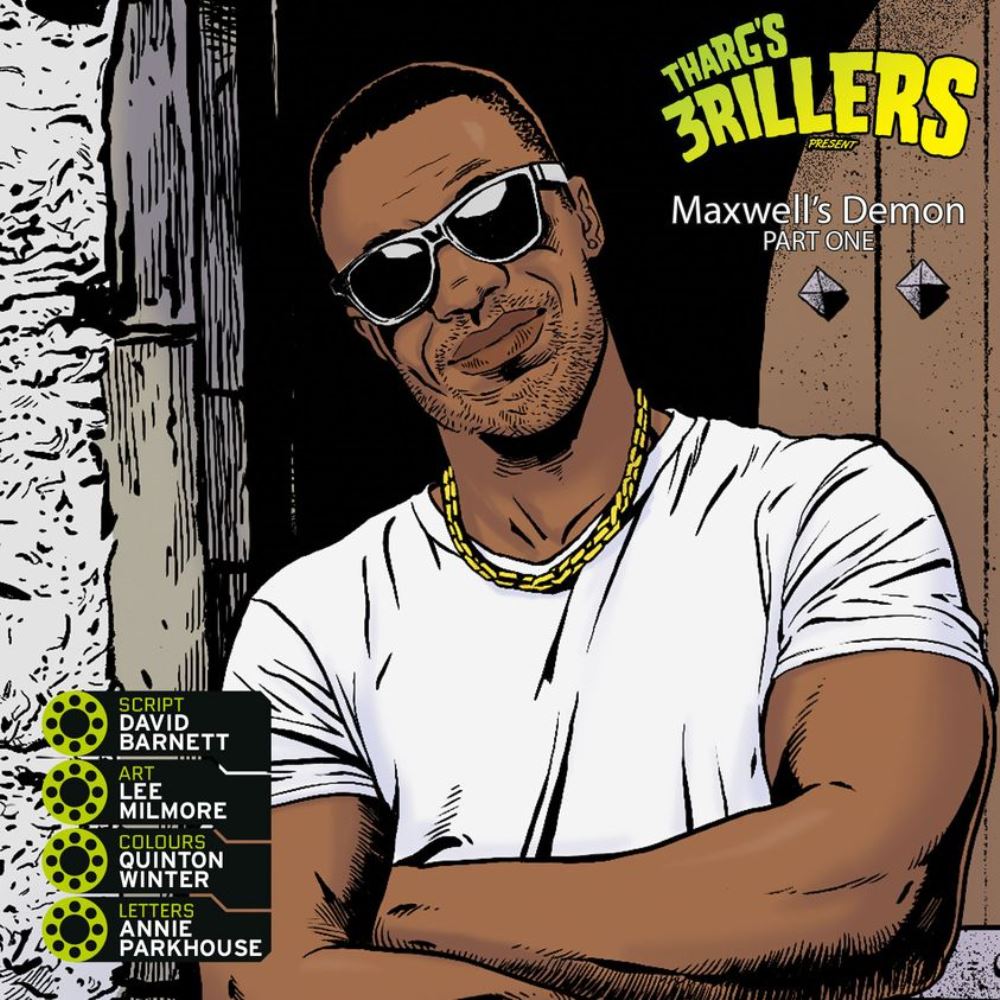
Tharg’s 3Riller’s – three episodes, one complete, self-contained story, giving you that condensed hit of super-charged Thrill-power.
The latest dose of three-part Thrill-power comes from David Barnett and Lee Milmore with Maxwell’s Demon, a series that began in 2000 AD Prog 2343. The second episode, under a Milmore Infomancy Engine cover, comes out on 9 August.
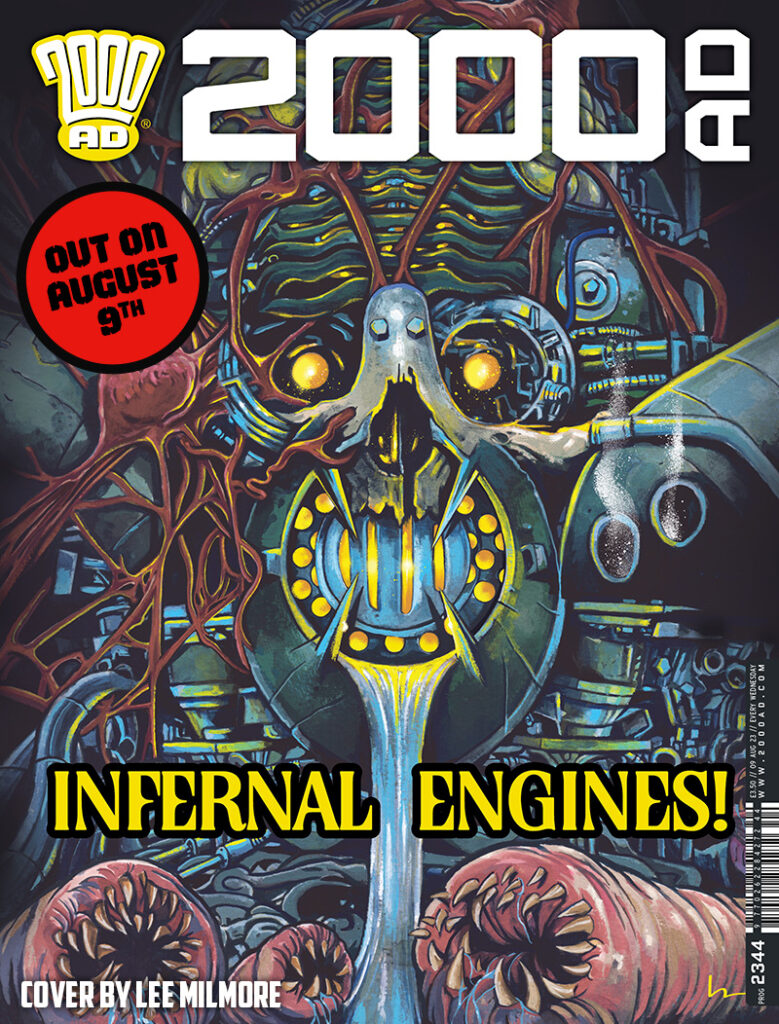
For Maxwell’s Demon, Barnett and Milmore return to the world they created for their previous 3Riller, The Crawly Man (Progs 2297-2299). In The Crawly Man, we met itinerant magician Herne and his (black) dog Shuck. Hired by the village of Cudd to find a missing girl, Caris, they soon switched sides and rescued her when the village’s Wicker Man-ish intentions became clear. Caris turned out to be a powerful summoner and let loose a demon upon the village elders (they had it coming.)
Now, as we move into Maxwell’s Demon, Herne & Shuck are looking for a safe haven for Caris. Their first stop, the infomancer Darius Maxwell. But Maxwell’s got a problem of his own he wants them to sort out – his Infomancy Engine. And on top of all that, the village of Cudd hasn’t forgotten, or forgiven them.
So, over to David Barnett and Lee Milmore to tell us all about Maxwell’s Demon, The Crawly Man, and all things folk horror…
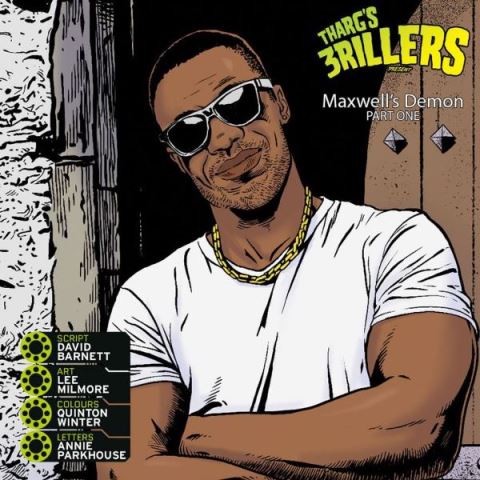
David, Lee, the Tharg’s 3Riller Maxwell’s Demon started in Prog 2343, continuing the tale of Herne, Shuck, and young Caris that you began in The Crawly Man (Progs 2297-2299).
How would you describe what you’re doing with the adventures of Herne and Shuck?
DB: Obviously each adventure has to be self-contained while making reference to what has gone before. But there’s definitely an over-arching story arc that we want to tell, which explores the origins of Herne and how he came to be with Shuck, and hopefully, we’ll get to do that, depending on how popular this latest instalment is.
LM: I think David has expanded the world, and at rapid pace. It’s less indebted to folk horror tropes and is more its own beast.
And can you both give us some idea of what to expect with the new three-part Maxwell’s Demon?
DB: When we did the first part, The Crawly Man, I’d written the script before an artist was assigned. Once I saw Lee’s work on it, it distilled with me exactly how the look of the strip was going to be, and I tried to play into Lee’s strengths with this second script. We’re going a little deeper here into the magical community that exists alongside our normal world, and also playing with a few tropes of folk horror, and the general diversity within that.
LM: I love this latest instalment. When I read the script I didn’t know where to start, there is so much fun stuff to draw. David is an exceptional writer and he just makes the job such fun. Demons, ghosts, and a possessed machine called an Infomancy Engine.
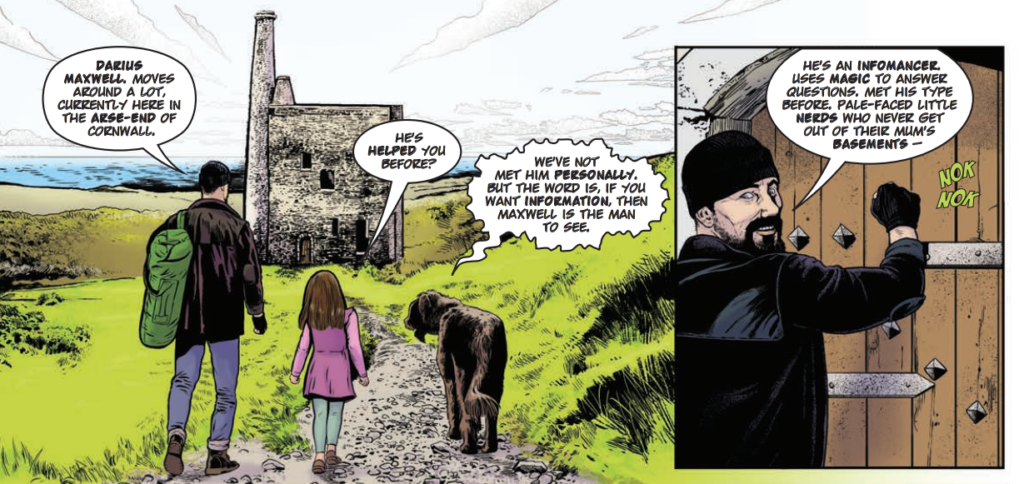
From Maxwell’s Demon part 1
It was pure folk horror in The Crawly Man but Maxwell’s Demon walks a slightly different path with a mix of ancient magical ideas meeting modern tech in the Infomancy Engine. What was the thinking of this particular melding of tech & magic – and were there any sources of info and reference you mined for the Infomancy Engine?
DB: I think, having got a handle on Lee’s style and work, I knew I could trust him to come up with the look of the Infomancy Engine — and he did not disappoint. When I saw his preliminary work I thought, OK, well, there’s nothing can faze him here, we can really go balls out on this.
I think we’re still beating a folk horror path because folk horror is such a broad church… we’re talking anything magical related to things that are specifically British, in this case, and that doesn’t just mean ancient ways, but how modern technology feeds into magic.
LM: Specifically, David mentioned HR Gieger and the idea of it being a meat machine, I quickly got the image that the machine was industrial (the engine) and like a furnace powering a supercomputer, but the possession has warped it into a metal and bone skull containing an exposed brain.
Then, thinking about corruption of the machine I added tumours and veins, the veins reflecting the big waste pipes that deal with all the runoff of infomancy. I drew it thinking “Idiot, don’t design such intricate things for sequential art”…but it was too late – I loved it too much.
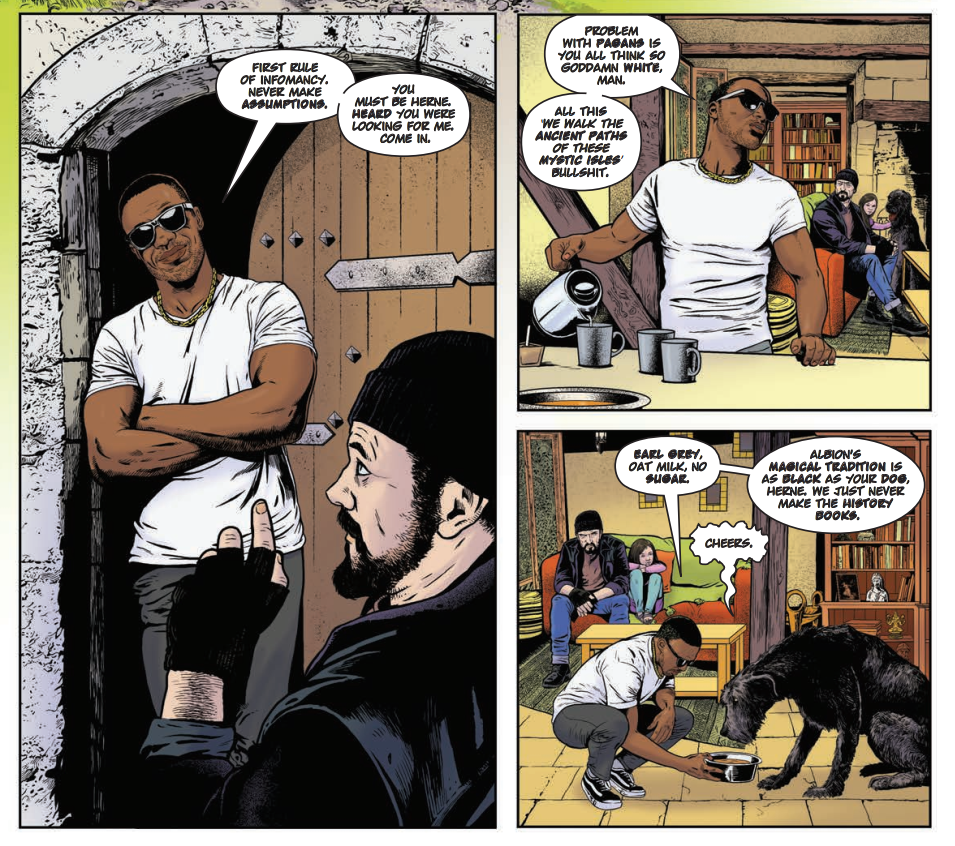
From Maxwell’s Demon part 1
One clever thing that’s been obvious with Crawly Man and Maxwell’s Demon is how you’ve very consciously enclosed the story to allow you to tell what you wanted to tell in the 3 episodes. In Crawly Man it was all enclosed by the village and a simple mission for Herne and Shuck. In Maxwell’s Demon, it’s the next stage of Herne and Shuck, finding that sanctuary for Caris. But instead of taking us on a giant quest, you’ve merely confined yourselves to one stop off on their search.
DB: The 3Rillers format makes for a necessarily tight storytelling system. Three episodes of six pages, essentially a very tight three-act play. There are challenges in telling a complete story that also references what’s gone before and sets up potential future episodes, but I think Lee and I have sort of hit our stride on that.
But the structure of the series, if we look at it as one continuing series, however, it may come about, is presumably going to be that search for sanctuary, with
Herne and Shuck taking on, in whatever strange way they’ve gone about it, parental roles – if I’m right?
In this little family, Herne’s the boring, straight-laced one, the gets-it-done parent. Whereas Shuck’s that little bit of chaos, the cool parent undermining the sensible Herne.
DB: Herne and Shuck have a complex relationship, as we’ll hopefully get the chance to explore more. Herne is a little… impulsive. Shuck is a bit more level-headed. But that’s a simplistic way of looking at it.
In one way, they’re equal partners in this commercial magical business they’re running. In another, they both have very different levels of power, which complement each other.
LM: I see it a little different. Herne for me is a clumsy sort of character, prone to getting them into scrapes. Shuck I see as kind of long suffering. I think you can see this in the way Shuck and Chris start this story taking the piss out of Herne. Shuck is keeping a closer eye on Caris, and you often see them closer together whilst the mayhem unfolds.
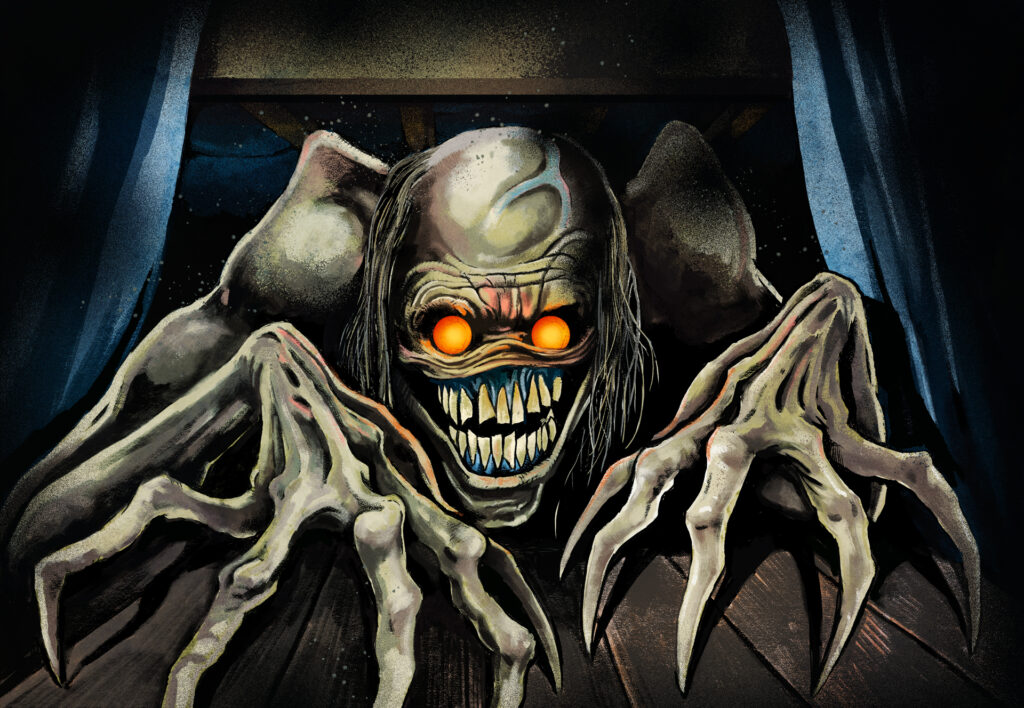
So, looking ahead – and presuming that all make it out alive this time – what can you tease us about where you’re taking the series?
LM: Yes David, what can you tease us with? I have one idea that I’m going to try and get David to write. He suggested that “possibly we’ll see it at the end of the saga, many years from now with a bit of luck.”
DB: Lee gave me a steer on Herne’s past and origins that made me go, yeah, of course, that should be set. We have a story arc here, in that Herne and Shuck are trying to get Caris to a safe haven.
But there are also a lot of unanswered questions about who Herne is, why he’s with Shuck, and what their place is in the magical landscape of Britain, and I think we could all have a lot of fun exploring that and answering those questions.
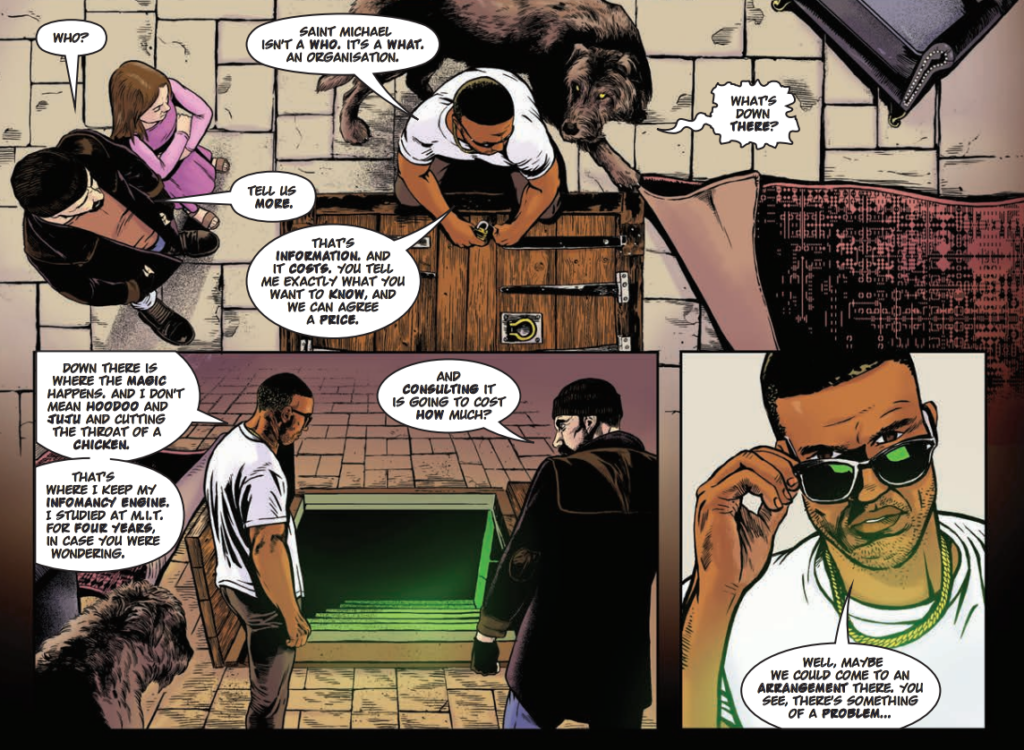
Oh, don’t go down there!
From Maxwell’s Demon part 1
Again, as we saw in The Crawly Man, there’s so much going on here. But principally it’s a very simple tale of old English magic – if I’m right – that you’ve added your own touches to.
Is it something you’re particularly interested in – all the folk mythology of Great Britain, the Cunning Men and all that? And of course Black Shuck himself!
DB: Folk horror is very popular right now, and if we think it’s 50 years since The Wicker Man was released, it’s been having “a moment” for a long time. Magic is always more potent when related to time and place and the specific magic that Herne and Shuck employ is very much a product of their environment and the folklore and magical history of these isles.
We’ve got plans to align a lot of existing folklore with the story, as well as adding our own touches and taking it off in different directions that reflect the modern world.
LM: Yeah for me it’s a big interest. I’ve toyed with folkloric ideas before but it didn’t get out of concept phase. I was looking at adapting The Broon Man and Red cap folk tales that are disturbing and, in the case of the Broon man, local to me.
There’s an authenticity to it, like a part of our DNA whether or not you’re aware of it. It peels back modernity and reveals the bones of our place in the world. I’ll return to it one day.
The fact that Tharg put me together with David on this shows his frightening insight, I never mentioned it to anyone in the Nerve Center.
As an aside, have you both been following Julian Simpson’s Lovecraft Investigations and Pleasant Green Universe radio stuff? It feeds into the same sort of things you’re getting into here.
LM: No but I will look that up. Lovecraft is a significant influence on me in one way or another.
DB: Similarly, it’s something that I’ll look up. I’ve read Lovecraft from being very young, and I think that it’s an important part of the whole horror landscape. I’d like to think that Herne and Shuck are a bit less po-faced than any of Lovecraft’s creations, though.
Definitely worth a listen. His Pleasant Green Universe stuff is here at his soundcloud, whilst the Lovecraft Investigations can be found here at the BBC Sounds site.
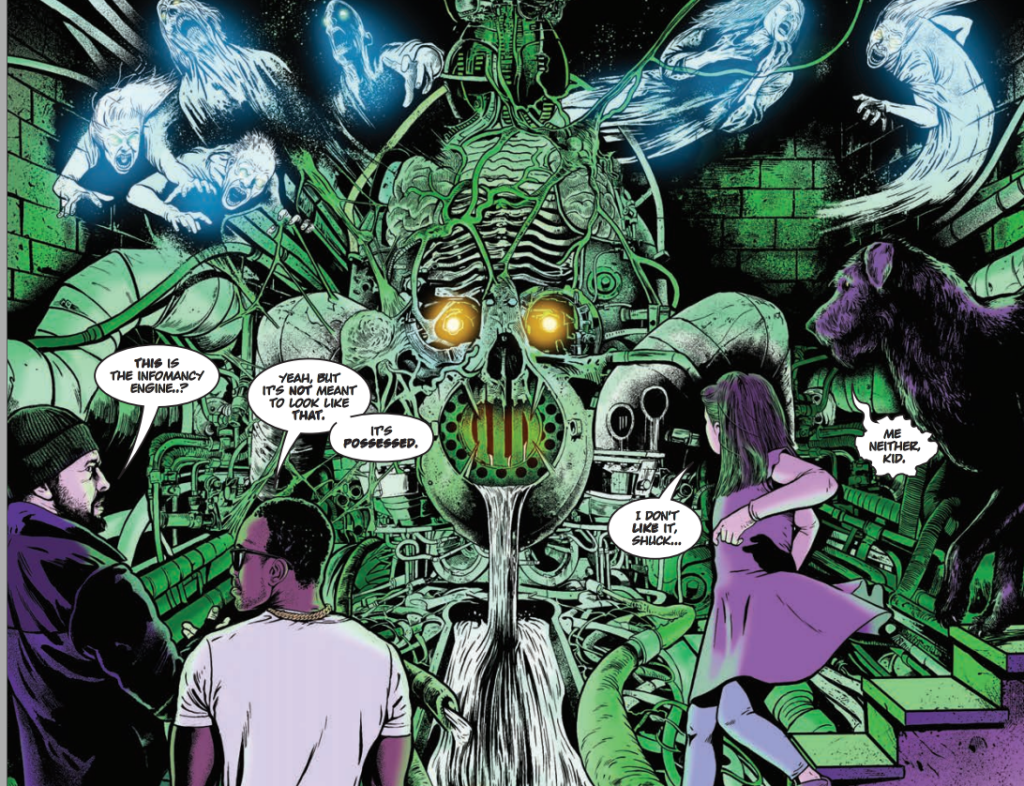
From Maxwell’s Demon part 1
And of course, this strand of folk horror is something that’s been part of the DNA of 2000 AD from the very earliest days, with Sláine introducing so many comic readers to the ideas of British/Celtish magic. And latterly, as we mentioned already, we’ve seen it again in Thistlebone.
Both of you, I assume, are fans of both?
DB: Again, yes. Sláine is part of my DNA. Thistlebone led the way with folk horror in 2000 AD. I think, with 2000 AD being an essentially British product, we cannot deny any part of the British magical experience in its pages. We are a folklorish nation and it’s natural that our myths and legends of yore will inform our comic strips of now.
LM: Sláine, absolutely. I would have loved to have done a Sláine strip. Thistlebone, I have to confess I haven’t read it…sorry.
Well, there’s plenty of chance for the Milmore droid to rectify that mistake – and you if you haven’t read the brilliant slice of recent folk horror, 2000 AD style, that is Thistlebone by TC Eglinton and Simon Davis – it’s available here from the 2000 AD Shop!
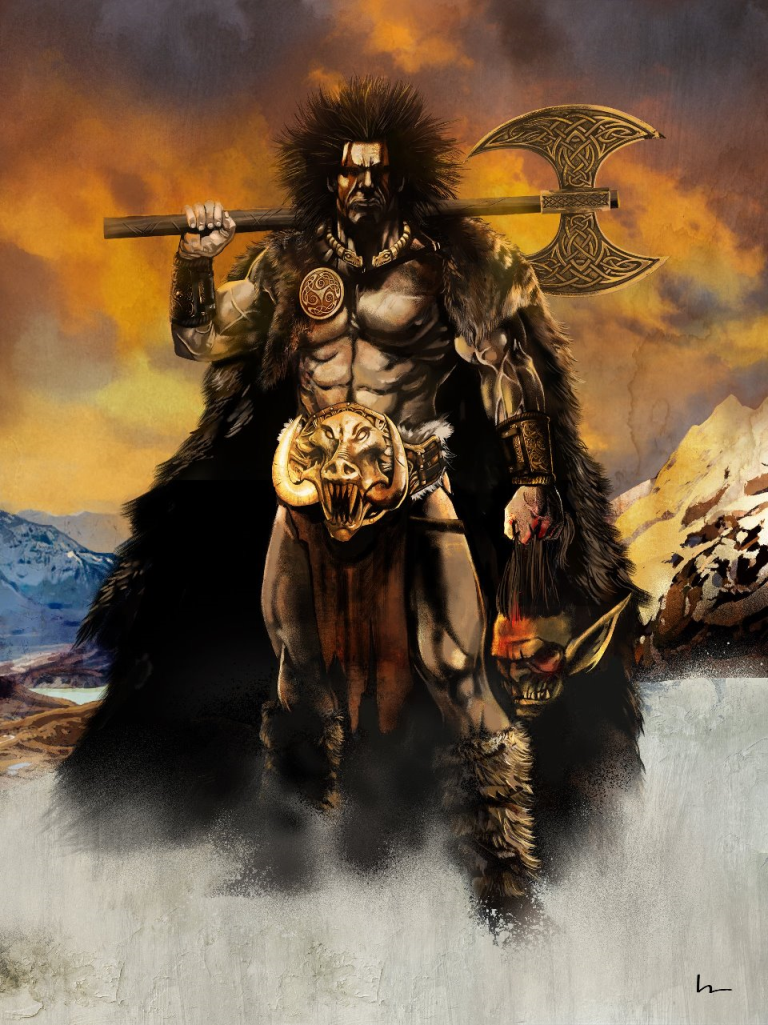
Obviously, with these Tharg’s 3Rillers, it’s a chance to do more (three times more in fact) than a Future Shock or Terror Tale, but more than anything else it’s a great opportunity to set up a series or a continuation. And that’s exactly what happened here. The Crawly Man was popular enough or well received enough or simply that Tharg liked it enough to give you another three parts to carry the story on.
DB: I pitched The Crawly Man as part of an ongoing series, and Tharg quite wisely decided to run it first as a 3Riller to gauge reaction. Response to that strip was incredibly positive, and we got Maxwell’s Demon on the back of it.
Would I like to be able to tell Herne and Shuck’s story in longer instalments? Of course. But I’m grateful for any format we can get to unspool this story.
Who’s idea was it in the first place? I’m presuming it was David’s idea and then brought to you Lee. But we’ve seen things like Void Runners with David Hine and Boo Cook recently where it was Boo who came up with the concept first.
DB: I pitched the idea and wrote the first script, and then Tharg brought Lee on board, and that was that. He absolutely nailed the look of every character and the general feel of the whole strip and I knew we had a good collaboration going from word go.
LM: It was all Tharg the Mighty. It was the first time David and I had worked together, as I’ve mentioned it’s great getting his scripts, just bursting with energy. With some luck we’ll continue to work together for some time to come.
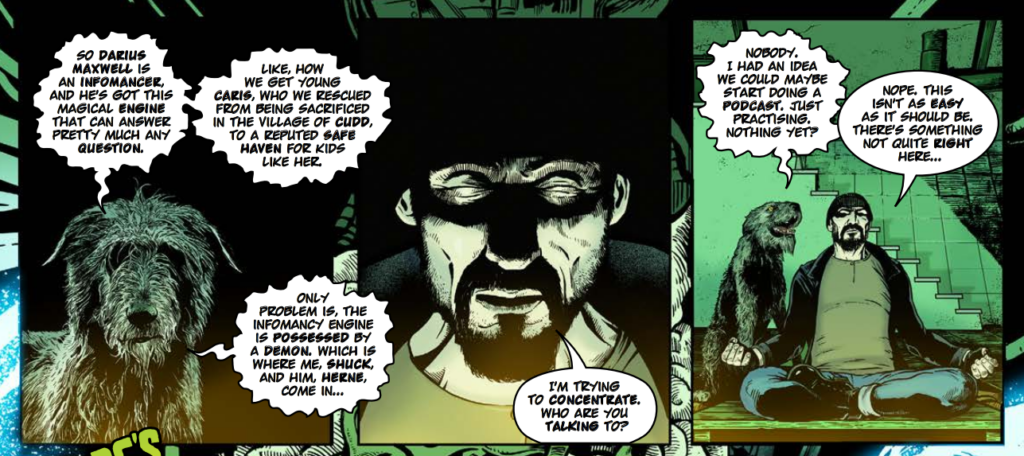
The opening panels and a great recap with tongue firmly in cheek from Maxwell’s Demon part 2
Lee, just as the story is way different in setting and tone than The Crawly Man series, taking place for the most part in Maxwell’s basement it seems, the artwork here is radically different – you’ve swapped the bright blue skies of Cudd and are now in electronic/electric blues and greens it seems?
What was the idea with that, and were there particular stylistic shifts you had to adopt to cope with the action taking place inside for much of the time?
For example, there’s already been a couple of wonderful scenes so far where you’ve taken a top down viewpoint to allow us to take in the room – difficult to pull off, but you did it with style!
LM: Thank you, nice of you to say so. Yeah that’s really what it’s about, trying to keep the reader engaged with changes of angle and perspective, but also to reveal the scenario. Colours wise, I can’t take any credit for that, it’s all down to Quinton Winter. Thanks for making me look good Quinton.
Indeed, thank you Quinton, and thank you to all those sometimes overlooked colouring droids – essential for making the art pop from the page!
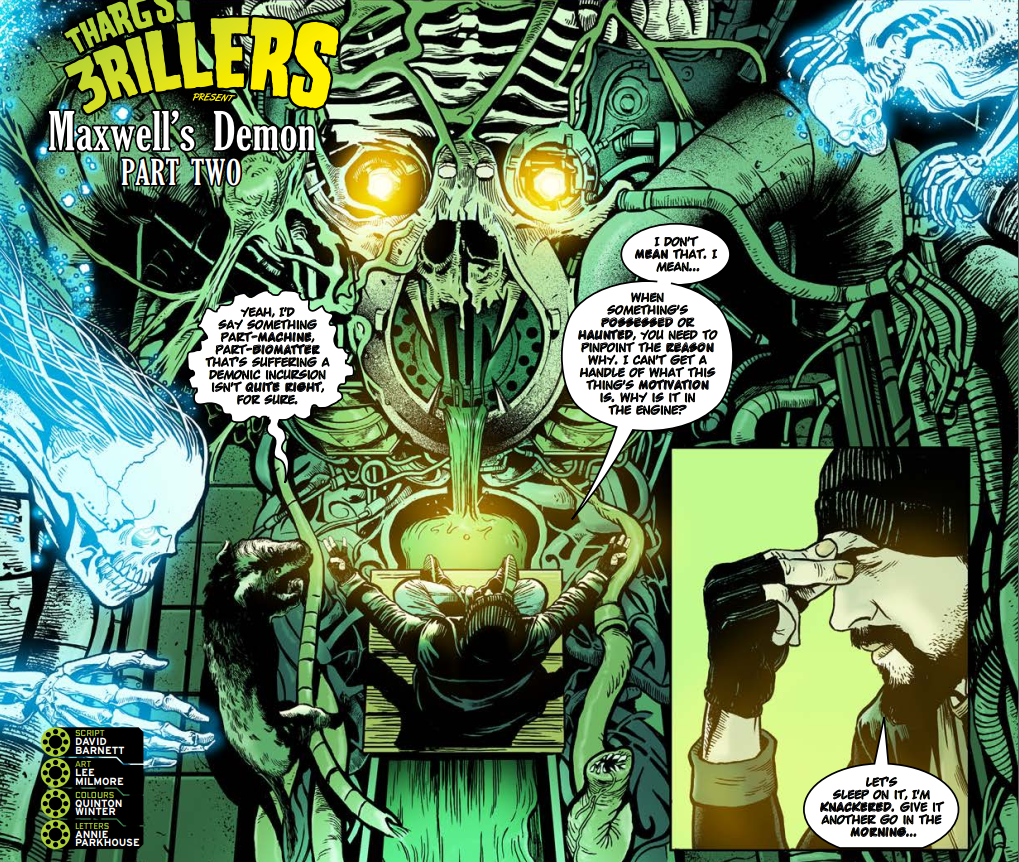
From Maxwell’s Demon part 2
Going further into the art Lee, what’s your process been for Maxwell’s Demon?
LM: I’m pretty painstaking about putting pages together. I thumbnail, and really I tend to get down the page dynamics fairly instantly. Though the next part of the process can change it up a bit.
After thumbnails, I set up a page in Photoshop, draw in the panel borders, and take the time to do the lettering (temporary for my own purposes) which allows me to see how much space I have and the order I place the characters. In order of speaking.
Next up I do a few hours finding my reference. I do things like making collages, like this Infomancy Engine one…
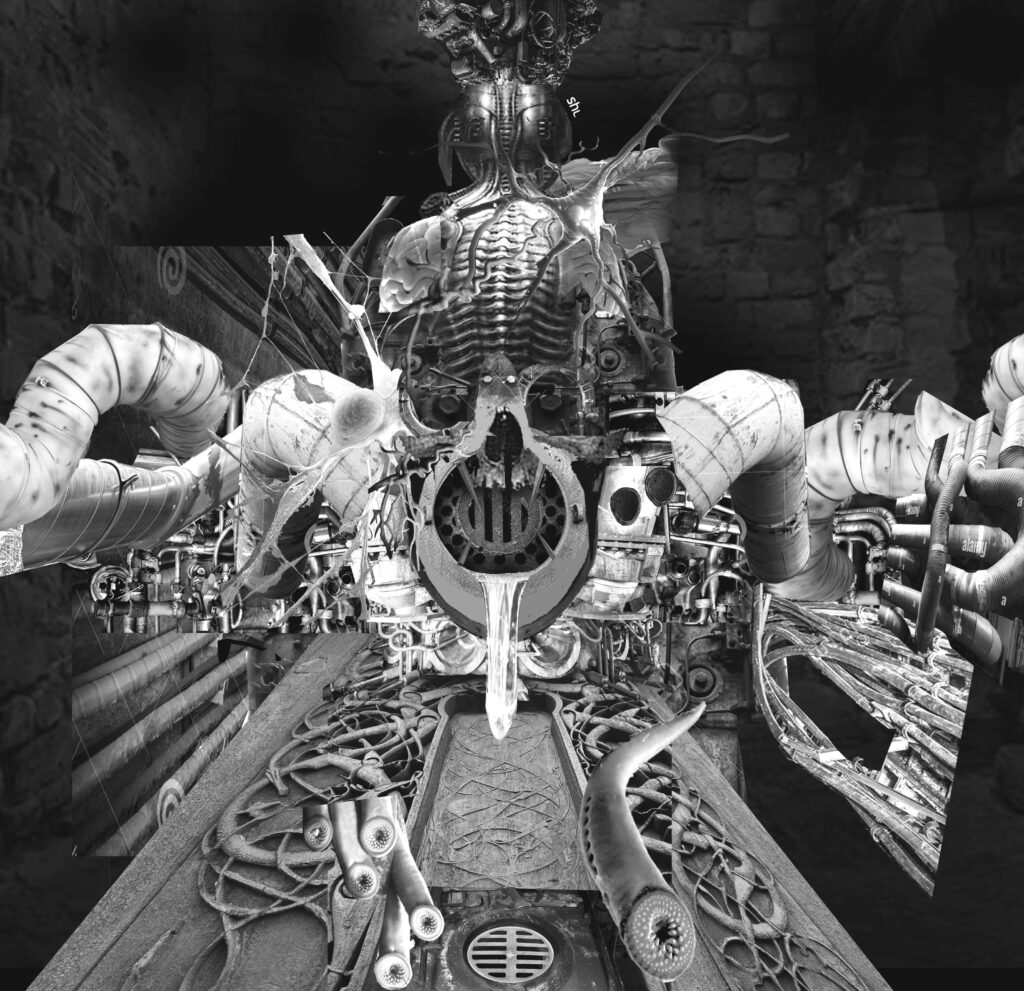
I probably put too much time into it but I find it both helps me drawing authentic things, even fantastical things, and often provides a perspective I haven’t planned on. My favourite art isn’t really full of realism but it seems to be the direction I’ve wandered down.
Then I’ll do some drawings based on the collage I’ve made and it becomes a mash up between those drawings and the collages that I ink over. I drop the layer down so it’s very light and it gives me the freedom to work on my inking.
I wish I could just sit down and draw it all from my mind’s eye…but I’m not there just yet.
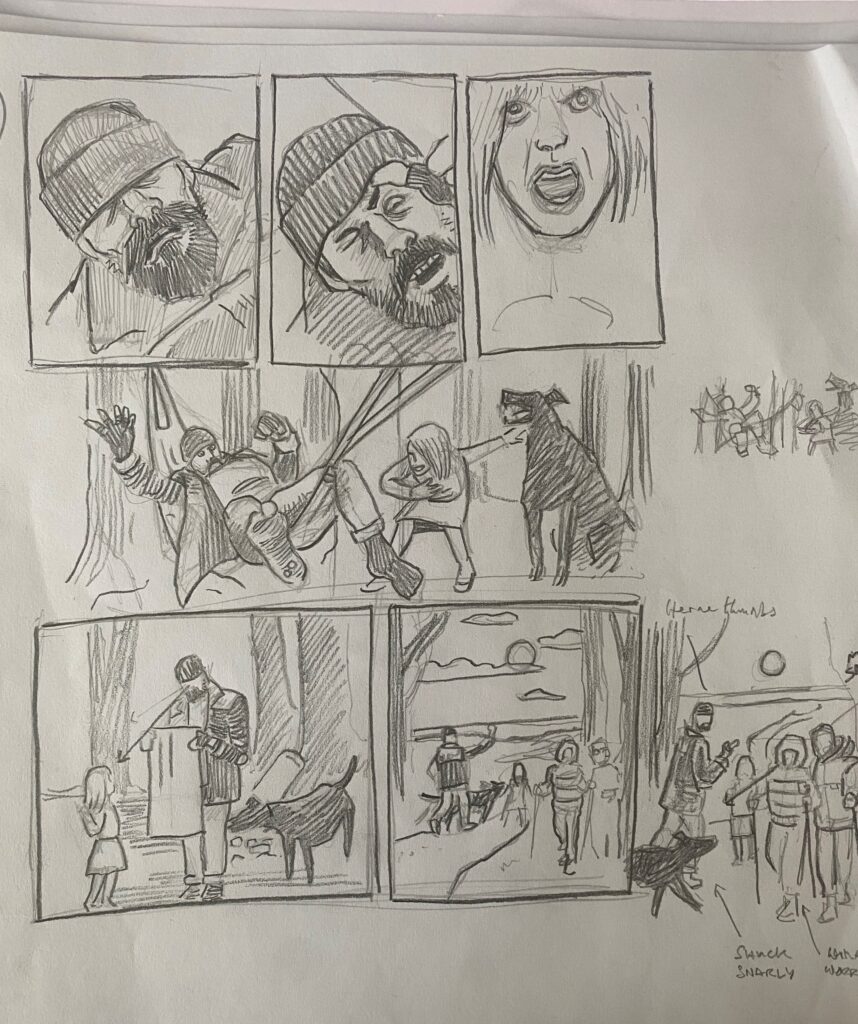
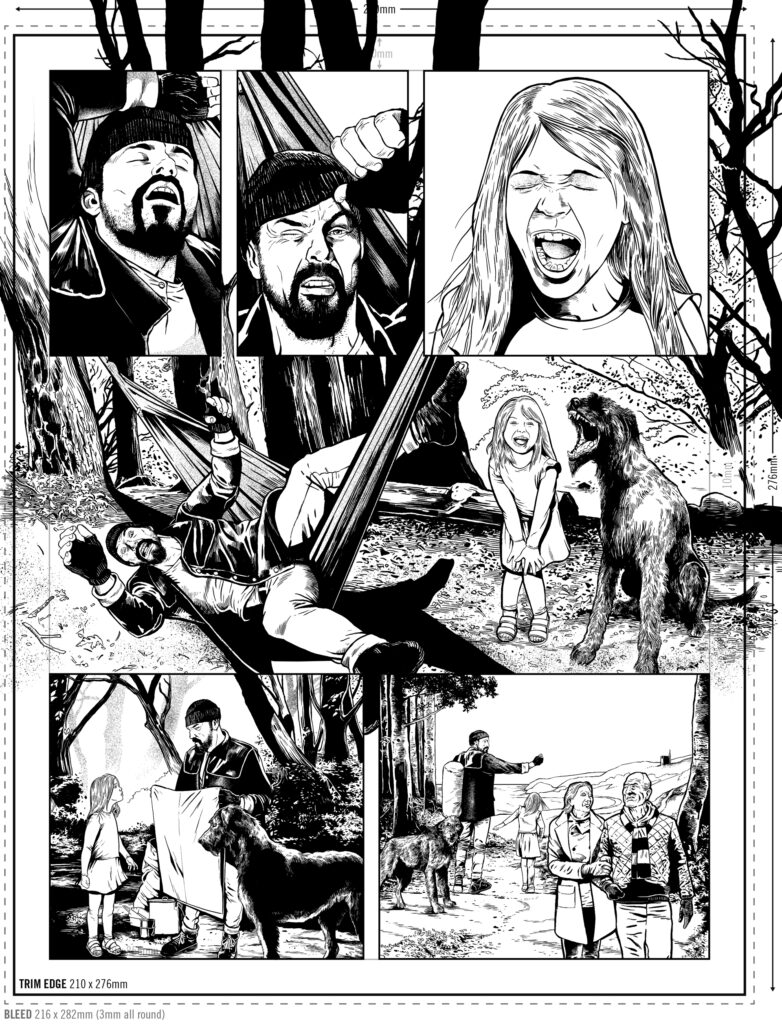
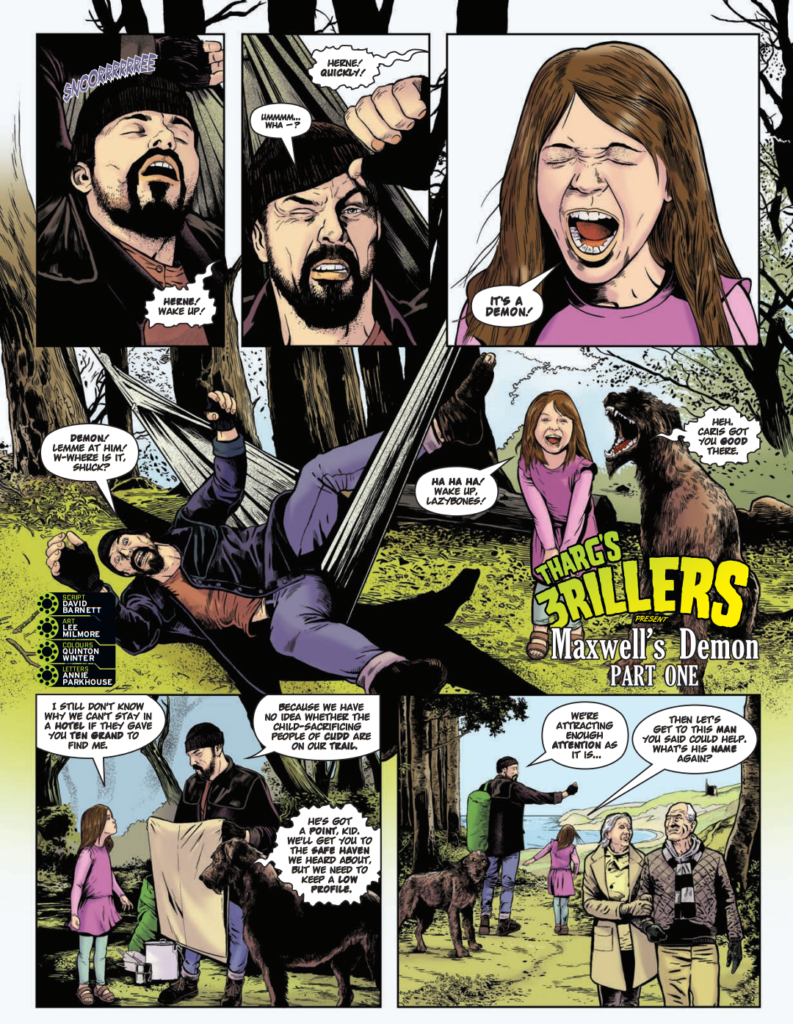
From Maxwell’s Demon part 1
And David, what do you think of the work Lee’s put in to make the world of Herne & Shuck come alive?
DB: I had a very vague idea as to the look of the strip when I put the first script together, but when I saw Lee’s pages I was blown away. He absolutely nailed the characters and the tone, and that in turn meant it was much easier for me to write the next script because I knew exactly what Lee was capable of.
Comics are a collaborative medium and once you find that perfect team — which I think we have — things tend to gel very quickly and writer and artist feed off each other, and instinctively know what is required of them.
Oh, one thing David, completely tangential (I expect) to it all but… Episode 2 has a mention of ‘Info Freako’. Now, the only thing that immediately brings to mind is the debut single by Jesus Jones from 1989. Coincidence or a nod to a rather underrated band? [Personally, I remember having both Info Freako and Info Psycho on a mix tape I made that year – oh, the good old days of taping it off the radio!]
DB: Yeah, that’s one of those little Easter eggs that you wonder if anyone will notice. Jesus Jones were one of my big late 80s bands, just before I discovered hard techno and left my brain in a field somewhere in the West Country.
And another nod to the 90s there – Pulp’s Sorted For E’s & Wizz – although that important part of Jarvis’s brain was left ‘Somewhere in a field in Hampshire.’
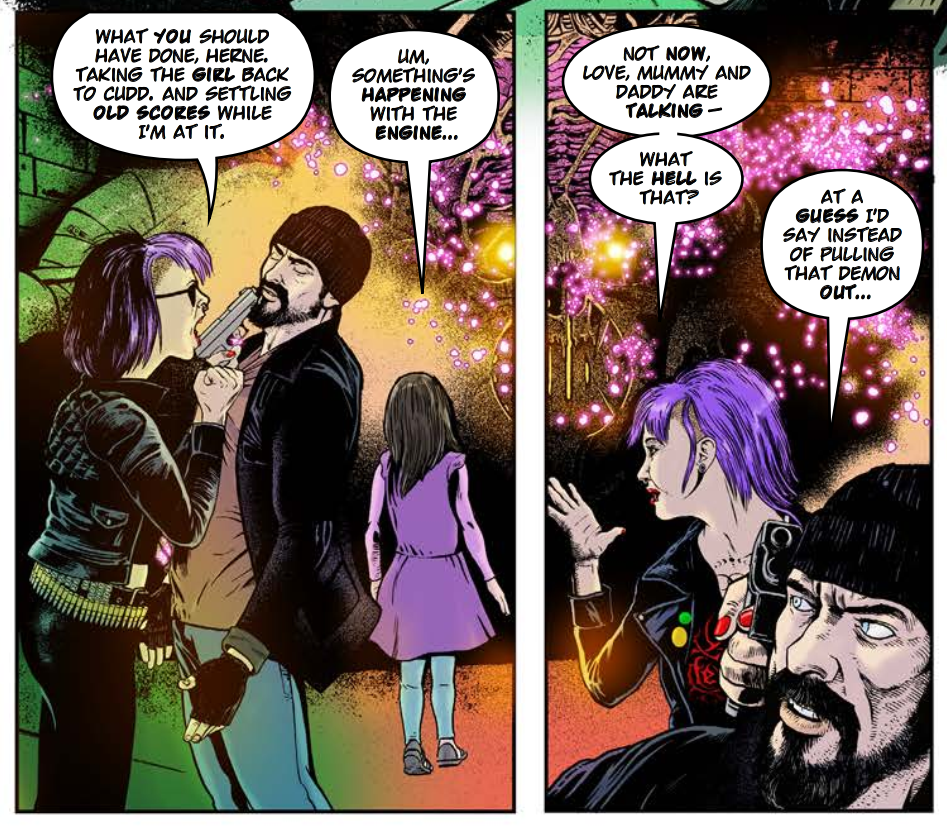
From Maxwell’s Demon part 2
So, we’ve now had The Crawly Man and Maxwell’s Demon. I assume that there’s plans and plots afoot to continue the story after Maxwell’s Demon ends?
How do you go about planning a future for a strip like this? You obviously can’t know what Tharg has in mind – another 3Riller, maybe a longer length strip. So is it merely a case of putting down future story ideas, ways you can take the narrative if and when you get the green light for more?
DB: We have a full arc planned, that would (by incredible co-incidence) fit in with a trade paperback collection. There’s so much to explore, though, that we could go on forever with Herne and Shuck.
Imagine if John Constantine was a bit less clever and a bit more of a piss-head, and had a smart-arse dog, and that’s what you could be in for.
So far, both of you are pretty much starting out at 2000 AD. David, I know you’ve written extensively at Black Crown and some at DC – interestingly enough, magic again with Tim Hunter. But here at 2000 AD it’s really only been Chopper and Lowborn High for Regened and Herne & Shuck in the Prog.
Similarly, Lee, you won the 2000 AD talent search at Thought Bubble in 2021 and have seen your work in your winning prize Future Shock with Honor Vincent and an excellent Terror Tale by John Tomlinson, and then Herne & Shuck. Are you enjoying your time at 2000 AD?
LM: I mean….hell yeah.
DB: As someone who bought the very first issue of 2000 AD (and lost my Space Spinner over the wall of next door’s yard where their American Pitbull chewed it up) it’s obviously a dream come true to write for 2000 AD.
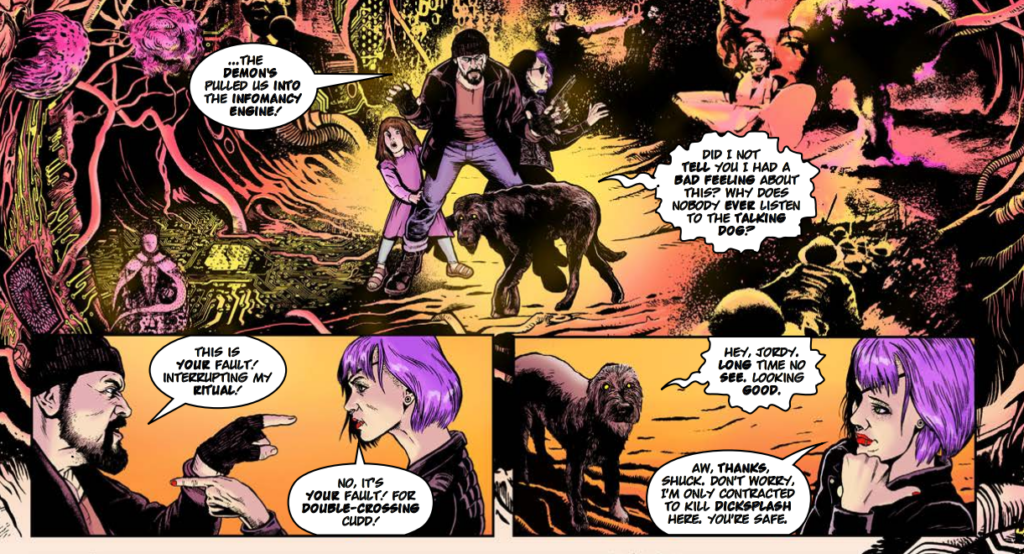
From Maxwell’s Demon part 2
What memories does the comic hold for you both and what does it mean to be script and art droids now?
LM: My first Prog was the one from The Apocalypse War with Dredd’s badge with a bullet hole and trickle of blood. I got that as it was accidentally delivered to my Grandma in her Sunday Post. I loved it….it changed everything for me. I didn’t start collecting though until around the League of fatties, and then I was lost to it.
I was already a keen artist but in those few weeks I decided that I WOULD work for 2000 AD, with the certainty only a little kid can have. I had no idea how this would be done and I don’t recall sending anything in by way of submissions, I just imagined it would somehow happen.
When I was at art college I went on a trip to London to visit the galleries. I took a portfolio, which essentially was every scrap of paper I’d ever scribbled on stuffed into it and sloped off to the Nerve Centre. I walked into Kings Reach Tower and got in the lift with a load of business types (journalist I guess) and went to reception. I asked to see someone at 2000 AD and perhaps because I was so naive the receptionist didn’t tell me to bugger off and called down to Steve MacManus’ office. He passed back a message that without an appointment I couldn’t get seen.
I think I rolled on my belly and begged or something (I don’t recall) but he reconsidered and told me to ring him in an hour. When we spoke I laid it on thick about coming down from Durham to see him, which was true but I didn’t mention the college trip. So I emotionally manipulated him to come and see my work. He and Clint Langley came and met me in a pub (the main reason I got the meeting I think, they wanted beer) and for the next couple of years I sent Steve work.
I guess I thought it was a matter of time for me at this point. But again being very green, I just didn’t grab the bull buy the horns. I’d send work very infrequently and spent the majority of my time, wasting my time doing fine art painting at University. It fizzled. 20-odd years passed. I won the 2000 AD talent search at Thought Bubble and then I actually got to do what I always wanted to do.
What does it mean to me…a whole lot!
DB: 2000 AD was a part of my landscape growing up and I never thought I’d be a script droid. I didn’t think robots like me grew up to be script droids. I thought we just got jobs in factories making bits for machines. So it’s amazing that I did make it.
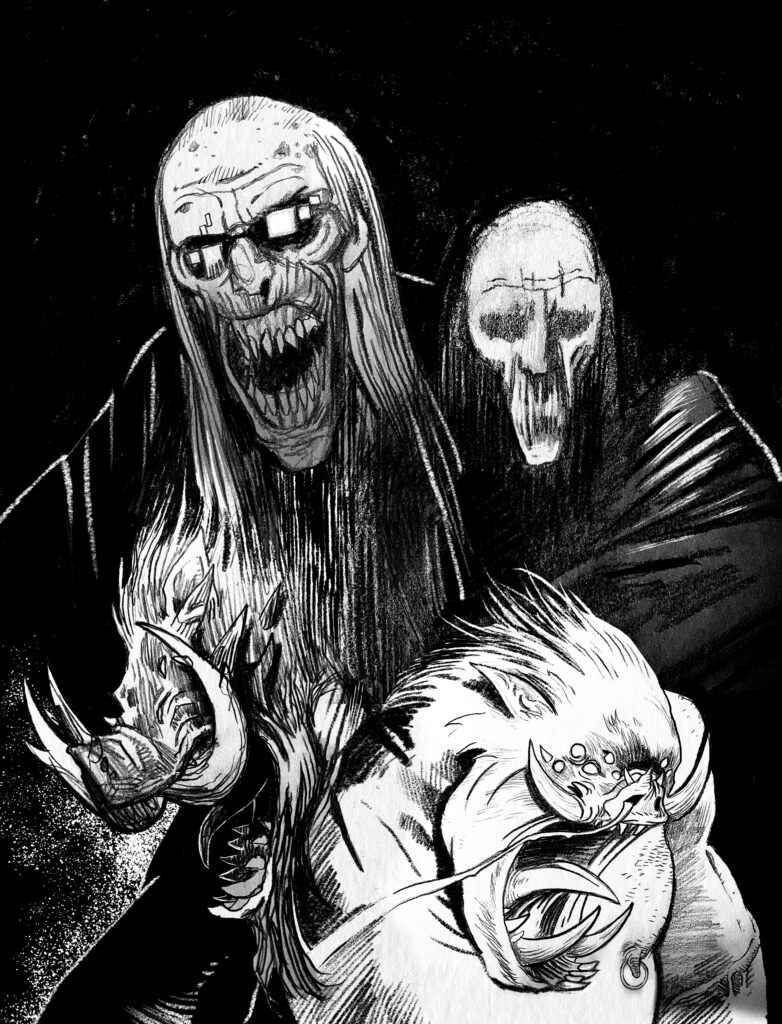
And just one for fun – you have carte blanche over the entire history of 2000 AD. Who do you write/draw if you could and what story would you do?
DB: Zenith. Without a doubt. Either the adventures of Young Zenith, OR the story of Zenith as an old fart and his granddaughter taking over his mantle, a real Gen X vs Gen Z thing. Yes, I have thought about this very hard. I just need Grant Morrison to give me their blessing.
LM: I won’t say Judge Dredd (it’s Judge Dredd – The Satanus episode of The Cursed Earth)
Instead… Strontium Dog:Rage, Sláine: Shoggy Beast, Nemesis: The Gothic Empire, Rogue Trooper: To the Ends of NuEarth, and maybe – Bad Company.
All of those but actually none of them as they were all so fantastically well done by all involved the imposter syndrome might go nuclear.
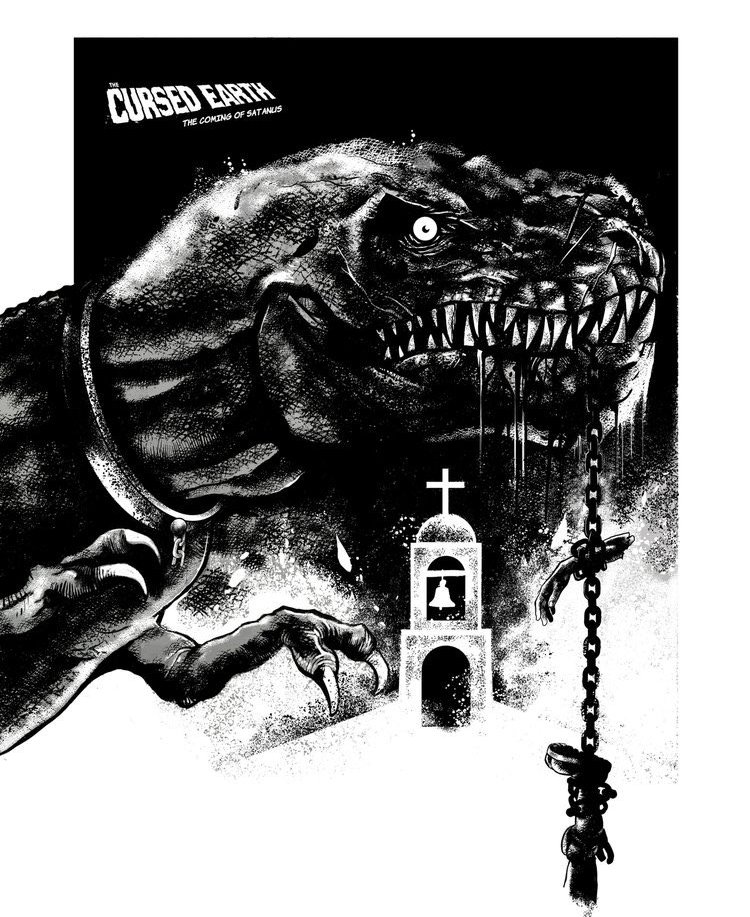
To end, as always, what’s coming up from the pair of you in the future, whether it’s for Tharg or elsewhere?
LM: David and I are working on a strip for the Megazine. My first time in Mega-City One. Another dream come true moment for me, so thank you David – and of course his Thargness.
DB: Yep, we’ve done a deep dive into MC1 lore. A much-loved character from Judge Dredd’s past. Reinvented as a noirish private eye. But we’ve said too much, and we’re probably going to end up inside supports for a flyover somewhere in Mega City One.
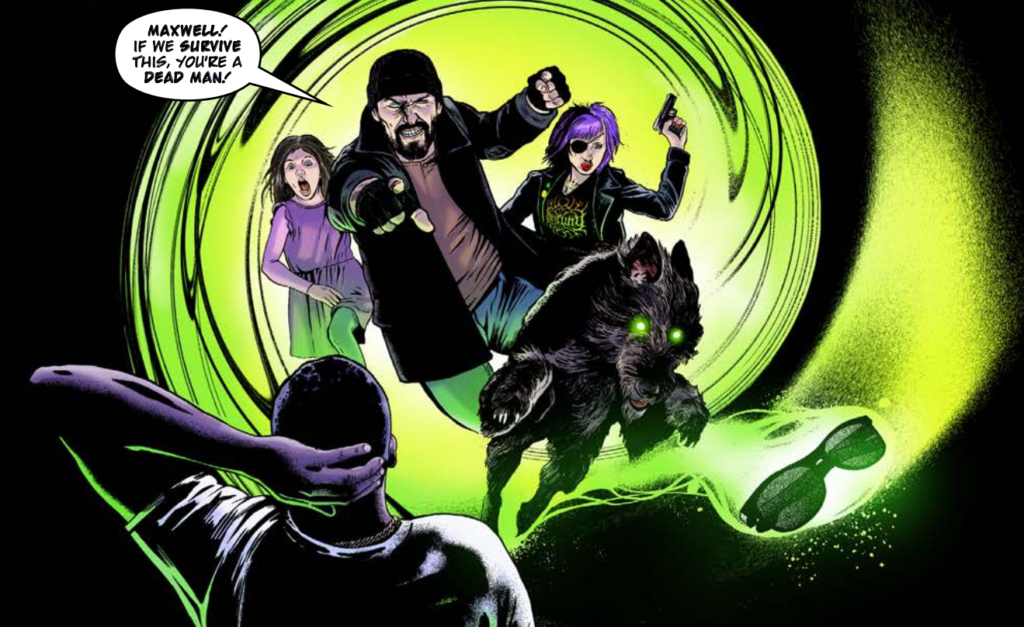
And that’s when we had to leave it, wondering just who the ‘much-loved’ Dredd character is. That one you’ll have to wait for!
But if you want to find out if Herne, Shuck, and Caris do get out of it – well you can (and should) find David and Lee’s Maxwell’s Demon, in Prog 2343 and continuing in this week’s Prog 2344 – just look for Lee Milmore’s terrifyingly good cover of the Infomancy Engine on the shelves or in the 2000 AD web shop from 9 August!
We’ve interviewed both Lee and David before here at 2000 AD.com – Lee was interviewed here with Honor Vincent about their Thought Bubble winning Future Shock, the excellent Relict. And as for David, we’ve interviewed him twice about his Regened work, first there’s this on Chopper, and here (with Anna Morozova) about Lowborn High.

And now, the full-size images of Lee’s art for page 1, episode 1 of Maxwell’s Demon – roughs, inks, and then final page with those wonderful colours from Quinton Winter. and always incredible letters from the legendary Annie Parkhouse…



And finally, here’s Lee’s inks for page 4, part 1 of Maxwell’s Demon, followed by the full page with colours by Quinton Winter and letters by Annie Parkhouse…
